
- Travel hacks

100 German-language travel blogs: My travel blogger list 2024 (updated)
Do you like reading travel blogs as much I do? But you never really find new blogs? I have compiled a list of my favorite German (and a few Austrian) travel blogs in German language! And I have another pro tip for you on how to stay on top of the big world of blogs!
By the way, if you landed here by accident…. The Happy Jetlagger is also a German-language travel blog :)
Find all articles here!
This list was updated in 2024. I have added a few new blogs and removed some because they no longer exist or are no longer really run. I haven’t counted again, maybe there are more or less than exactly 100 now :) If you still miss your favorite blog, please let me know!
Welcome to my travel blog!
Hey, I’m Tatiana, a German-Brazilian living in Berlin & the author behind The Happy Jetlagger. I’ve been writing about my travels since 2014. In addition to my job as a flight attendant, this blog is my passion project!
My top 100 of the best German-language travel blogs in 2024
Here are my 100 favorite travel blogs of 2024! I’ve made a special section for blogs with a special focus. Have fun browsing my blogroll!
By the way: In contrast to a classic travel blogger ranking I didn’t stick to any selection criteria, these are just the blogs I love and read myself – and maybe you will find an inspiring travel blog here too :)

All travel blogs from A-Z
Food travel blogs.
Advertising / *affiliate links
Outdoor travel blogs
Travel blogs about specific destinations, lifestyle blogs that also write about travel, family travel blogs, how to follow travel blogs: what’s the best way.
How do I read so many blogs? With so many blogs, it’s hard to keep track, you think? Wouldn’t be possible without this great app: feedly .
Feedly is an RSS reader. For the older among you, this will sound familiar; a few years the blogosphere wouldn’t exist without the Google Reader, for example. In the age of algorithm-based feeds like on Instagram and TikTok, you’re probably not even used of new articles being presented chronologically – but I love it!
Feedly also gives you the option to sort your favorite blogs by topic. Also, you can use Feedly on desktop, but also mobile as an app. Give it a try!
➜ This is how you follow my blog with feedly : Open Feedly and under “Follow New Sources” simply enter the address of my blog https://thehappyjetlagger.com and click on “Follow”. Done!
Did you like this article? Did you discover many new German blogs? Then I’d love it if you forwarded this article or shared it on social media!
Ähnliche Artikel

Fabrika Tbilisi: Hostel, Coworking Space & Creative Hotspot

Es Trenc: The dream beach in Mallorca

Booking on Airbnb: What you should watch out for
Leave a reply cancel reply.
Your email address will not be published. Required fields are marked *
Name *
Email *
Post Comment

The Only Germany Travel Guide You’ll Ever Need
Last Updated: January 5, 2024
*FYI - this post may contain affiliate links, which means we earn a commission at no extra cost to you if you purchase from them. Also, as an Amazon Associate I earn from qualifying purchases. Check out our Privacy Policy and Disclosure. for more info.
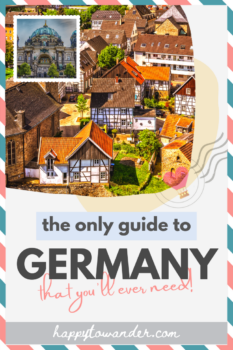
While most commonly associated with beers, bratwursts and tight leather pants, Germany is a country full of delightful finds that extend far beyond the stereotypes.
From dreamy castles and fairytale towns to awe-inspiring nature and sprawling cities, Deutschland has a little something for every kind of traveler… although I’ll admit the leather pants are also great.
I first visited Germany on a 6 week backpacking trip across Europe, and as I sipped my comically large beer under the toasty Berlin sun, I felt a strange sense of calm and belonging.
Spurred by this hunch, I moved to Munich. One study abroad, and 5 years later, I’m still here, with so much giddy enthusiasm for this country that I’ve become a thoroughly insufferable dinner guest.
But my social life’s loss is your gain, my friend… because today, I’ve decided to channel all my Deutschland fangirl tendencies into this concise Germany travel guide filled with all my top tips, itineraries, and recommendations.
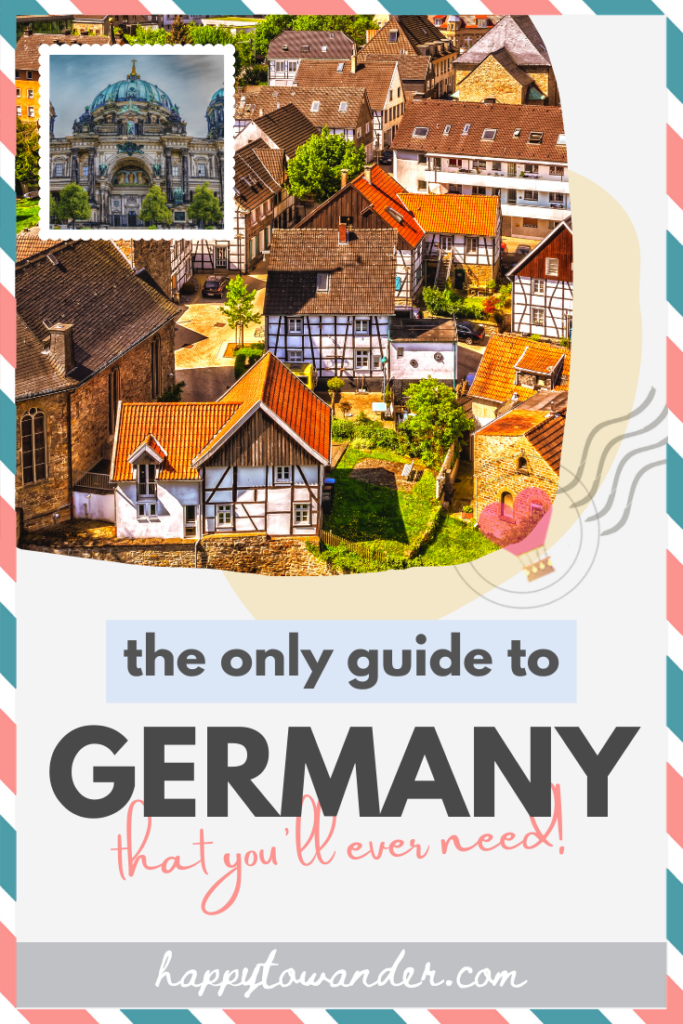
Save this Germany travel guide for later!
I promise it’ll come in handy!
I hope you find it helpful, and of course, feel free to ask any more questions in the comments section or on Instagram here.
Traveling to Germany Basics
Currency: Euro
Language: German, although accents and dialects vary wildly! In larger cities and tourist hotspots, most Germans also speak excellent English.
Getting Around: Trains, buses and flights are plentiful and affordable in Germany – my best tip is to use Omio to compare options easily. Having a car is ideal for visiting smaller towns, more remote locations and numerous destinations in a short amount of time, but is otherwise not needed for big cities.
Germany Highlights (By the Season)
- Winter: Christmas markets, skiing & alpine sports, Karneval and Fasching season (Carnival), Starkbier (Strong beer) season
- Spring: Cherry blossoms in Bonn , Frühlingsfest (Springfest) in Munich
- Summer: Hiking, Beer Garden season, summer festivals/celebrations
- Fall: Oktoberfest and other Volksfests, the world’s biggest pumpkin festival in Ludwigsburg, the Wurstmarkt (world’s largest wine festival)
My Favourite Places in Germany
Let’s get my mega-biased opinion out of the way first – Munich is the city I now call home, and I couldn’t recommend it more… especially if you’re obsessed with beer like I am. This is the birthplace of Oktoberfest after all!
There are lots of fun things to do in Munich , like hopping around the city’s sprawling museum district (many only cost 1 euro on Sundays!), eating up the best Bavarian food that Munich has to offer or soaking in the wealth of historical sites scatered around the city.
It’s also an ideal base for many epic day trips. Going from Munich to Neuschwanstein Castle (AKA the real life Sleeping Beauty castle) takes only 2.5 hours. Or, if you want to visit glorious Salzburg from Munich (AKA the birthplace of Mozart and setting of Sound of Music), that’s only 1 hour by train.
Why visit Munich when you travel Germany:
- Amazing beer & beer festivals
- The English Garden – one of the largest city parks in the world
- Beautiful palaces and museums
- Easy base for amazing day trips to the Alps
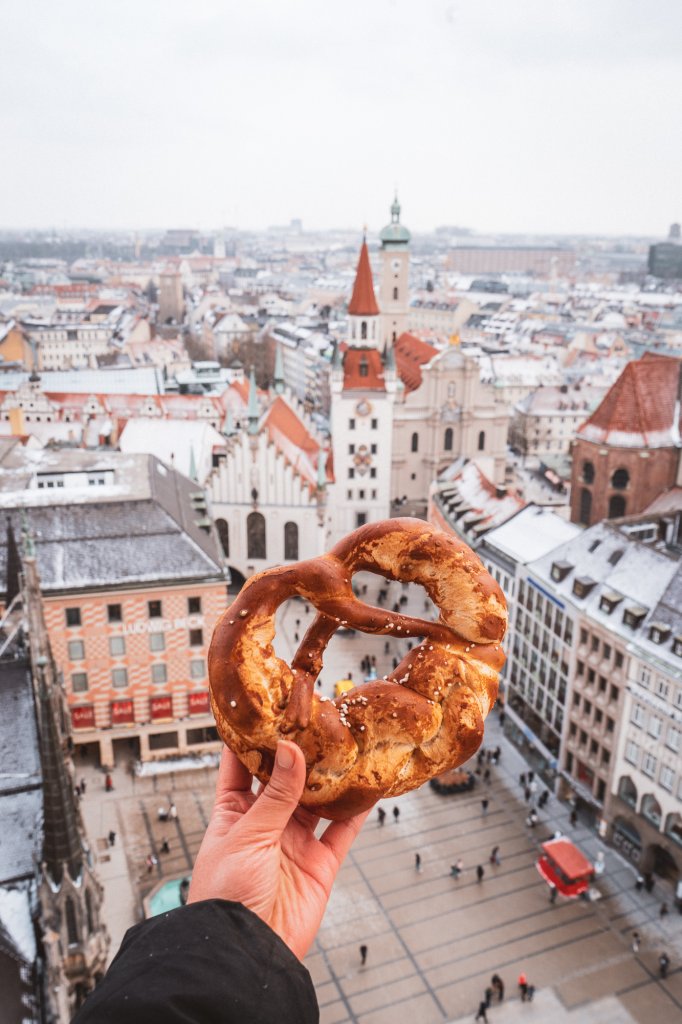
Berchtesgaden National Park
If it’s natural beauty you’re after, Germany’s Berchtesgaden National Park (near the border to Austria) is a must-visit.
Everything here is breathtaking – from the shimmering turquoise lakes and snow-flecked mountains to the adorable Berchtesgaden town center.
And, if you’re up for it, this is the ideal place to enjoy a typically Bavarian wellness weekend.
Why visit Berchtesgaden National Park when you travel Germany:
- Stunning hikes and scenery
- The glorious boat ride on Königssee to see the equally stunning Obersee
- Historic sights like Hitler’s Eagle’s Nest

Hands down one of my favourite places to visit time and time again is Berlin.
This endlessly fascinating city is home to incredible museums, delicious food, and a unique culture that makes it distinct from the rest of the country, despite its status as capital!
Whether you’re a history nerd, an avid partyer, or a famished foodie, Berlin has plenty to offer.
Why visit Berlin when you travel Germany:
- Fascinating history
- World-class museums and attractions
- A thriving nightlife and food scene
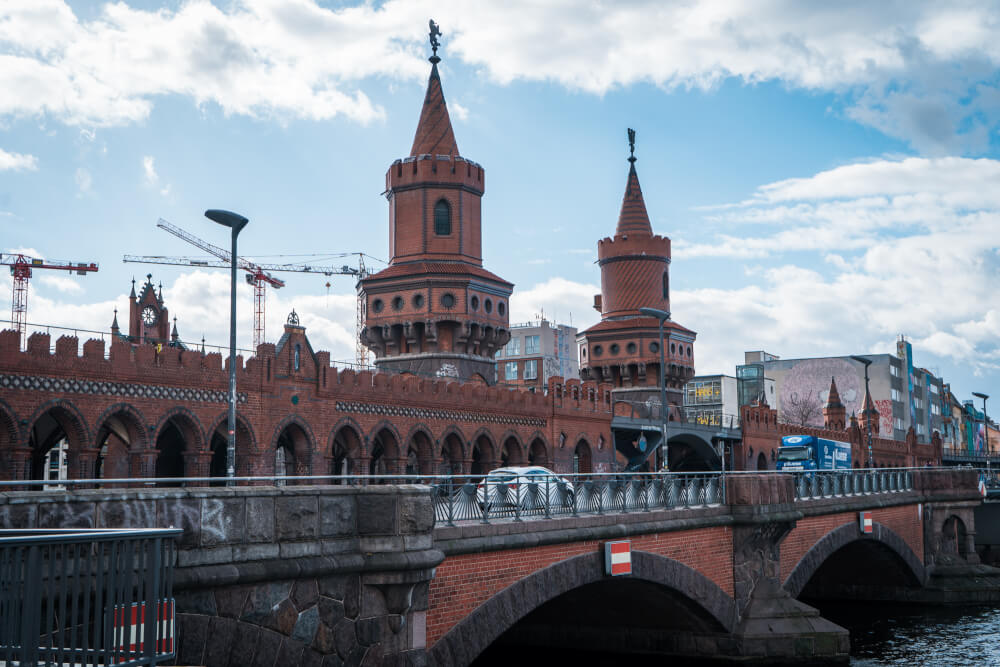
Franconia is a glorious region in northern Bavaria that is divided into Lower, Middle, and Upper Franconia.
To me, it’s one of the most underrated regions in Germany for international visitors, with an abundance of fairytale half-timbered houses, amazing beer, and unique natural landscapes.
Here are some places in Franconia that are absolutely worth visiting:
- Franconian Switzerland
- Würzburg (still haven’t been yet!)
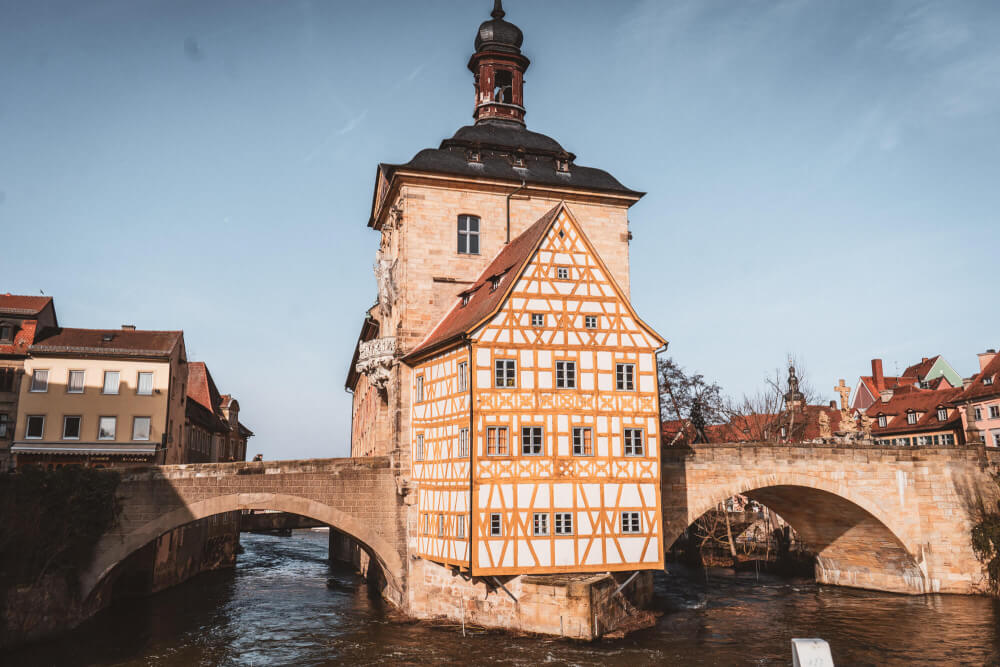
Perhaps the most idyllic entry of this list is Monschau, a sleepy but gorgeous village found near the border to Belgium.
I was lucky enough to come here for Christmas markets a few years ago, and I loved it so much, I skipped the train I’d pre-booked just so I could spend a few more hours there.
Picturesque half-timbered houses clustered around a roaring central river… oh, and a castle on a hill. Because of course they have one.
Why visit Monschau when you travel Germany:
- Super friendly locals
- Picture-perfect scenes at every turn
- Christina might cry if you don’t
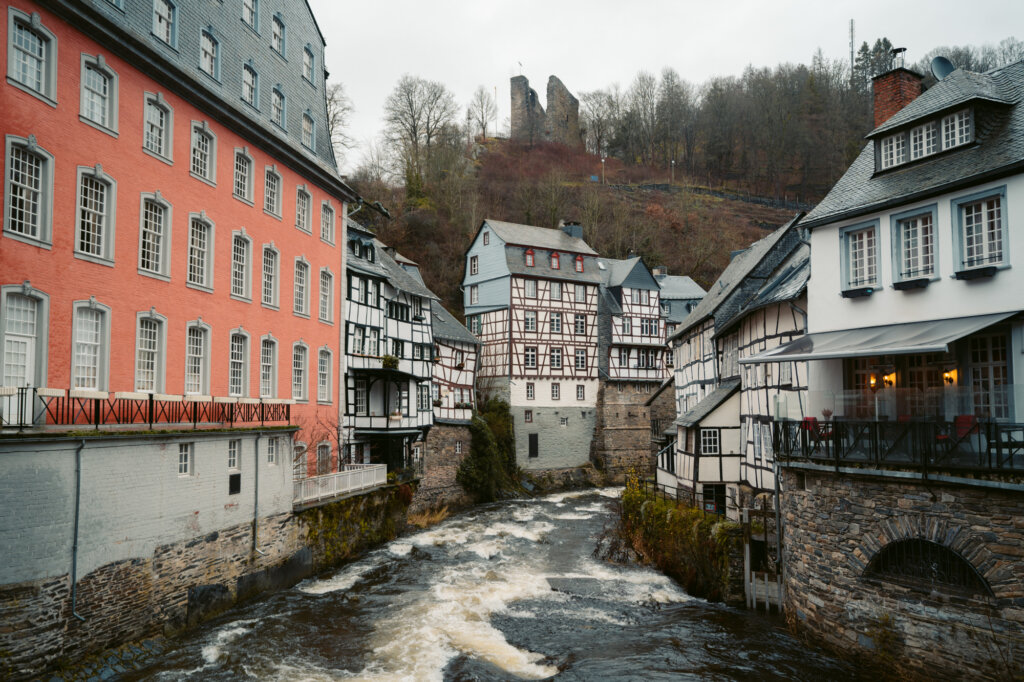
Hamburg is an amazing city I’ve had the chance to visit a few times now. It’s a lifestyle city that reminds me a lot of my hometown, Vancouver.
Home to a mix of classic and modern architecture (including the coolest opera house in the world!), as well as Germany’s #1 attraction – the adorable Miniatur Wonderland, Hamburg has a lot to offer tourists, but perhaps the best way to enjoy it is with a nice beer and sunset along the Elbe.
Why visit Hamburg when you travel Germany :
- Amazing architecture like the Elbphilharmonie
- Fresh and tasty seafood (and a booming foodie scene!)
- A fun, vibrant vibe
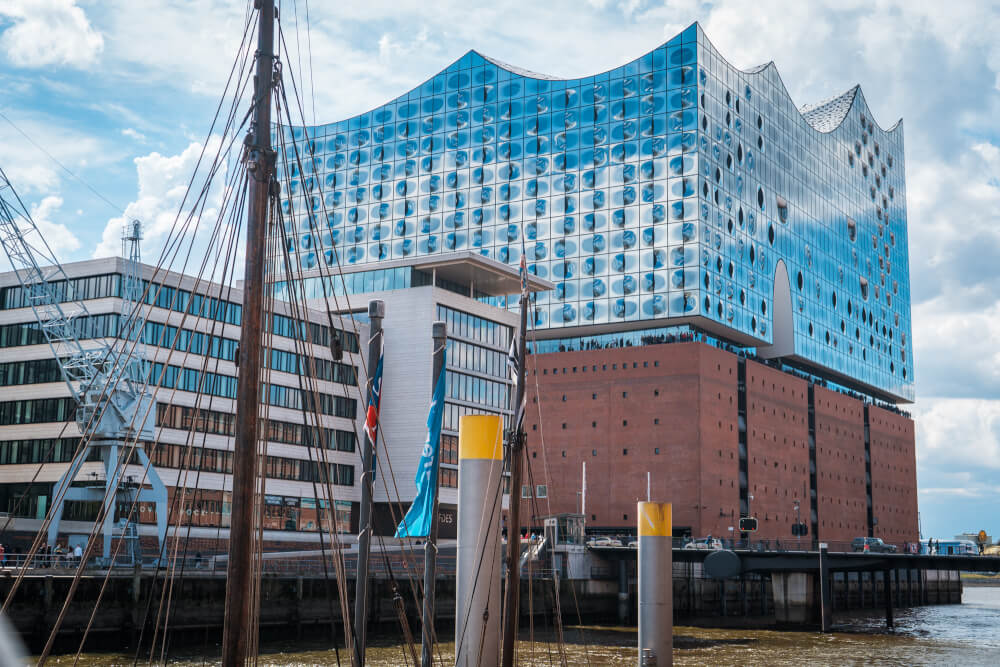
Dresden is one of the most beautiful cities in Germany, and its beauty is all the more astounding when we consider that much of the city was destroyed completely in WWII.
After decades of reconstruction however, Dresden once again shines with its former glory, establishing itself as one of the most important cultural hotspots in Germany.
… and all only a stone’s throw from Saxon Switzerland, one of the most beautiful natural wonders in the country!
Why visit Dresden when you travel Germany :
- Stunning architecture and sights
- World-class museums and culture scene
- Its jawdropping Christmas market (the oldest one in the country!)
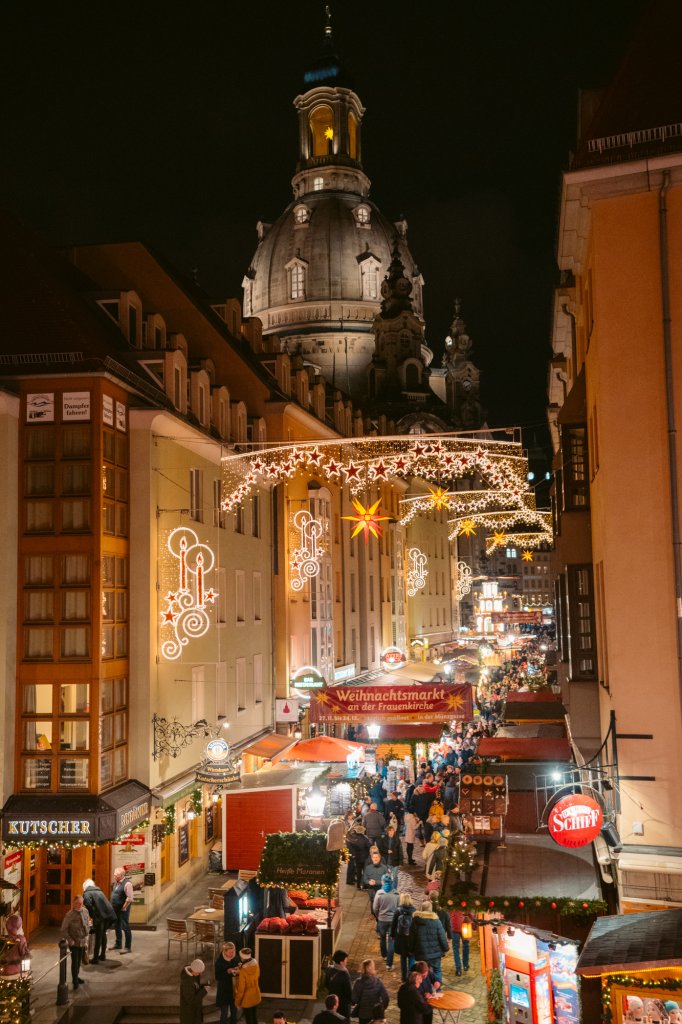
Stuttgart (and its Surrounding Area)
Stuttgart is the biggest city (and capital) of the German state Baden-Württemburg.
It’s perhaps best known as the ‘cradle of the automobile industry’, which explains why it’s home to not just one, but two car-centric museums: one belonging to Mercedes-Benz, and one to Porsche.
Besides cars though, the area around Stuttgart offers up some of the cutest small towns you can find in Germany, all easily reachable by public transport, meaning you get the best of all worlds during a visit here.
Why visit Stuttgart and the surrounding area when you travel Germany:
- Fairytale towns like Esslingen, Ludwigsburg, and Tübingen
- Stuttgart’s Stadtbibliothek, one of the most unique and beautiful libraries in the world
- Lots of fun events like Stuttgart’s Christmas Market and the Cannstatter Volksfest
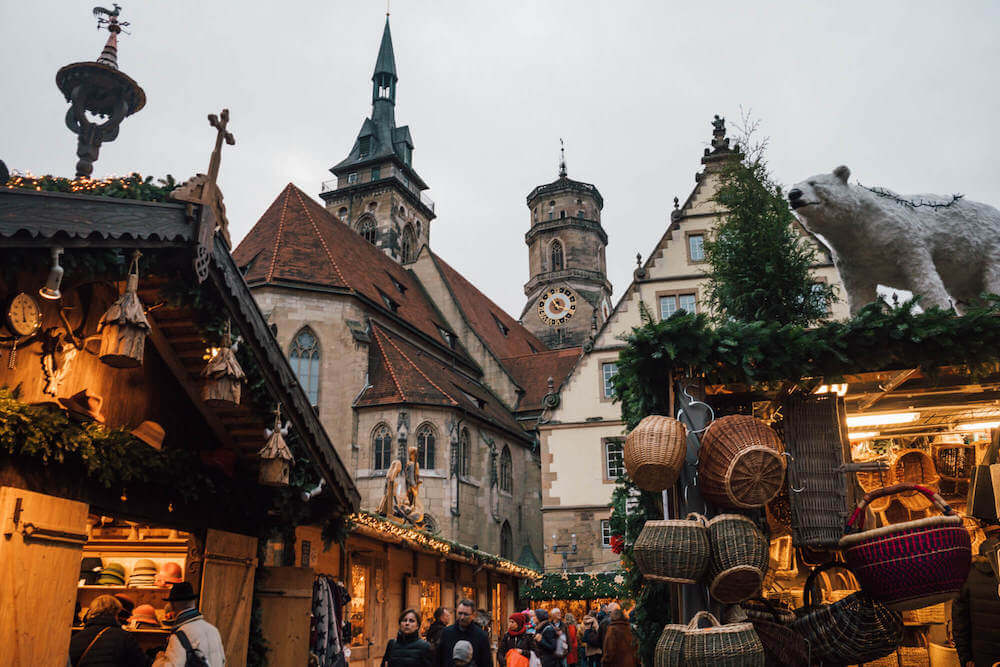
Thuringia is a state often overlooked by international tourists, but if you’re looking for a truly charming German escape, its capital Erfurt makes an excellent choice.
This beautiful city is famed for its unique Krämerbrücke, which is a gorgeous medieval bridge lined with residential buildings.
But that’s not all – there’s also an impressive cathedral, an imposing fortress, and surprises waiting on every corner… quite literally, because Erfurt is the HQ of the German children’s channel KiKA, and there’s plenty of fun statues of famous characters scattered around town.
Why visit Erfurt when you travel Germany:
- Krämerbrücke, the longest inhabited bridge in Europe
- Quirky and fun children’s channel sculptures all over the city
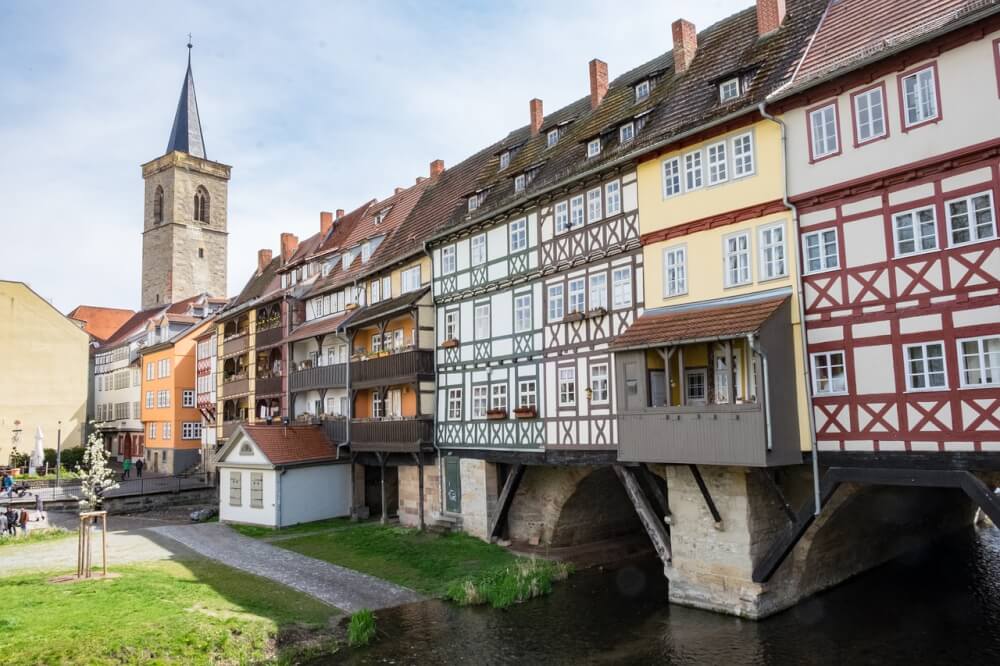
Cologne, to me, is a city synonymous with fun and celebration. While at first glance, it might not rank among the “prettiest” places to visit in Germany (much of it was destroyed in the war), it still boasts several impressive landmarks and sights, like the epic Cologne Cathedral.
Where Cologne really shines though is during special events – the Christmas markets here are some of the best I’ve been to in my entire life, and the Karneval celebrations… well, those are truly epic!
Why visit Cologne when you travel Germany:
- Bucket list events like the Cologne Christmas Market and Kölner Karneval
- The iconic Kölner Dom (Cologne Cathedral), one of the most famous churches in the world
- Fun-loving locals who are among the friendliest I’ve ever encountered in Germany
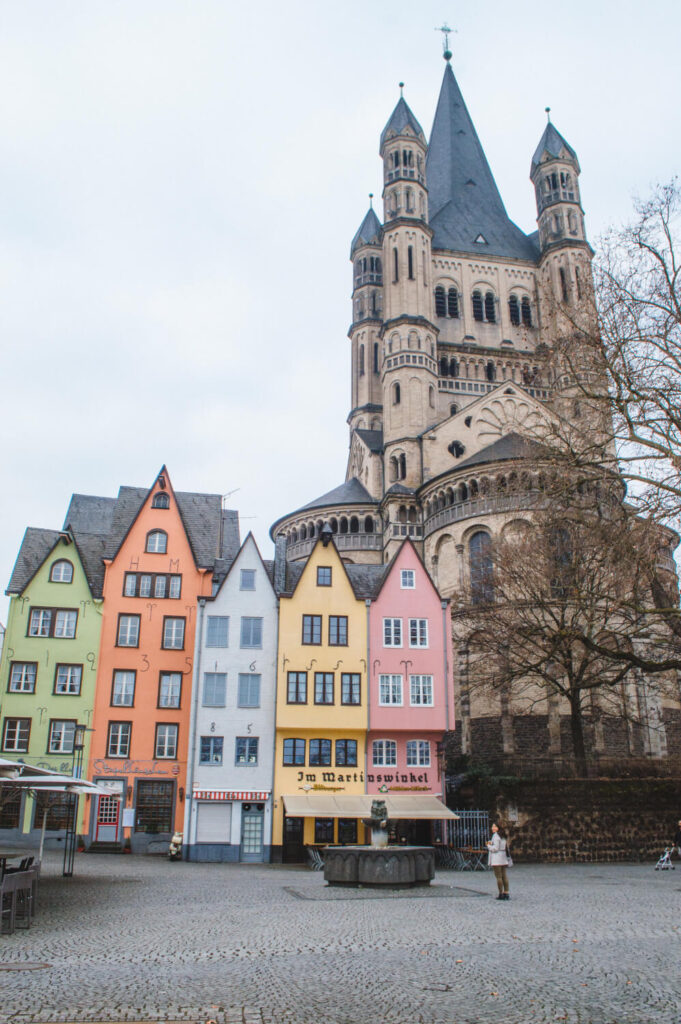
Last but not least, we have Hannover, a city which (in my opinion) is one of the most underrated cities in Germany where tourism is concerned.
Locally, people often joke that Hannover is one of the most boring cities in Germany, but I don’t think that’s true at all. One quick look and you’ll find a stunning palace within the city, an architecturally impressive Town Hall (with a unique elevator offering epic views), and a cool laidback vibe that many compare to what Berlin was like decades ago.
Here are some awesome things to do in Hannover.
Why visit Hannover when you travel Germany:
- Its gorgeous New Town Hall
- The stunning Herrenhausen Palace and its gardens
- A fun, laidback city vibe
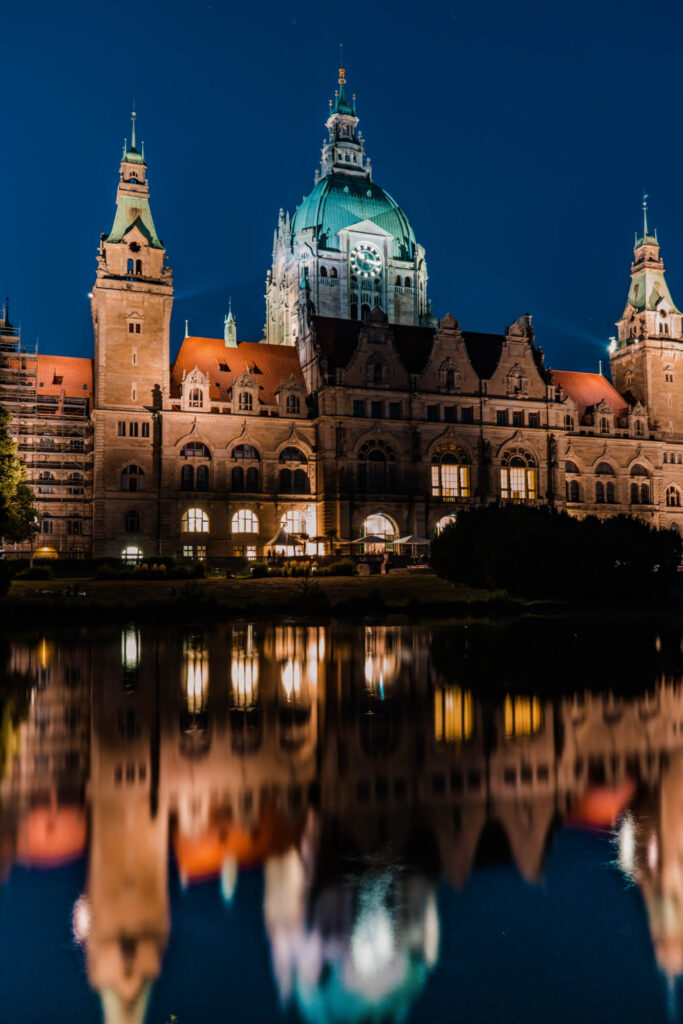
Bucket List Experiences in Germany
Germany is full of incredible bucket list experiences. Here are a few of my favourites:
Christmas Markets
German Christmas markets are the stuff of bucket list dreams.
If you adore Christmas, a German Xmas market trip needs to make it on your bucket list, because nobody captures Christmas coziness and joy quite like the Germans do.
The best part (besides the droolworthy assortment of German Christmas Market foods ) is that you’ll find Christmas markets in just about every city, town, and even the smallest of villages, each with their own unique take on traditions.
Trust me, you could never get bored of visiting these.
Here are some full guides to the Christmas markets I’ve visited in Germany:
- Munich’s Christmas Markets
- Berlin’s Christmas Markets
- Cologne’s Christmas Markets
- Esslingen Christmas Market
- Ludwigsburg Christmas Market
- Karlsruhe Christmas Market
- Düsseldorf Christmas Market
- Nuremberg Christmas Market
- Essen Christmas Market

Oktoberfest
Trust me – Oktoberfest , AKA the world’s largest beer festival, is reason enough to make a trip to Germany.
Typically celebrated annually in Munich, this is one of the most incredible events in the world, with millions of people attending, millions of beer served, and a guaranteed recipe for making memories to last a lifetime.
… If you can remember anything after 5L of beer that is.
Read my full Oktoberfest guide for more details.
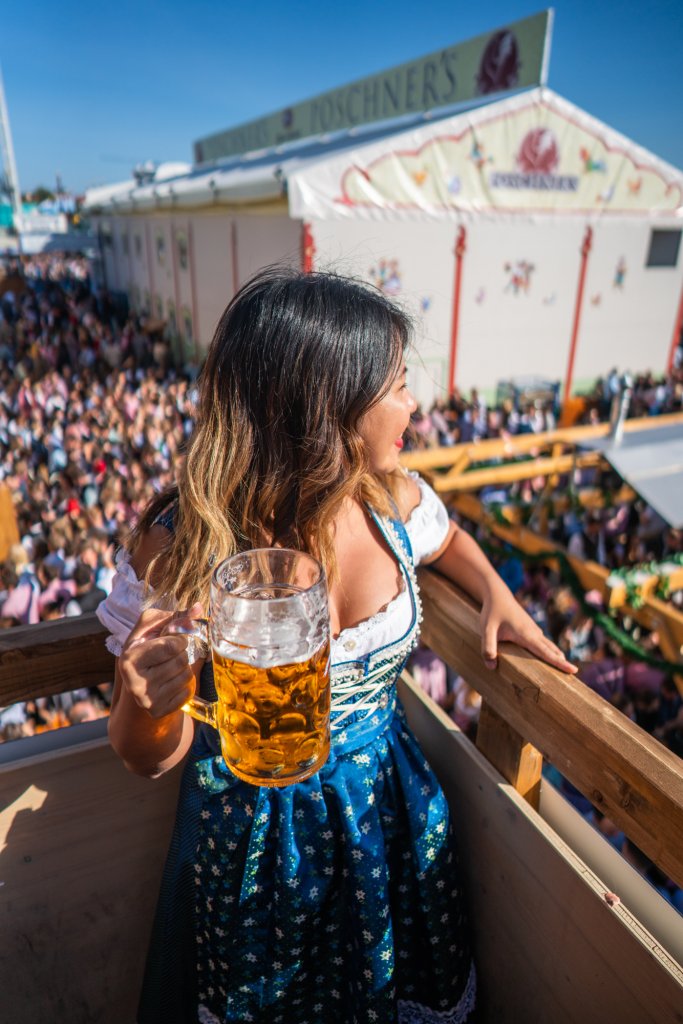
Visiting Fairytale Castles
If you love castles, I recommend avoiding Germany……. because you might just combust from sheer fangirl joy.
Seriously, Germany is every castle lover’s kryptonite, with elegant palaces and fairytale castles in the thousands. If you’re a Disney gal like me who grew up dreaming of happily ever afters, pack a ballgown and head to Germany ASAP.
I promise you won’t be disappointed.
Here are some castles that you must visit in Germany:
- Neuschwanstein Castle
- Nuremberg Castle
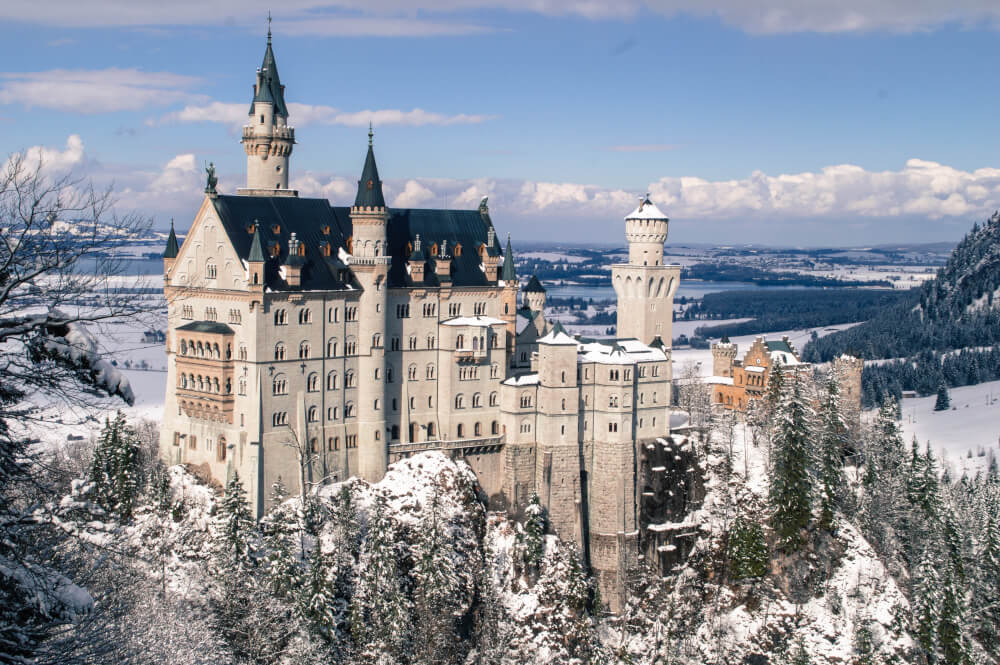
The Cherry Blossoms in Bonn
The cherry blossoms in Bonn (also the birthplace of Beethoven and gummy bear legend, Haribo) are absolutely spectacular, and 100% worth visiting in Spring time. In fact, I’d even say they’re one of the best things to see in Europe at Spring time.
Yes, you, too, can come frolic in these tunnels of pink! Here is my guide on where to find cherry blossoms in Bonn.
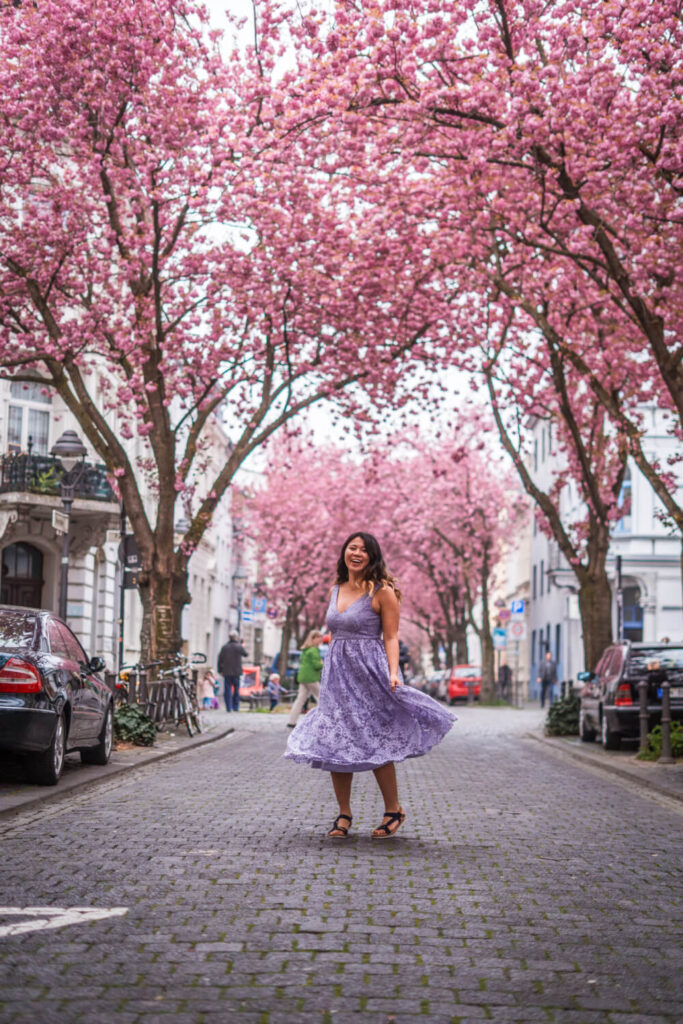
Karneval, Fasching, Etc.
Carnival Season is one of the best times to visit Germany if you’re looking for a party.
The grandest celebrations take place just before Lent, and are celebrated throughout the country, although the festivites in North-Rhine Westphalia are probably the best known.
My top recommendation? Go celebrate in Cologne, where the Kölner Karneval draws millions of visitors every year.
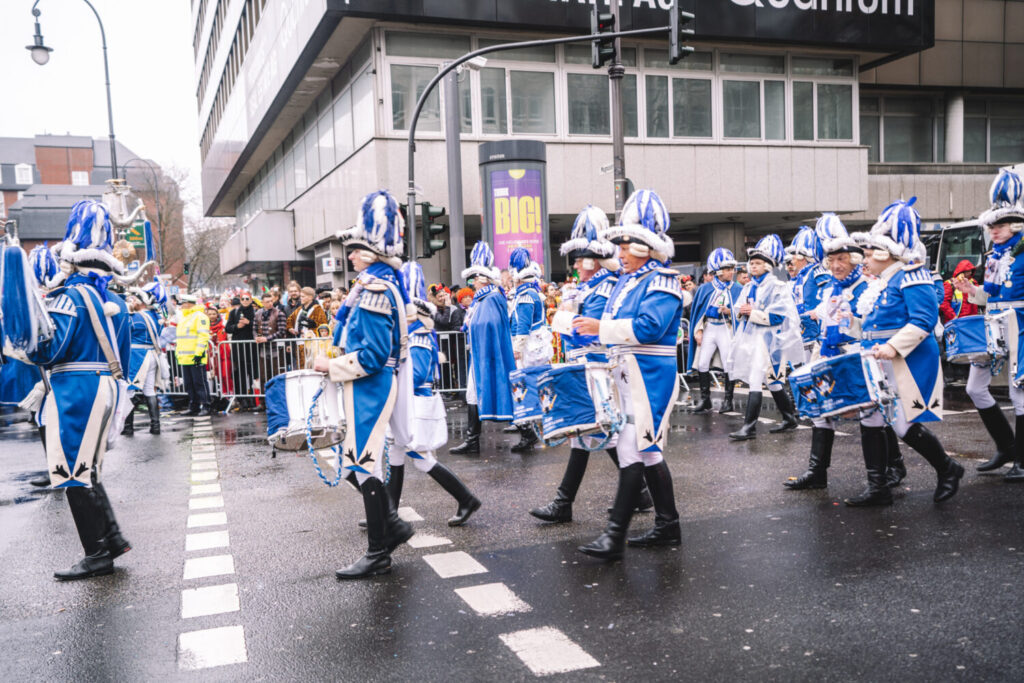
My Recommended Germany Itineraries
Germany is a huge country with a massive diversity in sights… so how can you organize your time efficiently and make the most of your trip? Here are some German trip itinerary ideas…
Germany itinerary ideas for a taste of everything:
- Southern Germany Classic: Munich, the Allgäu (for Castles!), Garmisch Partenkirchen, Berchtesgaden National Park, Stuttgart & Area, Black Forest
- Eastern Germany Classic: Berlin, Dresden, Saxon Switzerland
- Western Germany Classic: Aachen, Monschau, Eifel National Park
- Northern Germany Classic: Hamburg, Bremen , Lübeck, Kiel, Sylt
- The Rhine River Classic: Mainz, Koblenz, Burg Eltz, Cochem, Bonn, Cologne, Düsseldorf
- The Harz Mountains Experience: Harz Mountains, Goslar, Wernigerode, Quedlinburg
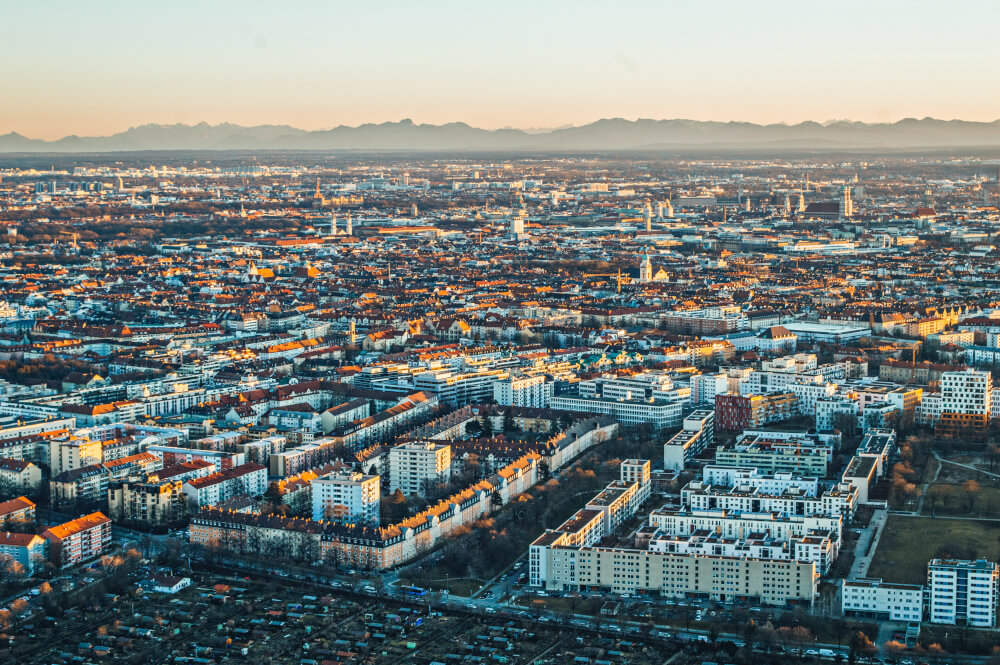
Germany itinerary ideas for city breakers and culture hunters:
- The Big City Tour: Berlin and Munich (a 4 hour express train connects them)
- The BaWu Special: Stuttgart, Ludwigsburg, Tübingen, Esslingen, Heidelberg
- The Bavaria Special: Munich, Nuremberg, Bamberg, Würzburg, Bayreuth
- The Saxony Special: Leipzig, Görlitz, Dresden
- The Rhine City Hop: Bonn, Cologne, Düsseldorf
- The Romantic Villages Hop: Würzburg, Dinkelsbühl, Nördlingen, Rothenburg ob der Tauber, Füssen

Germany itinerary ideas for nature lovers:
- Southern Germany Nature Itinerary: Berchtesgaden National Park, Garmisch-Partenkirchen, the Black Forest and Lake Constance (Bodensee)
- Bavaria’s Best Nature Itinerary: Berchtesgaden National Park, Garmisch-Partenkirchen, Munich’s Lake Region, Franconian Switzerland, Danube Gorge
- Eastern Germany Nature Itinerary: Dresden and Saxon Switzerland National Park

My Top Germany Travel Tips
- If you’re overwhelmed by transport options, Omio is a great resource for comparing trains, buses and flights in Germany at the same time.
- If travelling by train, look into group discount tickets like the Bayern Ticket which give you unlimited train travel for one day on regional trains. It can save you a TON of money.
- If you are traveling to multiple countries nearby (i.e. Switzerland), a Eurail pass might save you money.
Accommodation:
- Booking.com is a great place to search up hotels, and filtering by Free Cancellation allows you to book without paying upfront
- Airbnb can be a very affordable alternative for longer stays/bigger groups
Attractions and Tickets:
- GetYourGuide is a great site for finding tours and attraction tickets
- City passes like the Munich City Pass , Berlin Pass , and the Cologne Card can save you a LOT of money if you plan to visit many tourist attractions in a short time
- If you’re trying to find specific info about a place, try using Google Translate to search in German because German versions of sites always have more info
If you’re past the planning stage and heading to Germany soon, make sure you read this before you go:
- Hilarious must-knows before you visit Germany
More Germany Travel Reads
Feeling inspired to visit Germany after reading all that?
As you can (probably) tell, I’ve written extensively about Germany.
So, here are some more articles that might pique your interest:
- Unique Things to do in Germany (That You Can’t Do Anywhere Else)
- The Best Christmas Markets in Germany
- Hilarious Must-Knows Before You Visit Germany
My Go-To Travel Favourites:
🧳 Eagle Creek: My favourite packing cubes
💳 Wise: For FREE travel friendly credit cards
🍯 Airalo: My go-to eSIM
🏨 Booking.com: For searching hotels
📷 Sony A7IV: My (amazing) camera
✈️ Google Flights : For finding flight deals
🌎 WorldNomads: For travel insurance
🎉 GetYourGuide: For booking activities
4 thoughts on “The Only Germany Travel Guide You’ll Ever Need”
i found myself reading almost every post in your website for days and days and i ABSOLUTELY LOVE IT and adore and thank you for spending so much time and effort to make it so helpful, informative and fun to read. you have helped me plan my trip to munich in december and i cant wait to visit just because of your enthusiasm 🙂
We would like to Thank you for sharing such a beautiful blog! Very informative.
This Germany Travel Guide truly captures the multifaceted beauty of Deutschland, a country that has something to offer to everyone, from culture enthusiasts to nature lovers. Your personal anecdotes from living in Munich make it come alive, making me yearn for a taste of that amazing beer you’ve mentioned, and a wander around the English Garden! The varied seasonal highlights emphasize how Germany is a year-round destination, offering uniquely charming experiences, from the festive winter Christmas markets to the lively summer festivals. It’s heartening to know that navigating around the country is convenient, making it possible to explore its picturesque small towns and vibrant cities. This guide is a treasure trove for anyone planning to travel to Germany – it gives a well-rounded view of the country, infused with personal insights, which makes it even more valuable. I’m particularly intrigued to visit Munich, the city you so passionately call home.
As a Berliner, I can’t agree more with this guide. Germany truly is a delightful mix of tradition and innovation, natural beauty and urban charm, hearty cuisine and diverse cultures. Moving around in Germany is indeed quite convenient thanks to the well-organized public transportation system, including trains, buses, and trams. And yes, English is widely spoken in major cities, so communication shouldn’t be a problem for travelers. As for the varied dialects across regions, it just adds to the unique charm of exploring this beautiful country. Safe travels, fellow adventurers!
Leave a Comment Cancel reply
By using this form you agree with the storage and handling of your data by this website. *
- Black Forest
- Moselle Valley
- Rhine Valley
- 48 Hour Trips
- Long Weekend Trips
- 1 Week Trips
- Beer + Drink Guides
- Christmas Markets
- Coffee Guides
- Restaurant Guides
- Shopping Guides
Welcome to Ausländer, a Germany Travel Blog
When I first moved to Germany, it was difficult to find travel resources in the English language. Germans tend not to boast much about themselves or their nation, so finding blogs or itineraries featuring Germany can be a little difficult. I didn’t know much about traveling within Germany prior to moving here, so I spent a lot of time researching domestic travel destinations. I really wanted to discover this country and get to know it through travel.
There are so many great places and hidden gems in Germany. The travel opportunities here are awesome, but they remain largely unknown to foreigners.
I have discovered so many things while traveling here, which is why I decided to start a Germany travel blog with all my suggestions. There is wealth of discovery awaiting any foreigner who wants to explore Germany, and I am here to share all my tips with you! This blog is meant to be a foreigner’s guide to the best of Germany.
Nice to Meet You!
I’m Megan, the author behind this travel blog about Germany. I moved to Germany in August 2019 to pursue a masters degree in sustainable tourism management. I didn’t know the language, I didn’t know any people here, and I was (naively) ready for the adventure ahead. This blog is a journey through my time and travels in Germany.
Where to Begin with Ausländer
Best cities, restaurants, a foreigner’s guide to the best of germany.
Ausländer means foreigner in German. This word can be used in a negative way, a derogatory way, an othering way. I choose to use it differently — a badge of honor, a word reclaimed by those who live with it. It isn’t always easy to reside in Germany as a foreigner (most of the time it is pretty difficult actually); but I have found so much to love about this country.
I am proud to be foreigner in Germany, trying my best to fit in here and build a life I love in a country I have come to love.
My decision to move to Germany was about pursuing the lifelong dream of living abroad. Traveling is one type of experience, full of excitement, adventure and discovery. Living abroad is a totally different experience. It was something that I knew I wanted to try for myself. Being challenged every day, growing from simple interactions, and learning a new language were all parts of the expat experience I wanted to have.
Discover Some of My Favorite Places in Germany

Perfect Long Weekend Itinerary in the Moselle Wine Valley
How to spend a perfect long weekend in Germany’s Moselle Valley wine region. Visit…

12 Surprisingly Beautiful Small Towns in Germany
There is something a little magical about German small towns. I can never quite…

The Most Beautiful Castles and Palaces in Germany
Germany has the largest network of castles in the world, making seeing a castle…
Get to Know My Home City of Cologne

Ultimate Guide to Germany’s Best Festival: Carnival in Cologne
Carnival in Cologne is the most under-rated German festival that you’re missing. Written by…

Where to Find the Best Brauhaus Beer Halls in Cologne
11 Best Kölsch Beer Halls, Breweries and Brauhaus in Cologne | There are so…

All the Best Asian Restaurants in Cologne
From Korean and Thai to sushi and ramen, discover Cologne’s best Asian restaurants. Curated…

How to Spend 2 Perfect Days in Cologne, Germany
Written by a local, this is your perfect 48 hour Cologne itinerary. Featuring hidden…
Read My Latests Posts

Where to Find the Best Asian Food in Düsseldorf
From Korean and Japanese to Vietnamese and Chinese, amazing Asian cuisine lies around every…

Ultimate 1 Week Road Trip Through the Best of Bavaria
With 1 week in Bavaria, you can explore a few gorgeous cities, including Munich,…

A Foodie’s Guide To Berlin’s Best Bakeries And Brunch Spots
Discover the best places for brunch and baked goods in this curated breakfast guide…
meganarz.travels


How to Spend Three Days in Berlin, Germany: My 2023 Itinerary
When I visited Berlin for the first time, it felt surreal. The capital city of Germany has undergone more transformative events than I can count, and throughout its own history has reached the bottom as well as the top.
And Berlin is a city that has so many stories to tell, from the fall of political regimes to creating an international culture full of diversity, acceptance, and independence. I always believe that every city has a life of its own. History, people, politics, architecture, opportunities: each city has a unique atmosphere that you can’t quite find anywhere else, and the deeper you look, the more the city comes alive for you.
And if there’s one thing I know after having spent some time in this wonderful city, it’s that Berlin knows how to rise from the ashes. In spite of its tumultuous past, Berlin is now the city you go to if you’re looking for open-minded people, a beautiful sense of diversity, and bustling life that burns so strongly that barely anything could douse it.
And that’s probably what I love about Berlin the most. The acceptance of everyone, and the desire to do better, be better, and enjoy life while doing so. Berlin shows the world that even though it was almost destroyed in the war, even though there used to be a wall dividing its citizens, and even though the city lost so much… it also gained. It learned and grew and proved the world that you can rise up and make the world a beautiful place again.
Before I get even soppier, let’s switch the focus to all of the great places you should visit if you’ve decided to spend some time in Berlin. With over 3.8 million inhabitants, Berlin is a huge city that plays an immense role in the European Union and is inevitably tied to European culture and heritage. There are numerous places in Berlin that are a must-see during your stay in the city, from the East Side Gallery to Berliner Fernsehturm to Museum Island.
Berlin weaves the historical and the modern very well together, which means you get to visit a vast number of places that are both of historical value and exciting for people born in the 21st century.
Oh, and while you’re in Berlin, I strongly recommend that you take the bus or subway in order to move between destinations. As I said, the city is really large, and if you attempt to walk it all on foot, you might not be able to get up from the bed the next day. I’m speaking from experience: getting from East Side Gallery to Charlottenburg on foot made me regret I hadn’t worked more on my fitness prior to the trip.
That was the day I swore to myself it’d be the public transport or nothing whilst I’m in Berlin. I also took up jogging.
How Many Days Should You Spend in Berlin?
Three days is the perfect amount of time to spend in Berlin.
With three days, you’ll be able to check out all of the city’s biggest highlights, as well as a few hidden gems, so will be able to leave without feeling as though you missed out on anything major.
I spent three days in Berlin back in 2018, then recently returned for another three days to show my partner everything I adored about it. What can I say? I really do love this city!
With that being said, it’s time to get started: here’s how to spend three days in Berlin.
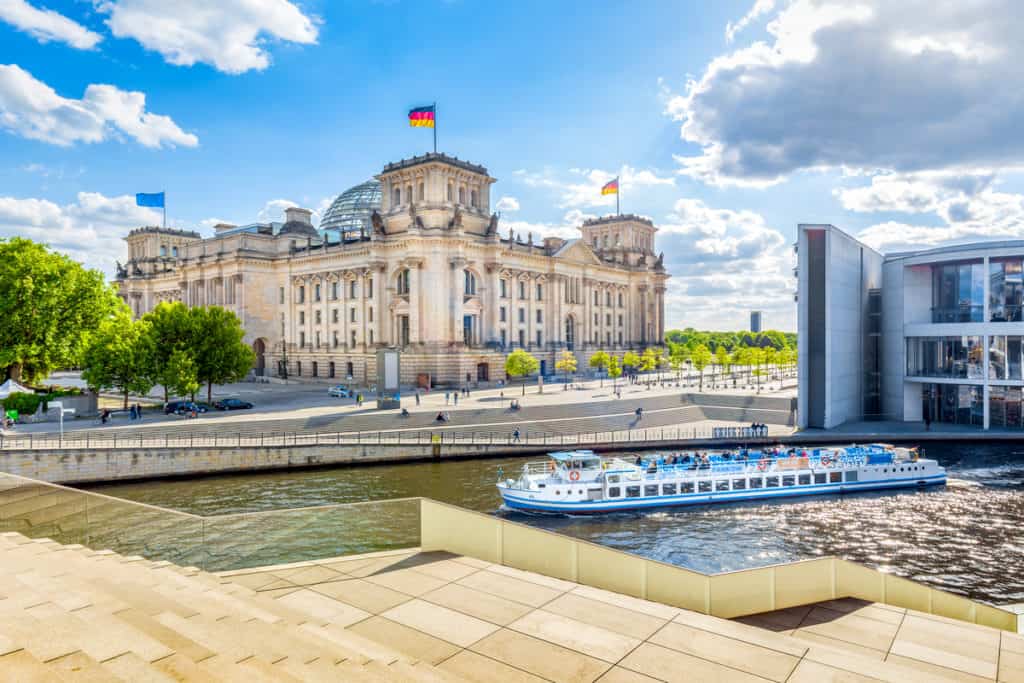
Day 1: It’s All About The Historic Monuments
Whenever I take a city break to somewhere in Europe, I kick off my adventure by heading to the most famous sites. After all, isn’t that why I came here? Yep, when I wake up, I’m ready to leave my hotel room and feel as though I’m unmistakably in the heart of Berlin.
Once you’ve had breakfast, then, take the U5 service directly to the Reichstag: the home of Germany’s parliament. This area can get super-crowded, but has a much more peaceful air in the early-morning, before all of the tour groups have gathered.
This, my friends, is where you can find some of the best views of Berlin.
Entrance to the building is free, and if you look at the photo above, you’ll see a glass dome on top of the roof. Because entrance is free, you’ll need to make a reservation to visit, and it’s regularly fully-booked. As in, you probably should have booked your slot on the Bundestag website two weeks ago. (Hopefully you’re reading this article before you touch down in Berlin!)
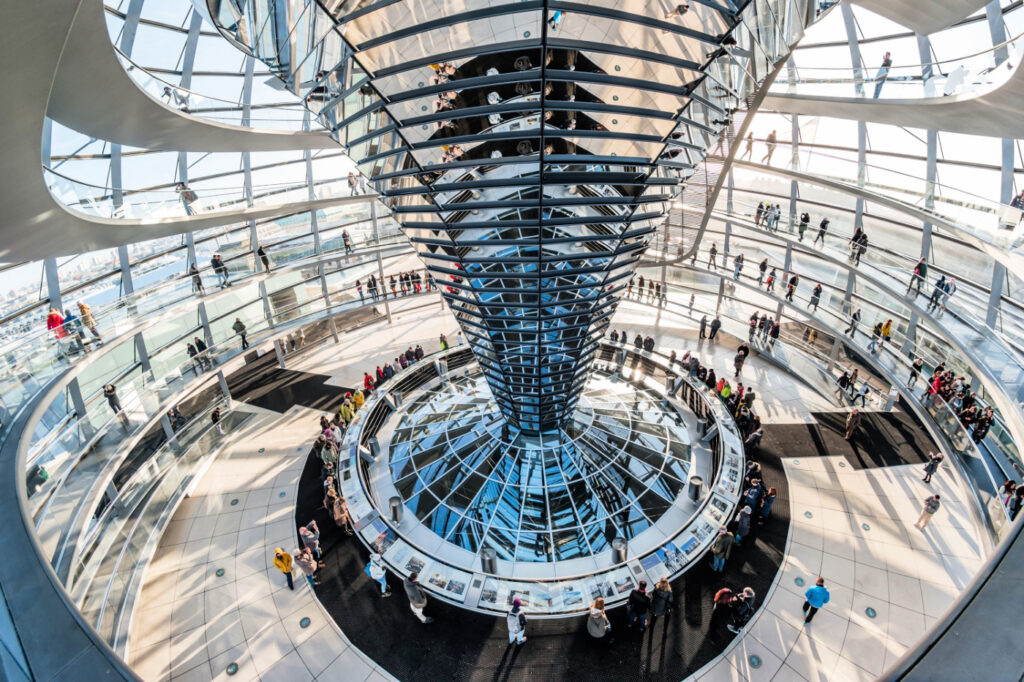
There are some same-day tickets available, but tickets are issued a minimum of two hours before your visit, so it’s kind of a pain to have to leave and come back. You can also visit as part of a guided tour, so that’s definitely an option if it’s all booked up — it’s just €15 for a 90-minute tour . You can check availability for that using the widget below:
Once you’ve finished up at the Reichstag, it’s time to make the three-minute stroll over to Brandenburg Gate, the most well-known landmark in Berlin.
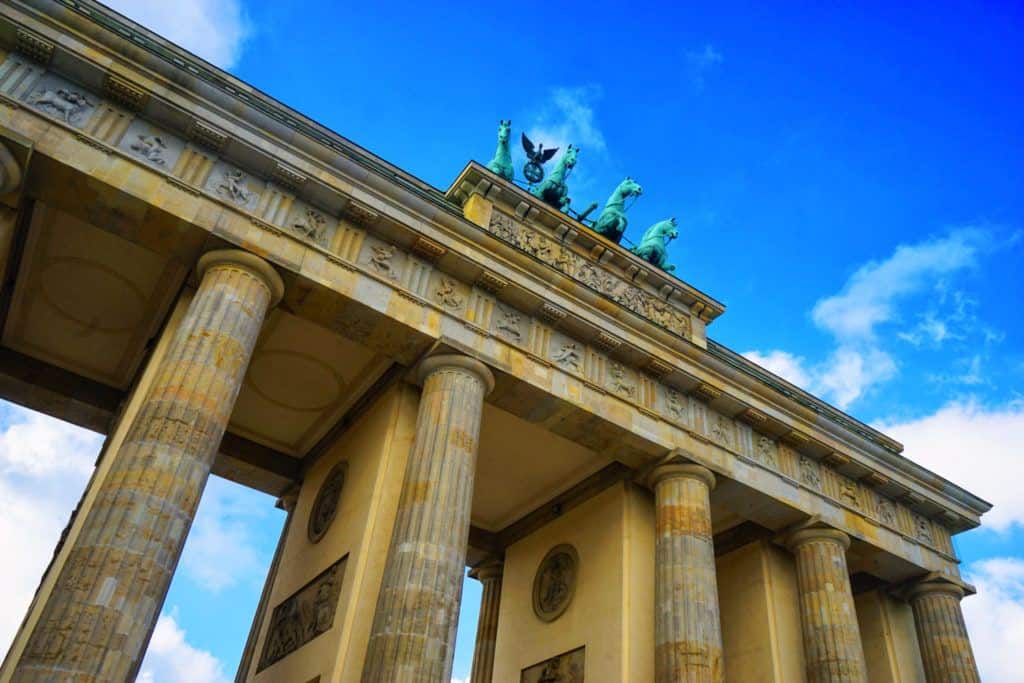
Once a symbol of a divided city, it is now a national symbol of peace and unity. Again, the earlier the better to see this historic gate to avoid huge crowds.
At night, there is a cool light show on the gate itself. It is a majestic landmark closely located next to lots of other attractions, so it makes a great stop on your sightseeing tour of Berlin’s history.
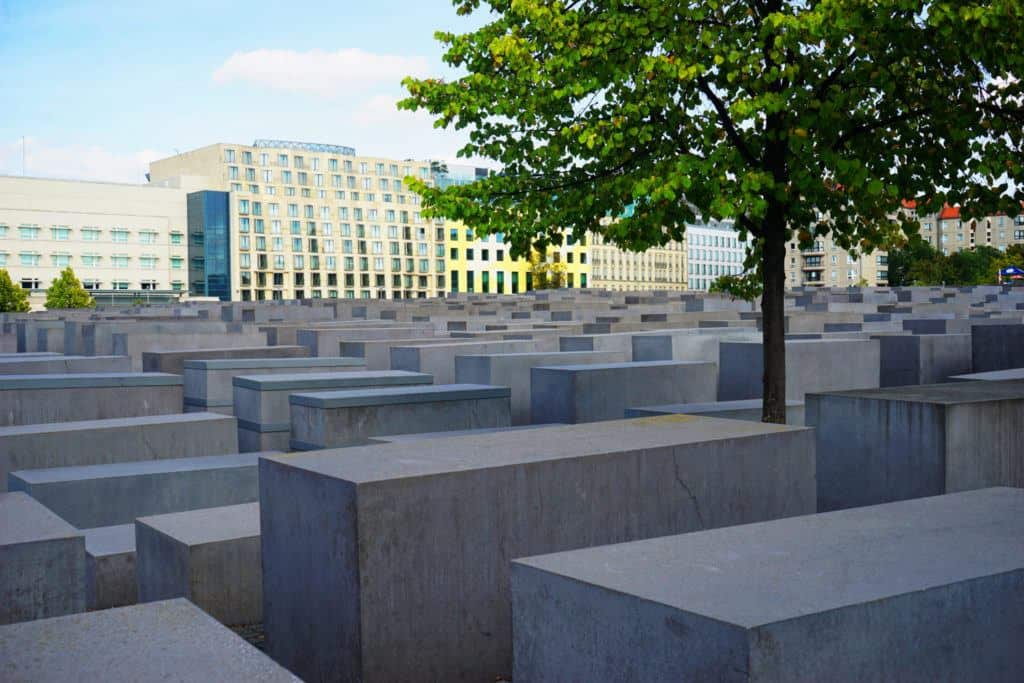
Another two-minute walk is needed to visit the sombre Memorial to the Murdered Jews of Europe.
It is a place of respect consisting of 2,711 concrete slabs arranged in a grid pattern. Situated on a former section of the Berlin Wall, it is one of the main tourist sites in Berlin since its inauguration in 2005.
An attached underground ‘Place of Information’ writes the names of approximately three million Jewish Holocaust victims.
Exuding a haunted, silent and sensitive aura, this is a place of commemoration and contemplation. Do not be tempted to sit on these memorial blocks or take excessive photographs.
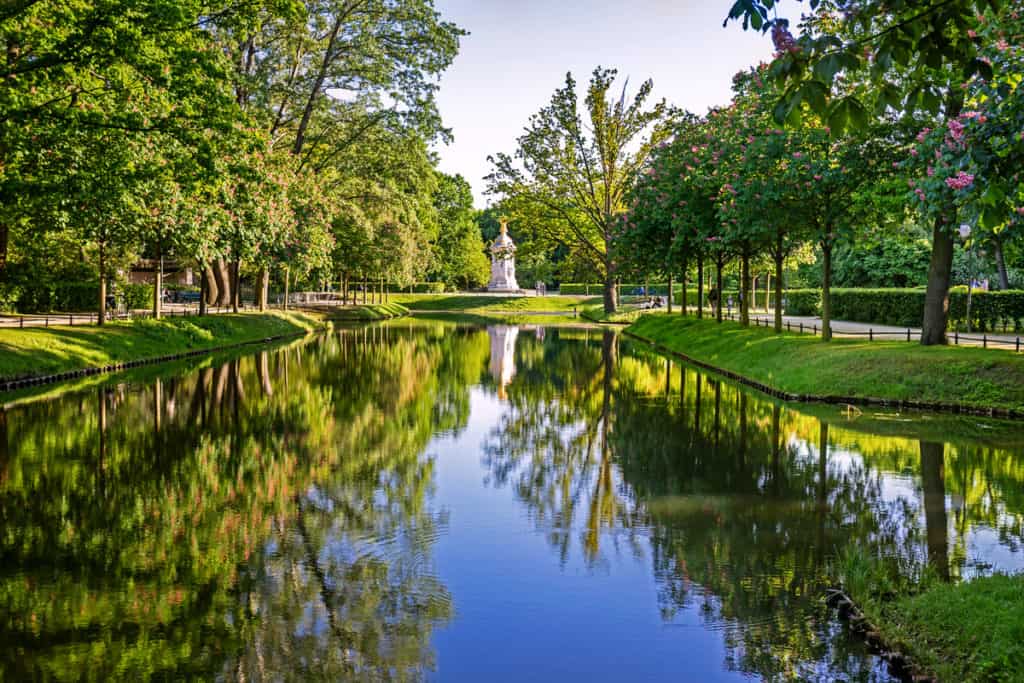
Located nearby is Tiergarten Park, a perfect escape for peaceful solitude. Translated loosely to Animal Gardens, I would personally recommend walking through the lush greenery to find an ideal spot for a lunch picnic.
It is vast: 500 acres are filled with wildlife and greenery. It also holds the zoo towards the west end of the park, if you fancy a lunchtime peak at the animals (you have to book to enter).
In the precise middle point of the Tiergarten, you will find the Victory Column. It is a monument, a giant pillar of Germany’s past military victories over France and Prussia.
Only €3 to climb, it boasts amazing views of the whole city’s urban centre. Just to note, take care when climbing the narrow winding staircase – if you feel claustrophobic it is perhaps not the best option to climb this column.
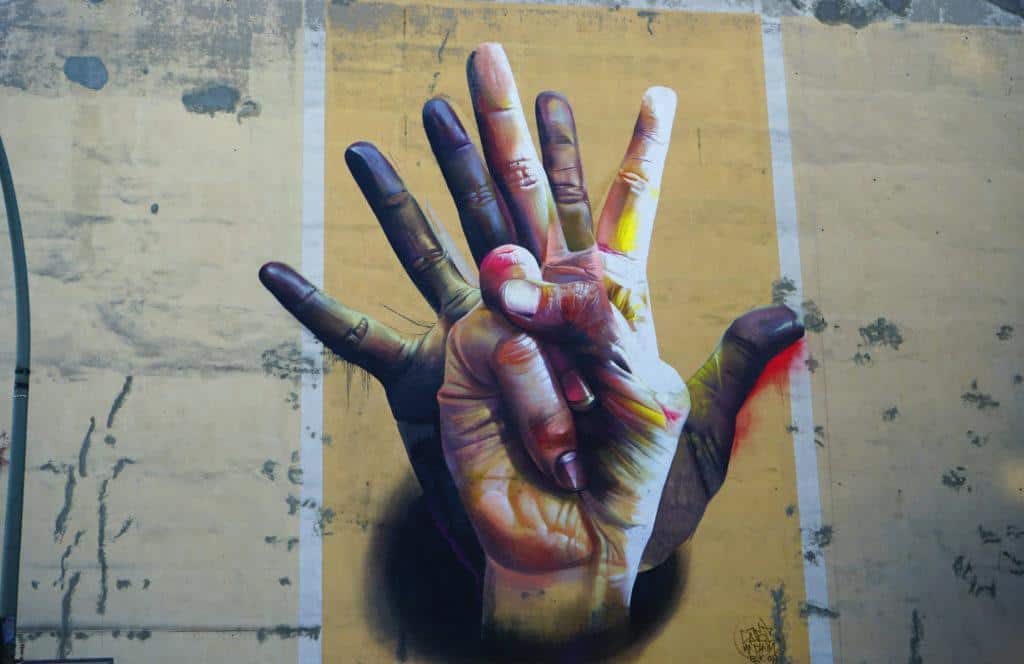
After lunch, venture to Hackescher Markt S-Bahn station, for one of the coolest street art tours I’ve ever taken.
Original Berlin Walks runs the tour, and will tell you all there is to know about street art in this city, as well as let you experience Berlin’s alternative urban art culture, taking you to secret spots around East Berlin. You will become well-versed in the history of the graffiti on the Berlin Wall.
Perhaps most interesting is the exploration of culture and politics behind the street art galleries.
The duration is three hours and is €20 per person – you get free cancellation up to 24 hours in advance. Book your tour here and become an expert in street art.
If after a street art tour you are feeling inspired to create some art yourself, there is a graffiti workshop held at a section of the Berlin Wall.
It’s €105.50 per person and it is likely to sell out as it is a huge success and is great fun to unleash your inner Banksy!
They begin the workshop with an interesting discussion about graffiti culture, and afterwards, the entire group will paint together, having lasting memories with professional photographs taken of your artwork.
Only lasting 1.5 hours, it is a great way to get some creative juices flowing, in between sightseeing Berlin’s marvellous places.
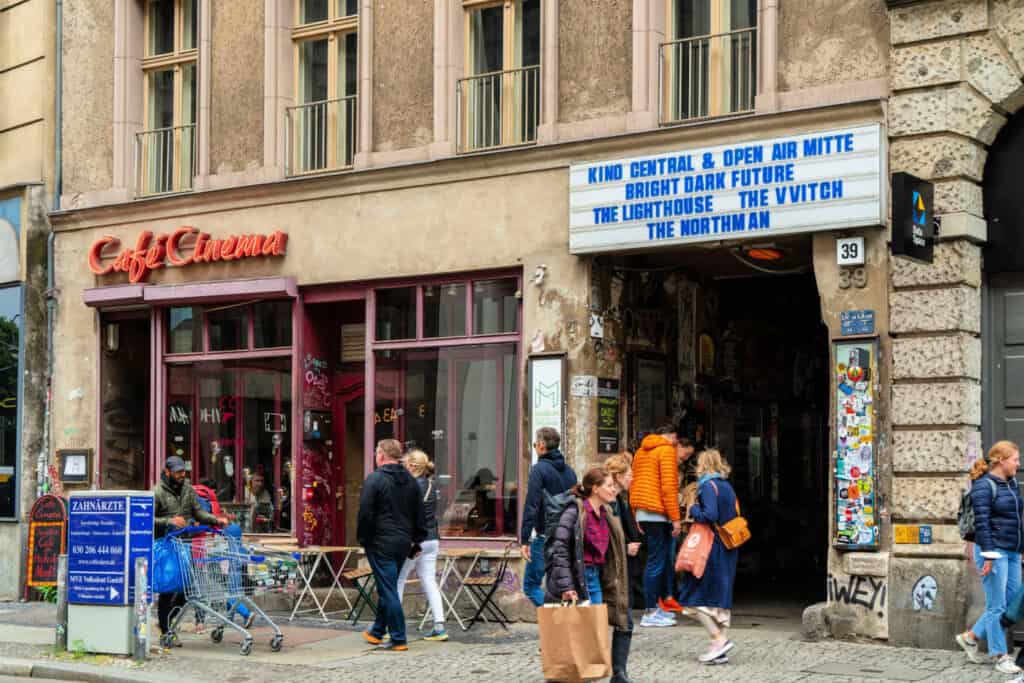
Day 2: East Berlin
Begin the day by searching for the Hackescher Markt hidden alley, one of the quirkiest spots in the city. To find it, however, maybe a bit tricky.
Head to the Cinema Café on Rosenthaler Strasse where an unassuming alleyway runs alongside it. After a dark entrance, you are greeted with a vibrant courtyard. It is home to many hipster cafes, artsy stores and boutiques and, of course, captivating street art.
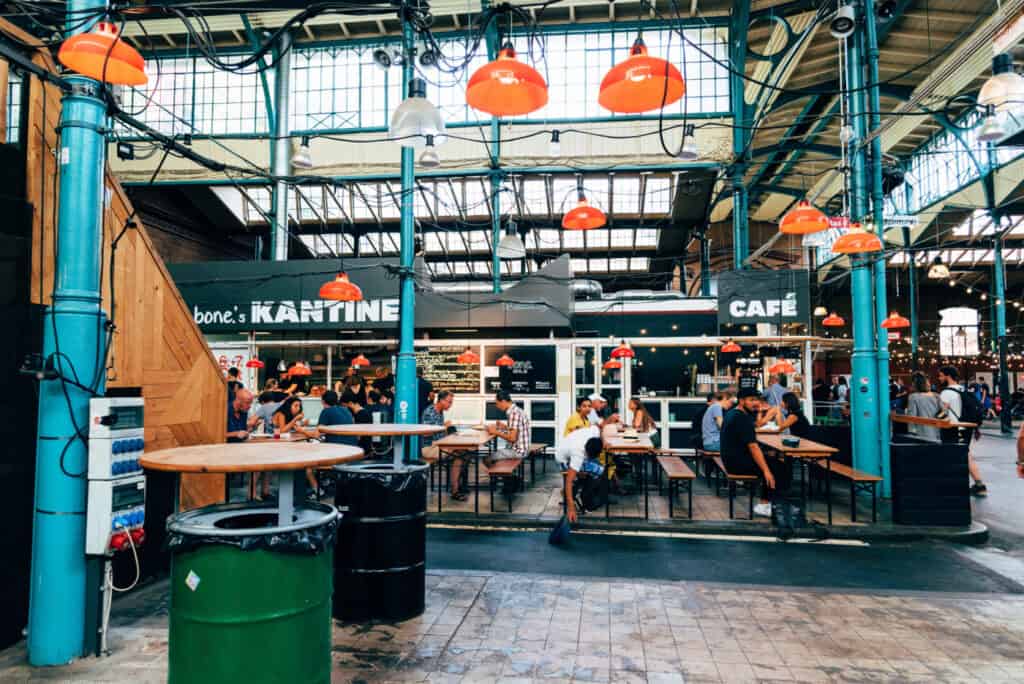
For a respite from the sightseeing, I would recommend taking a look at the indoor market situated south of the river, parallel to the East Side Gallery. Markthalle Neun is an indoor market with international food vendors and shops. It occasionally puts on community events, but its street food to choose from is the winning prize for coming here.
Berlin is very vegan and vegetarian friendly. Many of the stalls are fully vegan and there are plenty of plant-based options to choose from. In addition, you can find wild oysters, bone broth, BBQ pulled pork sandwiches, artisan cheese, and of course, cocktails and craft beer. For a spot of lunch or a savoury mid-morning snack with an abundance of options, this is the perfect place to wander around before venturing on to the next stop.
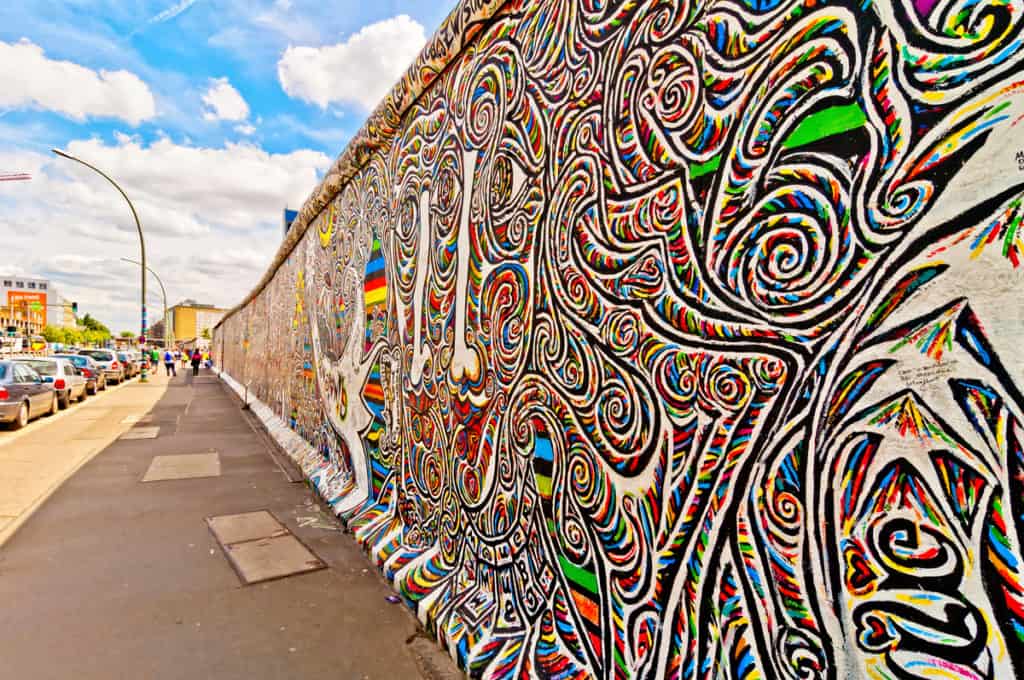
Now with a satisfied stomach and mind, head towards the Oberbaum Bridge to cross to the other side of the river.
With a historic double-deck pathway overlooking the River Spree, you’ll find a landmark opened in 1896, a great bridge to snap a picture of the water’s reflection and the domed arches that accompany the bridge. Once you have arrived at the other point, the famous East Side Gallery awaits you.
The East Side Gallery is a section of the Berlin wall which stands as a site of street art. It is 1316m long, sitting along the eastern bank of the Spree River and is considered the longest open-air gallery in the world.
After the fall of the Berlin Wall, artists from 21 countries came to paint murals to celebrate Germany being reunited and to never forget the atrocities that occurred here in Berlin.
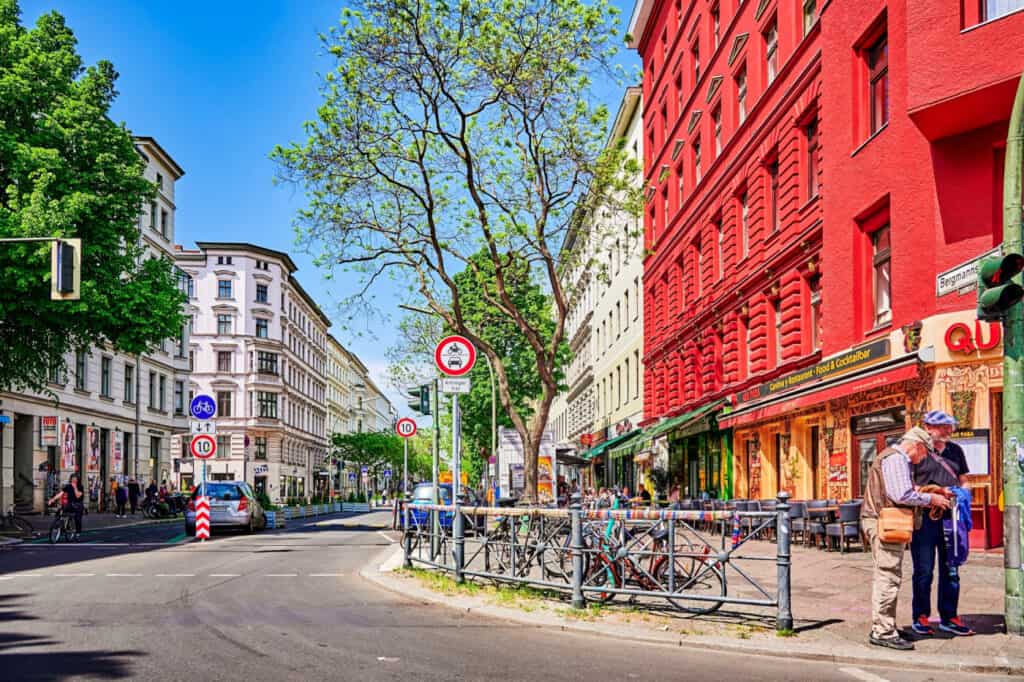
I would recommend working your way from East to Central, stopping whenever you feel called to the artwork and its messages conveyed. From the end of the East Side Gallery, I would pick up an E-Scooter to explore the remaining parts of East Berlin before proceeding to the district of Kreuzberg. If scooting down the ordered streets of Berlin does not entice you, walking is always a good best option, or you can hire a bicycle instead.
Full of artists, bars with outdoor seating, falafel and shawarma joints, and record and bookstores, Kreuzberg is a neighbourhood that is home to a large Turkish population, making it a bustling, diverse place with lots to see.
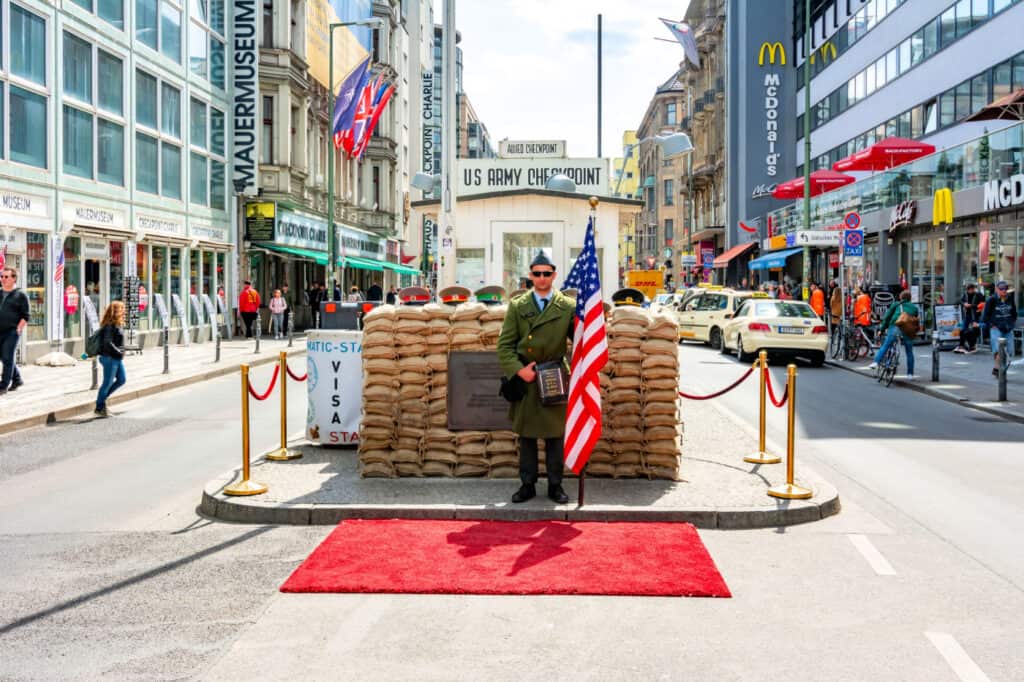
Oraniestraße is a long street stretching from Kreuzberg to Checkpoint Charlie. You can either walk the whole way or take an E-Scooter or bike to sightsee but with added speed and some fresh air!
Before visiting the Topography of Terror, Checkpoint Charlie is a historical landmark marking the boundary of east and west Berlin. You are greeted with a white sentry guard house and a cobbled border line.
Tourists queue up to take a photograph with the guards, but I suggest you skip this part and simply admire the symbol of history that stands in front of you.
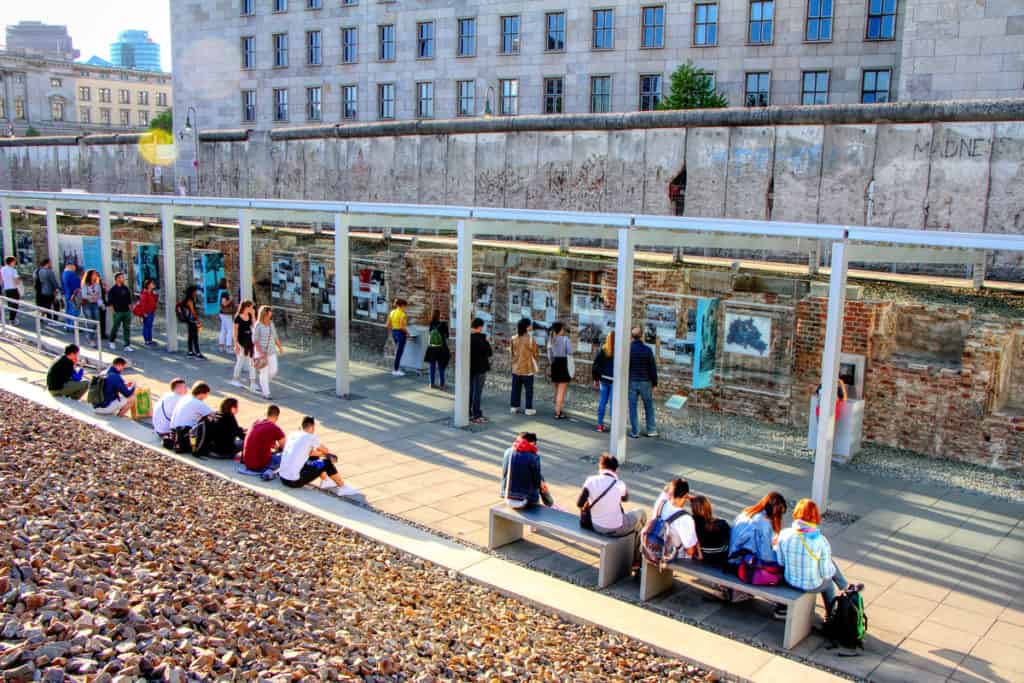
To connect the dots of the story of the Third Reich, visiting the Topography of Terror will give you an insight into the troubled past. It is an open-air exhibition on excavated ruins of the headquarters of the Secret State Police, the SS and the Reich Security Main Office.
If you do not end up visiting part of the Berlin Wall, this site includes 200m of the wall, marking the border between the districts of Mitte (East Berlin) and Kreuzberg (West Berlin).
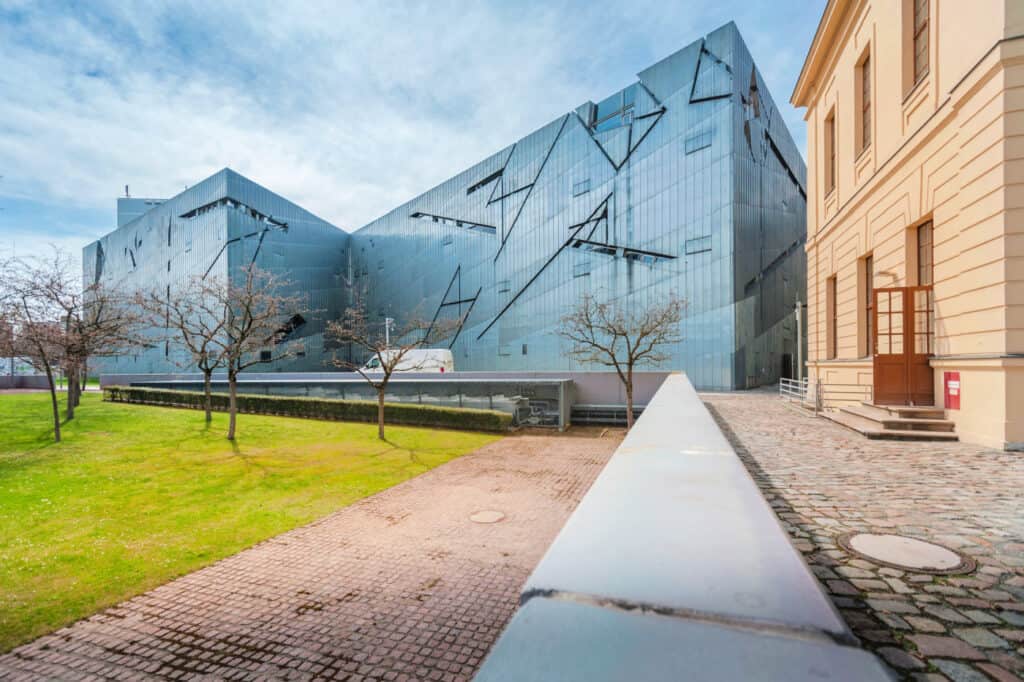
If you have time and want a deeper explanation and story of Berlin’s complex past, the Jewish Museum is a must-visit. Here, you can learn more about the personal stories of the Jewish community.
The building and museum were designed by Daniel Libeskind – this particular building became an important part of the city, its history and its attempt to understand its past. What is quite special about this museum is that it opens the floor for Jews to tell their personal stories, hearing anecdotes and real sentiments of that particular time in the flesh.
Closing at 7 pm, you have plenty of time during the day or late afternoon to explore this striking contemporary building and what it has to offer.
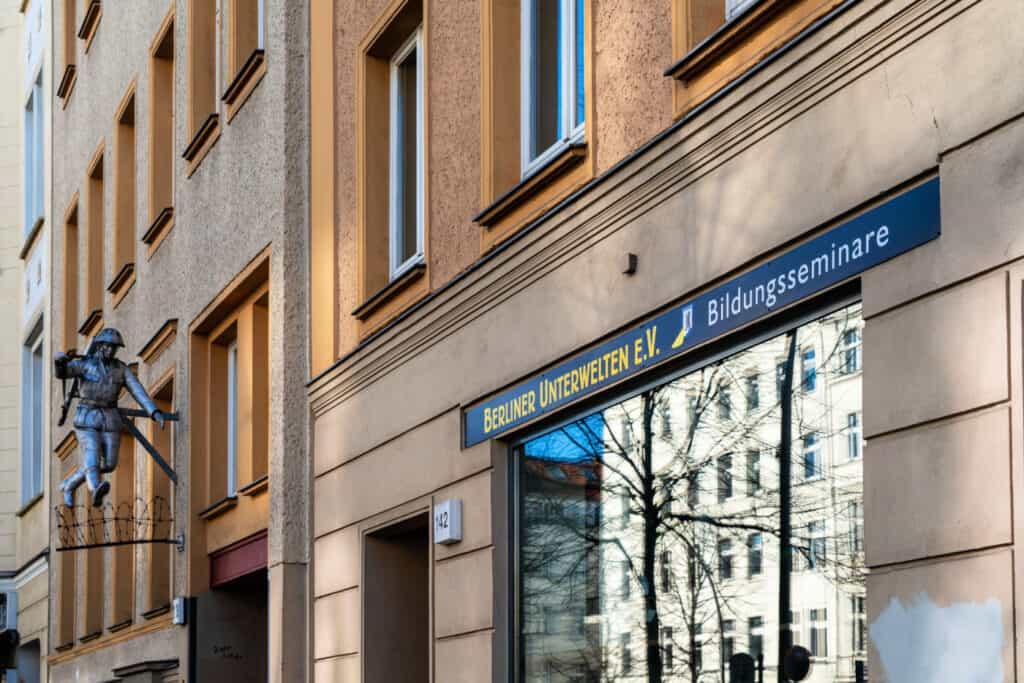
Day 3: Tours, Tours, Tours!
It’s the last day of your action-packed trip to Berlin, and we’re going to be spending the entirety of it in the northeast of the city, first beginning underground.
Yes, underground .
I was surprised to discover just how much this city has to offer to those who want to venture below the streets, from air raid shelters to escape tunnels that were dug beneath the Berlin Wall.
The tours are run by Berliner Unterwelton , who have four different options, all running every single day. My biggest tip is that you buy your tickets in advance, because they do sell out. My parents took Tour M — the one that takes you beneath the Berlin Wall — when they were in town and highly recommended it to me. I procrastinated, turned up to the ticket office an hour beforehand, and discovered it was sold out! Whoops . Learn from my mistakes and book your tour at least a week in advance.
Still, it wasn’t a huge disaster, as an alternative tour, Tour 1, had availability, so I jumped on that, and got to experience WWII bombing raids through the eyes of German civilians. It was fascinating .
I wrote an in-depth guide to my experience on Tour 1 , which included quite an embarrassing mishap part-way through!
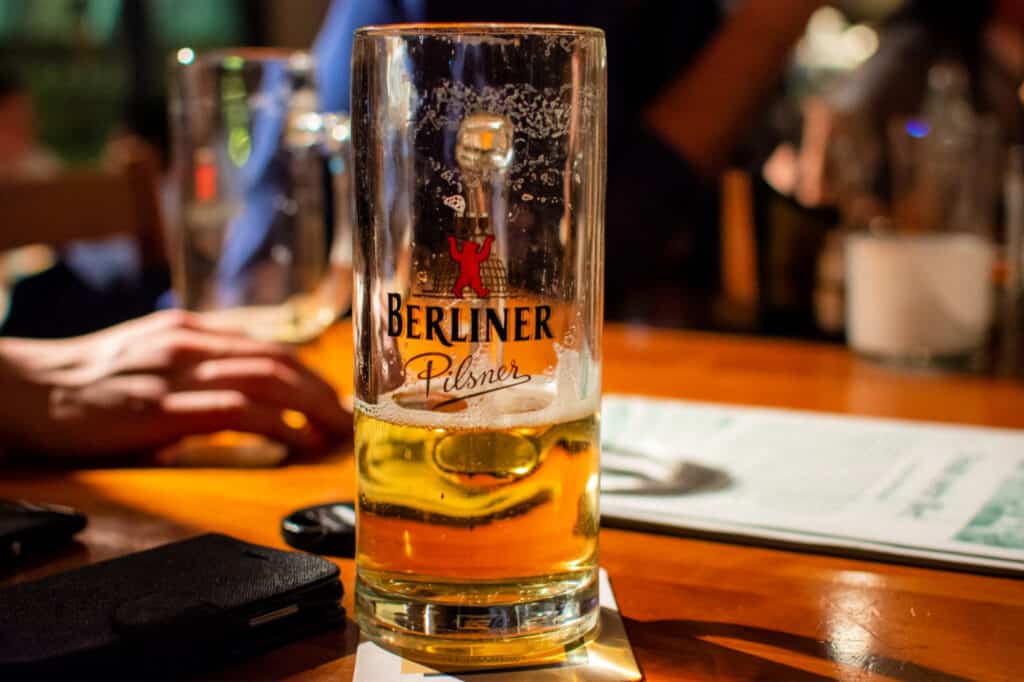
Next on the itinerary is another tour, but this time exploring Berlin’s craft beer scene. If you thoroughly enjoy craft beer, Berlin is the place for you. On Airbnb, you can find an experience to help you better explore beer culture. From €46 per person, the tour lasts 3.5 hours, meaning you will get an in-depth explanation of all there is to know about craft beer.
Meeting in Prenzlauer Berg, you will head to a craft brewery built in 1893. You will inspect brewing kettles and understand the brewing process, getting the chance to taste the beer and learn about its history. Then, craft beer bar hopping is on the agenda, with the last one situated next to Berlin’s famous Mauerpark. If you are interested, book your tour ticket here .
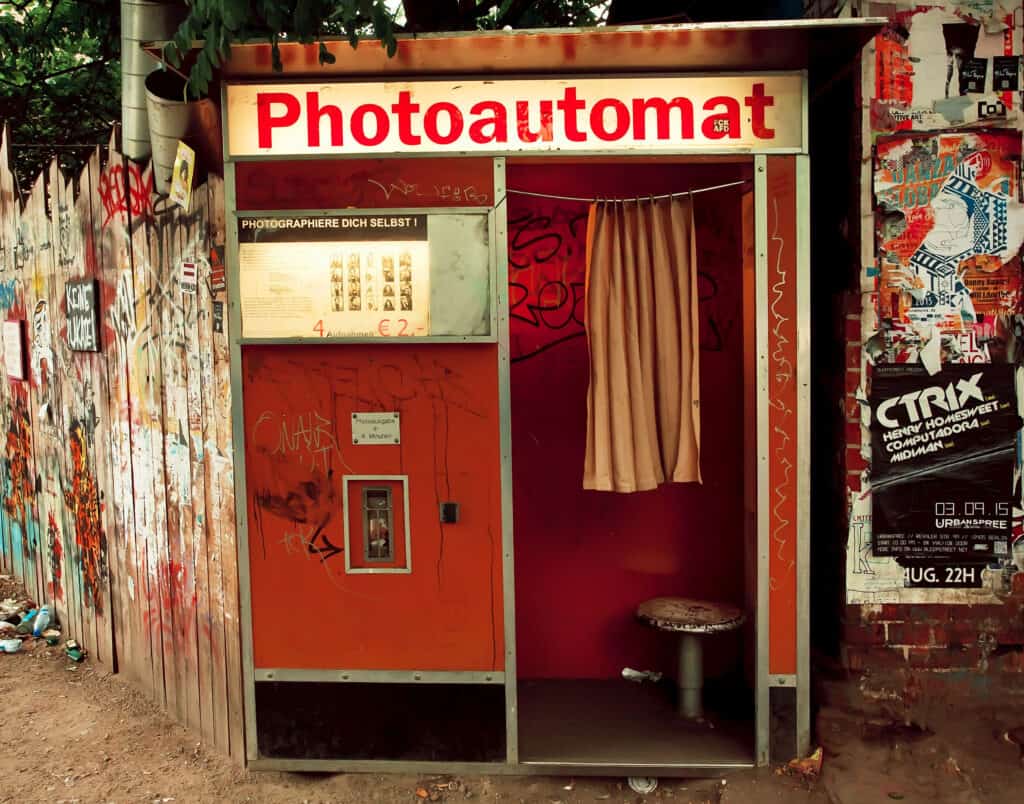
On the way to the subway, you will find a Photoautomat, an old-school photo booth. Only costing €2, it is a great way to make a memory of your time here in Berlin.

If you have time, I would recommend one last museum to visit. The Stasi Museum is a museum dedicated to the history of the terrifying secret police, the GDR. It is estimated that one in 10 East Germans worked as an informant for the Stasi in 1949. The museum also highlights Orwellian brainwashing that took place in schools.
After a long day of exploring the city, end your night by treating yourself to a cocktail at a speakeasy bar. If you are thinking of going out after to one of Berlin’s many clubs, you can treat this space as a place for starting your night in style, before a long night ahead.
These particular types of bars are very common on the East side of Berlin and are enjoyed by locals and visitors alike. The Becketts Kopf in Prenzlauer Berg is a chill spot where you can relax inside on red leather sofas. I must add that there is no standing allowed inside so show up relatively early to find a seat. To get in, there is a photograph of Beckett hanging in the window of the bar. Ring the buzzer and check for availability inside.
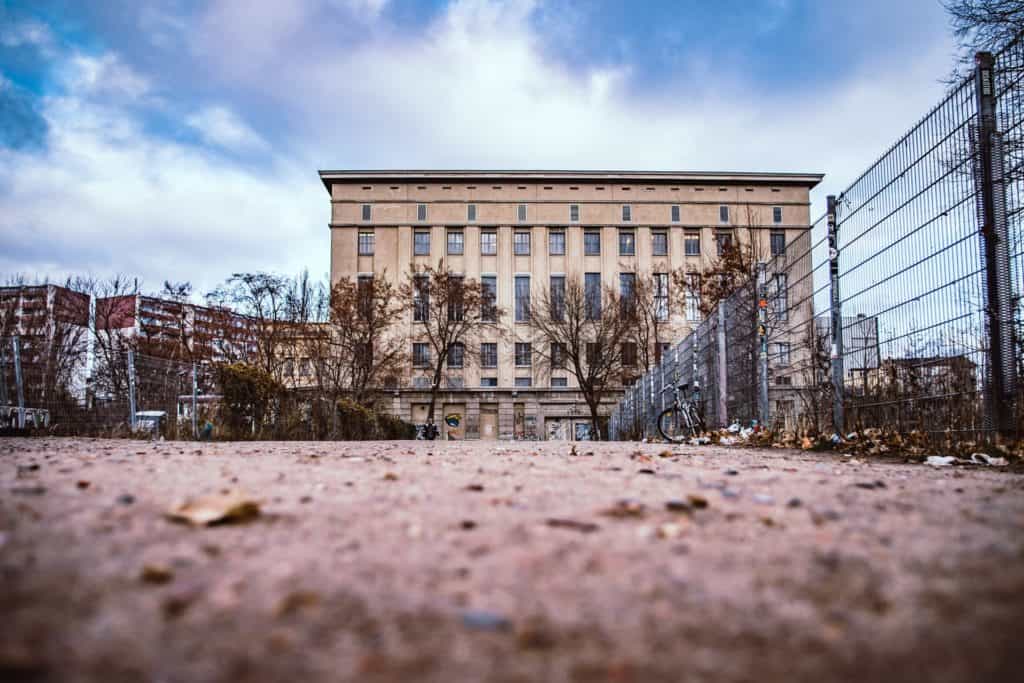
If you are into techno, you can try to get into the infamous Berghain club. If that’s not your go-to option, yet you still want to enjoy the techno scene, I would recommend Tresor which is in Kreuzberg.
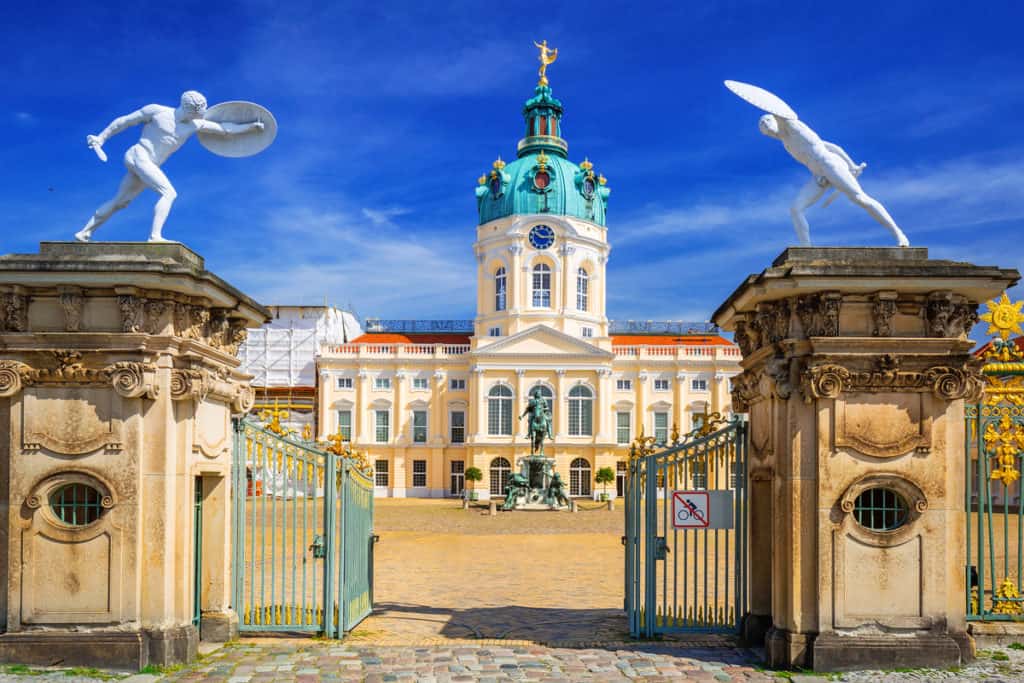
Where to Stay: Boutique Hotel Mittendrin
Where I stayed in Berlin is a repurposed apartment called the Boutique Hotel Mittendrin .
It was glorious . Located in the bustling shopping district of Charlottenburg-Wilmersdorf, it is central to amenities and the historic hub of Berlin’s centre.
Just a three-minute walk to Kurfürstendamm and the KaDeWe shopping mall, it was great to be surrounded by a huge number of restaurants, bars and shops.
Not only this, but the train station for the underground is a five-minute walk away (U Wittenbergplatz). The U2 line was great for the east-west connection – it got us places in less than 20 minutes.
The interior of the hotel was stunning. I was blown away by the mix of rustic and modern chic furniture. Being a historically characteristic old apartment house, the original unique features were still present. The rooms were airy and light, with big windows and a coloured accent wall (ours was a deep maroon!) The room came individually furnished: the seating area was a luxurious add-on, and it was perfect for relaxing before a goodnight’s rest.
Perhaps the best thing about staying in this hotel was the breakfast service and our host Sabine. It was delicious and the quality of the food was fantastic. Each breakfast was a little different from the last. From 7.30 am till 10.30 am (which is perfect for a full day of exploring), the spread was generous, and it catered to all our needs.
The most interesting aspect about this wonderful breakfast experience was that you are placed all together at one table, allowing a chance to bond with other guests from all over the world which fostered a genuine community feel in the three days we stayed there.
Sabine, our host, was wonderful. She took care of us and every little detail. It was a beautiful relaxing stay at this little boutique hotel in West Berlin, a truly unique and intimate experience – perfect for a city break.
The Best Time of Year to Visit
Berlin is best to visit from late spring to early summer, or late summer to early autumn.
From May through to September, the weather is ideal for strolling, sitting in outdoor cafes and taking walking tours of the city.
Specifically, I would recommend May/June as the ideal month to travel to Berlin. The weather is glorious: sunny blue skies and not scorching temperatures just yet, the crowds are limited, and if you search for them, there are lots of festivals occurring in the month of May.
In the summer, Berlin comes alive. The streets are packed with city dwellers enjoying locally sourced craft beer and iced lattes, basking in the heat and chatting with friends. The green, ordered streets are made even greener by the sun’s touch; everything is made vigorous and vibrant.
One must know that summer is the rainiest season in Berlin because of the heat, but that shouldn’t stop you. Enjoy what Berlin has to offer!
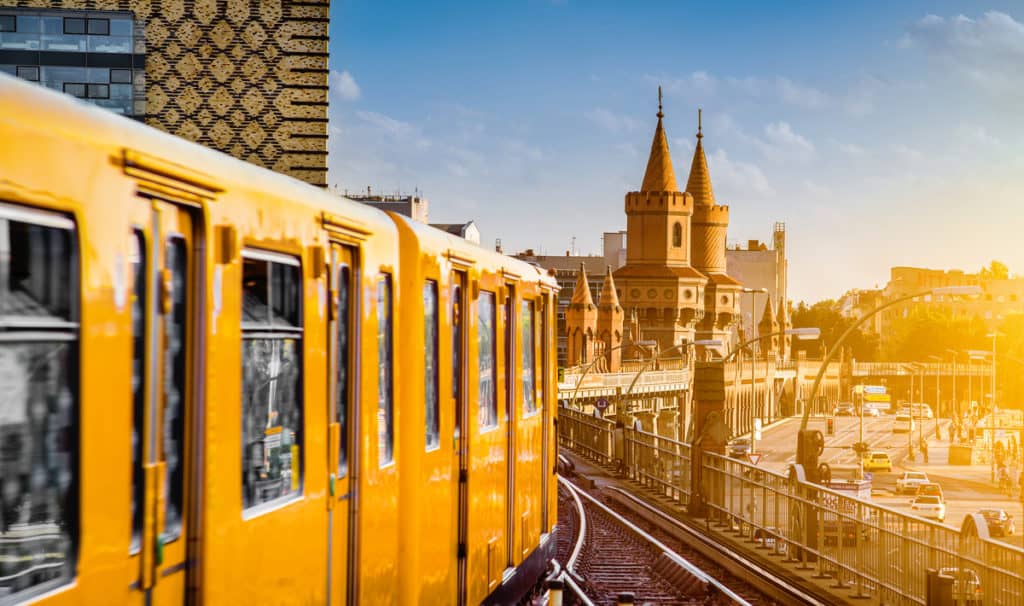
Transport: Getting Around the City
Like every other major city in Western Europe, Berlin is super well connected. I would advise using the U-Bahn underground trains as your main source of transportation. It runs on 10 coloured routes throughout the city with trains coming every five to 10 minutes during the day.
With sustained action from 4 am till 1 am on weekdays, and weekends the U- Bahn and S-Bahn operate 24 hours.
If, on a weekday, you decide to explore Berlin’s nightlife scene, the Metro tram runs on a 24-hour basis, arriving in 30-minute intervals. Alternatively, there are night buses (N1-9) which follow subway routes.
In terms of pricing, in the fare zone AB (which is the urban centre) it costs €3 for a single ticket. This includes a two-hour journey one-way, which means you will have to purchase another ticket for the return journey.
For a 24-hour single ticket, it costs €8.80 and you can take as many trips as desired, and for a 24-hour group ticket, the price is €25.50. This includes up to five people including your dog!
It is a symbol of the city’s organised and bureaucratic way of life. This is juxtaposed with the edgy, gritty aesthetic of the underground train stations: the names of the stations are written boldly on the wall, and yellow is the primary colour underground.
The S-Bahn elevated trains are less frequent and not as well connected as the U-Bahn service. However, it is the preferred choice for travellers venturing to the outskirts of the city.
Berlin also has an efficient bus system but is slower than the rail. Sometimes, it is considered unreliable by German standards. It must be stated that masks are still required on public transport.
Of course, metered taxis can be hailed through the city streets or taxi apps such as Uber operates perfectly well in Berlin. It is said that in Berlin Uber is much cheaper than in the US and the UK!
If you want a more cost-effective, sustainable way of travelling through the city, cycling is a great option. Visitors may choose from seven or eight different companies of bike hires which all operate as ‘dockless’ bikes. This means that riders can leave their bikes at their destination when they are finished, and not have to return the bikes to a docking station. You could also try an E-Scooter if you are feeling adventurous.
You can choose from Lime, Bird, Tier and Bolt. All you have to do is download their app, enter your details and scan the specific bar code on the scooter and you’re off! It is as simple as that. This is a great option for when you don’t have to travel too far from one destination to another and to explore the city dynamically. Walking is always a safe bet, but if you are short of time, use the other options mentioned above.
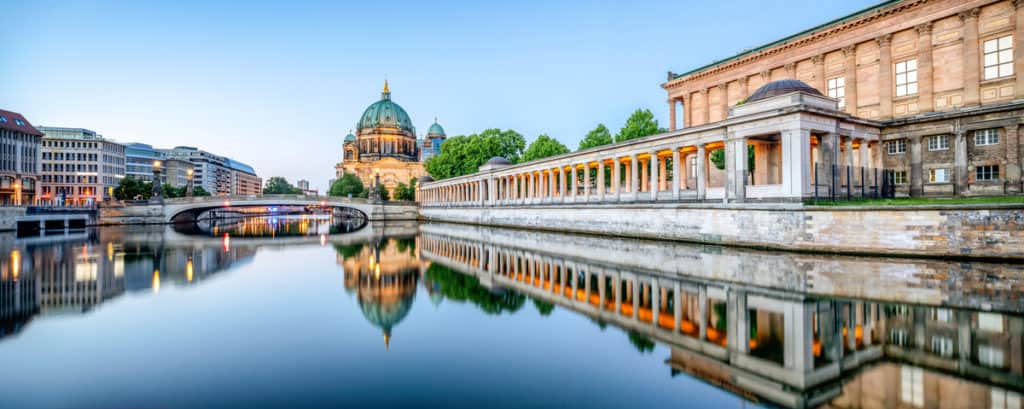
Safety Advice: Beware of Fake Policemen
Compared with other major cities, Berlin is considered safe, however, there are some universal precautions that you still ought to bear in mind. Stick to busy, well-lit streets at night and beware of pickpockets, especially in busy touristic areas.
Avoid falling asleep on the U-Bahn, especially at night, as wallets and phones are often stolen from sleeping passengers. ALWAYS keep valuables close to you.
A scam known to most metropolitan cities is fake policemen. Beware of these characters as they are trying to steal from you in popular tourist attractions. They stop tourists under the pretence of searching for drugs or counterfeit money (they demand to see ID cards).
If you are going out at night clubbing, watch out for drink spiking. Always keep your drink close to you.
One thing to be aware of is protests. The youth of Berlin are inspiring and are actively standing up for worldly issues. Sometimes, however, they can get pretty tense, and people can get injured. Stay away to avoid these problems.
If you decide to rent a bike, lock it up safely and securely when it’s parked. Watch out for cycle lanes when walking, and don’t walk on the wrong side of the pavement!
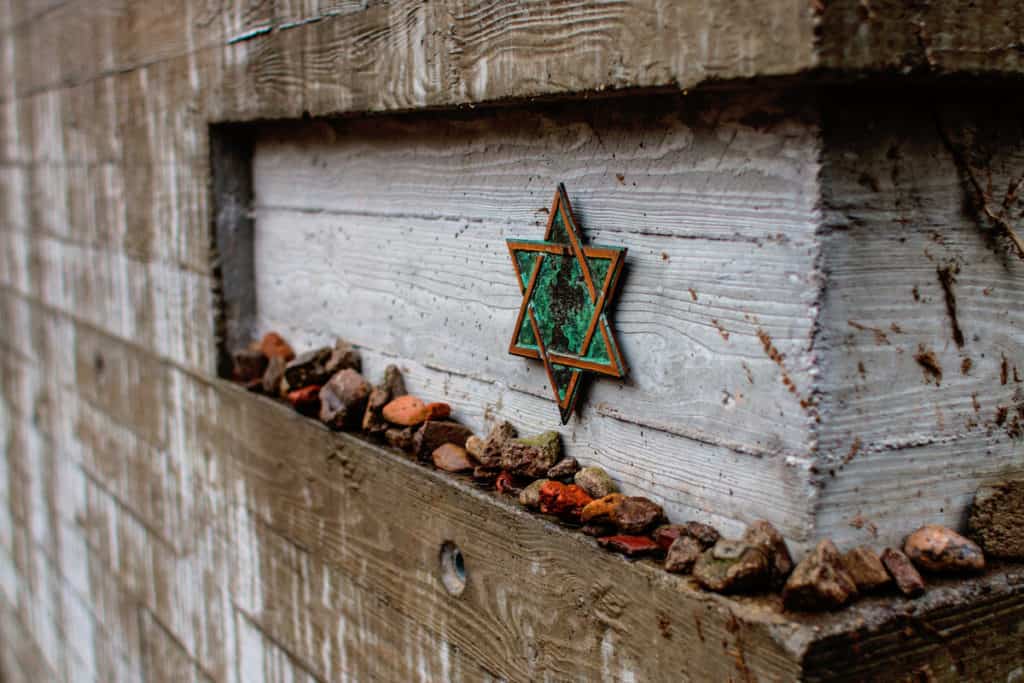
What to Know Before You Go
Politeness and manners are important. Saying good morning (Guten morgen ) and good evening (Guten Abend ) is important, as is knowing when to say it at the right time.
Germans are sensitive about their past, so tread carefully and with the utmost respect. That being said, it is perfectly ok to be curious and ask questions about the past, to get a more well-rounded view of that specific period. Indeed, Young people nowadays in Berlin are open to being vulnerable and having honest conversations about their history and what atrocities have occurred.
It must be mentioned that there is a strict code of conduct when it comes to do with traffic. Traffic rules are extremely important here in Berlin: Do not cross a road when the little man is red.
This also goes for cyclists – if they do, a hefty fine is coming their way. This shows the other side of Berlin, the rule-bound and bureaucratic Berlin.
Lastly, do not forget your European adapter if you are from the US or the UK!
I hope I have explained everything there is to know about Berlin’s main tourist attractions and its quirky, edgy East side. It is truly a marvellous city, a city like no other in Europe.
Enjoy your vibrant stay in Berlin!
Lauren Juliff
Lauren Juliff is a published author and travel expert who founded Never Ending Footsteps in 2011. She has spent over 12 years travelling the world, sharing in-depth advice from more than 100 countries across six continents. Lauren's travel advice has been featured in publications like the BBC, Wall Street Journal, USA Today, and Cosmopolitan, and her work is read by 200,000 readers each month. Her travel memoir can be found in bookstores across the planet.
Related Posts

What’s it Like to Travel in Liechtenstein?

What to Take On the Camino Primitivo: My Detailed Packing List

Exploring the Abandoned Monte Palace Hotel in Sao Miguel
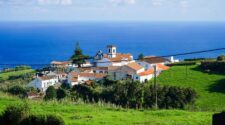
13 Reasons to Plan a Trip to the Azores
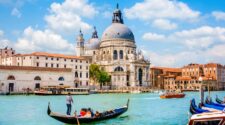
How to Make the Most of a Layover in Venice

How to Spend Three Magnificent Days in Tbilisi, Georgia: A 2023 Itinerary
Leave a reply cancel reply.
Your email address will not be published. Required fields are marked *
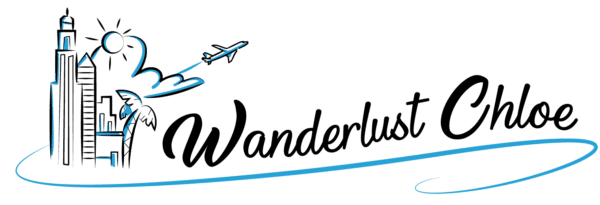
Germany Travel Blogs
These are all of my travel blogs about germany. .
From exploring the Black Forest, to buzzy cities including Berlin and Stuttgart, and the natural beauty of Saxon Switzerland, find out the best places to travel to in my Germany travel blogs and travel guides.
Happy exploring!
19 Best Hidden Gems In Europe
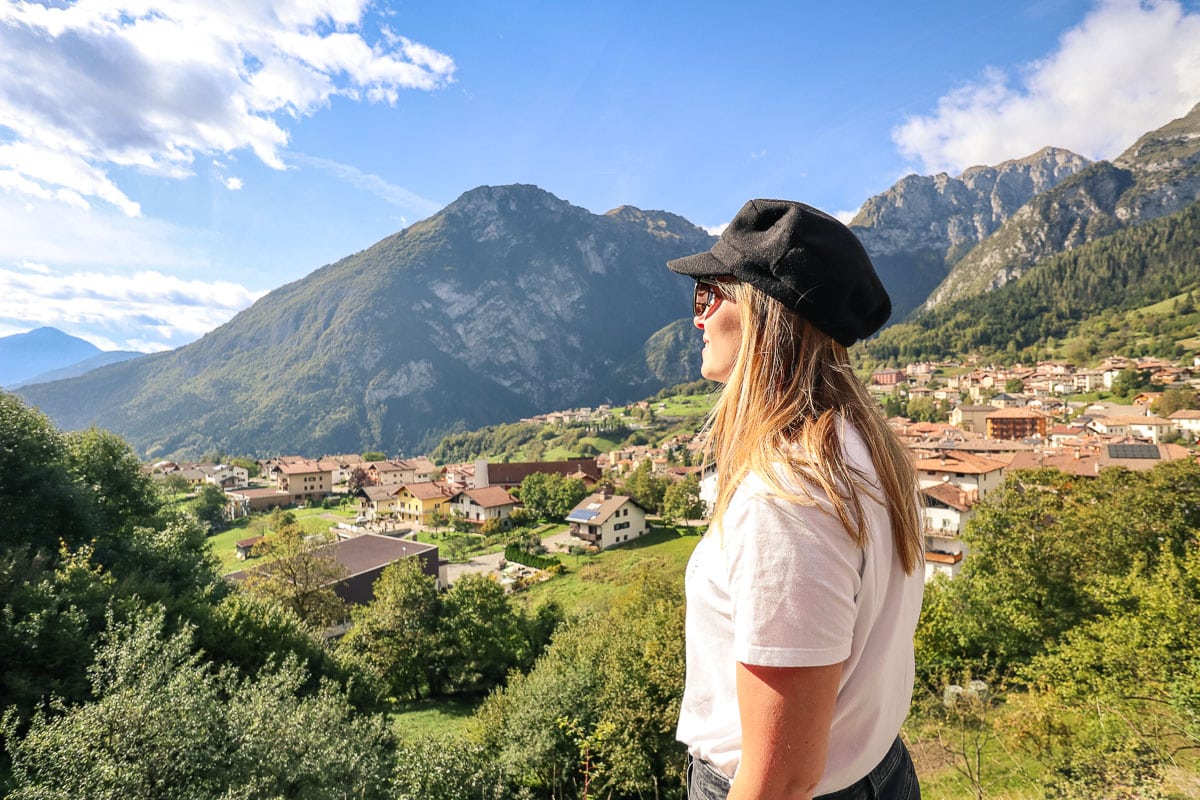
The best hidden gems in Europe include stunning mountain towns in Italy, overlooked islands in Croatia, the ultimate detox spot in Sweden and some surprising places to hit the slopes.
Romantic things to do in nuremberg, germany.
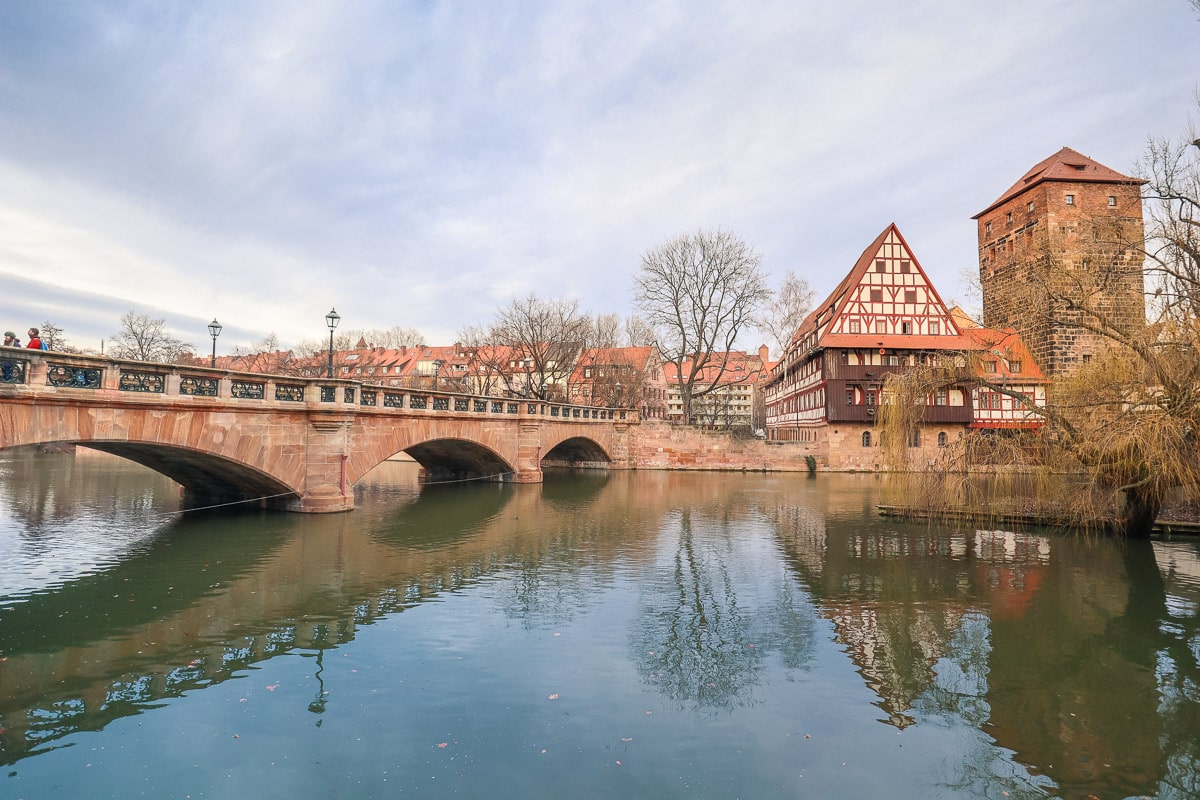
Find out the most romantic things to do in Nuremberg – from delicious dinners and cute date ideas, to cooking classes and horse and carriage rides.
Fun things to do in stuttgart, germany.
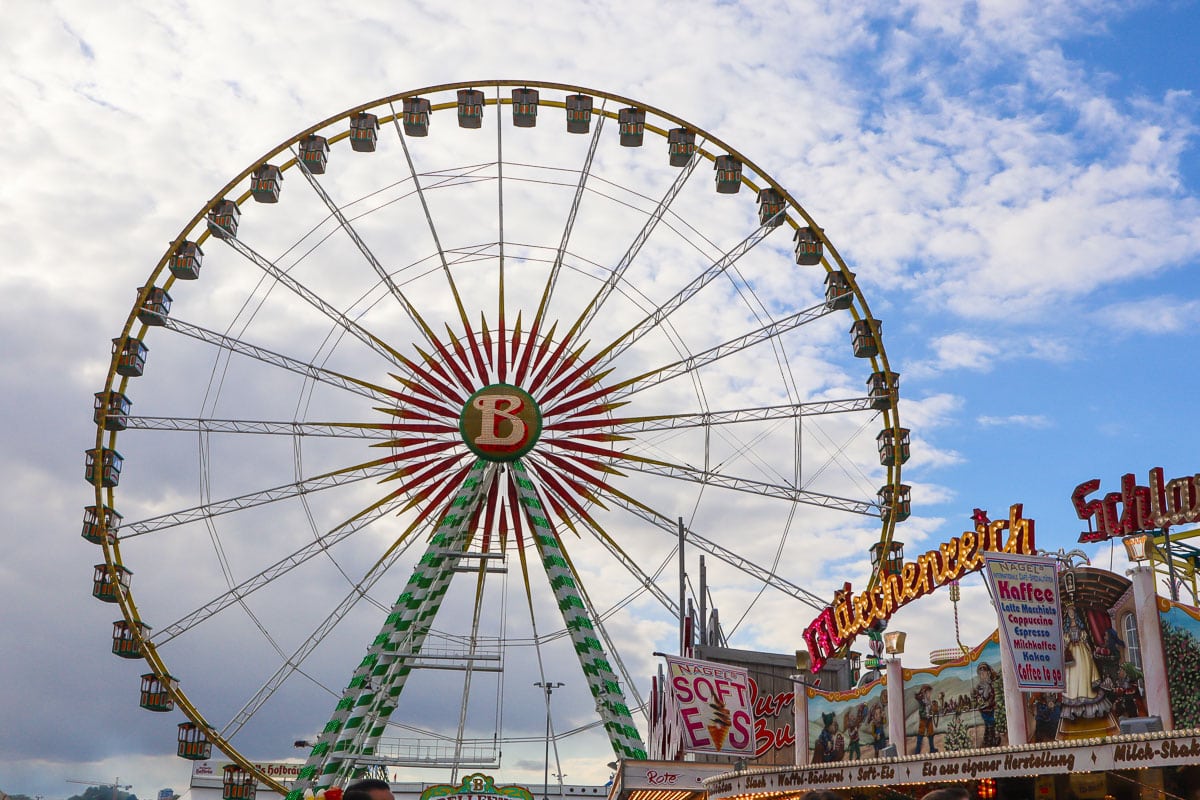
From hiking one of Germany’s wine routes and checking out the city’s spectacular library, to enjoying its food and festivals, find out all the fun things to do in Stuttgart – perfect for a city break.
Top things to do in düsseldorf – a first-timer’s guide.
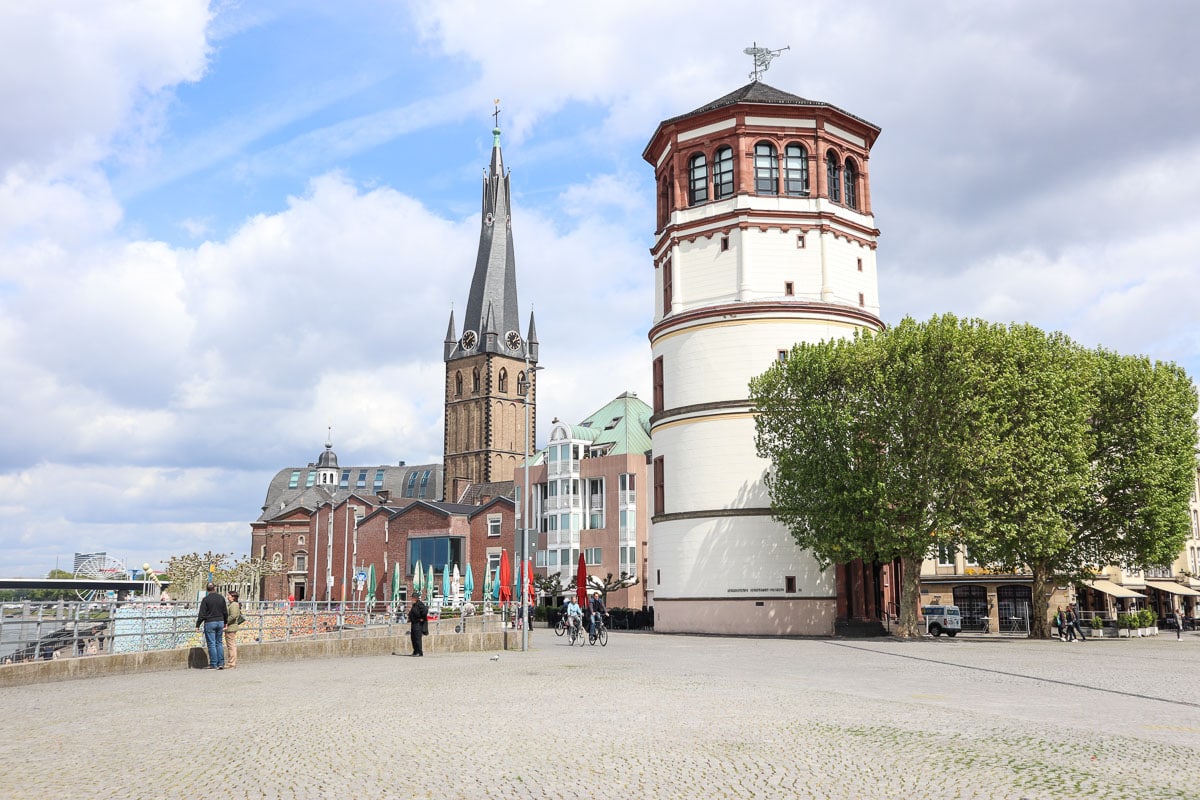
From catching the best views from the TV Tower and exploring the pretty old town, to day trips to Cologne and beyond, here are the best things to do in Düsseldorf.
We’ve just returned from a busy few weeks working with Visit Germany shooting several videos for their #GermanSummerStories campaign. It’s one of the biggest and busiest campaigns we’ve been part of, visiting 7 destinations in 10 days. We were based in the cities of Düsseldorf, Stuttgart and Berlin – two of which were brand new for me.
I was really happy to pad out my German geography, take in some new sights and get stuck into such an exciting project!
Things To Do In Dresden: 24 Hours In The City
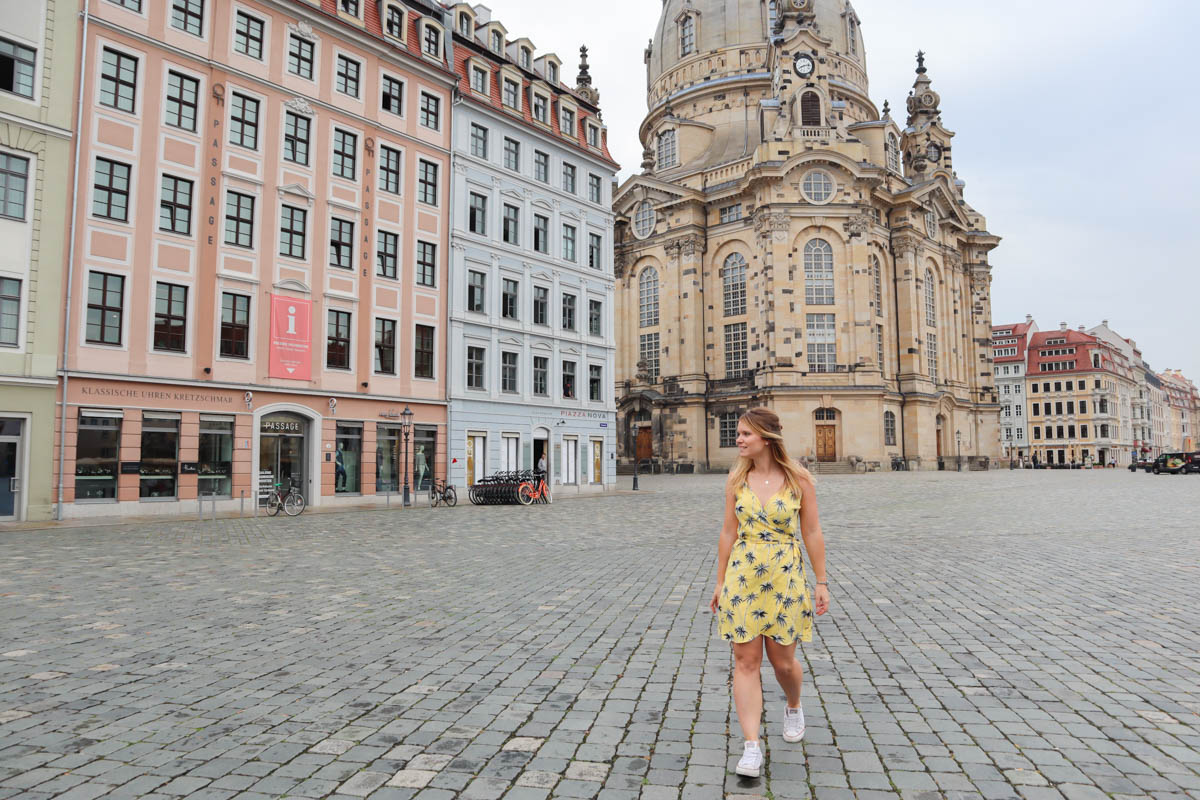
From unique local delicacies, to hipster bars, quirky art and historic architecture, these are the top things to do in Dresden in Germany.
Dresden was our starting point for four days in Saxony, Germany. So far on my travels through Germany I’ve visited Berlin , the Black Forest , Nuremberg, Munich and Hannover. This was a whole new area for me, and I was excited to explore two very different places in the region – the historic city of Dresden and the stunning Saxon Switzerland National Park .
For a flavour of Saxony, check out the video of our time in Dresden and Saxon Switzerland…
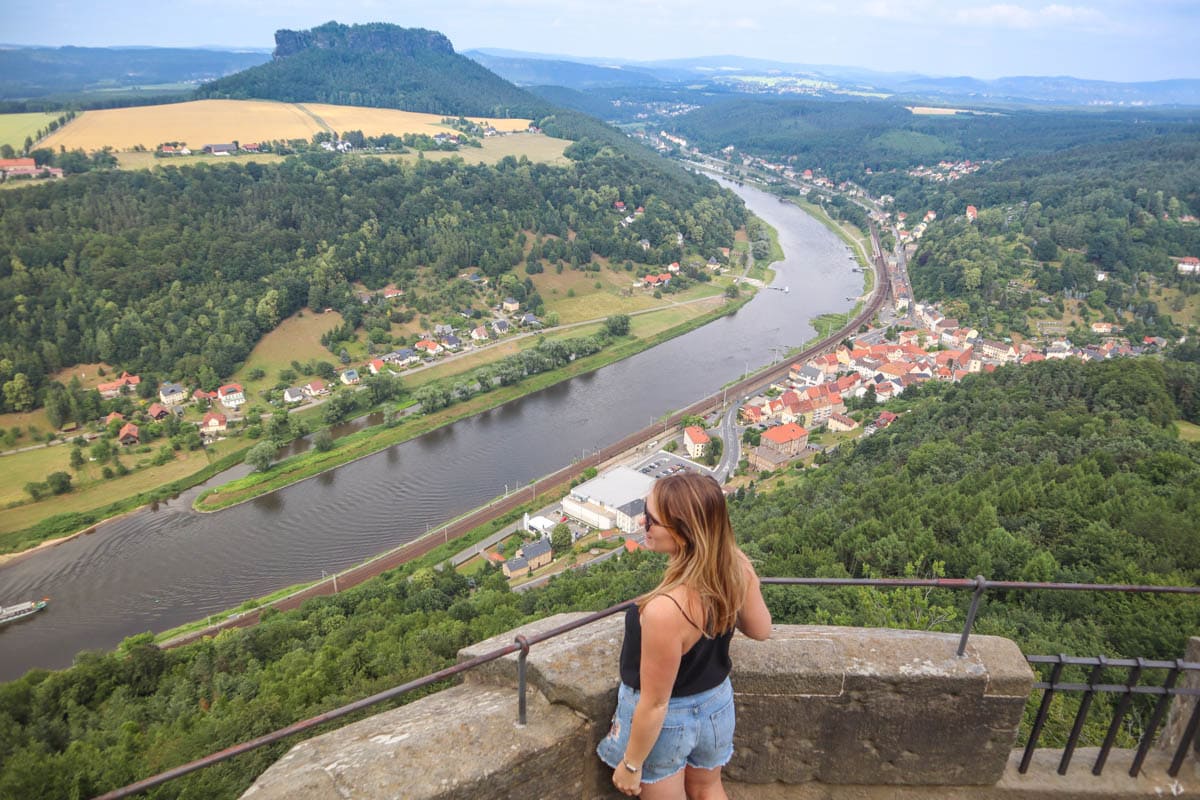
It’s impossible to speak about Dresden without mentioning the atrocities that occurred in the 2 nd World War. Much of the city was demolished in one day of air raids. Sadly one of Germany’s most cultural, fairy-tale cities was reduced to rubble.

Germany is a destination that should be on everyone’s European bucket list (Find all our favorite countries on our Europe Travel Blog here). Germany is great for either couples, friends or for families. You can read all our best posts in this Germany travel blog section.
Planning on traveling long-term to different countries in Europe? Check out this post on the 10 best countries in Europe for long-term travel !
Germany Travel Guides
You can read our guides to help you plan your trip to Germany:
- Munich Travel Blog Post
Find all of our Germany Travel Blog Posts Below
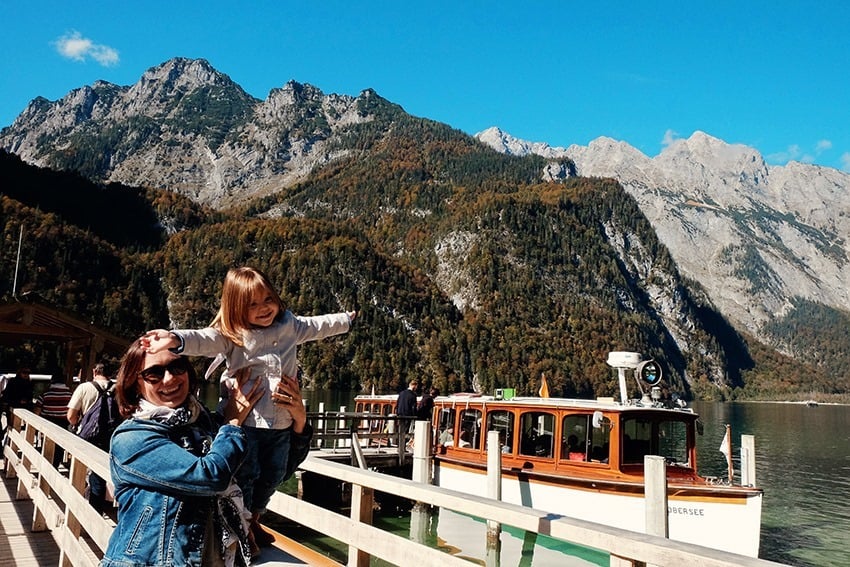
Best Places to Visit in Germany in Winter – Family-Friendly Activities
Germany is the greatest Christmas trip because of the markets, the handcrafted ornaments, and the overall mood, which are all amazing. And there is a significant probability that it will … CONTINUE READING
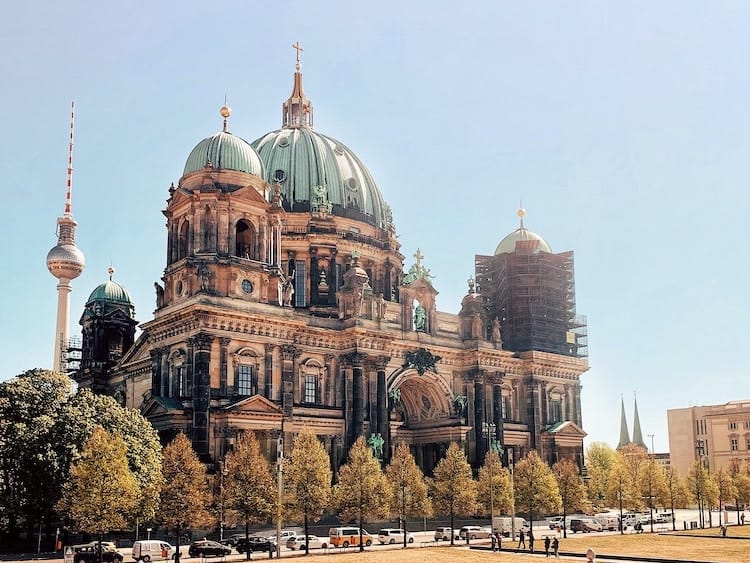
Berlin Hidden Gems: Off The Beaten Path Tourist Attractions
Looking for a unique weekend getaway? Have you considered the city of Berlin? Exploring a city like Berlin often involves delving into its rich history, admiring iconic landmarks, and indulging … CONTINUE READING
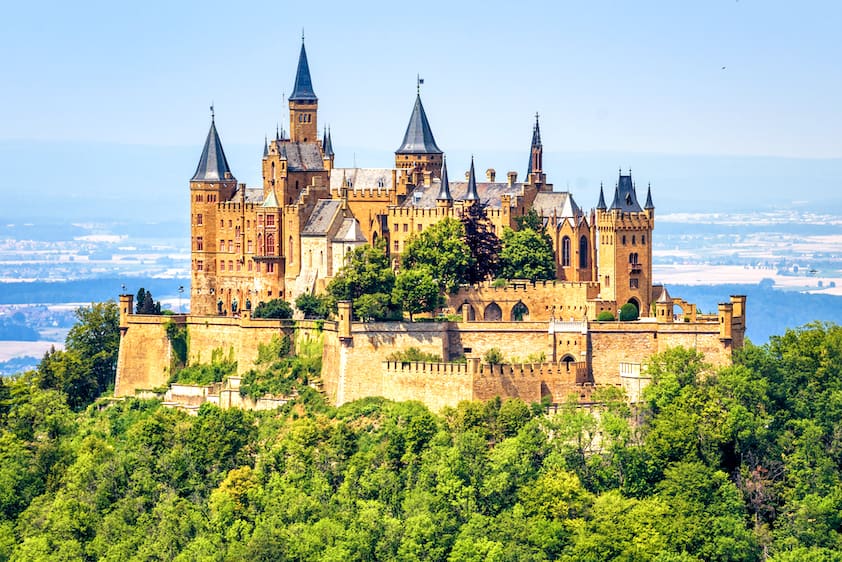
Top 3 Cities To Visit In Germany For First-Timers
Germany is an amazing destination for a vacation. From the charming towns of Bavaria to the majestic castles in the Rhineland, the country offers something for everyone. With so many … CONTINUE READING
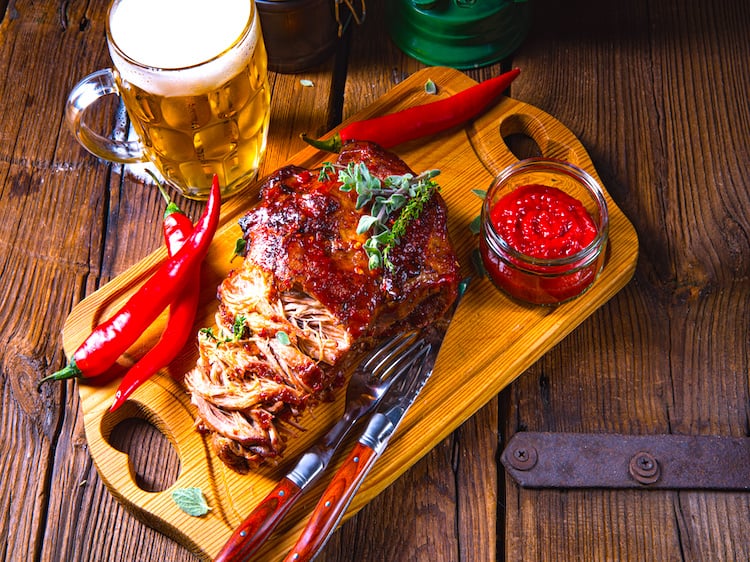
Top Tips to Enjoy Eating Out in Germany When You Don’t Speak the Language
Dining in any foreign country can be tricky, even if the locals are English-friendly. Germany is one of those places that has many English-speaking residents, but you can’t always rely … CONTINUE READING
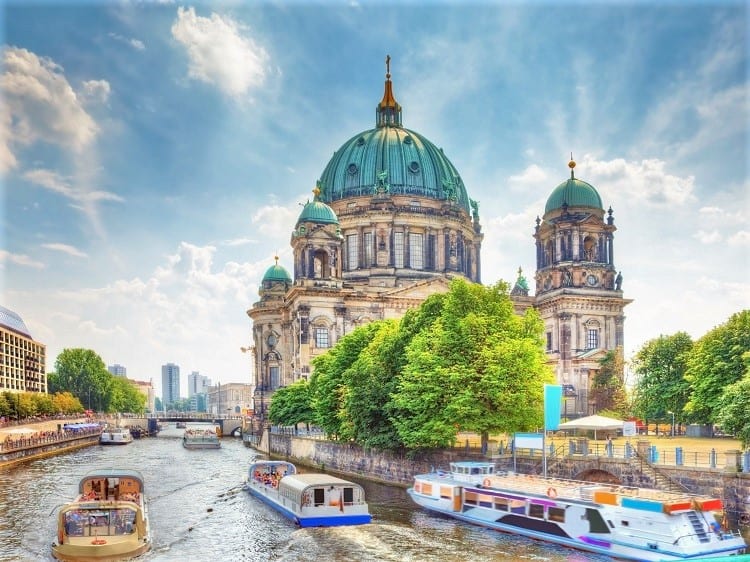
7 Fun And Quirky Things To Do In Berlin With Kids
With a penchant for the quirky and difficult and fascinating history, believe it or not, Berlin really is the place to be and arguably the most fascinating and diverse capital … CONTINUE READING
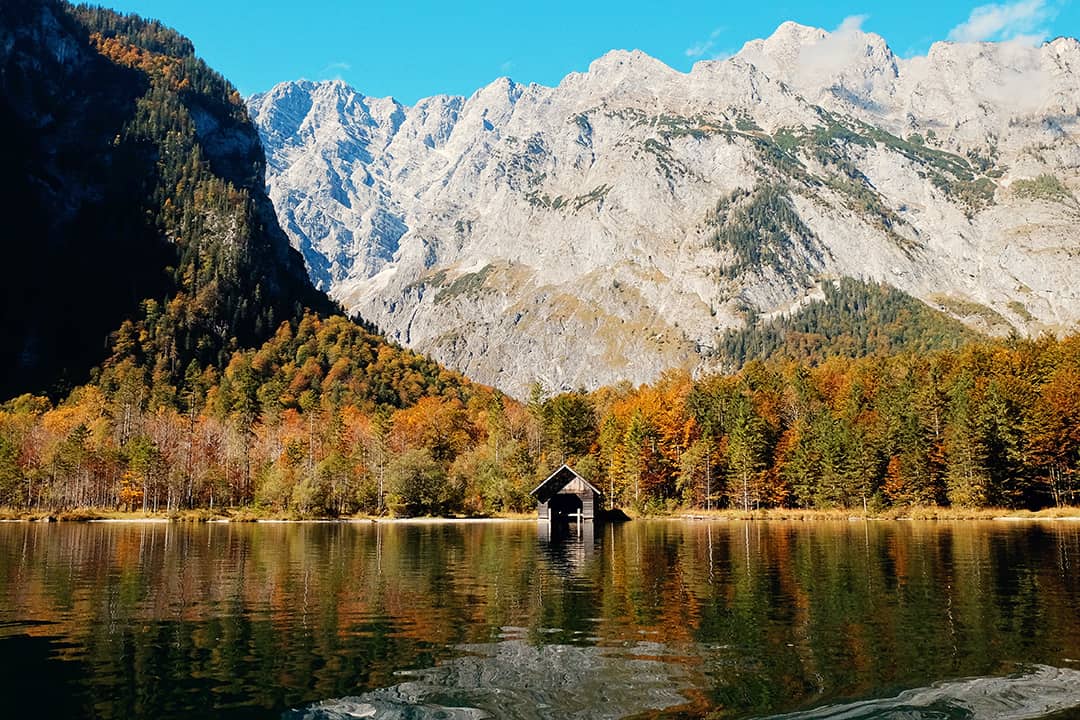
A Day Trip to Germany’s Most Beautiful Lake: Königssee Lake
Nestled in the Alps, Königssee is a prime example of Germany’s natural beauty. Located near the town of Berchtesgaden, it is Germany’s deepest and cleanest lake. If you happen to … CONTINUE READING
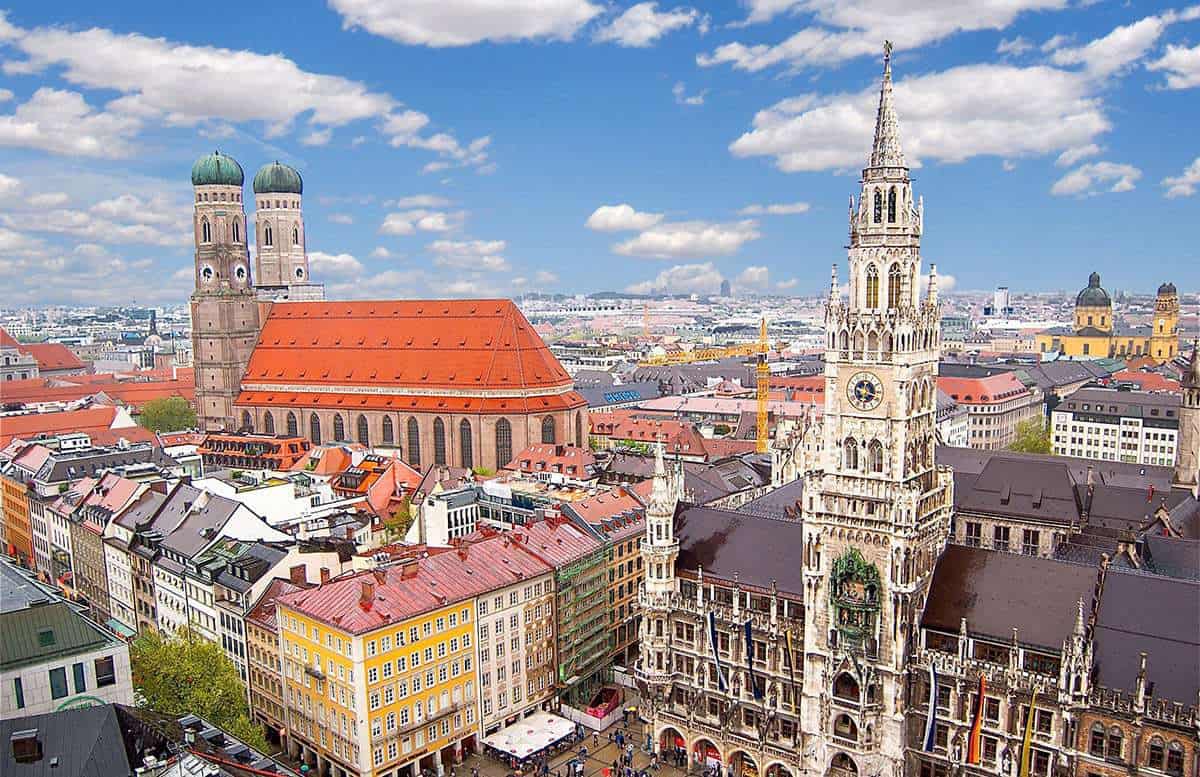
Rent a Bike and Enjoy This Self-Guided Munich Bike Tour
If you are wondering what to do in Munich, Germany? We highly recommend you explore this city by bike. Munich is the home of centuries-old buildings, various landmarks, polished European … CONTINUE READING
2024 - Wanderlust Storytellers. All Rights Reserved.
About Us | Contact Us | Work with Us | Privacy Policy | Disclaimer
* Disclaimer: Wanderluststorytellers.com is a participant in the Amazon Services LLC Associates Program, an affiliate advertising program designed to provide a means for sites to earn advertising fees by advertising and linking to amazon.com and other Amazon sites.

Germany Travel Blog
Germany is a beautiful country located in Central Europe. In fact, Germany is one of the most popular destinations in Europe. It has something for everyone – backpackers, couples, solo travelers, luxury travelers, digital nomads, etc.
Germany offers several experiences – from medieval history to modern cities, from gorgeous nature to epic outdoor activities, from beer festivals to delicious food culture, from breathtaking hikes to relaxing holidays – you should find something that suits your needs and interests.
If you’re planning your first trip to Germany, this guide should answer any questions you may have. We’ll talk about travel facts, the best destinations, travel costs, travel essentials and how to prepare for your trip.
Top Destinations in Germany

Germany Travel Tips & Costs
In this section, you’ll find general information on costs and how to prepare for your trip. Finally, you will find a table that will provide an overview of cost and options depending on your travel budget.
Accommodation
In Germany, you’ll find several options when it comes to accommodation. Whether you’re a budget traveler or not, you will be able to find options. You can find dorms starting at $12 per night.
When it comes to food, you should try the famous bratwurst. If you’re on a budget, make sure to book accommodation with a kitchen, so you can cook your own food. Otherwise, you should be able to find a meal starting at EUR 5. In a local beer hall, a meal and a beer will cost you around 15 EUR.
Some activities such as hiking or wandering around are free. Although, if you’re planning on visiting museums, experiencing Octoberfest, going skiing or attending a street food tour, you will have to pay for it. You can browse activities in Germany here to have an idea of the costs.
Transportation
In general, it’s really easy to get around Germany. You can either take a bus or a train, or rent a car to reach your destinations.
To book your transport between destinations, you can book via RailEurope or Busbud .
Safety In Germany
Overall, traveling around Germany is pretty safe. Of course, you should always lock your valuables especially if you’re staying in a hostel .
What to Pack for Europe
Apart from the travel essentials, here are the things you should absolutely bring along with you in Europe. Click on the images to shop on Amazon.

Universal adapter

Quick-dry towel

Selfie stick

Sleeping Mask
Visa for europe.
Depending on your nationality, you may need to apply for a visa. Otherwise, you should know that Germany is in the Schengen zone, so you can have a free entry up to 90 days every 180 days.
You can verify your visa requirements here .
Preparing Your Trip to Europe
Browse flights on Skyscanner to find deals.
Go To Skyscanner
Book your travel insurance for as little as $42/month.
Go To SafetyWing
Booking.com
Find accommodation anywhere in the world.
Go To Booking.com
Check the visa requirements and apply for a visa if needed.
Go To iVisa
Worldpackers
Volunteer abroad in exchange for free accommodation.
Go To Worldpackers
Book transfers, tours, and activities in advance.
Go To Viator
Germany eSIM Plans
It’s hard to find a good data plan when you’re traveling. You have to research the best deals, go to a store, and hope they have a prepaid SIM card for travelers and tourists.
And if they don’t? You could be without service for the rest of your trip. Not only is that frustrating, but it can also be time-consuming.
eSIMs are the solution to your travel woes. With an eSIM plan, you can stay connected no matter where you go. Plus, there are no contracts or cancellation fees, so you can change your plan whenever you want.
If you’re looking for an eSIM plan while in Germany, then be sure to check out the providers below. They all offer great plans that will keep you connected while you’re there.
$3 OFF with promo code: MELISS2943
190+ countries and regions
Read Review

5% OFF with promo code: ABROKENBACKPACK
130+ countries and regions

100+ countries and regions
Germany Blog Posts
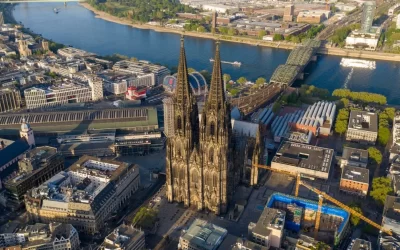
Is Cologne Worth Visiting?
Cologne is a city with a fascinating history situated in the West of Germany. This is a beautiful city filled with incredible landmarks, tasty restaurants, and vibrant culture. However, if you are planning your next euro trip, you might ask, is Cologne worth visiting?...
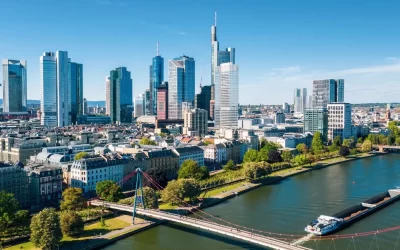
How Many Days In Frankfurt Is Enough?
Planning a trip to Germany soon? You might be wondering how many days in Frankfurt is enough. The answer, of course, depends on what you want to do and see while you're in the city. If you're interested in fully exploring the city, we suggest spending at least two...

Is Frankfurt Worth Visiting?
Frankfurt is a dynamic city in Germany where old-world charm meets modern hustle and bustle. However, if you are planning your next euro trip, you might ask, is Frankfurt worth visiting? Located in the state of Hesse, Frankfurt is the 5th largest city in Germany and...
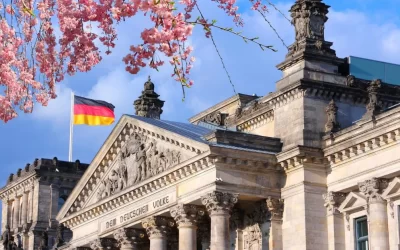
Best Things To Do In Berlin In Spring
As the temperature rises, the flowers blossom, and the trees become green, the capital of Germany comes alive. There is no better time to visit Berlin than springtime, as it's warm enough to enjoy the outdoor offerings, yet the city is still free from the high-season...

What To Do In Berlin In Winter
Visiting Berlin in winter? Many European cities are magical in winter, and Berlin is no exception. It may be freezing at this time of the year, but Germany's capital oozes winter awe, especially around Christmas. From iconic festive activities to endless museums to...
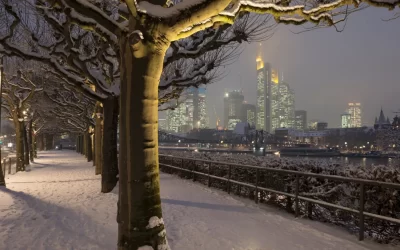
What To Do In Frankfurt In Winter
Look no further than Frankfurt in winter if you are seeking a German city with tons to do during this time of the year. This gorgeous, diverse city has a huge array of museums to explore when it's cold outside, a lively shopping district, and some iconic festive...
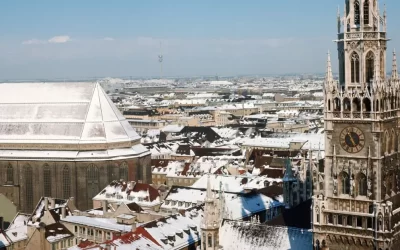
Best Things To Do In Munich In Winter
Like many other European countries, Germany has four distinct seasons, each of which offers something unique. Winter in Munich is freezing, but the city is arguably at its most beautiful due to the arrival of the snow season and the holidays. During the winter months...
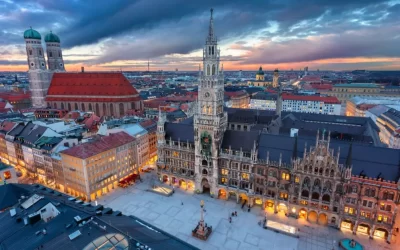
Germany SIM Cards: Everything You Need To Know
Visiting Germany soon? Make sure to know what to expect when it comes to purchasing a Germany SIM card. In this guide, we’ll explain where to buy a SIM card in Germany in person and online. We'll also discuss prepaid SIM cards and eSIMs if your mobile supports them....
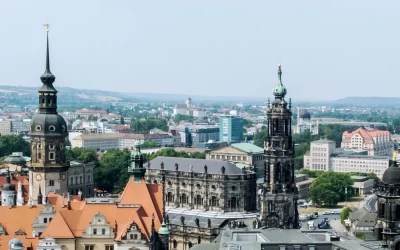
Perfect 2 Days In Dresden Itinerary
If you're wondering how to spend 2 days in Dresden keep reading for the perfect itinerary! Located on either side of the Elbe River, the city of Dresden is both unique and fascinating. Once the seat of Saxon rulers, it boasts some spectacular architecture and museums...
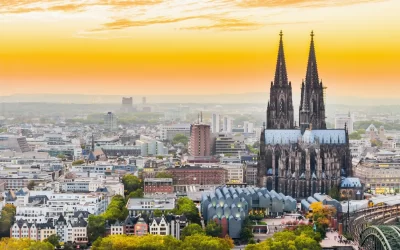
Perfect 2 Days In Cologne Itinerary
Planning 2 days in Cologne? Cologne is the perfect destination for a city break, with scenic parks, beautiful architecture, and one of the most famous cathedrals in the world. It is also very compact, so you can get around easily on foot without any need to use public...

Best Things To Do In Fussen, Germany
Looking for things to do in Fussen, Germany? Look no further! In this guide, you'll find the best things to do in Fussen, whether you're looking for culture, history, or just want to enjoy the great outdoors. We'll also give you travel tips so that you can organize a...
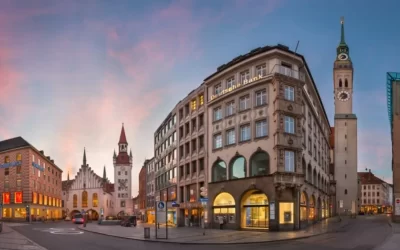
Perfect 2 Days In Munich Itinerary
Wondering if it's possible to visit Munich in 2 days? It is! If you're looking to pack in as much as possible during a 2-day visit to Munich, you'll want to make sure you hit all the city's main attractions. This itinerary will take you on a whirlwind tour of the best...
- Resource Center
- view Cart ( )

10 Best Germany Travel Guides from Experienced Travel Bloggers
Recent Posts
- » Black Forest Cake Recipe
- » 7 Decor Items You Can Find At Grandma's House
- » The 12 Best Oktoberfest Beer Events in the USA | Bavarian Clockworks
- » A Collection of the Best German Gifts
- » 8 Trendy Modern Cuckoo Clocks for Millennial Shoppers
Posted by Bavarian Clockworks on 2nd Jun 2016
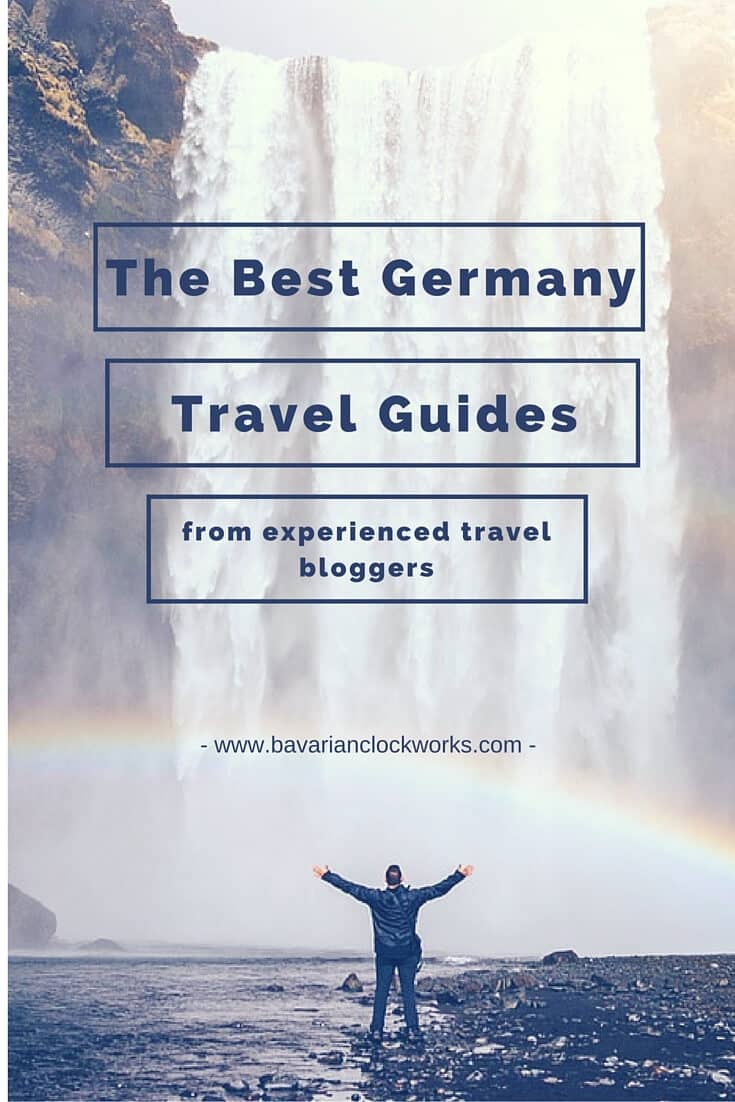
Germany has grown to one of the most popular travel destinations in the world, and in todays information era, it’s no wonder that many of these travellers are doing their research before they head to the airport. Travel guides are one of the most valuable pieces of content someone can find when starting their research into their destination. We’ve read through countless travel guides for Germany, and researched into the type of traveler the authors were, to bring you the 10 Top Germany Travel Guides from Experiences Travel bloggers.
These world travellers each have a unique story behind why they started a travel blog, and the reasons they ended up landing in Germany. Whether they were backpacking through Europe, spent their honeymoon in the beautiful Black Forest , or moved abroad to the city of Berlin, each of them share a unique but informative perspective on travelling Germany.
That Backpacker | Audrey Bergner
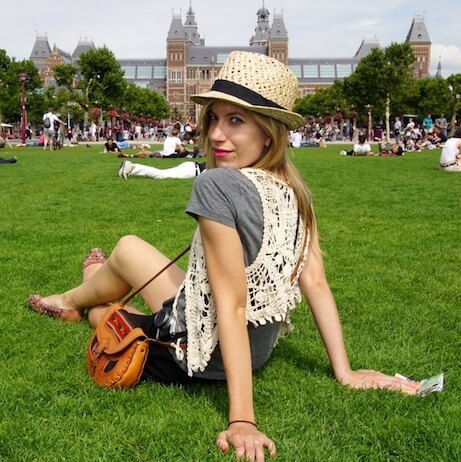
Travelling in Germany
Audrey is a full time travel blogger so spends most of her time on the road. She has done extensive travel throughout Germany, including Berlin, Hamburg, Bebenhausen, Tuebingen, and more. Starting her blog in 2010, she never expected this ti turn into her full time job. But through sharing captivating photos and unique travel experiences covering topics from cuisine and local drinks, to museums and traditions, That Backpacker has grown in popularity, and offers some incredibly valuable guides on traveling Germany.
Follow That Backpacker
Happiness and Things | Silke Elzner

Germany Travel
Silke is based in Sydney, Australia, and has been running her travel blog "Happiness and Things" since early 2013. Silke is originally from Germany, so offers an incredibly in depth perspective of German travel, with a "local" type of insights. The main goal for her blog is to encourage and inspire people to go out and explore themselves, and to help them plan their trips in a way that they will get the most out of the experience. Though she shares travel advice and experiences from all over the world, this write-up captures a very unique essence of what Germany has to offer.
Follow Happiness and Things
Travels of Adam | Adam Groffman
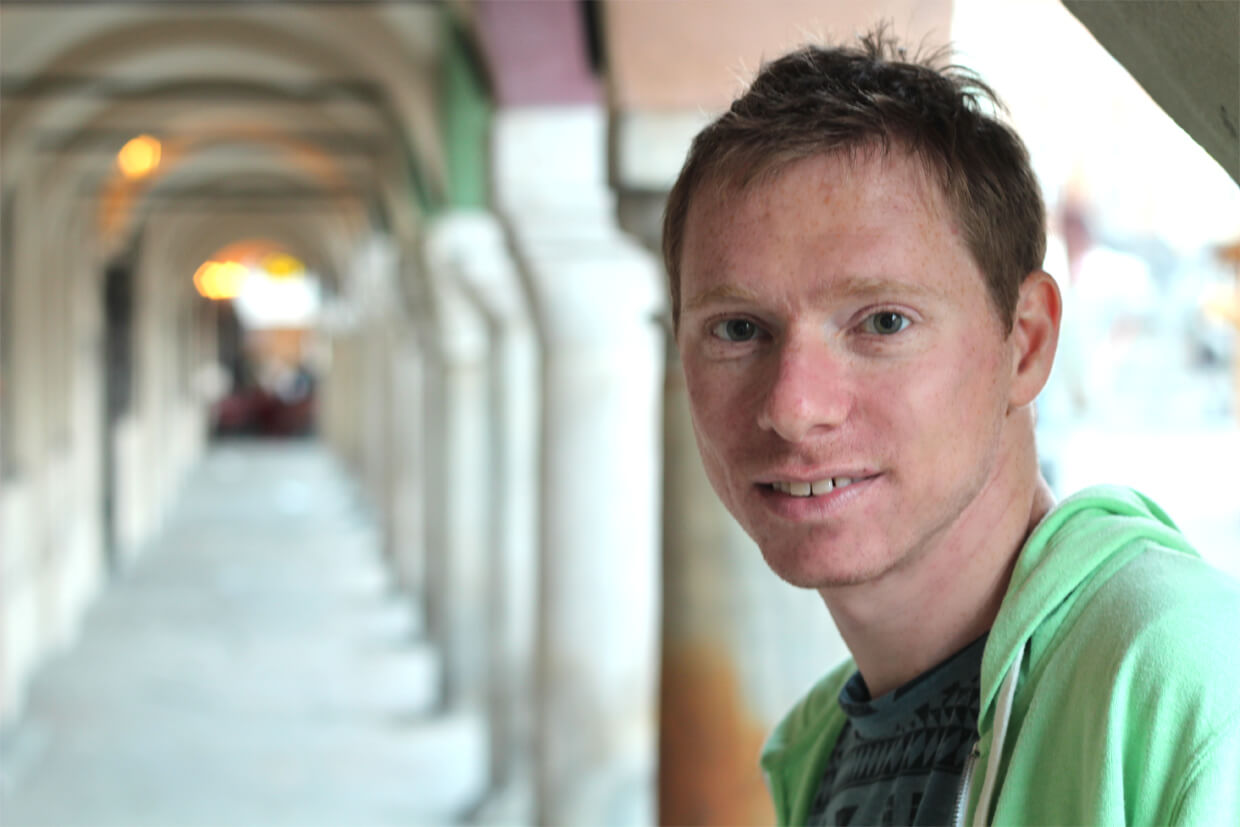
Moving to Germany
Based in Berlin, Germany, though as a travel writer, Adam is regularly traveling. In addition to writing and managing his popular travel blog, travelsofadam.com, Adam also works with Eating Europe Tours on their online marketing. Travels of Adam started in 2009 in preparation for a gap year he was planning, and wanted to keep himself productive while traveling by sharing about his experiences.
Follow Travels of Adam
FlyEatTravel | Miro and Mirko Henzel
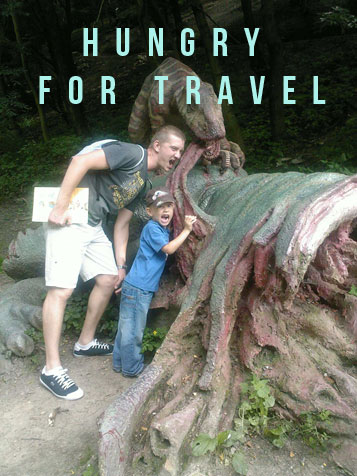
The Ultimate Guide to Munich
Miro and Marko are a father and son team that has travelled to 3 continents, dozens of countries and hundreds of cities, these professionals not only know travel but have an obviously unique dynamic to share. These two share a lot of family friendly travel experiences, from visiting beaches to theme parks to historical museums. This guide to Munich, truly is "ultimate" and for anyone planning to touch down in this city, this is a must have resource!
Follow FlyEatTravel
Women Travel the World | Rosemary Neaves
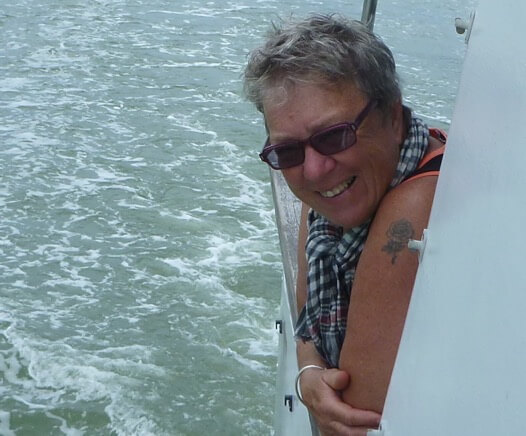
Travelling Alone in Germany
Rosemary is a writer/blogger that focuses on topics related to women and travel. Based out of New Zealand, she shares both stories from her travels and other women explorers as well. The "Women Travel Blog" was a way for her to not only share stories of women travellers, but to compile information about women owned accommodations and tour businesses emerging around the world, particularly ones that cater to female travellers.
Follow Women Travel the World
Nina Travels | Nina Potuje
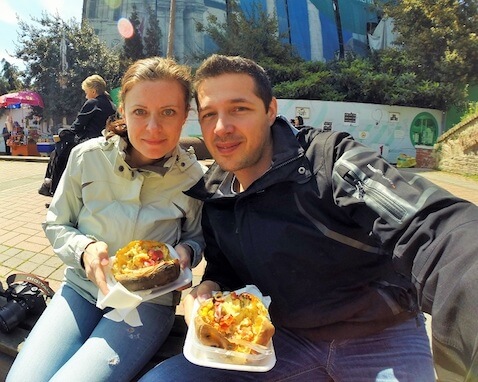
Nina and Simon are based in Slovenia, near the capital of Ljubljana. They started our blog about 4 years ago because their family and friends always wanted to hear about their travels, every time they returned home. A blog allowed them to not answer the same questions or tell the same stories over and over, plus it helped people follow their travels live and keep more up to date. As the blog became more and more popular, they starting including useful travel tips and information for everyone wanting to go travel, drawing from their experiences on the road.
Follow Nina Travels
Grown-Up Travel Guide | Andy Higgs
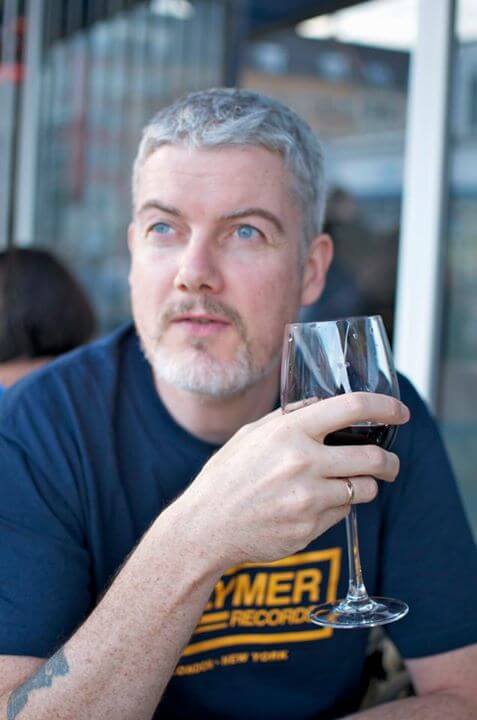
Germany Travel Guide
Andy is an Englishman that has been living in Trondheim, Norway for the past 17 years. The Grown Up Travel Guide was started in 2012 because he was always being asked for travel advise about his more "grown up" style of travel. What makes Andy's content so unique is he caters to those travellers who don't want to be hauling a massive backpack from hostel to hostel. Andy travel with class, and shares tips and advice for a higher quality of travel.
Follow Grown-Up Travel Guide
Kevin & Amanda - Food, Travel, Photography

Guide to Munich, Germany
Kevin and Amanda are a bright and energetic couple that share everything they can from their travels on their blog. Covering all sorts of topics from food to photography, they have great content that takes a very bright outlook on travel and the countries they've visited. We found this guide to Munich, Germany, to be very well rounded for all of the foodies out their, as they talk about and share 'delicious' photos of German cuisine favourites, mixed in with some popular must see places to visit.
Follow Kevin and Amanda
Oh God, My Wife is German | Obi G. Macaroni
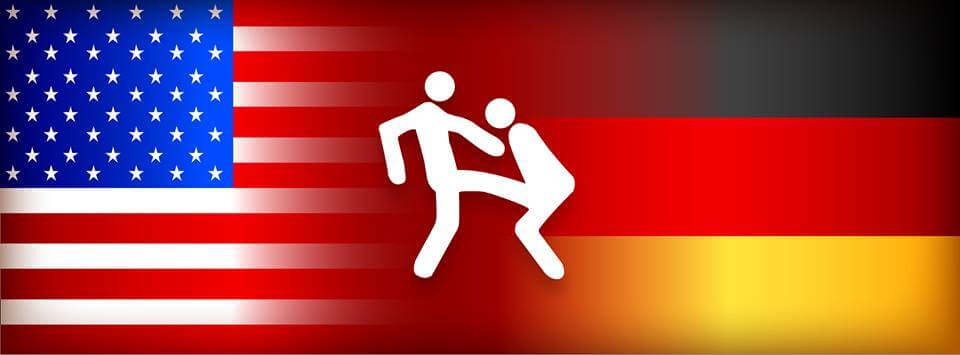
Everything Germany
Obi G. Macaroni (or "OGM" as he prefers) started Oh God, My Wife is German in 2011 after he began compiling lists and notes of all the hilarious things his German wife did or said. When they shared some of these quotes or idioms with their friends, they realized they were not so much inside jokes, but great pieces of humour with widespread appeal. This blog is filled with tons of great insider information about German people and culture. While not necessarily a "travel guide", anyone preparing for a trip to Germany can learn a lot about the people and social memes from OGM's writing!
Follow Oh God, My Wife is German
Angloitalian | Dale Davies & Franca Calabretta
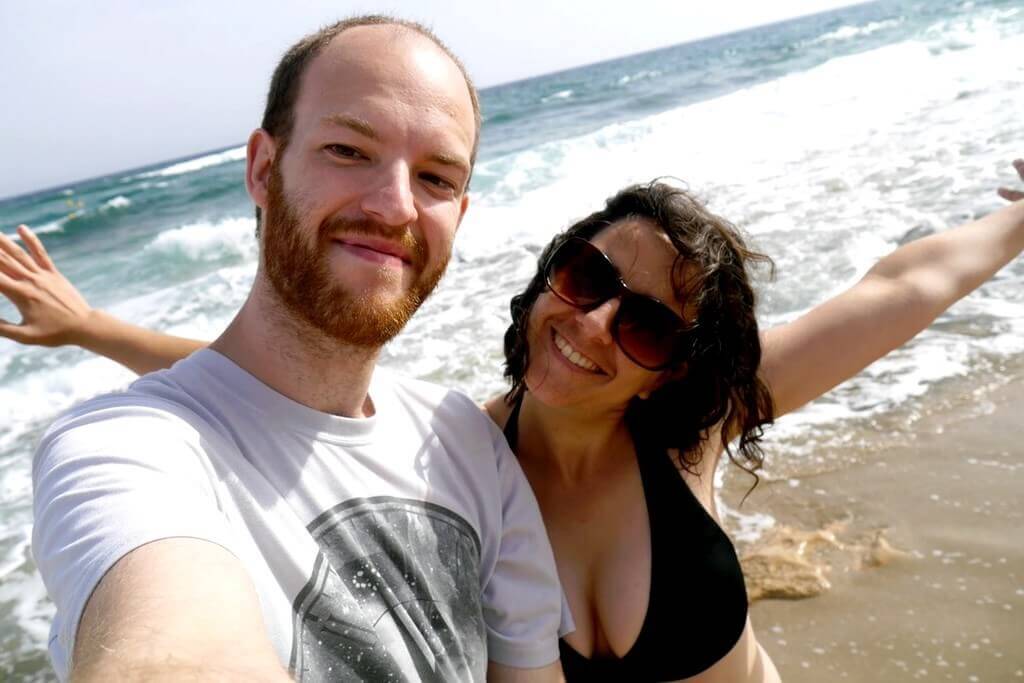
Berlin on a Budget
Dale Davies is a forever smiling Brit who chose to leave his retail hell behind him and make full-time travel a reality, and Franca Calabretta moved away from her home town of Alberobello in Puglia, Italy more than ten years ago, so often feels more at home while one the road. This duo is truly unique for a number of reasons; 1. They are budget travellers (though never let it make them crazy, if something costs 'this' much, they pay 'that' much), 2. They are slow travellers, and 3. They are vegan travellers. This rare combination of travel lead to a special kind of guide focused on Berlin, Germany, and we thought it would resonate with anyone who values these styles of travel.
Follow Angloitalian
Save These Travel Guides for Your Next Trip to Germany
This roundup of excellent Germany travel guides was carefully put together to cover a diverse style of travel experts. If you find yourself resonating with one or two of these travel pro's, then be sure to bookmark their site or follow them on social media, because like all travel bloggers they are always exploring new destinations and releasing travel guides for countries around the globe.
If you or someone you know is planning a trip to Germany, these travel tips can help you navigate your journey, hit the must-see locations, and create an absolutely memorable trip. Bon Voyage!
For all of us who can't make the trip to Germany just yet, check our list of the 12 Best Oktoberfest Events in the USA.
- #Germany travel
- #Germany travel guides

13 Coolest Hotels in Munich, Germany
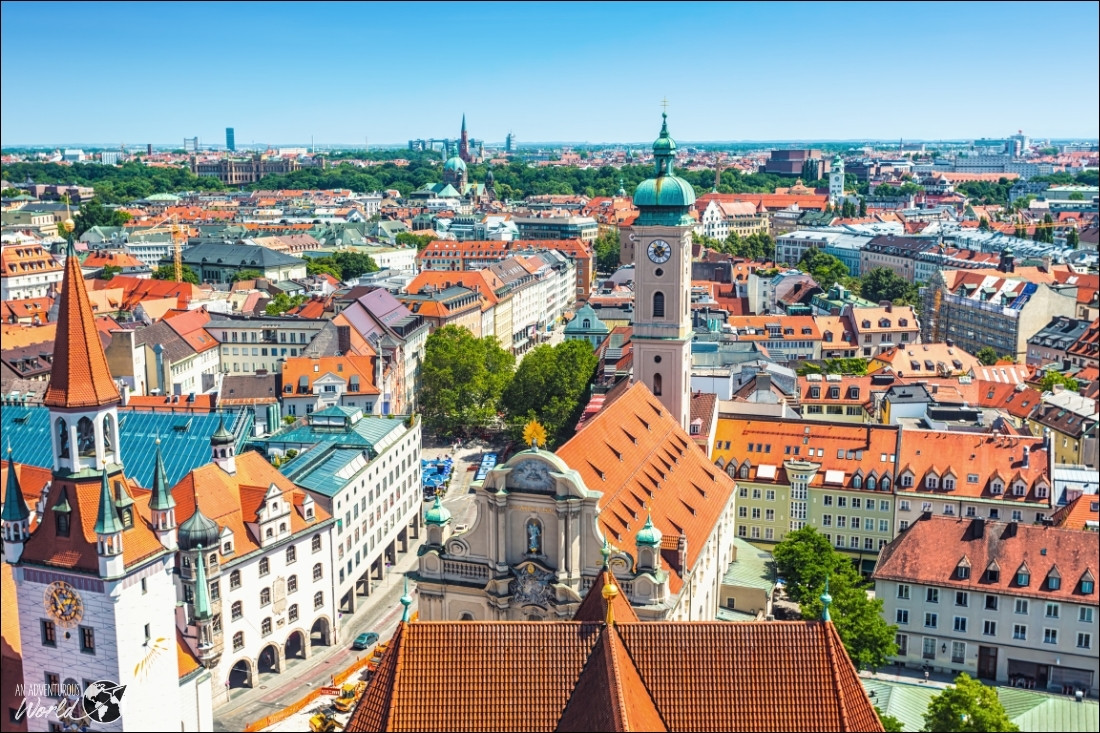
Looking for the coolest hotels in Munich, Germany? Then check out these amazing places for your your next Bavarian adventure!
13 best things to do in berlin in spring.
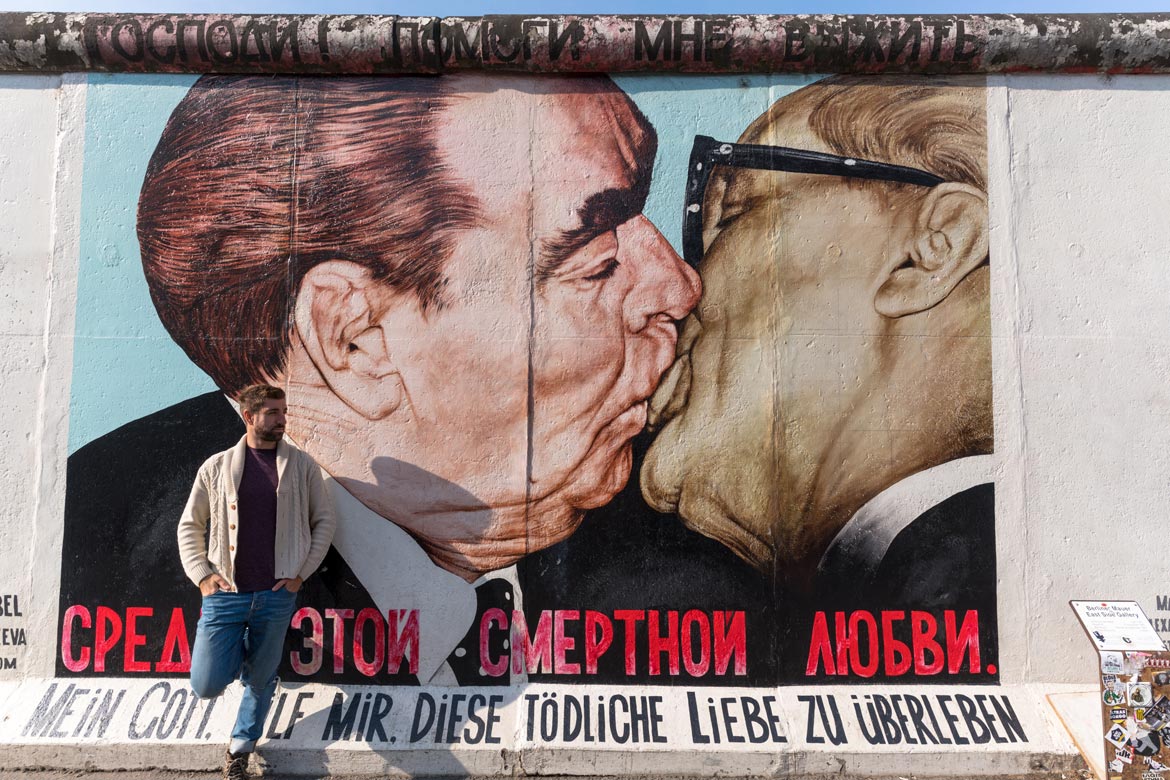
From finding cherry blossoms throughout the city to a day trip to the land of 3,000 lakes, these are the best things to do in Berlin in spring!
What to do in nuremberg, germany.
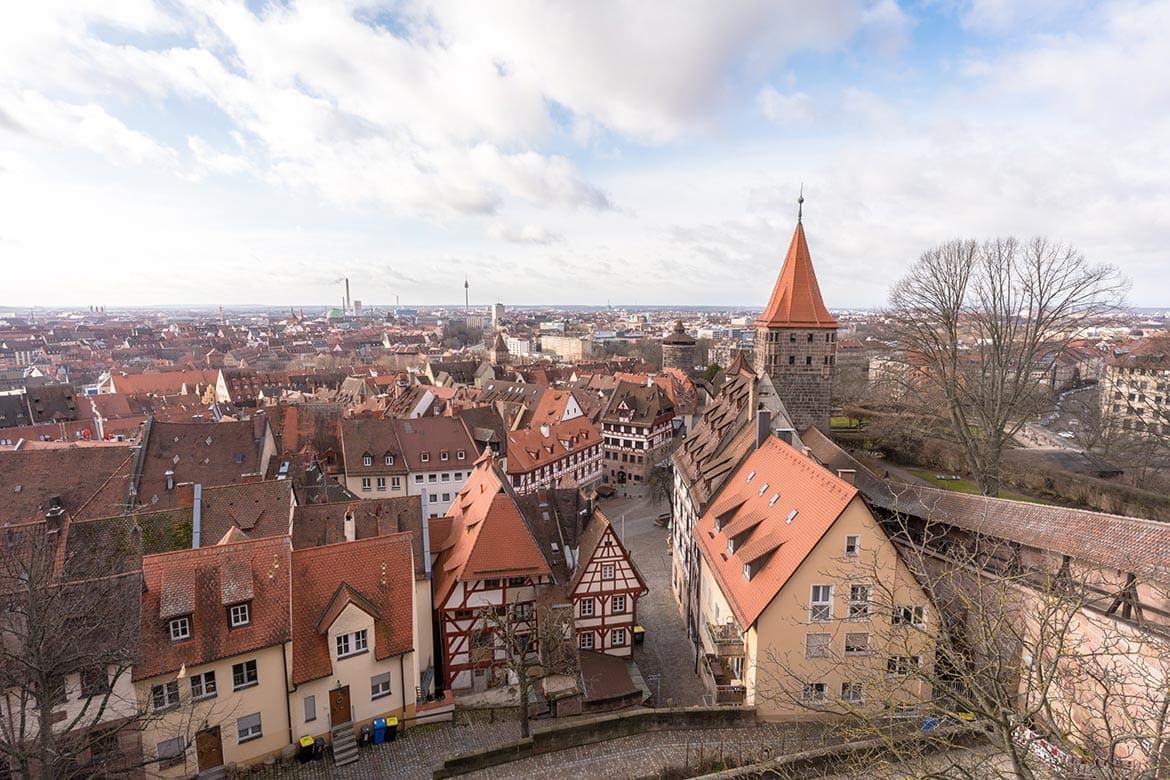
From walking around the Imperial Castle to making infamous Nuremberg gingerbread, here’s what to do in Nuremberg for an amazing weekend away!
10 coolest hotels in berlin, germany.
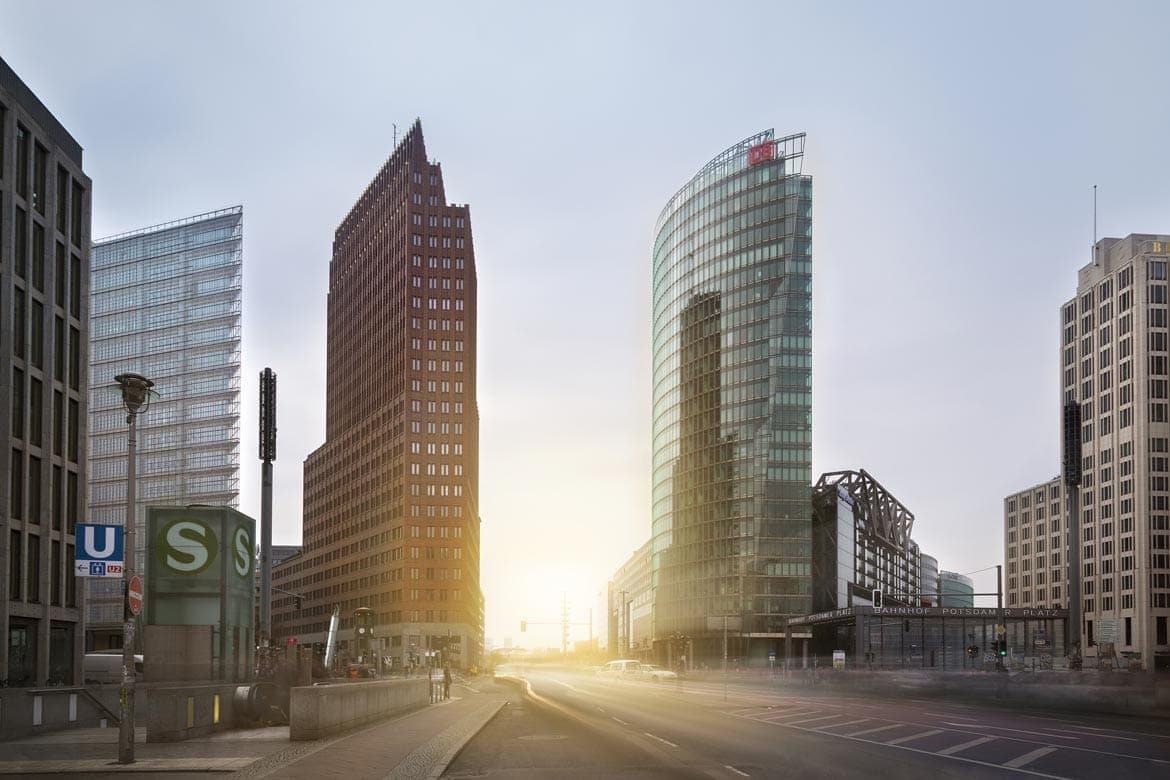
Are you looking for the coolest hotels in Berlin? From the Sir Savigny to Hotel Bikini, these are the best places to stay in Berlin!
12 awesome day trips from berlin, germany.
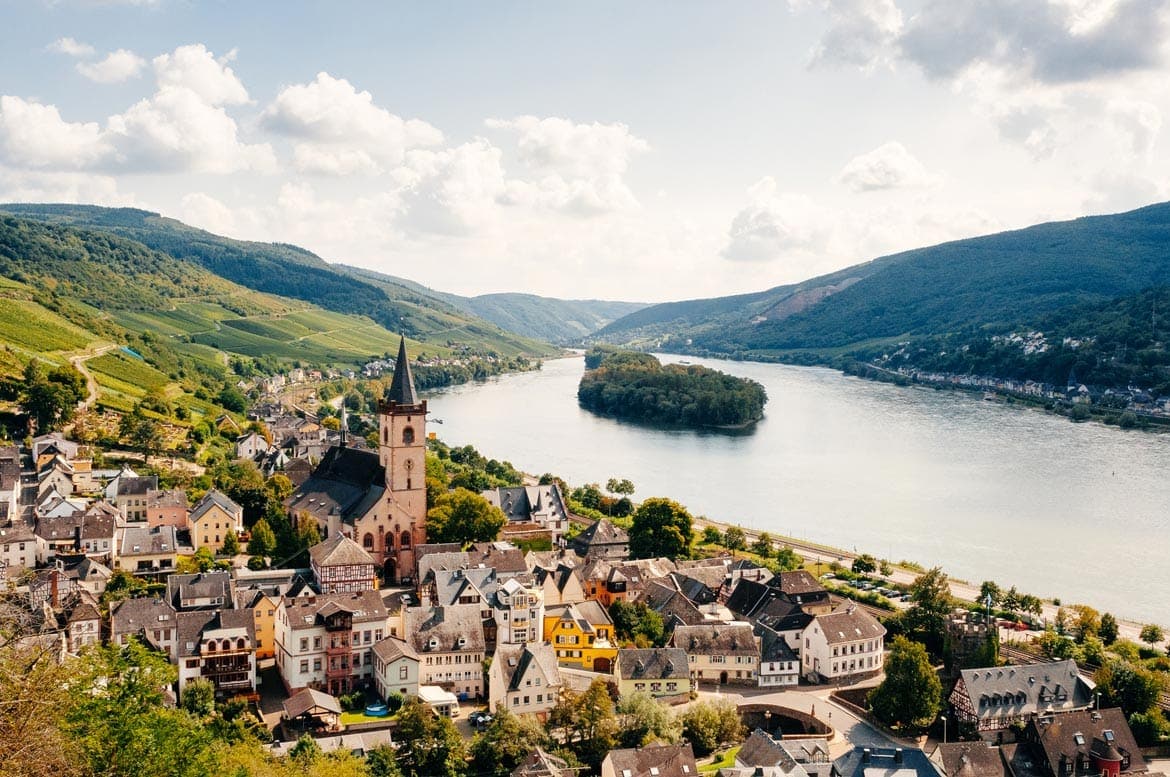
From walking over Rakotzbrücke Bridge to exploring Potsdam, these are some of the best day trips from Berlin for your next trip to Germany!
Berlin itinerary: 2 days in berlin, germany.
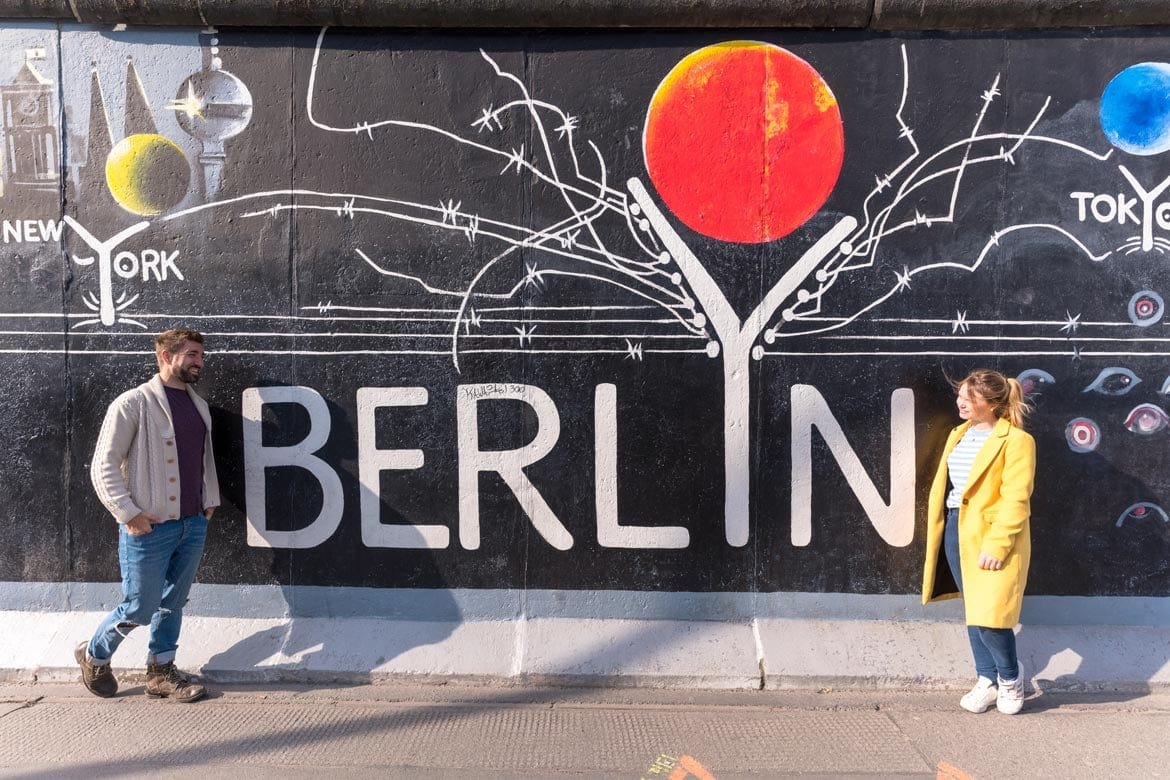
Have you only got 2 days in Berlin? Then check out my Berlin 2 day itinerary packed full of the best things to see & do in the city!
What to do in stuttgart, germany.
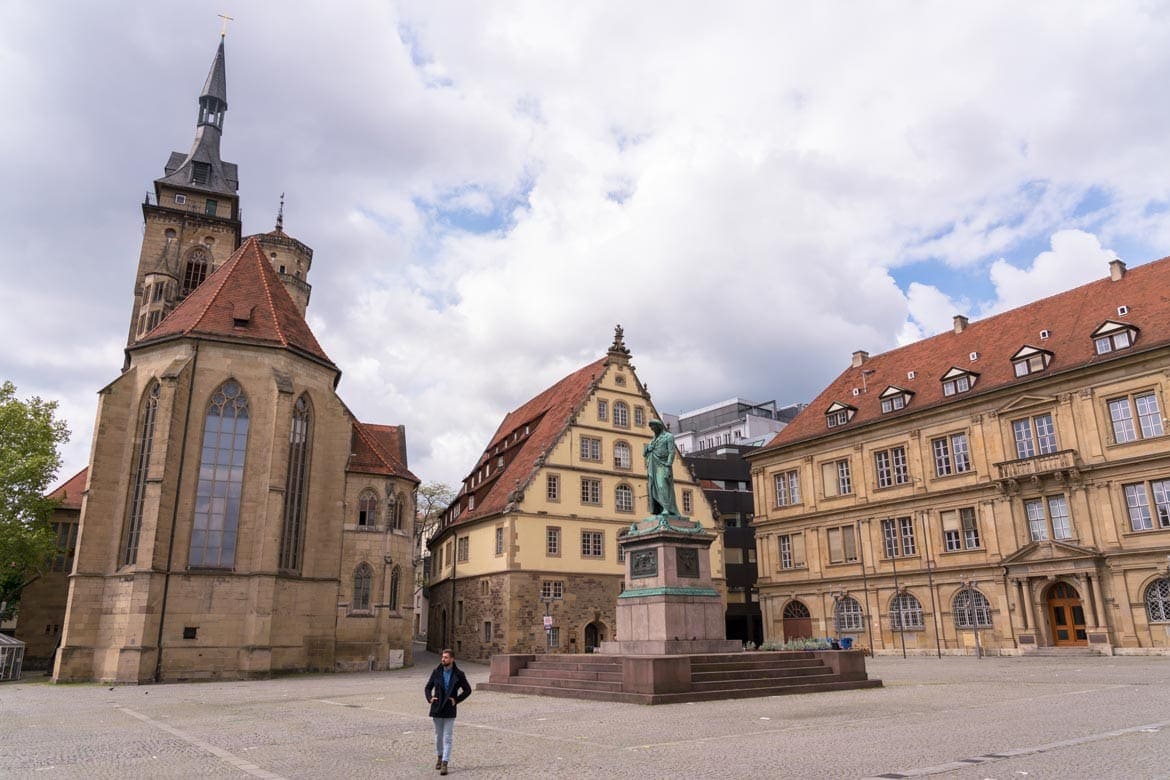
From the epic Mercedes-Benz Museum to Germany’s second largest beer festival, this is my definitive guide to sightseeing in Stuttgart!
6 incredible day trips from dusseldorf, germany.
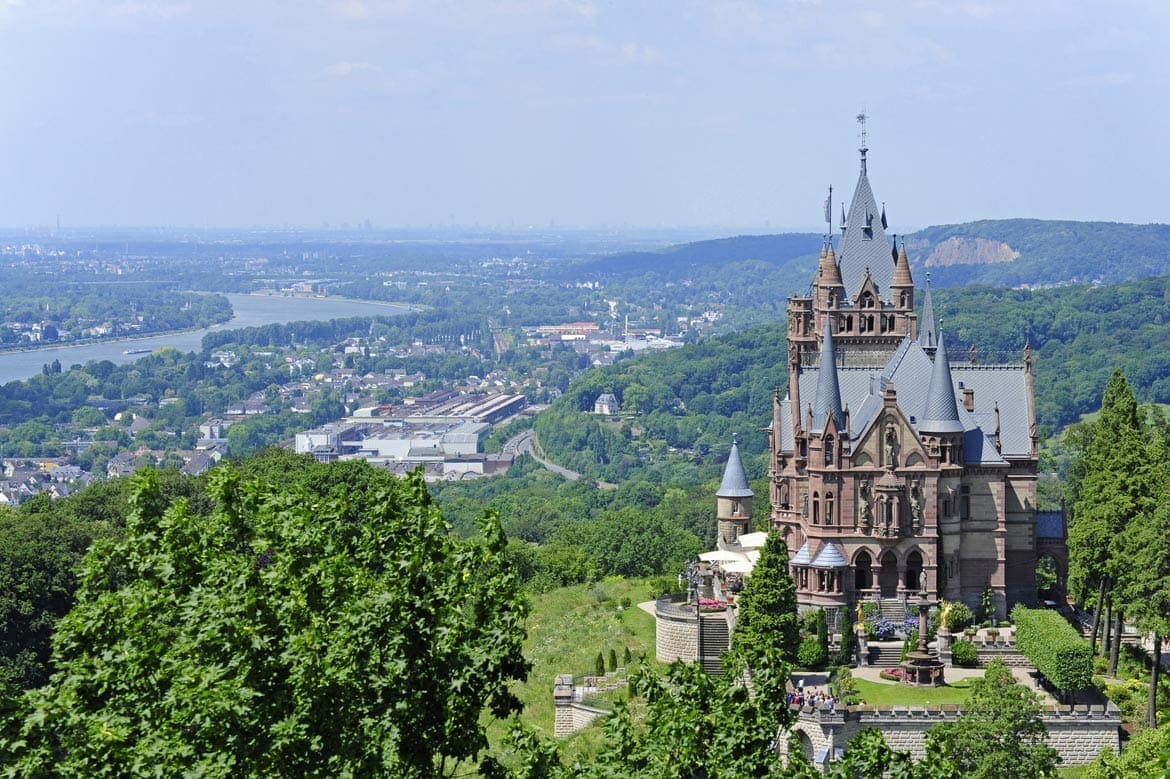
From the industrial dreamscape of Zeche Zollverein to boutique shopping in Cologne, here are 6 incredible day trips from Dusseldorf for you!
17 photos of dresden that’ll make you want to visit immediately.
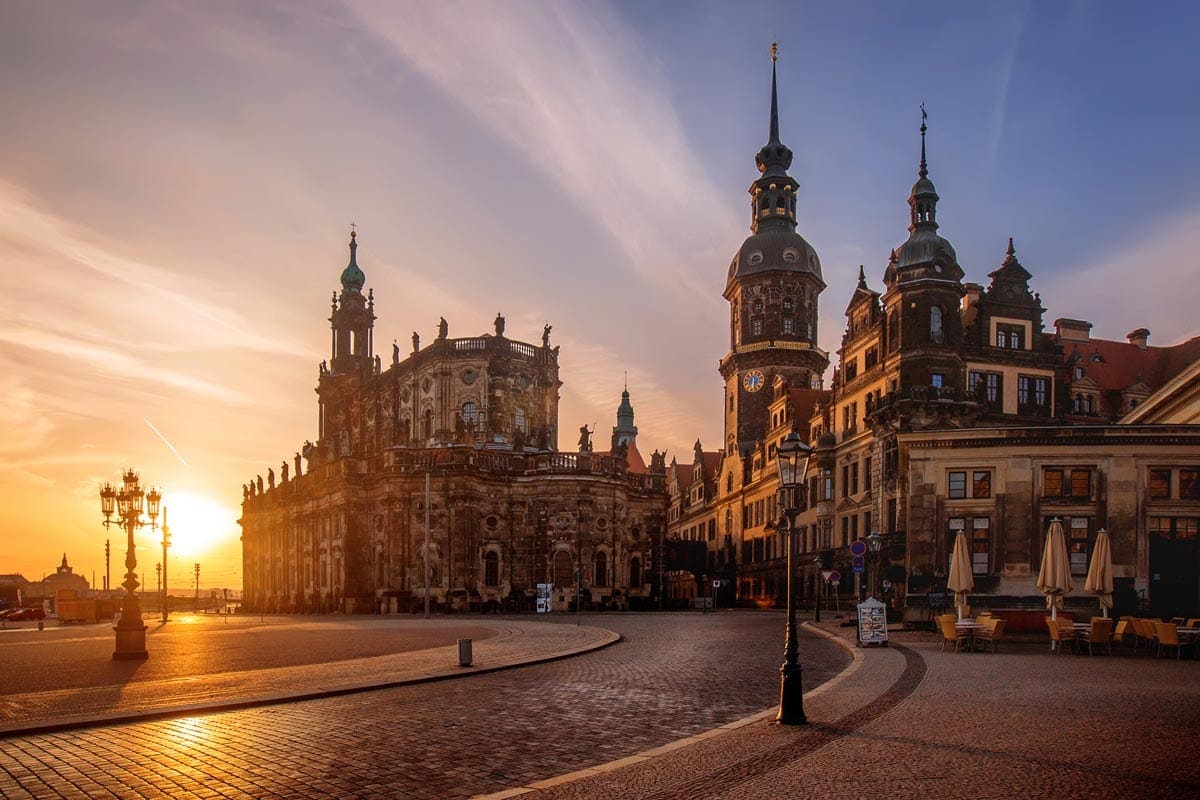
From the Church of our Lady to the Old Market Square, here are 17 photos of Dresden, Germany, that’ll make you want to visit immediately!
Taking on the bastei bridge hike in saxon swizterland, germany.
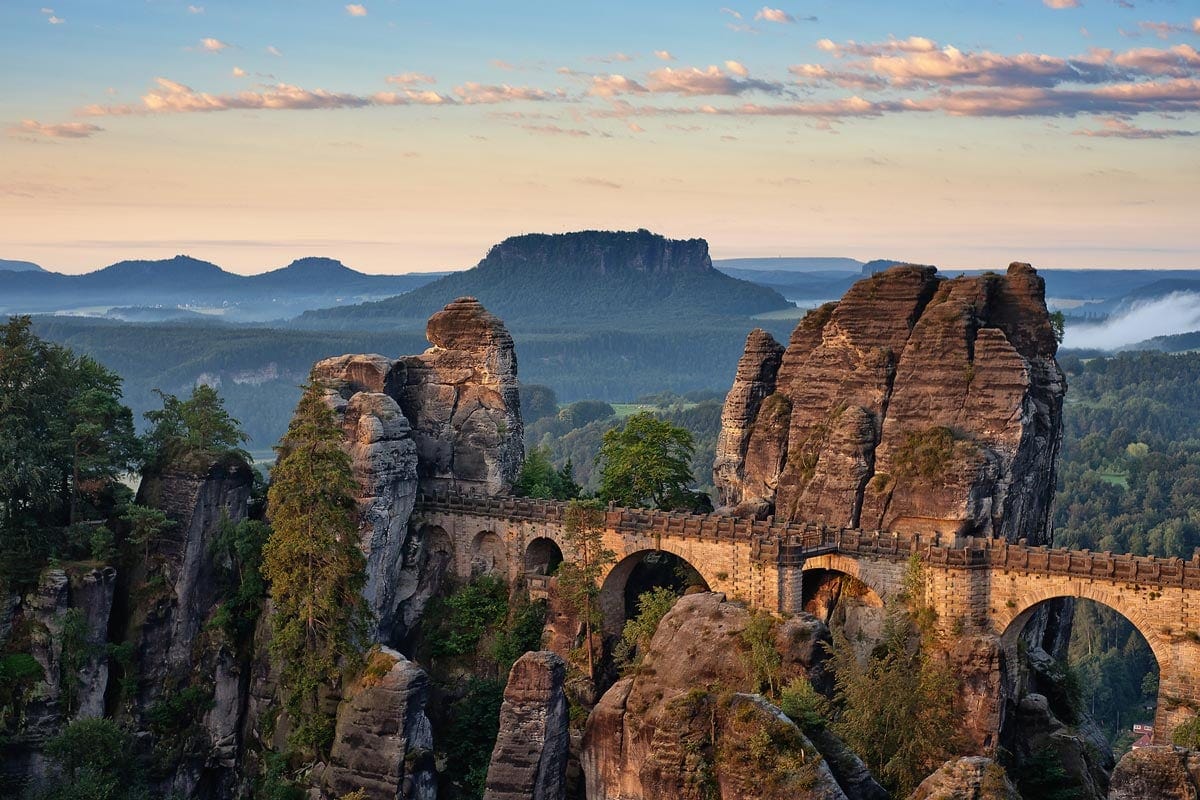
From the best trails to where you should stay, this is everything you need to know about the Bastei Bridge hike in Saxon Switzerland, Germany!

Home » Destinations » Europe » Germany » 5-14 Day Germany Itinerary: A Guide For Planning Your Perfect Germany Trip
5-14 Day Germany Itinerary: A Guide For Planning Your Perfect Germany Trip
Links in this article may earn us a little money if you book/ order stuff. More here .
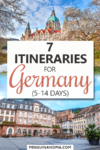
Plan Your Perfect Germany Itinerary with These Detailed Templates!
If you’re looking to plan the perfect trip around Germany, you are in luck! We’re passionate about exploring Germany because it’s a great country – and because Lisa is German!
Jokes aside, we’ve been lucky enough (and have made it a point) to see lots of different parts of the country – from the sea in the north to the mountains in the south. That said, Germany can be a tough country to plan a route or road trip through because there is just so much to see and do!
So, whether you’re looking for the best week in Germany or a Germany itinerary that covers 5 days or 14 days – here’s our master guide with 7 detailed Germany itineraries by train and/or by car! We’ve got cities, attractions, hotels and accommodations, directions, and distances to help you plan the best Germany travel route for you!
We’ve got other great posts to help you plan a visit to Germany:
- Must-Knows + Tips for Travelling to Germany for the First Time
- Helpful German Phrases to Get You By
- Discover 30 Beautiful Places in Germany
- Our Top Hostels in Germany (Stayed at all of them)
Table of Contents
Things to Consider When Travelling in Germany
Before you plan your trip to Germany, there are some things that you should know and keep in mind to make planning easier and to have a successful trip. While you probably know that the currency used in Germany is the Euro, here are some other topics that you should consider as well.
Best Time of Year to Visit Germany
Germany is actually a destination that you can visit year round – but it is important to plan accordingly and go in with the right expectations. If you’re planning a trip during the spring – let’s say from March to May – you could absolutely have beautiful weather… but it may also just rain a lot.
Unfortunately, the weather can be quite difficult to predict. However, as long as you prepare for different possibilities, you can have a great time no matter the weather! Generally you can say that Germany has a moderate climate with cool and rainy winters (more snowy the farther south you get) and warm – but not overly hot – summers.
July and August are usually the warmest months with an average temperature around 20°C. However, there can be days where you have 30°C. Of course, this can vary depending on the exact location you’re travelling to. Often, it is colder by the north coast than it is farther south.
We would honestly recommend that you avoid visiting the country in July if you dislike crowds since this is when the majority of kids are on their summer break from school. As a result, some cities can get quite busy.
Typically, we would recommend travelling in May or June and then from the end of August until the end of September (or even the middle of October). However, there is also a great reason to plan a Germany trip during the winter because of the many beautiful Christmas markets that you could visit at that time of year!
Public Transportation in Germany
Public transportation in Germany is quite good, especially when compared to North America. Yes, sometimes us Germans like to complain about the “Deutsche Bahn” – the German train company – but at the same time we are also super glad that it exists and works well.
If you’re wondering: Yes, all the itineraries mentioned below can absolutely be done if you want to take the train (minus the odd day trip to a castle here and there). If you want to check a train connection and/or buy tickets in advance you can do so on the DB Website . Alternatively, you can also download the DB app to your phone. We both have it and use it regularly.
As an alternative to the train, you can sometimes also use the bus to get from one city/town to another. Since 2013 (before this date it wasn’t allowed), long distance buses have established their presence in more and more cities and are now a popular way to get around for people who are more conscious of their money.
Unfortunately long distance train tickets can sometimes get quite expensive if you don’t book in advance – so the bus can be a good alternative in some cases.
The most popular long distance bus company in Germany is probably Flixbus. We have also used them multiple times to get between cities. If you want to look at the schedule and/or book a ticket, you can do so on their website .
In addition to the trains and long distance buses, the public transport within the cities is also usually pretty good – especially in bigger centres. Many of the cities – or transport associations – have their own transport apps. So, if you know where you are going and plan on using the local buses, trams, metros, etc. then downloading the local transport app would be a great idea!
Car Rental in Germany
If you want to rent a car and plan a Germany road trip, then that is certainly an option as well. Driving in Germany is generally pretty safe and people are not usually as reckless as in some countries in the south of Europe. However, it can get a little crazy in bigger cities like Berlin or Munich – especially if you are not used to driving in bigger centres.
In Germany, you drive on the right side as it is done in the United States, Canada, and many other countries as well. You have probably heard of the “Autobahn” – that’s simply the German name for our highway system. If you follow any of these itineraries, you’ll drive on many different highways.
While it is true that there is no speed limit in some parts of the Autobahn, there are lots of sections where there are actually speed limits in place. You can usually find limits imposed at/around construction zones along the way – so don’t think you can just speed all the time.
And PLEASE don’t drive on the Autobahn like you would on a highway in the United States or Canada – pass on the left and then get back over . If you’re going slower than other cars, there’s no need for you to be in the left (or even in the middle) lane. You can probably tell that this is something that Lisa complains about in Canada frequently, haha.
Since Germany is such a popular destination, there are lots of different rental car agencies to choose from. You can compare prices from different agencies for the duration of your trip with this handy rental car comparison tool . Please make sure to read the fine print so you know whether you need extra insurance, etc.
Also please be aware that many people in Germany drive cars with a stick shift. Rental cars with automatic transmissions exist, but the numbers available are usually lower and these cars might be slightly more expensive.
We’d also recommend that you reserve an automatic car well in advance if you need one – just so you can make sure that one is available for you. It probably wouldn’t be fun learning how to drive a stick shift while on a road trip in a foreign country.
Travel Insurance for Germany
If you’re planning a trip to Germany and you’re not from another EU country, then you should make sure to get travel insurance for the duration of your trip!
While you’ll probably be fine, accidents do happen and it could get really expensive if you’re not covered. That’s why we always travel with insurance.
If you live in another EU country and have health insurance there, you can get the blue health insurance card with which you are covered in other EU countries in emergency cases, as well.
If you don’t have that option – or are from outside of Europe – we recommend that you get private travel insurance.
Germany Itinerary 5 Days
If you only have a few days to travel through Germany, then have a look below at the two 5-day itineraries we have created. For these itineraries, we have assumed that you are not already in the country so they all start and end in bigger cities.
This should help make it easier for you to fly in/out of an airport with good connections if you are coming from overseas.
Depending on your preferences, you can choose between a trip through the northern part of Germany or a trip through the south of the country (mainly Bavaria). If you are interested in bigger cities and/or harbours, then we’d recommend the northern route.
In case you prefer half-timbered houses and beautiful old towns, then you should have a look at the southern route instead. Of course, you can always modify any itinerary to better suit your interests!
Germany Itinerary 5 Days – North
This 5-day Germany itinerary through the northern part of the country can certainly be considered a “sampler-type” of itinerary since you get to see the two biggest cities in the country – but not much more than that.
That’s completely fine though – you can only see so much in five days anyway. If you are interested in bigger cities and don’t have more than a few days, then this itinerary would be great for you!
The total driving time for this itinerary would be about 5 hours 30 minutes with a total distance of approx. 520 km. Of course, this can change depending on the route you are taking and the time of day you are travelling. Commuter traffic could add quite a bit of travel time to your journey.
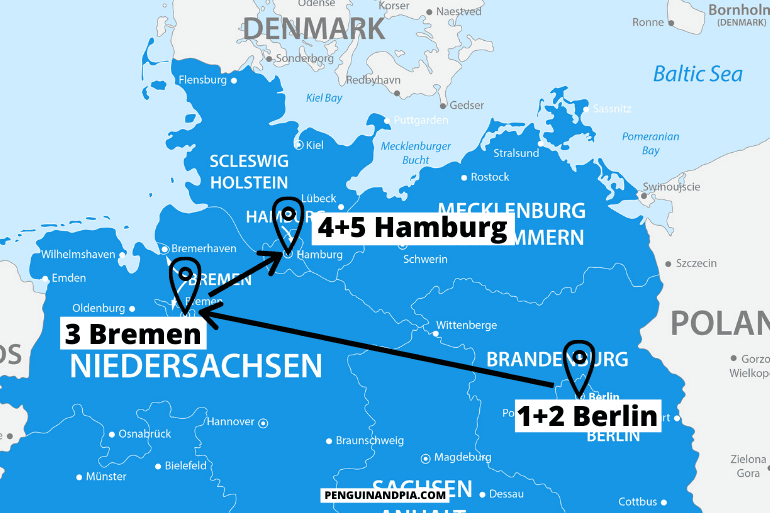
Day 1+2: Berlin Day 3: Bremen Day 4+5: Hamburg
Day 1+2: Berlin
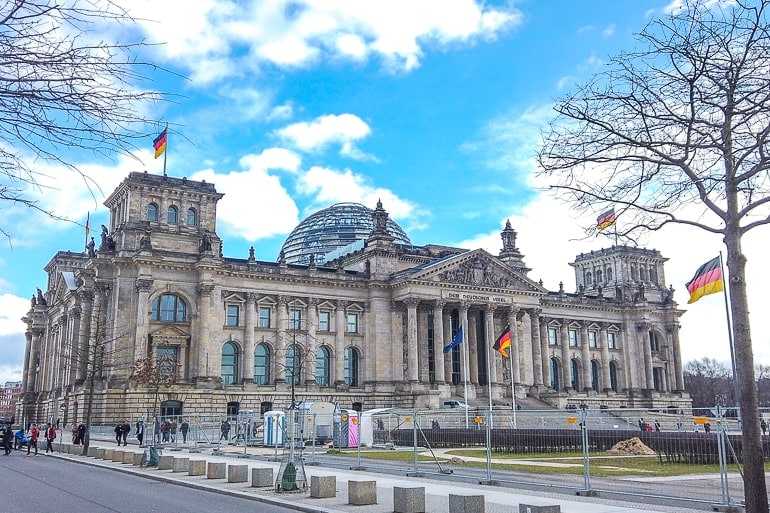
Berlin is a great place to start your adventure since it is the German capital, has multiple airports close by, and has really good train connections.
Since Berlin is such a popular tourist and business city, the car rental industry is well established and there are many different rental agencies to choose from.
— Compare prices from rental car companies in Berlin here
However, since you are only visiting bigger cities on this relatively short itinerary, we believe that a rental car is probably not necessary. Instead, for this trip, it might make more sense to take the train.
Since Berlin is such a big city with lots of things to do, it is worth it to spend (at least) two days in the city. So, remember to book your accommodation in Berlin for two nights .
Accommodation in Berlin : Berlin is a massive sprawling city with loads of different areas to stay and different accommodation options. You can check here for accommodations and hotels in Berlin .
If you are travelling to Berlin with a car, you’ll need a place to park. Check out Park Plaza Wallstreet Berlin Mitte for a stay right in the middle of the city close to Museum Island and other top attractions. It also has a tasty breakfast. Park Plaza has free parking on the street near the hotel (if available) or else it’s for a fee (but a reasonable price considering you’re in the middle).
If you are arriving into Berlin by train, you can check out NH Collection Berlin Mitte am Checkpoint Charlie . Located in the city centre right near the top sight “Checkpoint Charlie”, this popular hotel is in the heart of the action/attractions and is easy to get to via modes of public transit (metro – called the “U” for U-bahn).
If you are searching for a hostel/hotel, check out PLUS Berlin . Located over near the East Side Gallery (the piece of the Berlin wall with the artwork on it), Eric stayed here and really liked it! It’s also very easy to get to using public transit and is close to other areas to go out, etc.
Must-see Attractions in Berlin:
- Brandenburg Gate
- East Side Gallery (Berlin Wall)
We have also written a whole article about classic tourist attractions in Berlin in case you’d like some more inspiration. If you’re looking for some tips on how you could spend a day in Berlin, have a look at our One Day in Berlin Guide .
Day 3: Bremen
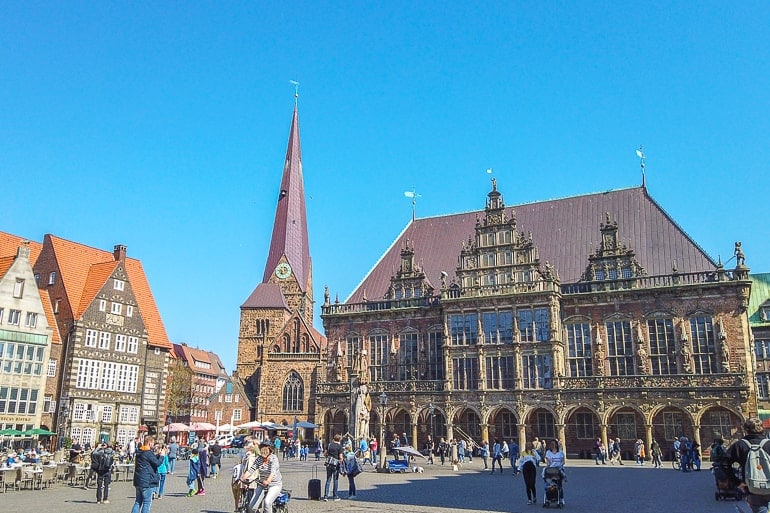
On the third day of your 5 days in Germany, you’ll head for Bremen. We’d recommend that you do the drive/train ride in the morning so you have enough time to explore the city once you get there.
Bremen is a hanseatic city with a nice old town – the market square with the town hall and the cathedral is especially popular. In German-speaking countries, the city is also known for a tale called the “Town Musicians of Bremen” by the Brothers Grimm. You’ll come across the animals of the tale (donkey, dog, cat, and rooster) many times as you stroll through the city.
The drive from Berlin to Bremen will take you approximately 4 hrs 10 min by car , but only around 3 hrs by train . If you take the train, try to book in advance if you can as this will usually save you some money.
Accommodation in Bremen: Bremen is a popular city to explore and it’s also on the larger side so you’ll find plenty of accommodations to suit your needs. There are hotels in the city centre/old town which put you within walking distance of the river and top attractions. You can check here for accommodations and hotels in Bremen .
For a popular choice in the historic middle, you should check out the very popular Radisson Blu Hotel Bremen . Funny story – we know there’s underground parking because we parked there when we visited Bremen by car.
If you want to stay closer to the train station just outside the historic centre (but still very central), check out the Dorint City-Hotel Bremen . This lovely and also very popular hotel is close to the pretty Windmill and flower gardens and has water views just outside the old city walls.
Must-see Attractions in Bremen:
- Marktplatz with Town Hall and Cathedral
- Böttcherstraße
- Schnoorviertel
If you want some more tips for Bremen, have a look at our detailed Things to do in Bremen Guide .
Day 4+5: Hamburg
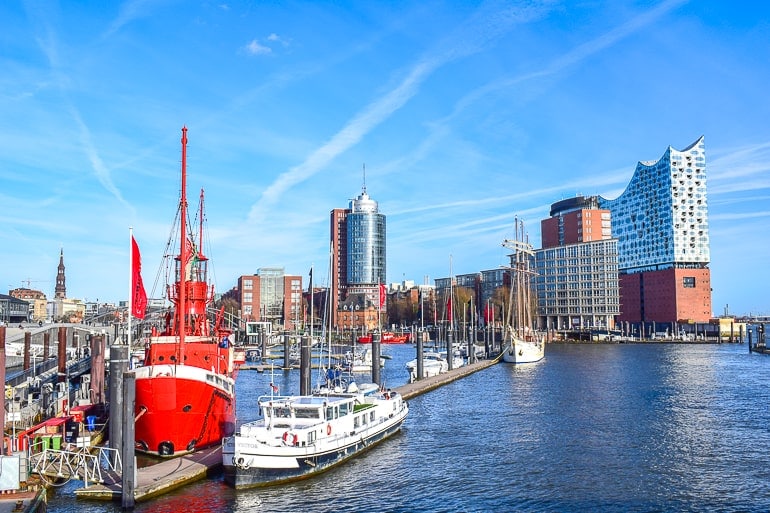
Hamburg is the second-biggest German city and the last stop on this short itinerary. We have been to Hamburg numerous times now and it is actually one of our favourite bigger German cities. You’ll find that the atmosphere of the city is very different than in Berlin. Not necessarily better or worse – just different.
Interesting (and slightly irrelevant) fact: The cities you visit on this itinerary are the three city states that exist in Germany in addition to the 13 area states such as Bavaria, Nordrhine-Westphalia etc.
The drive from Bremen to Hamburg is actually pretty simple and should only take around 1 hour 30 minutes by car and just around 1 hour if you take an ICE (fast train) . The train connection between these two cities is great with trains running pretty frequently. That should make it quite easy to find a train connection that works for your schedule.
Accommodation in Hamburg : Hamburg is popular city with loads of different accommodations and areas to stay in. You can check here for accommodations and hotels in Hamburg .
If you are travelling to Hamburg with a car, you might want to check out the Mövenpick Hotel Hamburg . Located in an old water tower, this unique hotel has a number of cool features with stunning views and parking onsite. It’s very popular – and also close to public transit for getting around!
If you are travelling to Hamburg by train, ARCOTEL Rubin Hamburg is a great hotel option for you to check out. Located in the cool area of St. Georg, you can easily walk to the hotel from the train station. It’s also walkable to other parts of the city centre and other attractions.
If you are looking for a hostel in Hamburg, you might want to check out Generator Hamburg as a reliable and popular hostel stay close to central station and the heart of the city.
If you want more details about accommodations in the city, we have a more detailed guide on where to stay in Hamburg .
Must-see Attractions in Hamburg:
- Speicherstadt
- Elbphilharmonie
- St. Pauli Piers
As one of our first ever articles on Penguin and Pia, we actually wrote a short Hamburg Guide . Have a look if you want some more Hamburg inspiration. Unfortunately it’s not nearly as detailed as our newer article – looks like it’s time for an update!
Germany Itinerary 5 Days – South
If you would like to explore the southern part of Germany instead of the north, then we would recommend the following 5 days Southern Germany itinerary. Compared to the northern itinerary, this trip includes stops in some smaller towns and cities. So, if you are interested in seeing some places of various sizes, beautiful old towns, and maybe a castle, then this might be a good itinerary for you.
The driving distance of this trip is just around 680 kilometres with a total driving time of approx. 7 hours . Depending on your mode of transportation, this can – of course – vary slightly.
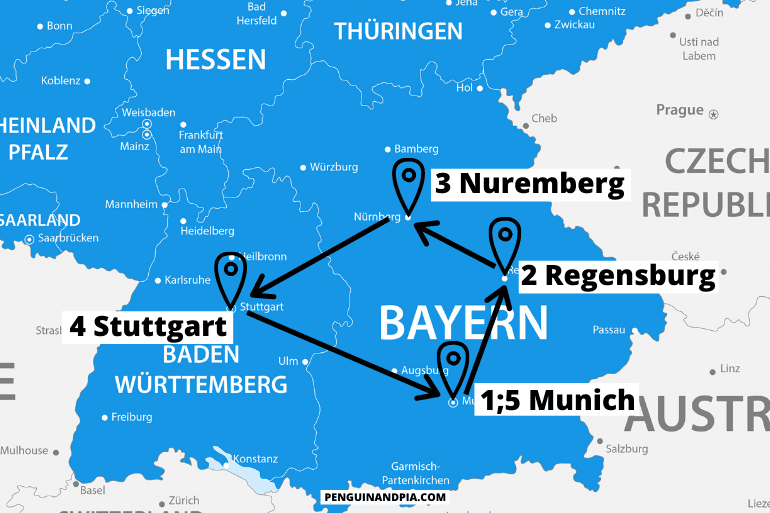
Day 1: Munich Day 2: Regensburg Day 3: Nuremberg Day 4: Stuttgart Day 5: Munich
Day 1: Munich

We are starting (and ending) this itinerary in Munich since it is an easy airport to fly in and out of from other parts of the world. If you are coming from another part of Europe by train, the connections to Munich are also usually pretty good.
Munich is the third-biggest German city and a very popular tourist destination. International travellers often mainly know the city because of the Oktoberfest which happens every year from the middle of September until October.
However, there is so much more to do and see in Munich than just the “Wiesn” (as the Oktoberfest is sometimes called as well). We are always happy to return to Munich because there is just so much to explore.
If you are thinking about renting a car for this itinerary, then you’ll be happy to know that it is quite easy to get a rental car in Munich. You can either pick it up directly at the airport after you land (if you arrive by plane) or in the city centre before you head to the next stop on this journey.
— Compare prices from rental car companies in Munich here
Accommodation in Munich: Munich is very large and popular city so finding a place to stay is no problem. The issue becomes that there are too many places to choose from! That said, you can check here for accommodations and hotels in Munich .
Specifically, we stayed at the very popular H2 Hotel München Olympiapark and we would highly recommend it for the value for money. The hotel has nice, cozy rooms, a super great breakfast buffet, and has a metro station steps from the front entrance to take you to the city centre.
There’s also onsite parking which makes this hotel perfect if you are travelling to Munich by car. The famous Olympic Park and BMW Museum are close by, too!
If you want to stay a little more in the city centre, then check out the Platzl Hotel Superior . This trendy hotel is in the heart of the Old Town just steps from top attractions like Marienplatz and the famous Hofbräuhaus. It’s also easy to get to the central train station either walking or on the metro.
If you are looking for more details on accommodations in this massive city, we wrote a detailed guide on where to stay in Munich .
Must-see Attractions in Munich:
- Marienplatz with New Town Hall
- Olympic Park
- Victuals Market
- English Garden
We also have a great little guide on how to spend one day in Munich if you want more details.
Day 2: Regensburg
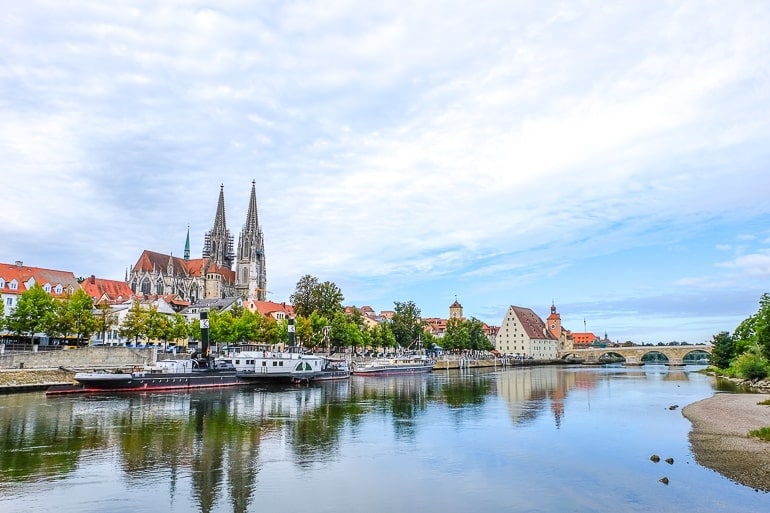
On day two of your trip you’ll be on your way to Regensburg, a small city in Bavaria on the Danube river. Due to its location by the river, Regensburg is a popular stop for people on a river cruise. So don’t be surprised if you see many different tour groups in the Old Town.
We recently spent a couple of days in Regensburg to get to know the city better and enjoyed our time there. One of the highlights is the Old Stone Bridge in the city centre which was built in the 12th century. We actually filmed a small YouTube video in Regensburg – which you can watch here if you are curious about what the city looks like.
The journey from Munich to Regensburg takes approximately 1 hr 20 minutes by car and around 1 hr 30 minutes by train . If you decide to travel by train – and especially if you are travelling with other people – we would recommend that travel with a “Bayernticket” (Bavaria Ticket). This ticket for train travel within the state of Bavaria usually allows you to save some money compared to regular prices.
Accommodation in Regensburg: If you are staying a night in Regensburg, you’ll have a number of great accommodations to choose from. To get started, you can check here for accommodations and hotels in Regensburg .
When we visited the city, we stayed at the Holiday Inn Express – Regensburg and really liked it. It’s a newer hotel and it really shows. The breakfast was excellent and there is even an onsite parking garage if you are travelling with a car. It’s not in the Old Town or near the river – but we did walk there one day and it only took about 15 minutes.
If you are travelling by train and you are on-foot, then check out the Altstadthotel Am Pach . This simple hotel is located right in the heart of the old town so you’re close to everything there is to see and do in Regensburg – including the beautiful Danube River. They also have breakfast included.
Must-see Attractions in Regensburg:
- Old Stone Bridge
- St Peter Cathedral
We are currently still working on our Regensburg Guide – but we’ll link it here once it is published.
Day 3: Nuremberg
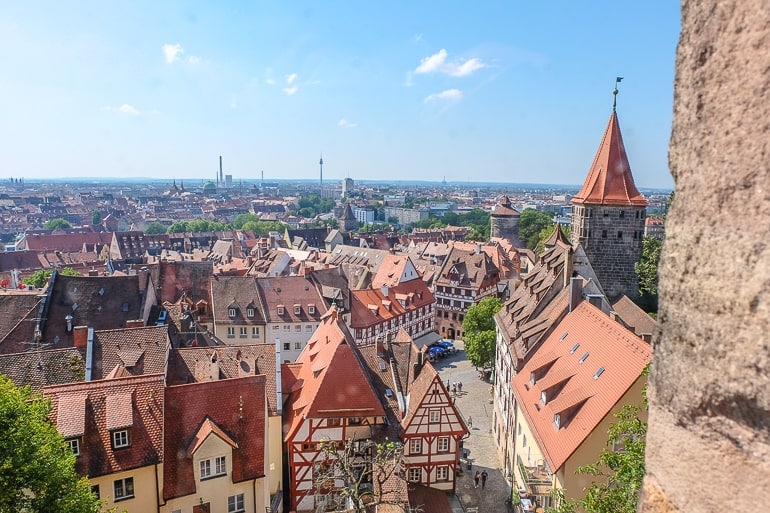
On the third day of this 5 day Southern Germany itinerary you’ll drive – or take the train – from Regensburg to Nuremberg. Nuremberg is a medium sized city in a part of Bavaria called Franconia. If you pay attention, you might notice that the dialect spoken here is quite different from that spoken in Munich and other places farther south.
Lisa actually grew up in this part of Germany so she has been to Nuremberg many, many times. Last year we also went to explore the city together and had a great time. Travellers from abroad mainly know the city for the Nuremberg Trials which took place there after World War II. You can certainly learn alot of history in this German city!
Since Nuremberg is quite close to Regensburg the drive won’t be long – giving you slightly more time to explore the city.
The journey takes approximately 1 hour 10 minutes by car and between 1-2 hours by train depending on which train you take (some stop more often than others). Once again, a regional ticket – such as the Bavaria Ticket – will probably save you some money if you travel with more people.
Accommodation in Nuremberg : Since Nuremberg is a very popular city to visit in Germany, there are many, many places to stay scattered throughout the city centre and around it. You can check here for accommodations and hotels in Nuremberg .
When we visited, we stayed at Five Reasons Hotel and Hostel and we really liked it. Located just inside the medieval city walls, we were really close to the train station and yet also steps from top attractions like the Germanisches Nationalmuseum. The place was bright and great value for the price which we liked a lot.
Close to Five Reasons, we had friends stay at the Sheraton Carlton Nuremberg and they loved it. We actually saw it with our own eyes – it had a pool with views of the city among other perks. There’s also a parking lot right across from the hotel if you’re coming to Nuremberg by car. It’s walking distance to the old centre and the central train station so best of all worlds!
Must-see Attractions in Nuremberg:
- Imperial Castle of Nuremberg (Kaiserburg)
- Documentation Center + Nazi Party Rally Grounds
- Albrecht Dürer’s House
As is the case with Regensburg, we are also still working on our article for Nuremberg. Once it’s live, we’ll link it here.
Day 4: Stuttgart
Stuttgart is the capital of the German state called Baden-Württemberg and the only place on this itinerary that is not located in Bavaria. The city is mainly known for being a “car hub” since both Mercedes-Benz and Porsche have their headquarters there. There are also museums dedicated to both car brands.
Stuttgart is a bit smaller than Munich but there is still a lot to see. In fact, one day won’t be enough to see the whole city – but it’ll allow you to get a good first impression. Next to the car museums, you could visit some of the many green spaces and/or old buildings that the city has to offer.
Driving from Nuremberg to Stuttgart by car will take you approximately 2 hours 15 minutes. If you have the time, you could even take a small detour and stop in Rothenburg ob der Tauber, known for its picturesque Old Town.
By train , the journey from Nuremberg to Stuttgart will take between 2 hrs 10 minutes and 2 hrs 30 minutes – depending on the type of train you are taking. Try to book your ticket in advance if possible as this can save you some money.
Accommodation in Stuttgart: There are many places to stay in Stuttgart – especially in the city centre. You can check here for accommodations and hotels in Stuttgart .
If you’re travelling to Stuttgart with a car, check out the Abalon Hotel ideal . Located very much in the city centre, this popular hotel has an underground parking garage and offers a good breakfast selection.
If you’re travelling to Stuttgart by train, you can check out the Pension am Heusteig . This guesthouse-style accommodation doesn’t have parking but offers a great breakfast and is a doable walk or metro ride from the train station. Funny enough, these two accommodations are very close to one another!
Must-see Attractions in Stuttgart:
- Schlossplatz
- Mercedes-Benz Museum
- Staatsgalerie Stuttgart
Day 5: Munich
On the last day of your trip you’ll make your way back to Munich since it is usually easier to leave Germany through the Munich airport than smaller airports in the surrounding area.
However, if you don’t have to get to an airport – and/or are taking the train home – you could also stay an extra night in Stuttgart if you wanted. Both cities are worth spending an extra few hours in – so you really just have to see what works best for you.
If you decide to get back to Munich, then the journey from Stuttgart to Munich will take approximately 2 hours 20 minutes by car and just slightly less (2 hrs 15 minutes) by train .
Accommodation in Munich : We already went over accommodations in Munich in Day 1 of this itinerary. So, you can head back up for the full details – but we would highly, highly recommend the H2 Hotel München Olympiapark as great value for money with great breakfast, parking, and a metro stop outside the front door.
Don’t forget we also have our detailed guide on where to stay in Munich if you want to have a deeper look at accommodations in the city.
We also have a post on spending one day in Munich if you want more details about the city!
Germany Itinerary 7 Days
If you have slightly more time to explore Germany, we have also created two 7 day Germany itineraries for you. Similar to the 5 day itineraries, we made two different itineraries since it’s pretty much impossible to see the whole country in just a week.
Instead of a northern and southern itinerary, this time we have focused on the western and eastern parts of the country. But please don’t read too much into that description – we use the terms quite loosely. As always, you’re welcome to modify any part of the itinerary to make it better fit your schedule/interests.
Germany Travel Itinerary 7 Days – West
For this itinerary, the total driving time would be around 14 – 15 hours and the distance would be slightly over 1100 km . For these calculations, we included the day trip to Monschau (and back to Cologne) as well as the day trip to Freiburg im Breisgau (and back to Stuttgart), which would be a longer day trip anyway.
So, depending on which day trips you decide to add on to (or remove from) this itinerary, your driving time and distance could be noticeably different than the estimates given above!
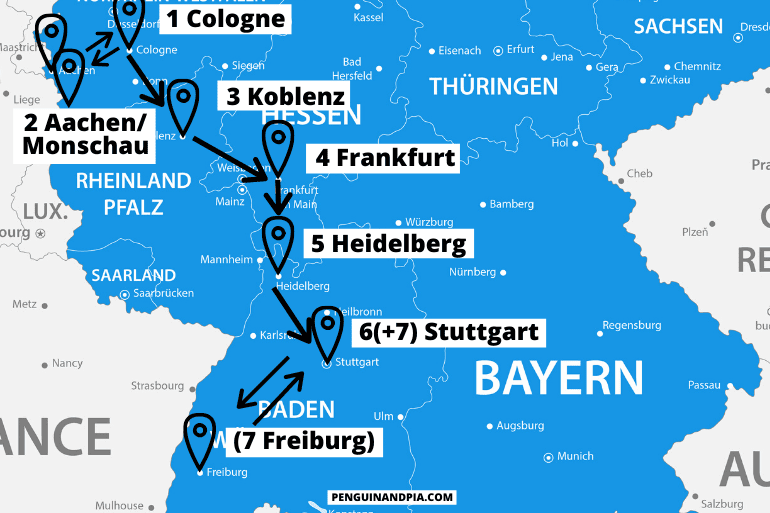
Day 1: Cologne Day 2: Day Trip to Monschau/Aachen Day 3: Koblenz Day 4: Frankfurt Day 5: Heidelberg Day 6: Stuttgart Day 7: Stuttgart / Day Trip to Freiburg im Breisgau
Day 1: Cologne
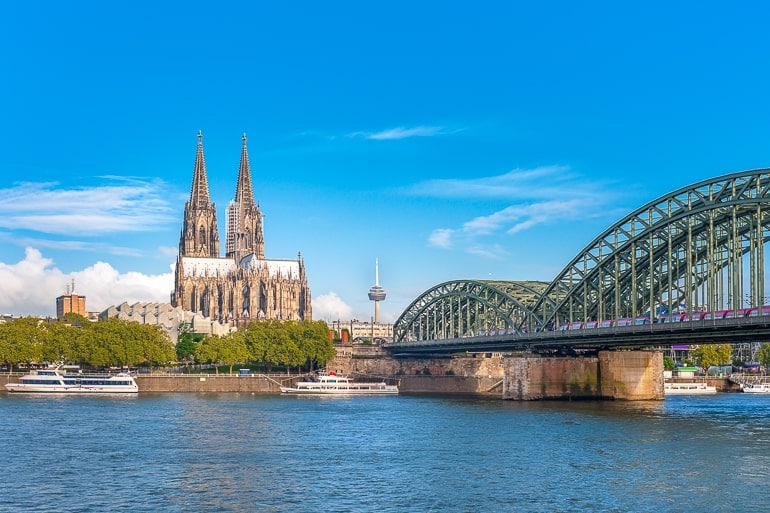
As we have already explained above, we like to start these itineraries in bigger cities to make it easier for people from overseas to get to Germany and start their adventure without hassle. Cologne is Germany’s fourth-biggest city (by population) and has two pretty good airports (Airport “Köln Bonn” and Airport “Düsseldorf”) close by for those coming from far away.
If you want to rent a car for this itinerary, it should be pretty easy to get one in Cologne since it’s quite an international city with lots of visitors.
— Compare prices from rental car companies in Cologne here
Cologne is a pretty spread-out city so you won’t be able to see the whole city in a day or two. However, the highlight of the city is certainly the Cologne Cathedral which is located right next to the central station and the Rhine River.
Make sure to plan some time to visit this impressive building – we always spend much longer in there than we originally plan. It’s free to enter so it can get very crowded depending on the day and time you’re visiting.
Accommodation in Cologne : Cologne is a very big city with multiple areas to stay in. As such, there are lots of accommodation options across the city. Wherever you book, remember to book your accommodation for two nights since you will go on a day trip and then return to Cologne on the second day. You can check here for accommodations and hotels in Cologne .
We have stayed in the Lindner Hotel City Plaza and loved it. The floors all have themes (we got Cologne Zoo with animals), the breakfast buffet is absolutely fantastic, and it’s a short walk to the Cathedral along one main street. There’s also parking available at/near the hotel for those with a car.
If you want to stay more in the heart of the city centre, check out something like the CityClass Hotel Residence am Dom . It’s popular, centrally located with shops and restaurants around, and only a short walk to the train station.
If you are looking for a hostel in Cologne, Eric once stayed at Cologne Downtown Hostel and it was honestly excellent. There’s a grocery store right below it and it’s located in the city centre. It also has a large balcony to enjoy the sunshine from!
Must-see Attractions in Cologne:
- Cologne Cathedral
- Cologne Chocolate Museum
Day 2: Day Trip to Monschau/Aachen
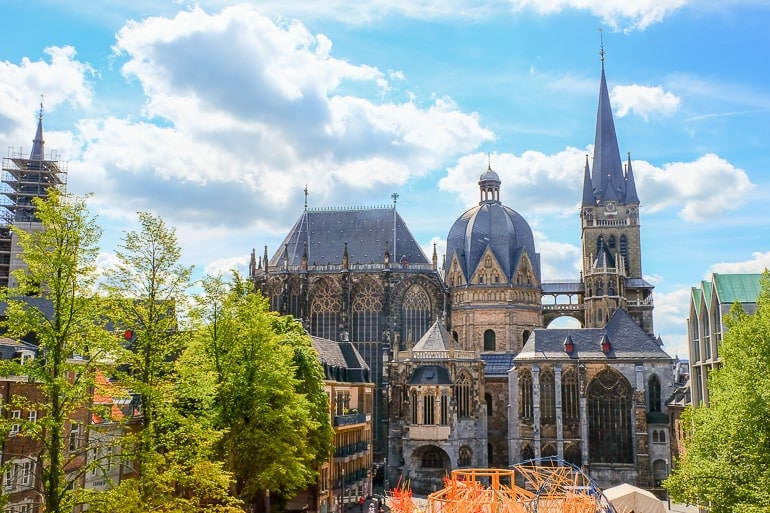
On the second day of this Germany itinerary, you have a few different option: you can either spend another day in Cologne if you feel like you haven’t seen enough of the city yet or take a day trip to Monschau or Aachen. Both of these are two places not too far from Cologne.
Monschau is a popular day trip in the area mainly because of its picturesque buildings in the old town. In fact, you probably have already seen photos of it on social media. To get to Monschau from Cologne, you can either drive or take a combination of trains and buses.
Getting to Monschau takes around 1 hr 40 minutes by car and approx. 2 hours by public transport . To visit Monschau by public transport, you can take the regional train from Cologne to Aachen-Rothe Erde and then take Bus #66 from there to Monschau.
Must-see Attractions in Monschau:
- Monschau Castle
If you want to go on a day trip but don’t want to venture that far, then Aachen would be another great option. This city is actually Germany’s most western city very close to the borders of The Netherlands and Belgium.
We’ve lived close to Aachen for a while and have written a whole guide full of things to do in Aachen that you should read if you want more information. In our opinion, one day is the perfect amount of time to explore the city since it doesn’t have that many attractions and the old town in the city centre is quite compact (but still very pretty).
Getting from Cologne to Aachen is also very easy. It takes approx. 1 hr 20 minutes by car and just around 50 minutes by regional train . You should look into getting a “Schönes Tag Ticket NRW” for the day if you’re travelling with more people as this can save you some money.
Must-see Attractions in Aachen:
- Aachen Cathedral
- Elisenbrunnen
Day 3: Koblenz
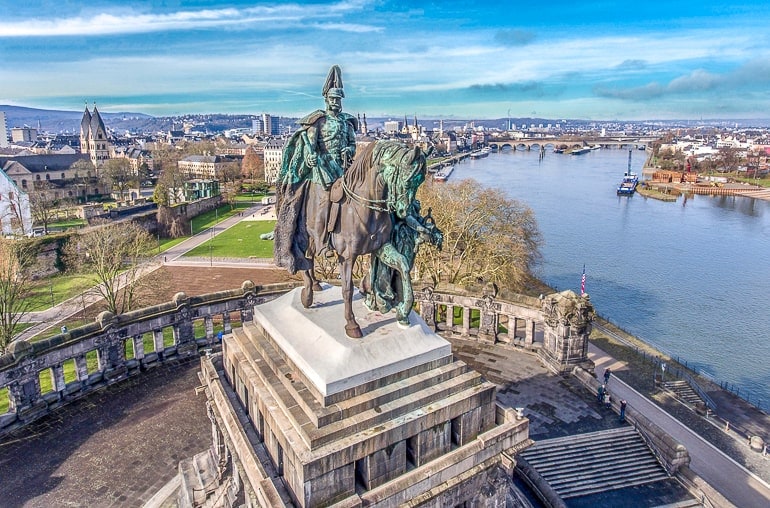
From Cologne, your journey continues to Koblenz – another city on the Rhine River. Koblenz is a smaller German city with a population of slightly over 110,000 inhabitants.
There are quite a few castles and nice hikes in the area which are easy to reach from Koblenz – just in case you decide that you don’t want to spend the day in the city. Depending on the time of year, you could also look into booking a boat tour on the Rhine river. This way, you get a unique perspective of the beautiful region.
Getting from Cologne to Koblenz is pretty easy and will take approximately 1 hour 30 minutes by car and between 50 minutes and 1 hr 10 minutes by train . We really like this train journey since the tracks follow the river for a majority of the trip. As a result, you get some really nice views – and might even spot some of the beautiful castles in the area!
Accommodation in Koblenz: Koblenz is certainly not a huge city – but you’ll still find a good number of places to stay for a night or two. You can check here for accommodations and hotels in Koblenz .
For a hotel right in the city centre, check out the Sander Hotel . This lovely hotel is super popular and close to shops and the rivers. If you are arriving to Koblenz by car, there is onsite parking at the hotel. However, since the city is smaller you can also easily reach the hotel by walking from the central train station.
Must-see Attractions in Koblenz:
- Deutsches Eck
- Ehrenbreitstein Fortress
- Koblenz Cable Car
Day 4: Frankfurt
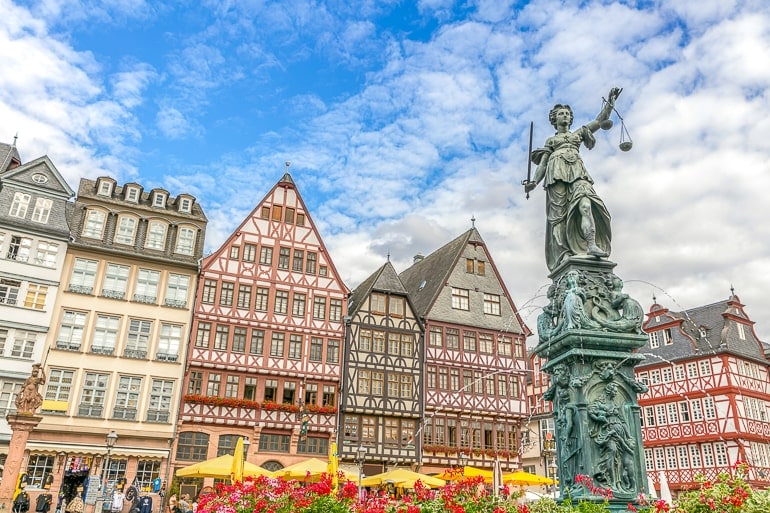
The next stop on your itinerary is Frankfurt, arguably one of the country’s most popular transport hubs due to the busy Frankfurt airport. Frankfurt is an interesting city that divided people: some people really enjoy it while other people don’t like it at all. To be fair, we haven’t spent enough time in the city to really solidify our opinion.
Either way, we do believe that Frankfurt is a stop that you shouldn’t miss if you are trying to get to know different areas of Germany. Known as the financial hub of Germany, this city with its many skyscrapers can feel quite a bit more modern than other German cities. However, the city also has a beautiful, historical market square that you should visit.
The journey from Koblenz to Frankfurt is another easy one – and if you are taking the train (we would recommend that!), you’ll once again follow the Rhine River for big parts of the journey and be rewarded with some great views.
The train ride will probably be between 1 hr 25 minutes and 2 hrs 12 minutes long – depending on the connection you choose. By car , the trip will take around 1 hr 30 minutes . Of course, this can vary depending on traffic.
Accommodation in Frankfurt : There are loads of places to stay in Frankfurt given its popularity and size. You can check here for accommodations and hotels in Frankfurt .
A great option in Frankfurt is the Motel One Frankfurt-Römer . Located very much in the heart of the city centre close to the old town and river, this cool hotel has underground parking if you are arriving to Frankfurt by/with a car. It also serves up a great breakfast!
If you are arriving by train to Frankfurt, you should check out Fleming’s Express Hotel Frankfurt . Located literally right beside the central station (which is in the city centre), this upscale hotel is very popular because it’s very affordable and also has a great breakfast.
Must-see Attractions in Frankfurt:
- Palmengarten
Day 5: Heidelberg
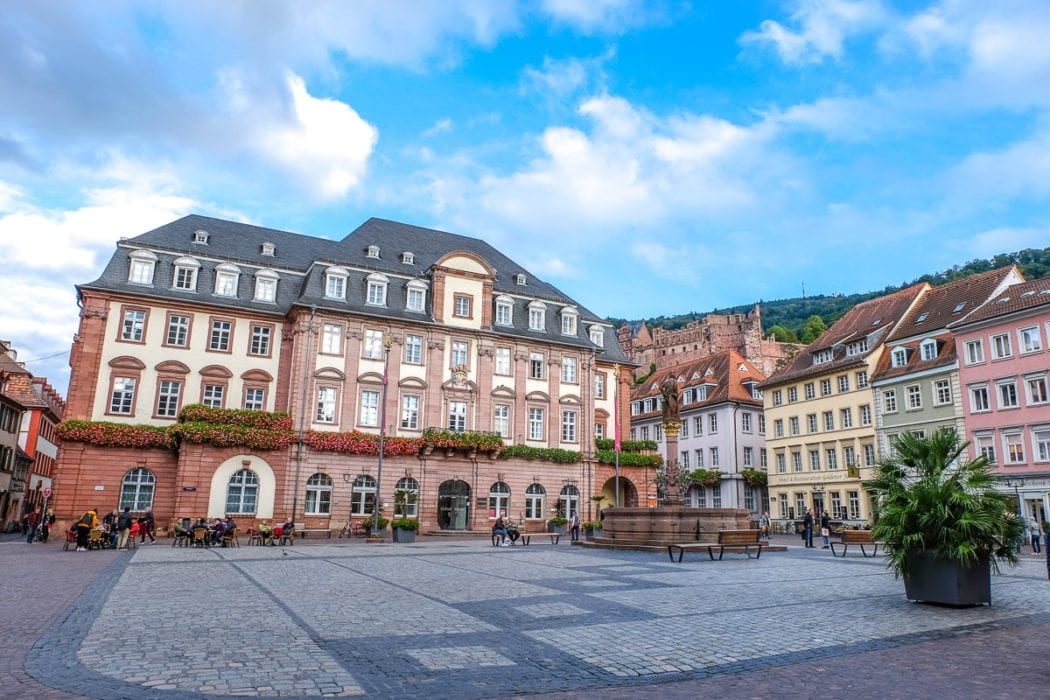
After your day in Frankfurt, you’re heading to Heidelberg which is actually one of our favourite German cities. The highlight of the city is certainly the castle on top of the hill which is visible from many different parts of the city.
Heidelberg is smaller than Frankfurt so you can see quite a bit in just 24 hours. The Old Town is beautiful and lots of attractions are located there. Our highlight was probably the tower climb of the Church of the Holy Spirit. From up there, you get a beautiful view of the Old Town. A very close second was the cable car ride up to the Königstuhl which was lots of fun – even in the rain.
Getting from Frankfurt to Heidelberg won’t take too long. The journey will be approximately one hour by car and between 45 minutes and 1 hr 30 minutes by train – depending on which type of train you are taking.
Accommodation in Heidelberg: If you’re heading for Heidelberg (good choice), there are lots of great places to stay. You can check here for hotels and accommodations in Heidelberg .
We stayed a little outside the old town – but close to the train station – at NinetyNine Heidelberg City . This hotel was really, really great. The beds were comfy and the decor has animals everywhere – you have to see it to understand!
There’s onsite parking (paid) and street parking (free, but not guaranteed) if you are travelling with a car. There’s also a tram stop right outside the hotel to get directly into the city centre in minutes.
If you are looking to stay in the historic old town, then check out colourful hotels like Hotel Holländer Hof which overlooks the river or Hotel Zum Ritter St.Georg which is literally overlooking the main Marktplatz.
Must-see Attractions in Heidelberg:
- Heidelberg Palace
- Church of the Holy Spirit (mainly tower climb)
If you want to learn some more about Heidelberg and what there is to do, you can read our detailed Heidelberg Guide here .
Day 6: Stuttgart
The next day you will drive to Stuttgart, a city that we’ve already mentioned in one of our Germany itineraries for 5 days. As we have already mentioned, you’ll probably really enjoy Stuttgart if you are interested in cars.
Even if you aren’t, there is still lots for you to explore. Did you know that wine also plays a huge role in Stuttgart and the surrounding region? If this is something that interests you and you’re there in the summer (specifically around the end of August), then you should stop by the “Stuttgarter Weindorf” (“wine village”) – but obviously, please don’t drink and drive.
As for getting from Heidelberg to Stuttgart, the journey will take you approximately 1 hr 20 minutes by car and between 40 minutes and 1 hr 30 minutes by train . As mentioned before, the time differs depending on the type of train you are choosing.
Accommodation in Stuttgart: Stuttgart has many places to stay so you can check here for accommodations and hotels in Stuttgart .
Be sure to see the Abalon Hotel ideal if you have a car. This hotel has underground parking available and a tasty breakfast. It’s also in the city centre which makes sightseeing easy.
Those coming to Stuttgart by train should look at the Pension am Heusteig . It’s a guesthouse that is located not too far from the first hotel here and it’s a doable walk or metro ride from the central station.
Day 7: Stuttgart / Day Trip to Freiburg im Breisgau
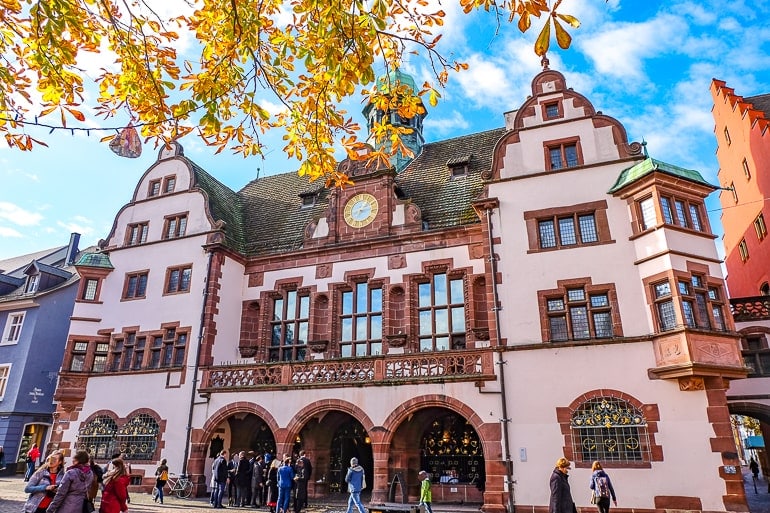
For this itinerary, you can decide how you would like to spend your last day. You could either spend another day to explore more of Stuttgart (and maybe relax for a bit) or you could head farther south and spend a day in Freiburg im Breisgau. We really enjoyed spending time in this small city in the south of Germany during our visit.
We are currently still in the process of writing our Freiburg guide, but we’ll link it here once it’s done. However, a good way to start your exploration of the city is by wandering the old town.
In Freiburg, you’ll find that many of the cobblestoney streets have small water-filled runnels – called Bächle – running alongside it. Sometimes they even have small yellow ducks in them!
The journey from Stuttgart to Freiburg im Breisgau is slightly longer than most other parts of this itinerary. It takes approximately 2 hrs 30 minutes by car and around 2 hours by train . Since this train journey will probably include at least one ICE (the fast train), we’d recommend that you book your train tickets early if you can to save some money.
Must-see Attractions in Freiburg:
- Freiburger Münster (Cathedral)
- Schlossberg + Tower
- New + Old Town Hall
Germany Travel Itinerary 7 Days – East
If the other week-long Germany itinerary doesn’t interest you and/or you really want to visit the German capital Berlin, then you might prefer this eastern route instead.
The driving time would be just slightly over 10 hours and would be approximately 900 km driving distance – including the day trip to Potsdam (which would honestly be easier with public transport, though)!
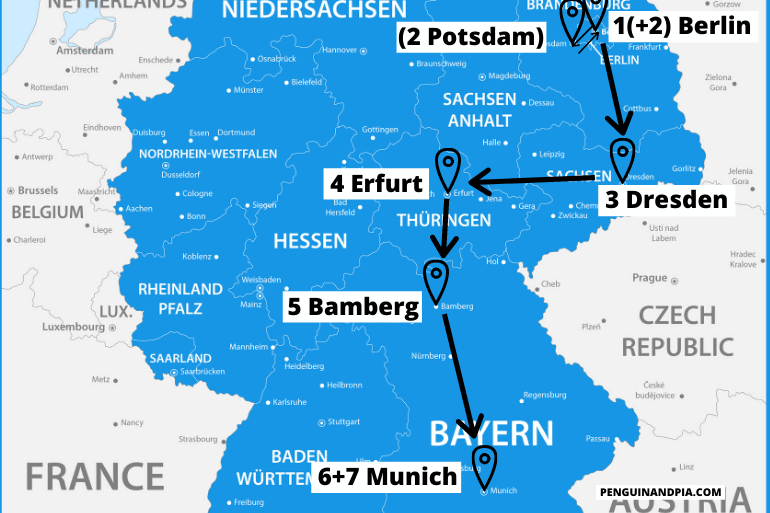
Day 1: Berlin Day 2: Berlin / Day Trip to Potsdam Day 3: Dresden Day 4: Erfurt Day 5: Bamberg Day 6+7: Munich
Day 1: Berlin
Once again, this itinerary begins in Berlin since it is one of the big cities that is easier to get to for people coming from overseas. Similar to the five day itinerary that started in Berlin, you’ll stay two nights in the German capital. There is just too much to see to spend only one day – and even in two days you wouldn’t be able to explore everything.
In case you’ve already been to Berlin on a different trip and/or aren’t a huge fan of big cities, we also give you the option of a day trip to Potsdam (a city close by) on the second day. More on that below.
Accommodation in Berlin : Finding a place to stay in Berlin can be tough because there are just so many options. You can check here for accommodations and hotels in Berlin .
If you have a car, check out Park Plaza Wallstreet Berlin Mitte . Located right in the middle of the city close to Museum Island, this hotel has a great breakfast and free parking on the street behind the hotel. Otherwise, parking is paid but for a decent price for the city centre.
Those without a car travelling by train should see the NH Collection Berlin Mitte am Checkpoint Charlie . If you want a hotel close to a top attraction that is easy to get to with public transport, this is definitely one of them!
Across the city, PLUS Berlin is a really good hostel/hotel that Eric stayed at a few years ago. It’s a big place but it was a great stay over by the East Side Gallery (part of the Berlin Wall with the graffiti on it).
As already mentioned above, if you want to read some more about Berlin, check out our articles on Things to do in Berlin and How to spend one day in Berlin .
Day 2: Berlin / Day Trip to Potsdam
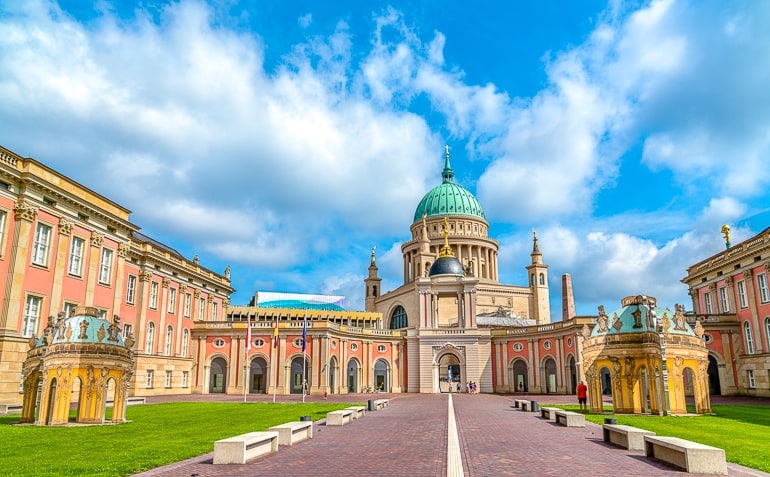
On your second day, you can choose between spending another day in Berlin to see more of the German capital or going on a day trip to Potsdam – which is a smaller city not far from Berlin.
Potsdam is actually the capital city of the German state called Brandenburg. It’s most popular attraction is probably Sanssouci Palace with the beautiful Sanssouci Park surrounding it.
During our visit, we also enjoyed walking through the Dutch Quarter with its small shops and cafes. Since the city isn’t too big, one day gives you a chance to get a good impression and check out some of the more popular sights.
It is also very easy to get to Potsdam from Berlin. If you decide to drive , it’ll take you approx. 40 minutes , but it could be longer – traffic depending. We would honestly recommend that you do this day trip by taking public transport. This way, you don’t have to worry about traffic and/or finding a parking spot.
For trains, you can take the S-Train #7 (S7) from Berlin Central Station (as well as other train stations) straight to Potsdam Central Station. The journey will take around 35 minutes with trains running very frequently throughout the day.
Must-see Attractions in Potsdam:
- Sanssouci Palace
- Dutch Quarter
- Cecilienhof
Day 3: Dresden
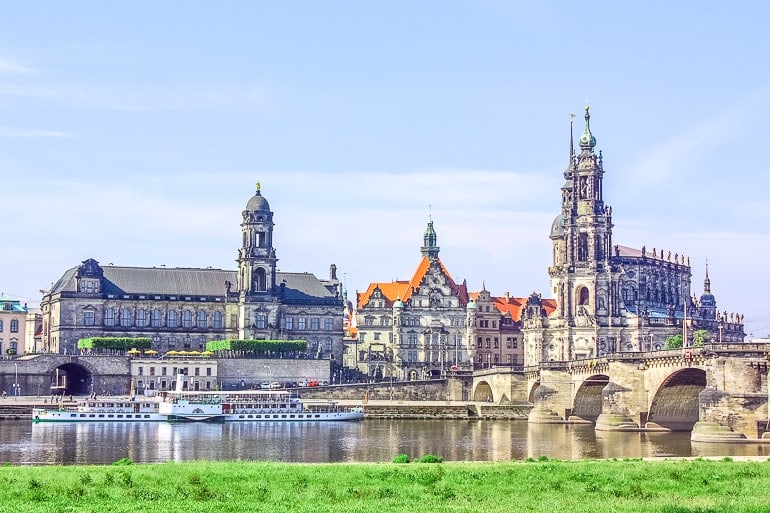
The third day of this Germany itinerary will take you from Berlin to Dresden which is a German city close to the Czech border. To be honest, we haven’t spend that much time in Dresden yet – and it’s certainly on our list of places to visit this year.
One of the city’s main attractions – the Zwinger – is known across the country and a sight that you shouldn’t miss during your visit. It’s a beautiful palace built in a baroque style.
Fun fact: When Lisa was a kid, she didn’t actually know that the “Zwinger” was a palace. Since that word can also mean “dog kennel” in German, she was always confused as to why people would want to visit it during their time in Dresden!
As for getting from Berlin to Dresden, the drive will take you around 2 hrs 10 minutes by car and around 2 – 3 hours by train. Once again, this depends on which connection you choose.
Accommodation in Dresden: There are a number of accommodations in the compact “Innere Altstadt” close to the River Elbe for you to choose from. You can check here for accommodations and hotels in Dresden .
For a great hotel option right in the old town, look no further than the Star Inn Hotel Premium Dresden im Haus Altmarkt . You’re a short walk to the train station, the river, and all the best old sights in Dresden if you stay here and arrive by train. If you come to Dresden by car, the hotel has discounted underground parking available.
Another option right in the old town (and even closer to the river) is Aparthotel am Schloss . Since this is an apartment-style hotel, it’s a great option if you are looking for more of a base to relax in a “home away from home”. It’s a very popular choice, too – and also has onsite parking.
Must-see Attractions in Dresden:
- Frauenkirche
Day 4: Erfurt
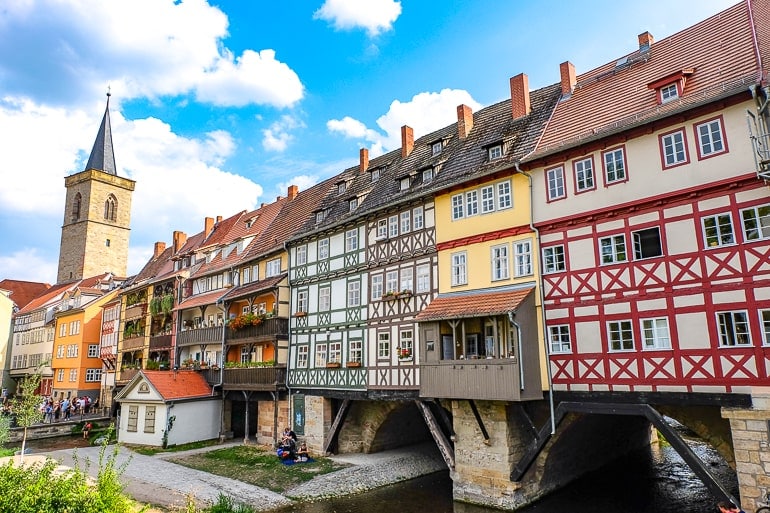
Erfurt is a popular city to visit in the middle of Germany – and it’s also the capital city of the German state Thuringia. We’ve spent some time in Erfurt a few months ago and instantly fell in love with the city. Its size is perfect (in our opinion) – giving you enough things to do without feeling overwhelming.
Maybe you’ve seen photos of one of the city’s most popular attractions, the Krämerbrücke. This bridge is not only pretty to look at and photograph, it’s also unique in the sense that there are buildings on the bridge and when you’re walking on it, you can’t actually see the water running below.
Visiting the bridge and climbing the tower of the Ägidienkirche, a church at one end of the bridge, is something we’d certainly recommend during your time in the city. We actually filmed a short video of our time exploring Erfurt. If you are interested in seeing what parts of the city look like, then you can find our video here .
Getting to Erfurt from Dresden won’t take you too long. It will take approx. 2 hours 20 minutes by car and between 2 and slightly over 3 hours by train .
Accommodation in Erfurt: Since Erfurt isn’t a huge city, there aren’t a ton of accommodations – but certainly more than enough to find one that works for your style and budget. You can check here for hotels and accommodations in Erfurt .
We stayed at Gästehaus in der Gotthardtstraße and really liked our stay. It’s located in a quiet neighbourhood just north of the city centre – a short walk to the Krämerbrücke. The host was lovely, the room was cozy, and there was secure onsite parking for those driving to Erfurt.
If you want to stay RIGHT in the city centre then you should check out Hotel Krämerbrücke Erfurt which is right beside the famous bridge. This might be a good place to stay if you are travelling to Erfurt by train and you’re on-foot.
Must-see Attractions in Erfurt:
- Krämerbrücke
- Erfurt Cathedral
- Citadel Petersberg
For more details, have a look at our Things to do in Erfurt article .
Day 5: Bamberg

Bamberg is a small city – or larger town – in the German state called Bavaria. It’s actually located in a region called Franconia, which is noticeably different from the Bavaria that you might know in the area surrounding Munich, etc.
We’ve been to Bamberg multiple times over the years (it’s also close to the part of Germany where Lisa grew up) and are always happy to come back. Bamberg is known for its cute, historic old town which is actually a declared UNESCO World Heritage Site.
One of the most popular buildings the city has to offer is the Old Town Hall (shown above) which is built on an artificial island. The story behind it is quite interesting.
The drive from Erfurt to Bamberg is doable and will take approx. 2 hrs by car and around 3 hrs by train . On the way, you’ll drive through quite a few tunnels since you’ll drive through an area known as “Thuringian Forest”.
Accommodation in Bamberg: Bamberg is a small place to visit so there aren’t a ton of options but still enough to find what you’re looking for. You can check here for accommodations and hotels in Bamberg .
Anywhere you stay is basically in or close to the old town/city centre. For a place to stay with parking (for those arriving by car), check out Welcome Hotel Residenzschloss Bamberg . It’s located right on the river.
You might also want to see Palais Schrottenberg to stay right in the middle of the Old Town! For reference, the train station is a short walk to the north of the river – not far from these places in the centre.
Must-see Attractions in Bamberg:
- Bamberg Cathedral
- Old Town Hall
- Alte Hofhaltung
If you want some more information about Bamberg, please read our detailed Bamberg, Germany Guide .
Day 6+7: Munich
From Bamberg, your journey will continue to Munich which will be the last stop on this 7 day eastern itinerary. Not only is this the third biggest city of the country, it is also one of the most internationally known destinations in Germany.
Whenever we come back to Munich, we always enjoy our time there. For some reason, the atmosphere always feels more laid back than in other big German cities and the people are usually quite friendly. We might also be a little bit biased, though, since Lisa grew up in this part of the country and is more used to the mentality, dialect etc. than in other parts of Germany.
For this itinerary, you’ll spend two days in Munich since there is quite a lot to see. Next to the obvious attractions like the Marienplatz with the New Town Hall and the Frauenkirche close by, there are also lots of museums and other things that you can explore.
If you’ve already been to Munich before and/or decide that one day in the city is enough for you, you could also opt for a day trip on one of these days. We’ve just recently written a whole Day Trips from Munich Guide , which you can browse through to get some inspiration!
Driving from Bamberg to Munich will take about 2 hrs 20 minutes by car and between 2 and 3 hrs by train . If you decide to only take regional trains instead of the ICE (fast train), you should look into getting the Bayernticket. This can save you some money, especially when you’re travelling with more people.
Accommodation in Munich: Since Munich is so large and popular to visit, there is definitely no shortage of places to stay! You can check here for accommodations and hotels in Munich .
That said, we loved our stay at H2 Hotel München Olympiapark . Located up by the famous Olympic Park, we’d highly recommend it since it was amazing value for money. The breakfast was huge and delicious and there’s a metro station outside the lobby door that takes you into the heart of the old town in minutes. There’s also parking if you are arriving by car.
For a hotel that is a little more central, you should see the Platzl Hotel Superior this hotel is really popular – and for good reason. It’s located around the corner from attractions like Marienplatz and the famous beer hall, Hofbräuhaus.
For more help looking into accommodations and neighbourhoods in Munich, check out our where to stay in Munich guide .
(Check out our guide to one day in Munich if you want more details on things to do and see.)
Germany Itinerary 10 Days
Although we have tried to create short itineraries that allow you to see more than just the standard cities, it is no doubt easier to see more of Germany if you are able to travel for longer than one week. To give you a couple different options that you could look at (and then potentially modify), we have created two 10-day Germany itineraries.
Once again, we believe that ten days would not be enough time to see the whole country – and even if you managed to do that it would be too stressful (in our opinion). Both of the following itineraries give you a good mix of bigger and smaller cities as well as a few interesting day trips. So, have a look and see which one you like better!
Germany Itinerary 10 Days – North
If you’re interested in seeing more of the northern part of Germany and experiencing the mentality and way of life of people in the flatter part of the country, closer to the sea, then have a look at the following 10-day itinerary!
The total driving time would be slightly less than 17 hours with a distance of approx. 1470 kilometres. For these calculations, we have included the day trips to Schloss Drachenburg, Lübeck, and Flensburg. So, if you decide to skip any of these, your driving time and distance would obviously be slightly lower.
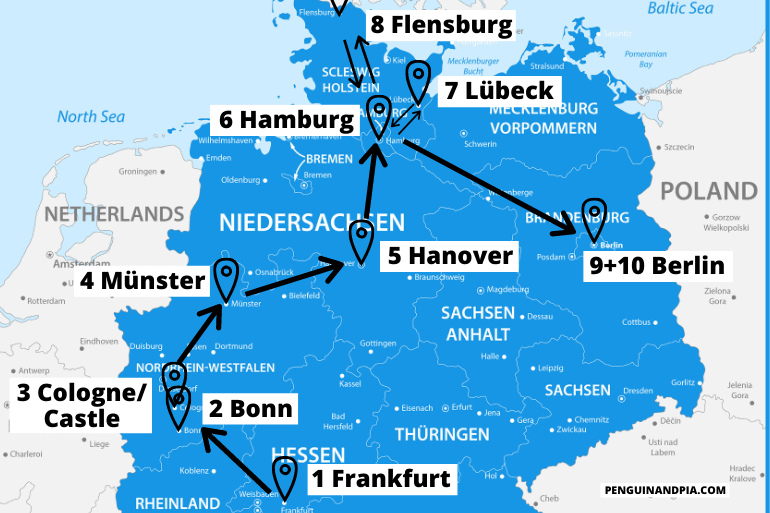
Day 1: Frankfurt Day 2: Bonn Day 3: Day Trip to Schloss Drachenburg / Cologne Day 4: Münster Day 5: Hanover Day 6: Hamburg Day 7: Day Trip to Lübeck Day 8: Day Trip to Flensburg Day 9+10: Berlin
Day 1: Frankfurt
Similar to some of the other itineraries mentioned in this article, we start this 10-day itinerary in Frankfurt. By now you should probably already know why – Frankfurt has the biggest airport of the country which should make it easier for people coming from overseas to get to Germany and start their adventure.
Furthermore, Frankfurt is quite centrally located so it is easy to get to many different cities from here. So even if you decide against following our itineraries step-by-step, Frankfurt would be a good starting point!
— Compare prices from rental car companies in Frankfurt here
Accommodation in Frankfurt : You’ll find plenty of places to stay in Frankfurt. You can check here for accommodations and hotels in Frankfurt .
One really popular hotel in Frankfurt is the Motel One Frankfurt-Römer . This Motel One is near the river and walking distance to lots of things in the city centre. If you are coming to Frankfurt with a car, Motel One has underground parking which can make life easy! They also have a nice breakfast.
A hotel option closer to the train station is Fleming’s Express Hotel Frankfurt . This hotel is just to the north of the main station which makes it a great option if you are arriving by train and have no car. It’s popular because it has a great breakfast and is good value for money.
Day 2: Bonn
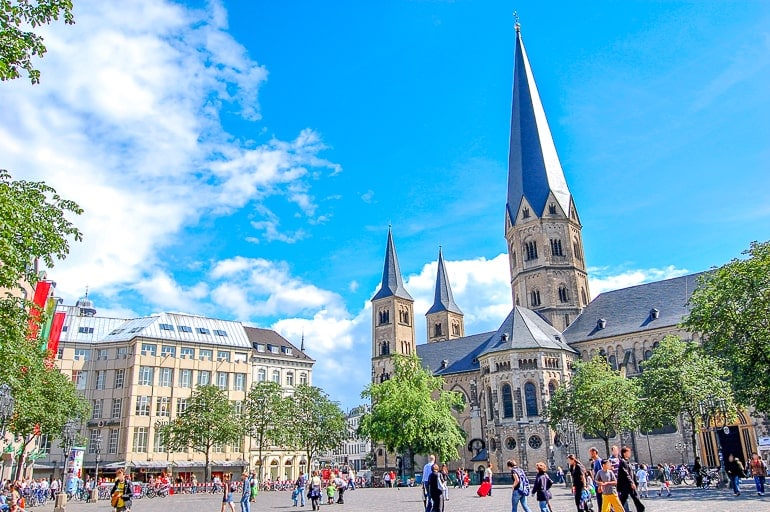
On the second day, you’ll head from Frankfurt to Bonn. As you might know, Bonn used to be the capital of the Federal Republic of Germany during the time that Germany was split into two countries. Later, the capital was relocated from Bonn to Berlin.
If you are interested in learning more about the history of Germany during your time in the country, then Bonn would be a good city to do that in. For example, you could visit the so-called “Haus der Geschichte” which is a museum about the history of the Federal Republic of Germany.
It won’t be difficult to get from Frankfurt to Bonn since the two cities are not too far apart. The journey will take approximately 1 hr 50 minutes by car and between 1 hr 20 minutes and 2 hrs if you take the train . Once again, we’d recommend that you book your train ticket in advance if possible.
Accommodation in Bonn: There are a number of accommodation options in Bonn which you can choose from – many are right in the city centre/old town. You can check here for accommodations and hotels in Bonn .
Keep in mind to book your accommodation for two nights for this itinerary. (You could also spend the following night in Cologne if you day tripped to there, though).
For a great hotel in the heart of the old town, check out BrauHotel Bonn . You can easily walk here from the central train station but they also have a and parking garage close by if you arrive by car. There’s also a craft beer bar on the ground floor!
Another option is the Hilton Bonn . This hotel offers you amazing views of the Rhine River. It’s a bit north of the city centre but still very much close to it. There is parking but it can be expensive so keep that in mind when you book.
Must-see Attractions in Bonn:
- Bonn Minster
- House of the History of the Federal Republic of Germany (Haus der Geschichte)
Day 3: Day Trip to Schloss Drachenburg / Cologne
On day three of this itinerary, you can choose to stay in Bonn, or go on one of two day trips: to Schloss Drachenburg (a castle not far from Bonn) or to Cologne which is also close by.
Schloss Drachenburg is actually a private villa/mansion that was built to look like a castle in the 19th century. Today, it is a popular attraction in the area.
From Bonn, you can either drive to Königswinter by car (and then leave your car at the car park) or take public transport to the Königswinter/Clemens-August-Straße station. You can find more information about that and opening hours etc. on the offical website .
If you are not a huge fan of castles, then you might opt for a day trip to Cologne instead. In this case, you might even decide to change your base and spend the night in Cologne instead of returning to Bonn at the end of the day. That is definitely an option that you can choose since there are lots of accommodation options in Cologne as well.
Getting to Cologne from Bonn will take you around 40 minutes by car (this can obviously depend on traffic) and only approx. 25 minutes by train . Just a quick warning: Trains can get very full if you are travelling during rush hour traffic – so try to avoid that if you don’t like being surrounded by lots of people in a small space.
Day 4: Münster
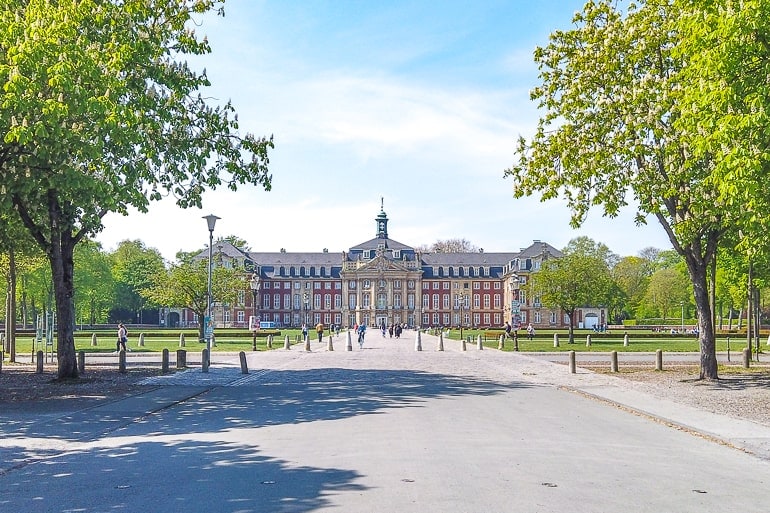
The next day you’ll head from Bonn – or Cologne – to Münster. Since Bonn and Cologne are so close, the journey wouldn’t really differ much from either city.
Münster is a smaller German city that we really enjoy. To be honest, it sometimes reminds Lisa of Copenhagen – mainly because of the many bikes that you can see all around the city. The University of Münster plays a big role in the city and the vibe – depending on which part of the city you are in – is noticeably younger.
One of the highlights of the city – for locals and visitors alike – is the lake Aasee which is located quite centrally. When the weather is nice, there are always people sitting on the grass enjoying the sun and maybe even out on the water (depending on the time of year). You can rent a small paddle boat to explore the lake from a unique perspective.
The journey from Bonn to Münster should take you slightly less than 2 hrs by car and between 2 hrs and slightly more than 3 hrs by train . If you want to save some money and are travelling with other people, then you should look into getting an “NRW Schönes Tag Ticket”. With this ticket, you wouldn’t be allowed to travel on ICE’s (the fast train), but the connections using only regional trains wouldn’t be much longer.
Accommodation in Münster: Münster might feel small but it’s actually pretty spread out and offers accommodations for all styles and budgets. You can check here for accommodations and hotels in Münster .
If you want a popular hotel option right in the centre, the H4 Hotel Münster is a short walk to the heart of the historic centre. It also has onsite parking for those travelling to Münster by car – but you can easily walk there from the train station in the south of the city centre.
Must-see Attractions in Münster:
- Münster Prinzipalmarkt
- Historic Town Hall
- Münster Cathedral
For a more detailed guide, have a look at our Things to do in Münster, Germany article .
Day 5: Hanover
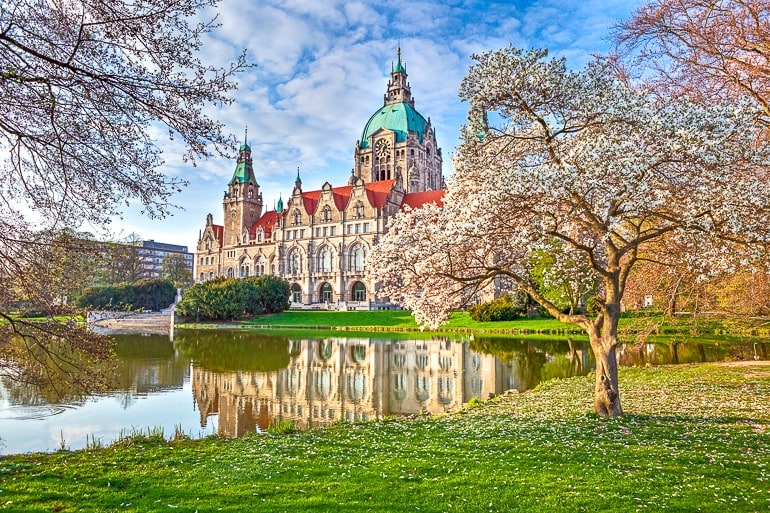
The following day you are travelling from Münster to Hanover. In German “Hannover” is actually written with two “n”, so don’t be surprised if you see it being written slightly differently.
Hanover is the biggest city and the capital of the German state called Lower Saxony. Compared to some other cities on this itinerary it is a less popular tourist destination. To be fair, even we haven’t spent that much time in Hanover yet. Hopefully we’ll be able to change that soon. However, that’s not to say that Hanover is not worth a visit.
Not only can you explore some beautiful gardens and interesting museums in the city, but it is also located pretty much halfway between Münster and Hamburg. That makes it a great stop to break up the journey and spent another day in a city that allows you to explore without too many other (international) tourists around.
By car , the journey from Münster to Hanover will take you around 2 hrs . If you choose to travel by train instead, it will take you approximately the same amount of time .
Accommodation in Hanover: Hanover is a larger city but the accommodation are still relatively packed together in and around the historic city centre. You can check here for accommodations and hotels in Hanover .
For a stay right in the city centre, check out the Hotel Loccumer Hof . This popular hotel is a very short walk from the central station which is perfect if you are arriving to Hanover by train. That said, they also have parking onsite so this hotel works well if you arrive by car!
For another hotel option, check out the Arthotel ANA Prestige am neuen Rathaus . This boutique hotel is directly across from the beautiful New Town Hall in the south end of the city centre by the greenspace and water! They also have a really nice breakfast and parking available.
Must-see Attractions in Hanover:
- New Town Hall
- Marktkirche
- Herrenhausen Gardens
Day 6: Hamburg
On day six of this 10-day itinerary you’re on your way to Hamburg. If you’ve read the details of any of the shorter itineraries in this article, you’ll know that we really like Hamburg.
The city offers modern areas, such as “HafenCity”, mixed with historic (e.g. “Speicherstadt”) and alternative areas (“Sternschanze”) . This makes exploring the city all the more interesting – there is truly something for everyone. During your time in the city, we’d also recommend that you climb the tower of the St. Michael’s Church. From up there, you get a beautiful view of most parts of the city.
The journey from Hanover to Hamburg won’t be long. Depending on the route you are taking (Highway A7 or A1), it’ll take between 1 hr 30 minutes and 2 hrs by car . If you opt for the train , you can expect the journey to take between 1 hr 15 minutes and 1 hr 30 minutes . This depends on the connection you choose.
Accommodation in Hamburg : Hamburg has many, many places to stay. You can check here for accommodations and hotels in Hamburg .
The Mövenpick Hotel Hamburg might be a good option if you have a car while you travel around Germany. This cool hotel is inside an old water tower which gives guests stunning views of the city around. There’s also parking onsite and it’s close to a transit stop for getting around the city.
Located not too far from the central train station, ARCOTEL Rubin Hamburg makes for a good hotel option if you don’t have a car. It’s located in St. Georg which is a lively area within walking distance of the city centre.
Those that need hostel for their stay in Hamburg might be happy with Generator Hamburg . It’s a popular hostel in the city and is close to the train station for easy getting around. If you’re unsure about where to stay, you can always check out our detailed guide on where to stay in Hamburg .
Once again, if you’d like to read our (very) short Hamburg guide, you can find our Things to do in Hamburg article here .
Day 7: Day Trip to Lübeck
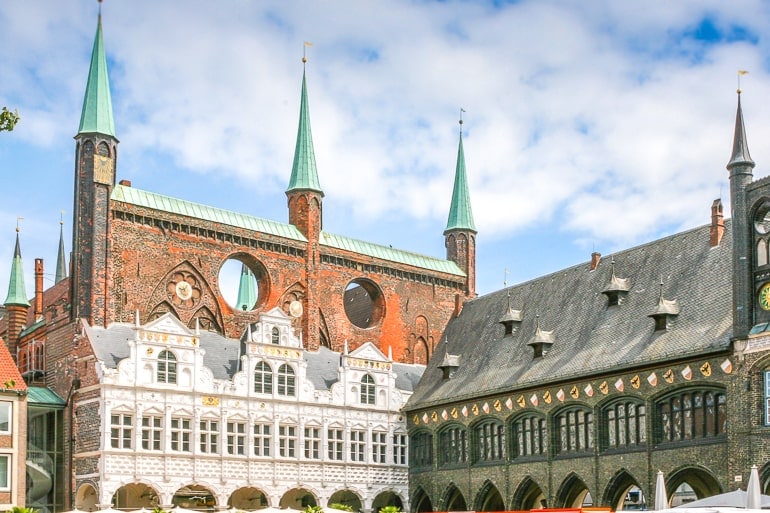
For the next couple of days, we decided to include some day trips from Hamburg. This allows you to stay in one accommodation for longer than just one night and gives you the option to see some more of Hamburg as well. If you don’t want to visit any other cities and want to spend more time in Hamburg instead, then feel free to skip one or both of the day trips mentioned.
Lübeck is the closer one of the two day trips mentioned from Hamburg. Within Germany the city is mainly known for its delicious “Lübecker Marzipan” (Lübeck Marzipan) – but of course there is much more to the city than just that. One of the highlights is the Holsentor, a red-brick city gate dating back to the 15th century.
The journey from Hamburg to Lübeck will take you slightly over 1 hr by car and just around 45 minutes by train . In our opinion, that’s great for a day trip since it gives you lots of time to actually see the city instead of spending a lot of time in the car/on the train.
Must-see Attractions in Lübeck:
- Marienkirche
- Heilig-Geist-Hospital
Day 8: Day Trip to Flensburg
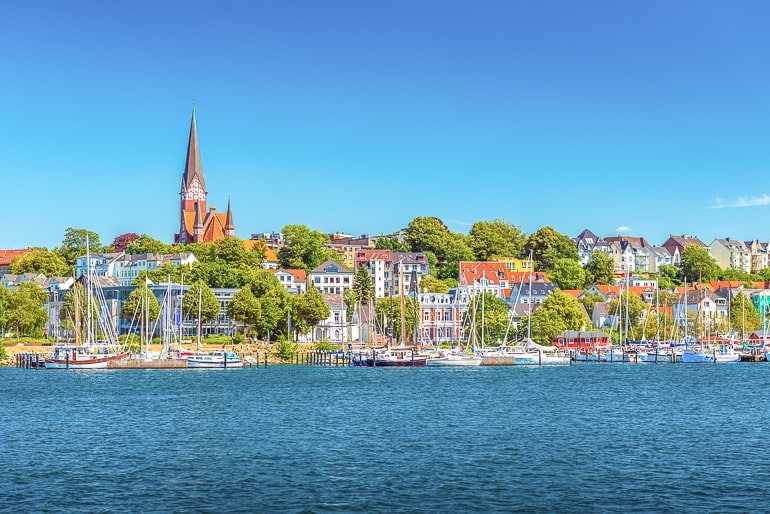
For the following day, we have another day trip option for you. The journey to Flensburg is slightly longer than to Lübeck – but it would be worth it. Flensburg is a smaller German city in the north of Germany, very close to the Danish border.
Since it is located close to the water, shipping plays an important role in the city to this day. If you’re interested in learning more about that, then the Maritime Museum would be a good place for you to visit.
Another thing we would recommend is a walk along the Rote Straße. Here you’ll find different “Hinterhöfe” (similar to backyards) with cute cafes and small shops.
Getting to Flensburg from Hamburg should take slightly less than 2 hrs by car and the same amount of time by train . As already mentioned, it would be a longer journey than to Lübeck, but if you want to experience a smaller, maritime city, the trip would be worth it!
Must-see Attractions in Flensburg:
- Historischer Hafen (Historic Harbour)
- Flensburger Schifffahrtmuseum (Maritime museum)
- Museumsberg Flensburg
Day 9+10: Berlin
On the second to last day of this itinerary, you’ll head from Hamburg to Berlin where your journey ends. This allows you to spend two days in the German capital. Since there is so much to do in Berlin, we’d recommend that you do some research beforehand to narrow down which attractions you’d like to visit.
If you’ve never been to Berlin before classics like the Brandeburg Gate and the Reichstag would be a good place to start. We’ve written a few different articles about Berlin – one about classic attractions (link below). Maybe these will be a good starting point to gather some more information!
The drive from Hamburg to Berlin will be one of the longest mentioned as part of this itinerary – so you should keep that in mind. It’ll take approximately 3 hrs 20 minutes by car (with traffic it could be longer), but just 1 hr 50 minutes by train .
It’s a popular train route since it connects the two biggest German cities so trains run frequently throughout the day. Once again, we’d recommend to book your train ticket in advance to get one of the discount tickets and save some money.
Accommodation in Berlin : As the capital city, there are lots of accommodation options for Berlin. You can check here for accommodations and hotels in Berlin .
Those travelling to Berlin with a car should look into the Park Plaza Wallstreet Berlin Mitte for a hotel in the city centre with free street parking available. There’s always paid parking for a reasonable fee if those are full and you’ll be close to top attractions.
The NH Collection Berlin Mitte am Checkpoint Charlie is a popular hotel option for those coming to Berlin by train since it’s close to attractions in the city centre and you can get there very easily with the metro.
Finally, if you need a hostel/hotel, check out PLUS Berlin . This is where Eric stayed a few years back and really enjoyed it. You’ll be close to the East Side Gallery – the part of the Berlin wall with the artwork on it. It’s also easy to get in and out of the city centre from here.
Also feel free to have a look at our guide on Berlin Attractions and tips for a day in Berlin .
Germany Itinerary 10 Days – South
This 10 day Germany itinerary begins and ends in Frankfurt – so it’s pretty much a small loop through the southern part of the country. If you want to be closer to the mountains (for part of the trip at least) instead of the sea, then this itinerary might be better suited for you than the other 10 day version.
For this itinerary, the total driving time would be slightly over 17 hours with a total distance of approx. 1330 kilometres. This includes the day trips to Neuschwanstein Castle, Garmisch-Partenkirchen, and Tübingen. So depending on if/how you modify the itinerary, these estimates could differ.
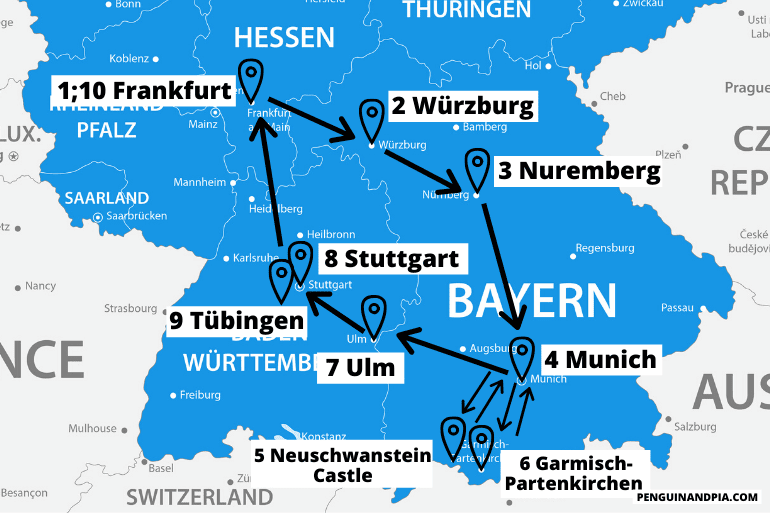
Day 1: Frankfurt Day 2: Würzburg Day 3: Nuremberg Day 4: Munich Day 5: Day Trip to Neuschwanstein Castle Day 6: Day Trip to Garmisch-Partenkirchen Day 7: Ulm Day 8: Stuttgart Day 9: Day Trip to Tübingen Day 10: Frankfurt
Similar to the northern version of this itinerary for 10 days, you begin your adventure in Frankfurt. During your day in the city, you shouldn’t forget to visit the Römerberg with the beautiful half-timbered houses. If you want to get a nice few of the city from above, then you should look into visiting the Main Tower as well.
Frankfurt is also a great place to pick up your rental car – if you decide to complete this itinerary by car instead of using public transport. You can either pick up a car at the airport or at different spots in the city centre. This obviously also depends on the rental company you choose.
Accommodation in Frankfurt: Frankfurt is full of accommodation options – from the city centre to the airport. You can check here for accommodations and hotels in Frankfurt .
For a hotel in the heart of the city, check out the Motel One Frankfurt-Römer . Complete with underground parking, good breakfast, and a top location in the centre and close to the river, this hotel is a decent option if you are travelling around with a car.
For those not travelling with a car (and taking the trains around Germany), check out Fleming’s Express Hotel Frankfurt . This nice looking hotel is really popular for its breakfast, price, and the fact that it’s steps from the central train station.
Day 2: Würzburg
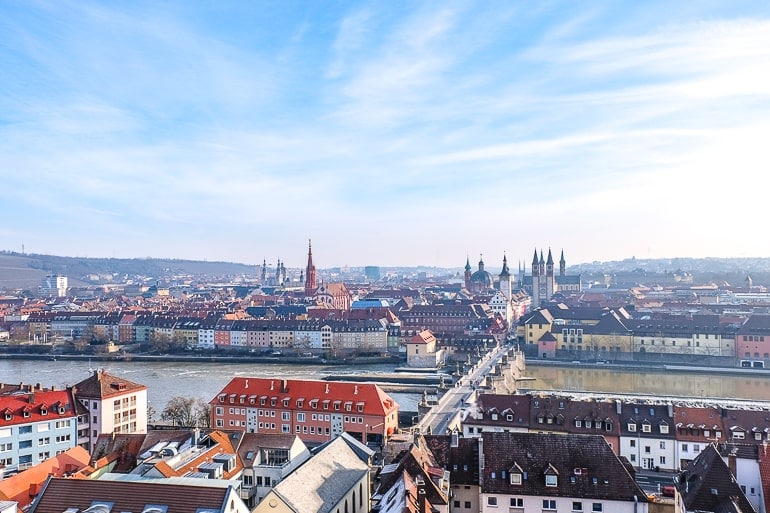
On day two of this itinerary, you’ll be on your way to Würzburg, a small German city that we’re always happy to return to. Similar to Stuttgart, Würzburg is located in a region that is known for its wine.
As such, it comes as no surprise that a highlight in Würzburg is to drink a glass of (white) wine on the Old Bridge across the Main river. We’ve done that multiple times and would especially recommend it during the evening when it gets dark.
Another thing you shouldn’t miss in Würzburg is the short walk up the hill to Marienberg Fortress. Up there you can not only explore the old fortress, but you also get a beautiful view of the old town and other parts of the city.
We actually wrote a whole guide about Würzburg (link below) where we not only talk about things to do but also mention some great cafes and restaurants!
The drive from Frankfurt to Würzburg will be a short one. It should only take you around 1 h 20 minutes by car and between 1 h 07 minutes and 1 hr 50 minutes by train depending on the type of train you’re taking (ICE vs. regional train).
Accommodation in Würzburg: Würzburg isn’t a huge city so you’ll find a number of places to stay packed together in the city centre and a number of other hotels and guesthouses around. You can check here for accommodations and hotels in Würzburg .
On a recent trip, we stayed at the Best Western Hotel Würzburg-Süd . It’s a little south of the city centre but the tram stop is right outside the hotel so you’re into the historic city centre in minutes. There is also an onsite parking lot if you’re arriving to Würzburg by car. We booked this one last minute but we would stay again.
If you want to stay a little more central, then you can check out Hotel Strauss . With a location close to the river, the train station, and the city centre – it’s a great option fo those arriving by train.
We also once stayed at Hostel Babelfish for a budget accommodation and it was honestly not too bad, either. It’s right across from the train station for easy access in and out of the city.
Must-see Attractions in Würzburg:
- Marienberg Fortress
- Würzburg Residence
If you want more tips for visiting Würzburg, have a look at our detailed Things to do in Würzburg Guide (+ insider tips) .
The next day you’ll be on your way to Nuremberg, which is another city in Bavaria that we really like. In German, Nuremberg is actually written/called “Nürnberg” – just an FYI, so you’re not confused when you see this written somewhere.
As we have already mentioned in the description of one of the shorter itineraries, there is a lot of history to be found in the city. Not only can you explore an old castle in the middle of the city, you can also learn a lot about Germany’s dark history if you’re interested.
Getting from Würzburg to Nuremberg will take approx. 1 hr 20 minutes by car and between 53 minutes (ICE) and 1 hr 13 minutes (regional) by train . If you’re travelling with more people and decide to just take a regional train, look into getting a “Bayernticket” as that could save you some money.
Accommodation in Nuremberg : Nuremberg is a larger and well-travelled city in Germany so you will have no problem finding a place to stay! You can check here for accommodations and hotels in Nuremberg .
We ended up staying in the very popular Five Reasons Hotel and Hostel and we enjoyed our stay. The room was bright with new furnishings. It’s also located just inside the old city walls so we were close to the metro, a short walk to central train station, and also close to the heart of the old town!
Very nearby was the Sheraton Carlton Nuremberg – we had friends stay there. They really liked this hotel which had a swimming pool with city views and other great perks. If you are arriving to Nuremberg by car, there’s a parking lot across the street from the hotel as well as street parking around. The train station is very close as well so it’s a great location overall.
- Documentation Center Nazi Party Rally Grounds
Day 4: Munich
On day four of this Germany trip, you’ll be on your way to Munich. As you might know Munich is the capital of the German state called Bavaria and there are lots of things to do in this city.
That’s why you’ll spend three nights in Munich. This way you can explore the city in more detail if you want or go on a couple of day trips from Munich to see other popular attractions as well. It’s really up to you.
The journey from Nuremberg to Munich won’t be overly long and it’s a route Lisa has driven many times. It’ll take you around 2 hrs by car (of course traffic depending) and between 1-3 hrs by train.
Since this is a popular train route, there are lots of different connections of varying length – some are quick and others are slower trains with more stops. Since that’s the case, we’d recommend that you plan in advance and try to catch a better connection to avoid an unnecessarily long train ride!
Accommodation in Munich: Since Munich is such a popular and large city, there are plenty of accommodation options for you to choose from. You can check here for accommodations and hotels in Munich . Just remember to book your accommodation for three nights if you are following this itinerary!
We stayed at the H2 Hotel München Olympiapark which is a very popular hotel because of the price and the value. It was a prefect stay. The breakfast was amazing, they had parking, and the location was great – only a quick metro to the heart of the city centre. You also have the Olympic Park and BMW Museum as top attractions nearby!
If you’re itching to stay right in the heart of the action in Munich, check out the Platzl Hotel Superior . This is a hotel around the corner from Marienplatz in the old town with the famous beer hall Hofbräuhaus just steps away. The central train station is also walkable from here.
Of course, you can learn all about the best areas to stay in more detail with our Munich accommodation and neighbourhood guide .
Learn more about Munich with our one day in Munich post!
Day 5: Day Trip to Neuschwanstein Castle
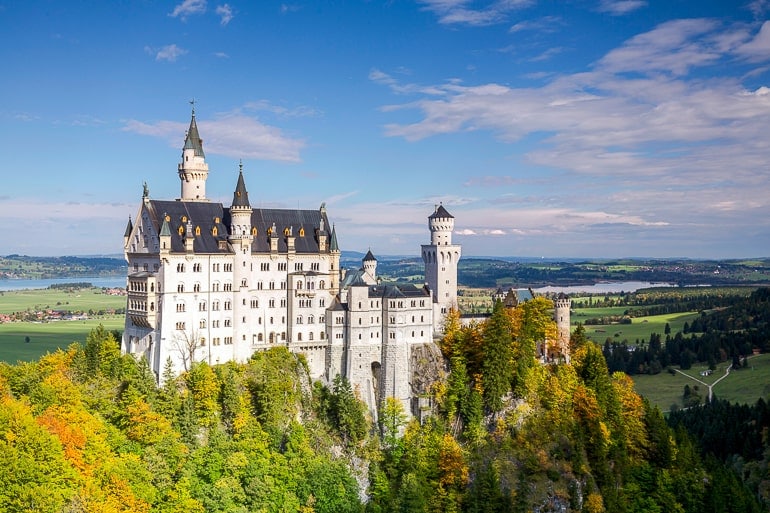
Neuschwanstein Castle probably doesn’t need a lot of introduction – it is arguably one of the most popular day trips from Munich. If you want to see this fairy-tale castle with your own eyes, then this day trip might be for you.
However, it is such a popular attraction that depending on the time of year it can get incredibly crowded. So if you are planning this itinerary for the middle of summer, we’d honestly recommend that you think twice about whether you really want to do this day trip. A second day in Munich wouldn’t be so bad either, would it?
If you are set on visiting Neuschwanstein Castle, then have a look at our Day Trips from Munich Guide . In that article – under the Neuschwanstein Castle section – we talk about all the different ways you can get to the castle.
In case you don’t want to stress too much about logistics and are not travelling with a rental car, you could always look into a day tour that brings you to Neuschwanstein Castle and then back to Munich. Here are some examples:
- Neuschwanstein and Linderhof Palace – A very popular tour to check out two castles in one day!
- Just Neuschwanstein Castle – Grab your live guide and check out the classic castle you came to see!
- Neuschwanstein Castle and Füssen – Explore the surrounding area on this day trip + see that great castle!
Day 6: Day Trip to Garmisch-Partenkirchen
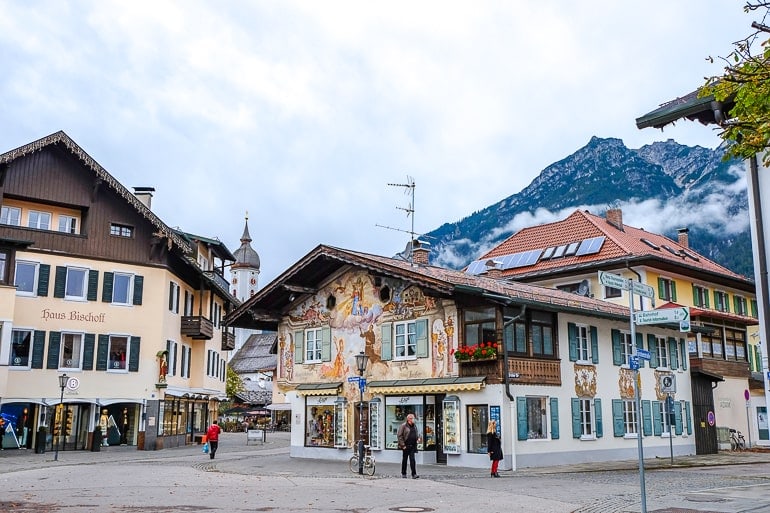
Another popular day trip from Munich – and the one we would recommend for Day 6 of this itinerary – is a trip to Garmisch-Partenkirchen in the south of Bavaria, close to the Austrian border.
We have been to Garmisch-Partenkirchen recently and really enjoyed our day there. However, that was during the shoulder season, so we can’t really say much about how busy it gets in the summer or during the ski-season.
There are a few good reasons for visiting Garmisch-Partenkirchen. The obvious one is that the town is super close to the mountains and it is very easy to reach the “Zugspitze” (Germany’s highest mountain) from here.
Of course, you don’t have to go that high up – there are also lots of other mountains and great hiking trails in the area if you’re looking for a day in nature.
Other reasons why people come to Garmisch-Partenkirchen is to visit the Partnach Gorge which is quite beautiful and/or the old town where you can admire the decorative paintings found on many houses.
It’s actually quite easy to get from Munich to Garmisch-Partenkirchen. By car , it should take you around 1 hr 10 minutes and by train the journey would be approx. 1 hr 22 minutes . It’s actually a nice drive/train ride since you’ll get some great views of the mountains as you get closer to your destination.
Must-see Attractions in/close to Garmisch-Partenkirchen:
- Partnach Gorge
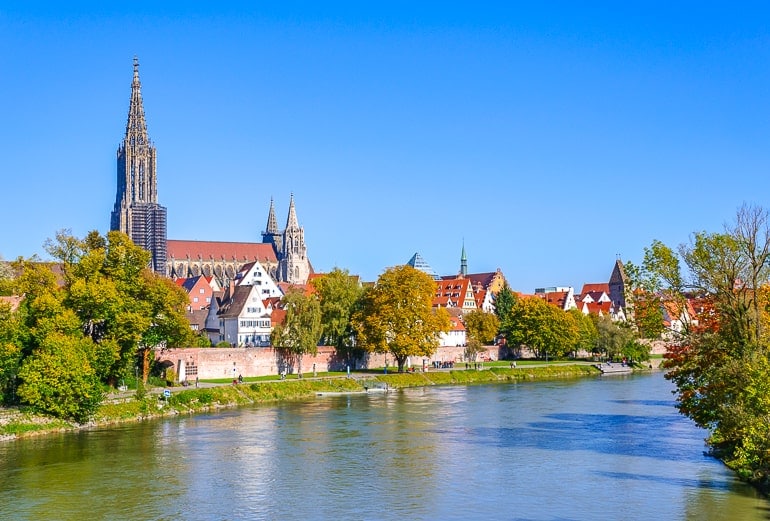
The following day you’ll travel from Munich to Ulm, a small city in the German state of Baden-Württemberg. It is actually located right by the border with Bavaria – “Neu Ulm” in fact is a city on the Bavarian side. When you’re there, it sometimes feels like it is just one bigger city. For you as a visitor, this doesn’t really matter – just an interesting side note.
Ulm is mainly known for having the church with the tallest steeple in the world – so that is something you shouldn’t miss during your visit. Other than that, we’d also recommend that you check out the Fishermen’s Quarter where you can find some beautiful, half-timbered houses.
Getting from Munich to Ulm won’t take you long. The journey will take approx. 1 hr 40 minutes by car and between 1 hr 19 minutes and 2 hrs by train. Once again, this depends on which type of train connection you choose (ICE vs. regional trains).
Accommodation in Ulm: It’s best to stay in the centre of Ulm since it’s not huge and the attractions can mostly be found there. You can check here for accommodations and hotels in Ulm .
For a boutique hotel option right in the city centre, check out Boutique 005 Ulm City . This hotel is super walkable to the train station if you are arriving by train but also offers an option for parking. It’s location makes it really close to all the top attractions in the city.
For a stay closer to the river, you can check out the Hotel am Rathaus – Hotel Reblaus . With onsite parking available and a really good breakfast, this more “authentic” hotel is an experience not to be missed in Ulm.
Must-see Attractions in Ulm:
- Ulmer Münster
- Fishermen’s Quarter
Day 8: Stuttgart
From Ulm, you’ll head to Stuttgart on the next day. Stuttgart is a city that we have mentioned a few times in this article already. If you’ve read some of the other itineraries, you’ll know that Stuttgart is known for both cars and wine.
Of course, there’s more to see in the city than that. If you’re interested in architecture, you might enjoy visiting the New Palace at the “Schlossplatz” and if you’re into art, the Staatsgalerie (an art museum) might be for you.
Getting to Stuttgart from Ulm will only take slightly over 1 hr by car and approx. the same amount of time by train . There are slower trains – called RB instead of RE which stands for “Regional Express” – that take longer than that. However, if you plan ahead, you shouldn’t have a problem catching an RE or ICE Train since they run frequently throughout the day.
Accommodation in Stuttgart: Since there are a number of places to stay in, you can check here for accommodations and hotels in Stuttgart .
Those with a car can check out the Abalon Hotel ideal because it has an underground parking garage while those travelling to Stuttgart by train can check out the Pension am Heusteig since it’s easy to get to walking or with the metro.
Day 9: Day Trip to Tübingen
On day 9 of this itinerary, you have the choice between either spending a second day in Stuttgart or taking a day trip to Tübingen, a university town not far away.
Tübingen is a popular day trip from Stuttgart and is mainly known across the country for its old university. In fact, some of Lisa’s friends have studied there. When in town, you shouldn’t forget to visit the market square with its 15th century town hall. Another popular attractions is the Hohentübingen Castle on the hill which nowadays is home to a museum.
It won’t take you long at all to get to Tübingen from Stuttgart. That makes it great for a (half-)day trip. The journey should only take around 42 minutes by car and between 43 minutes and 1 hr 30 minutes by public transport – depending on the connection you choose.
Must-see Attractions in Tübingen:
- Hohentübingen Castle
- Market Square with Town Hall
- Hölderlinturm
Day 10: Frankfurt
On the last day, you’ll make your way back to Frankfurt. This is where your itinerary ends since it will hopefully be easy for you to get back home from here.
The journey from Stuttgart back to Frankfurt will probably be the longest one for this trip – but it’s still easily doable. It should take you approx. 2 hrs 25 minutes by car and between 1 hr 17 minutes and 3 hrs 30 minutes by train. Once again, this is dependent on the connection you choose (ICE vs. regional trains).
Accommodation in Frankfurt: Since you’re back in Frankfurt, we already went over accommodations in Day 1 of this same itinerary. That said, you can check here for accommodations and hotels in Frankfurt and specifically check out the Motel One Frankfurt-Römer for a central hotel with parking.
Germany Itinerary 14 Days
This Germany itinerary is the longest one that we have for you – for now. If anyone is interested in a 21 day version, please let us know!
The distance you’d cover with this 14 day itinerary would be around 1960 kilometres . The driving time would be approx. 22.5 hours – but of course, this varies depending on traffic and the exact route you decide to take.
As you’ll see below, sometimes the driving time between two cities is longer than 3 hours. So, while this itinerary is totally doable in two weeks – if you wanted to slow down the pace a bit, you could just as easily spend more time in some of the cities and complete the itinerary in more days.
Since you have probably already read about most of these places in some of the itineraries above, we’ll try to keep the descriptions short and not get too repetitive.
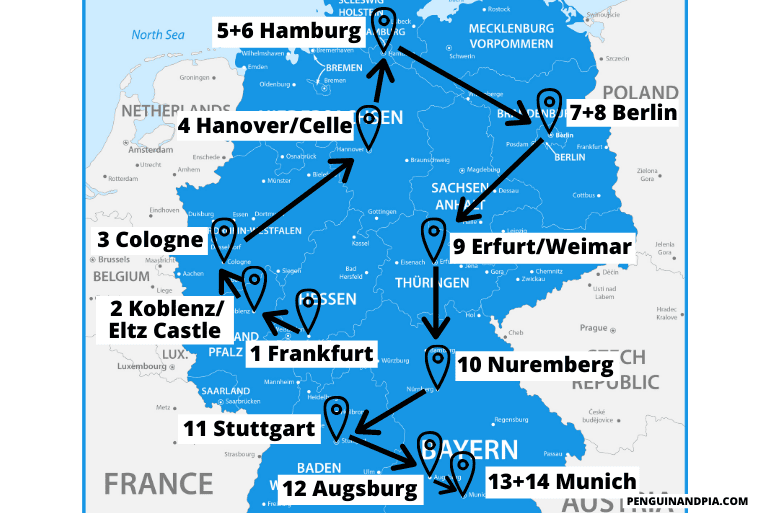
Our version here is written as an “incomplete route” from Frankfurt to Munich. However, as with most of our itineraries, you are welcome to reverse the direction if that works better for you and/or start and end in the same city. So, to see a big part of the country, your 14 day Germany itinerary could look something like this:
Day 1: Frankfurt Day 2: Koblenz / Eltz Castle Day 3: Cologne Day 4: Hanover or Celle Day 5+6: Hamburg Day 7+8: Berlin Day 9: Erfurt or Weimar Day 10: Nuremberg Day 11: Stuttgart Day 12: Augsburg Day 13+14: Munich
Once again we begin this itinerary in Frankfurt since it is an easy city to get to. As we have mentioned before, there are a few things to see in the city so you can start exploring on day one!
Frankfurt is also a great city to pick up a rental car. Since many international (business) travellers fly into Frankfurt, there should be many cars available with automatic transmissions. In smaller German towns you’ll find that this is not always the case.
Accommodation in Frankfurt: If you are making a stop in Frankfurt, you can check here for accommodations and hotels in Frankfurt .
As for accommodation options, the Motel One Frankfurt-Römer has parking available and is located in the city centre close to the Main River. That’s important if you have a car with you but it’s also walkable to the train station, so you know.
Another great hotel option that is even closer to the train station is Fleming’s Express Hotel Frankfurt . This hotel is known for its prime location to the north of the station, its tasty breakfast, nice decor, and fair price. This is definitely a popular place you should at least look into if you are travelling by train around Germany.
Day 2: Koblenz / Eltz Castle
On day two of this itinerary, you’ll be on your way to Koblenz, a small German city on the Rhine river. You can either explore the city or use it as a base to visit one of the many castles close by.
Our suggestion would be a visit to Eltz Castle which is a beautiful medieval castle surrounded by a forest. Please keep in mind that the castle is not open year round. You can check opening hours here .
You could also visit Eltz Castle as a day trip from Frankfurt but then you’d have to return to Frankfurt at the end of the day. This wouldn’t make much sense unless you want to spend some more time in Frankfurt anyway, as Cologne (your next destination) is closer to Koblenz and Eltz Castle than Frankfurt.
The drive from Frankfurt to Koblenz should take around 1 hr 30 minutes by car . If you want to take the train , the journey would take between 1 hr 30 minutes and 2 hrs 15 minutes . From Koblenz, it is only about a 30 minute drive to Eltz Castle.
Accommodation in Koblenz: Since Koblenz isn’t that large, you should have no problem finding and choosing an accommodation that works for you. You can check here for accommodations and hotels in Koblenz .
If you want a popular option right in the heart of the city centre, you should see the Sander Hotel . This hotel is located within walking distance to the rivers as well as restaurants and shops in the centre. If you travel by car to Koblenz, they have onsite parking which is handy. That said, you can also easily walk from the hotel to the train station in minutes.
Day 3: Cologne
The next stop on your 14 day Germany itinerary is Cologne, a city we have mentioned already in some of the previous itineraries. As you might know, the highlight of the city is the Cologne cathedral which is quite an impressive sight. As the city is located on the Rhine river, a boat tour might also be a great activity depending on the time of year you are visiting.
Getting to Cologne from Koblenz takes around 1 hr 15 minutes by car and between 50 minutes and 1 hr 15 minutes by train . The train tracks follow the Rhine river for part of the journey which allows for some beautiful views!
Accommodation in Cologne : There are lots of great places to stay in Cologne. You can check here for accommodations and hotels in Cologne .
We recently stayed at the Lindner Hotel City Plaza which was great value for money. The breakfast buffet is incredible and it’s an easy, short walk into the city centre near the Cathedral. It also has parking available for those with a car.
If you want to stay a little closer to the river and the Old Town, check out the CityClass Hotel Residence am Dom . With many things around to keep you busy – like attractions, food, and/or drinks – you’re just a short walk to the central train station if you stay here.
For those looking for a hostel, Cologne Downtown Hostel was a great stay for Eric a number of years ago. It’s really popular, in a great location, and has a nice rooftop balcony to enjoy.
Day 4: Hanover or Celle
Day 4 of this itinerary will take you to either Hanover or Celle depending on your preference. Celle is a noticeably smaller city/town than Hanover and the two places are only a few minutes apart.
Getting from Cologne to Hanover will take approximately 3 hrs 10 minutes by car and between 2 hrs 40 minutes and 3 hrs 5 minutes by train .
Accommodation in Hanover: Since Hanover is a well-travelled city for people moving around Germany, there are a number of accommodation options in and around the city centre. You can check here for accommodations and hotels in Hanover .
To stay very close to the central train station in the city centre, you should see the Hotel Loccumer Hof . The location makes it great if you are travelling by train and on foot. They also have onsite parking if you are arriving to Hanover with a car!
To the south of this hotel, the Arthotel ANA Prestige am neuen Rathaus is an option right across from the New Town Hall. This hotel has a beautiful, light style and is also close to the water/parks. Complete with breakfast and onsite parking, you can’t go wrong here!
If you want to spend a night in a smaller German city instead, then Celle is a good option as it is not far from Hanover. That will make it easy to reach the next stop on your itinerary without too much of a detour. The journey from Cologne to Celle would be slightly longer and take around 3 hrs 30 minutes by car and 3 hrs 19 minutes by train .
Accommodation in Celle: Celle isn’t that big at all – so there are only a handful of places to stay. That said, there are still some great options. You can check here for accommodations and hotels in Celle .
Of note, check out Hotel Borchers . This hotel – one of only a handful located in the heart of “city centre” is a top pick with a tasty breakfast and an underground car park. You can also walk there from the Celle train station which is located not too far across town.
Must-see Attractions in Celle:
- Celle Castle
- Bomann Museum
- French Garden
Day 5+6: Hamburg
An itinerary across a large part of the country wouldn’t really feel complete without including Hamburg. Since there is quite a bit to see in this hanseatic city, you’ll spend two nights in the city to give you more time to explore.
Getting from Hanover to Hamburg will take you approx. 1 hr 45 minutes by car and between 1 hr 15 minutes and 2 hrs 30 minutes by train . As mentioned before, this varies depending on the type of train connection you choose.
The journey from Celle to Hamburg will be approximately 15 minutes shorter at 1 hr 30 minutes by car . If you opt for the train, you can expect travel times between 1 hr 10 minutes and 2 hrs .
Accommodation in Hamburg : Since Hamburg is a well-travelled city, it makes sense that there are loads of places and areas to stay in. You can check here for accommodations and hotels in Hamburg .
The Mövenpick Hotel Hamburg might work for those with a car since they have onsite parking. This old water tower is a different hotel than you might be used to but it’s a great experience overall.
Something closer to the central station to get to on foot would be the ARCOTEL Rubin Hamburg which is located in St. Georg. This is an area with shops and restaurants and is very much part of the city centre.
Those looking for a budget accommodation can check out Generator Hamburg which is a popular hostel close to the train station. If you’re ever unsure or want more advice, we have a detailed guide on where to stay in Hamburg .
Day 7+8: Berlin
Of course, we couldn’t forget to include a stop in the capital of the country when planning a longer trip through Germany. Since there is so much to do and see in Berlin you will spend two nights there.
This will also give you some more time to recover from all the driving you have done so far on this journey. Getting from Hamburg to Berlin takes approximately 3 hrs 20 minutes by car (obviously traffic depending) and just about 1 hr 50 minutes by train .
Accommodation in Berlin : There are lots of hotel options in Berlin. You can check here for accommodations and hotels in Berlin .
The Park Plaza Wallstreet Berlin Mitte is a good option in the city centre for those coming to Berlin with a car while the NH Collection Berlin Mitte am Checkpoint Charlie is located right at the attraction “Checkpoint Charlie” in the city centre.
A great option for a hostel/hotel where Eric stayed a few years back is PLUS Berlin . You can find it near the famous East Side Gallery which is a very popular attraction to check out.
As mentioned a few times now, we also have more articles on t hings to see in Berlin and a one day Berlin itinerary .
Day 9: Erfurt or Weimar
For the following day you have the choice between Erfurt or Weimar as your next destination. Both are small cities in the state of Thuringia with Weimar being smaller than Erfurt. If you know anything about Martin Luther, an important figure in the Protestant reformation, then you might have heard of one or both of these places before.
If you’re looking for a place with a beautiful old town and some nice churches as well as buildings for you to explore, then we’d really recommend Erfurt. We had a great time during the days we spent there. The city also has some really nice, cozy cafes if that is something that you care about.
Getting to Erfurt from Berlin will take a while – but it is a great stop on the way to the south of Germany. You can expect the journey to take approx. 3 hrs 40 minutes by car and just around 1 hr 50 minutes by ICE (fast train) .
Accommodation in Erfurt: With Erfurt being a smaller city with a smaller central area to explore, finding a place to stay isn’t too difficult. You can check here for hotels and accommodations in Erfurt .
When we visited Erfurt, we booked the Gästehaus in der Gotthardtstraße . This was a simple guesthouse with a nice host and cozy rooms located just a short walk north of the Krämerbrücke. There’s also a small parking lot onsite if you’re coming to Erfurt with a car.
For a stay that is more central, check out Hotel Krämerbrücke Erfurt . It’s located basically right beside the Krämerbrücke making it a great option if you are travelling by train and you’re on foot.
Once again, if you want to learn some more about Erfurt before you visit the city, check out our detailed Erfurt Guide here .
If you instead preferred to learn some more about the well-known German writers Goethe and Schiller – or about Germany’s dark past – then you should plan to visit Weimar instead.
Two of the highlights there are Goethe’s and Schiller’s House – now turned into museums. Close to Weimar there’s also the Buchenwald Memorial which was a former Nazi concentration camp. This was the first KZ-Memorial Lisa ever visited. It was a somber experience, but also an important one in regards to understanding more about Germany’s past.
The journey from Berlin to Weimar will be slightly shorter than to Erfurt – at least by car. It’ll take approx. 3 hrs 15 minutes by car and around 2 hrs 20 minutes by train .
Accommodation in Weimar : There are a handful of places to stay in Weimar since it’s a smaller city – but you still have good options. You can check here for accommodations in Weimar .
In particular, check out Amalienhof Hotel und Apartment . This classic and very popular hotel is just south of the heart of the city centre. It features parking onsite and an excellent breakfast. It’s also not too far to walk to the train station if you are arriving on foot.
Must-see Attractions in/close to Weimar:
- Buchenwald Memorial
- Goethe’s House
- Schiller’s House
Day 10: Nuremberg
On day 10 of your itinerary, you’ll drive – or take the train – from Erfurt/Weimar to Nuremberg. This Franconian city has also been mentioned in some of the shorter itineraries.
The journey from Erfurt to Nuremberg will take approx. 2 hrs 40 minutes by car in a southern direction. The drive from Weimar to Nuremberg will just be a couple minutes longer.
If you decide to take the train, the journey would take between 1.5 hrs and 2 hrs from Weimar and between 1 hr 10 minutes and 1 hr 30 minutes from Erfurt .
Accommodation in Nuremberg : Nuremberg is a city with loads of history and attractions so it’s very popular. As such, you will find hotels and accommodations all over the city – from the old town to the surrounding areas. You can check here for accommodations and hotels in Nuremberg .
We booked a stay at Five Reasons Hotel and Hostel and we would recommend it. You can find the place inside the massive old city walls so the location was great – walkable to the central train station and also to go find top attractions.
On the same trip, friends of our stayed at the Sheraton Carlton Nuremberg . It was close to where we stayed and they really enjoyed it. There’s this great pool on an upper floor with city views as well as a parking lot across the street if you travel to Nuremberg by car. The train station is close as is the old town by walking so it’s great option overall, too.
Day 11: Stuttgart
The following day you will be on your way from Nuremberg to Stuttgart – once again, a city we have mentioned multiple times now during this article. From Nuremberg, it’ll take you around 2 hrs 15 minutes by car and between 2 hrs 10 minutes and 2 hrs 30 minutes by train to get to Stuttgart.
As we’ve mentioned before, if you are driving and have the time, you could take a small detour and stop in Rothenburg ob der Tauber for a stroll through its beautiful old town. We’ll leave that up to you!
Accommodation in Stuttgart: You can check here for accommodations and hotels in Stuttgart .
The Abalon Hotel ideal has parking for those with a car while the Pension am Heusteig is a guesthouse close by but is easy to get to by the metro system if you arrive by train to central station and you are walking.
Day 12: Augsburg
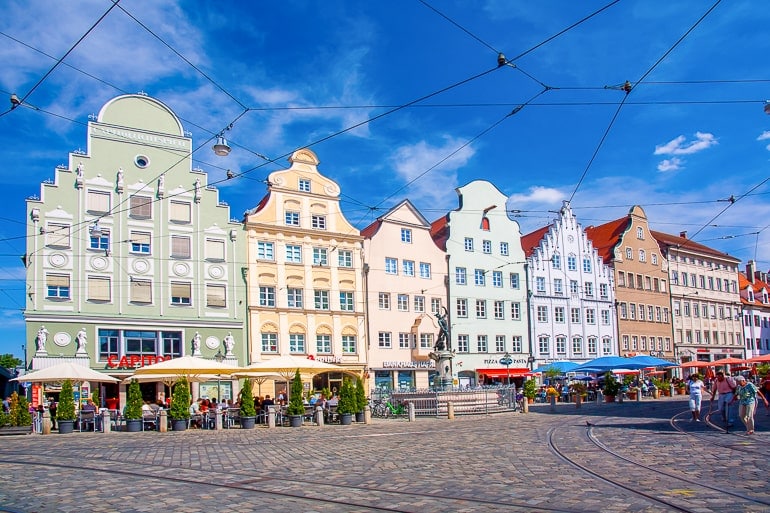
On day 12 you’ll be on your way from Stuttgart to Augsburg, a small city in Bavaria and one of Germany’s oldest cities. Around Germany, most people have heard of Augsburg because of its “Fuggerei” – a historic social housing complex where rent has increased very slowly over the centuries. It’s certainly worth a visit!
It’ll take you around 2 hrs by car to get from Stuttgart to Augsburg. If you opt for the train , then you can expect the journey to take approx. 1 hr 40 minutes .
Accommodation in Augsburg: In Augsburg, you will find a number of places to stay around the city centre. You can check here for accommodations and hotels in Augsburg .
For a reliable stay, check out Hotel Augusta . This popular hotel – located right in the city centre – features breakfast and has parking available if you are travelling to Augsburg by car.
The nice thing about Augsburg is that because it’s a smaller city, you can easily walk to the hotel from the train station if you are arriving by train.
You might also check out City Hotel Ost am Kö which is another hotel in the heart of the centre walkable to the station. It also has breakfast and parking garage right nearby.
Must-see Attractions in Augsburg:
- Augsburg Cathedral
- Perlach Tower
Day 13+14: Munich
On your second to last day of this itinerary you will drive from Augsburg to Munich. That’s the last stop on your two week Germany adventure. In Munich, there is more than enough to see to spend two days in the city.
Munich also has an airport with good international connections in case you’re coming from overseas and need to take a plane to get back home. If that’s not the case, we’d encourage you to see whether the train would be an alternative to get you back home as well.
The journey from Augsburg to Munich should take just less than 1 hr by car and between 30 and 48 minutes by train. So it’s certainly one of the shortest transitions mentioned in this article.
Accommodation in Munich: If you’re exploring Munich while in Germany, there is no shortage of places to stay and areas to check out. You can check here for accommodations and hotels in Munich . For this itinerary, remember to book your Munich accommodation for two nights.
We really liked our stay at the H2 Hotel München Olympiapark . From the really good breakfast, nice rooms, and excellent location with metro access nearby – you cannot beat the price for Munich. There’s also parking available if you’re travelling with a car to Munich.
For a spot right in the heart of Munich’s charming old town, check out the Platzl Hotel Superior . This is a trendy hotel that puts you super close to all the action at busy Marienplatz and is steps from Hofbräuhaus, the beer hall made famous decades ago. You can also catch the metro or walk to the central train station from here.
If you are looking for more details on accommodations in this city, we wrote a detailed guide on where to stay in Munich .
To learn more about the city – as we have mentioned before – check out our post on Munich in a day if you want more details about the city!
And there you have it – one massive Germany guide with more than one Germany itinerary to suit your travel needs! Whether you’re looking for a short 5 day or a wild 14 day itinerary – we’re sure you’ll have a great time exploring Germany. We’re actually really happy to have created this post – Lisa especially. It’s always fun to help others explore your home country!
As always, Happy Germany Itinerary Waddlin’, – L&E
- Compare flights on Skyscanner
- Check for Hotel Deals or Book A Hostel
- Get A Rental Car (depending on the destination)
- Research plug types and possibly get a travel adapter
- Go over our packing list
Pin it for later!
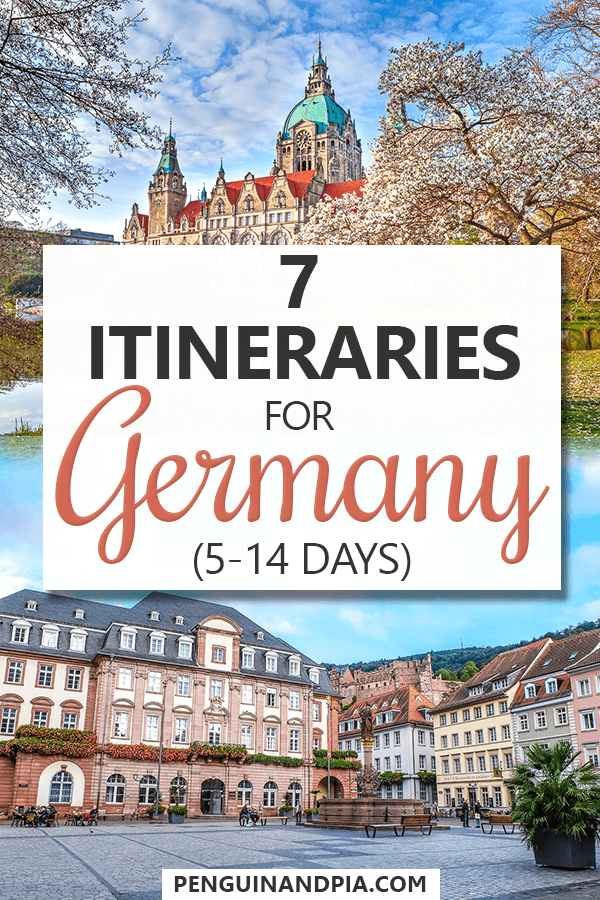
As an Amazon Associate we earn from qualifying purchases.
Destinations
Privacy policy
Disclaimer & Affiliate Disclosure
Terms of use
© 2024 Creativlier Media Inc.
- 1 Day Itinerary
- 2 Days Itinerary
- 3 Days Itinerary
- How Many Days
- Photography Spots
- Hiking Trails
- Historical Sites
- UNESCO Sites
- Art Galleries
- Churches and Cathedrals
- Christmas Markets
- Live Music Venues
- Comedy And Theater
- Spa & Massage
- Cologne Carnival
- Cologne Cathedral
- Cologne Old Town
- Belgian Quarter
- Chocolate Museum
- Flora & Botanical Garden
- Cologne Zoo
- Fragrance Museum (Farina House)
- Museum Ludwig
- Rhine River Cruise And Boat Tours
- Walking Tours
- Brewery (Brauhaus) Tours
- Street Art Tours
- Self-Guided Tours
- Wine-Tasting Tour
- Segway Tour
- Ford Factory Tour
- Festivals and Holidays
- Does It Snow?
- Cologne or Koln? koeln? Is it the same?
- Best Restaurants
- Best Schnitzel
- Best Burger Joints
- Best Michelin Star Restaurants
- Best Breakfast and Brunch
- Best Italian
- Best Korean
- Best Mexican
- Best Chinese
- Best Indian
- Best Wine Bars
- Best Bars and Clubs
- Best Beer Gardens
- Best Romantic Restaurants
- Best Vegan and Vegetarian
- Is Cologne Worth Visiting?
- Koln Card (Cologne Card)
- Best Hotels In City Centre (Old Town)
- Best Boutique Hotels
- Best Business Hotels
- Best Luxury Hotels
- Best Cheap Hotels
- Best Family Hotels
- Best Gay Hotels
- Best Spa Hotels
- Near Train Station
- Near Cologne Airport
- Near Cologne Cathedral
- Near Cologne Christmas Market
- Near Koelnmesse Exhibition Centre and Lanxess Arena
- Hotels With Swimming Pool, Balcony And Parking
- Best Castle Hotels
- Best Bed And Breakfast
- Best Hostels
- Camping Sites
- Train Stations
- Cologne Bonn Airport
- Airport to City Centre
- Luggage Storage
- Renting a Car
- To Phantasialand
- Cologne to Dusseldorf
- Cologne to Bonn
- Cologne to Aachen
- Cologne to Dortmund
- Cologne to Essen
- Cologne to Munster
- Cologne to Duisburg
- Cologne to Bochum
- Cologne to Gelsenkirchen
- 1-Day Itinerary
- 2-Day Itinerary
- 3-Day Itinerary
- Basilika St Lambertus
- Stadtmuseum (City Museum)
- Goethe Museum
- Hetjens Museum
- Theatermuseum
- Classic Remise (Car Museum)
- Aquazoo Lobbecke Museum
- Museum Kunstpalast
- Botanical Garden
- Japanese Garden
- Apollo Theatre
- Capitol Theatre
- Savoy Theatre
- Photo Spots
- Dusseldorf Old Town
- Rheinuferpromenade
- Medienhafen
- Königsallee
- Schloss Benrath
- Schlossturm
- Little Tokyo
- Düsseldorf Kaiserswerth
- Kaiserpfalz Kaiserswerth
- Segway Tours
- Brewery Tours
- River Cruise & Boat Tour
- What to Pack
- Is Dusseldorf Worth Visiting?
- Best Burger
- Best Breakfast & Brunch
- Best Japanese
- Best Halal Restaurants
- Düsseldorf Card
- Best Hotels In Old Town (Altstadt)
- Best Hotels In City Centre (Stadtmitte)
- Near Dusseldorf Christmas Markets
- Near Dusseldorf Airport
- Near Train Station (Hbf)
- Near Messe Dusseldorf (Exhibition Centre)
- Best Campsites
- Dusseldorf Airport
- Dusseldorf to Cologne
- Dusseldorf to Dortmund
- Dusseldorf to Bonn
- Dusseldorf to Aachen
- Dusseldorf to Essen
- Dusseldorf to Munster
- Dusseldorf to Duisburg
- Dusseldorf to Bochum
- Dusseldorf to Gelsenkirchen
- Dusseldorf to Phantasialand
- With Family
- For Couples
- On A Rainy Day
- One Day Itinerary
- Two Days Itinerary
- Three Days Itinerary
- Flea Markets
- Fish Market
- Comedy Clubs
- Hamburg Old Town
- Miniatur Wunderland
- Elbphilharmonie
- Planten un Blomen
- Alter Elbtunnel
- Schanzenviertel (Sternschanze)
- Karolinenviertel
- Beatles Platz
- Hamburg Dungeon
- Harbor Tours
- Red Light District Tours
- St Pauli And Reeperbahn Tours
- Speicherstadt Tours
- Beatles Tour
- Best Hotels In City Centre (Altstadt & Neustadt)
- Near Hamburg Airport
- Near Hamburg Train Station (Hbf)
- Best Hotels In St Pauli
- Best Hotels In Reeperbahn
- Best Hotels In Blankenese
- Best Hotels In HafenCity
- Best Hotels In Sternschanze (Schanzenviertel)
- Best Bed And Breakfast (B&Bs)
- Hamburg Card
- Is Hamburg Worth Visiting?
- Best Burgers
- Best Beer Halls
- Romantic Restaurants
- Vegan and Vegetarian
- Best Breakfast Places
- Best Cafes & Coffeeshops
- Best Brunch Spots
- Public Transport
The Best Traditional German Foods Revealed By 25 German Bloggers
Updated on April 3, 2024
Craving a taste of authentic traditional German food but not sure where to start? You're in luck! We've teamed up with 25 German bloggers who are experts in all things food to bring you the ultimate guide to traditional German fare.
Germany is known for its hearty, comforting dishes that are packed with flavor and history. But with so many options to choose from, narrowing down the must-try foods can be a challenge.
That's why we hired Minuca Elena to reach out to 25 German food bloggers and ask them the following question:
What are the top three traditional German foods that every tourist must try?
We also wanted to know about those hidden gems, the less famous favorites that these bloggers can't get enough of.
Whether you are planning a trip to Germany in the near future or you just want to try new recipes, we hope that this article will shed some light into what are the best traditional German foods anyone should try.
Keep reading to explore the delicious world of traditional German foods together!
Nadine Horn & Jörg Mayer - Eat This
Very few of the well-known traditional German dishes are vegan. However, there are a few and fortunately, many of the others can be easily adapted to be plant-based.
1. For example, classic Swabian "Linsen und Spätzle" which are small dumplings with lentils in a slightly sour sauce. The original often includes a sausage, which can also be easily replaced with your favorite vegan alternative.
2. By now you can get the unofficial German national dish, the "Döner Kebab" in many larger cities as a vegan version with seitan or tofu.
3. And don't miss out on "Kartoffelpuffer" - crispy, juicy pancakes made from grated potatoes that are traditionally served with apple sauce. Although they are not mentioned often when it comes to German cuisine, for many they’re pure nostalgia.
Karen Lodder - German Girl in America
1. Spaghetti Eis
Do Germans eat Ice Cream made from Pasta? No! Every Eis Diele (Ice Cream Shop) serves bowls of Spaghetti Eis, made from vanilla ice cream pushed through a pasta press, then topped with a strawberry sauce (that looks like marinara) and sprinkled with shaved white chocolate (parmesan cheese!). While basically, it’s just Vanilla ice cream topped with strawberries, the flavor and experience are tastier than the basic parts.
2. White Asparagus
Every April, a collective madness known as Spargelzeit takes over Germany, and suddenly White Asparagus pops up everywhere. Restaurants put out special menus with a dozen preparations for this King of Vegetables. The best way to enjoy it is the simplest. White Asparagus spears served with boiled potatoes, thin slices of salty ham, and melted butter (yes, you can order Hollandaise, but butter…mmmm). Warning! Asparagus season ends with a bang on June 24th.
3. Leberkäse
Liver Cheese? It sounds like something people would run away from. But you won’t find liver or cheese in this finely ground meatloaf. It looks a bit like bologna, but the taste is less…um… bologna-like. The Leberkäse is served in a few different ways. At home we eat it sliced thick and fried, and Bavarians top that fried slice with a fried egg. But the best I ever ate was at the Biergarten in Munich’s Viktuelienmarkt. A thick slab of freshly baked Leberkäse tucked into a crisp Semmel (roll) with some mustard. Enjoy it with a Bier or Radler and watch the world go by.
4. Königsberger Klopse
If you are traveling in the Northeast of Germany, and you are lucky enough to find Königsberger Klopse on the menu, order it. The dish gets its name from the old Prussian city of Königsberg. And the Klopse? Just another name for meatballs. The meatballs, a combination of several different ground meats, seasoned with anchovy paste and capers, and served in a cream sauce over boiled potatoes, pack a huge punch of flavor. Trust me, you’ll be licking the plate.
Vera Wohlleben - Nicest Things
When you talk about traditional German foods, there is a lot of meat involved - think of Bratwurst, Sauerbraten, or Schnitzel. But as I am a vegetarian, I will present you three veggie-friendly dishes. They are still so typical for Germany and absolutely delicious!
1. First of all, you should try a good plate of Käsespätzle . This hearty dish originates in the south of Germany (like me), but you can find it on the menu cards from north to south. Handmade Spätzle noodles, a lot of creamy, melted cheese, and crispy onion rings… Heaven!
2. Then, don’t miss Bratkartoffeln - the best thing a potato can become. Regional potatoes are thinly sliced and baked to crispy perfection. Every cook has its own secret recipe which is of course, the best. Have fun testing them all!
3. Last but not least, here is my personal sweet favourite: Schupfnudeln with poppy seeds and plum jam . It is lesser known than the previous dishes, but oh so yummy. Sweet potato noodles in a warm buttery poppy seed sauce, topped with caster sugar and lots of plum jam.
Maybe you are lucky and find it on some menu… Or you make friends who will prepare it for you 🙂
Jonas Zeschke - FitTasteTic
As someone deeply rooted in Hamburg's food scene, there's nothing I like more than sharing the tasty dishes my city has to offer. Even though I typically focus more on healthy dishes, I still really enjoy most of the classic German cuisine. But I'm definitely more fan of the Northern, lesser-known cuisine of Germany.
1. First up, Currywurst . This isn't just any fast food; it's a cultural icon. Imagine a succulent pork sausage, sliced and drenched in a curry-infused ketchup that packs just the right amount of heat. In Hamburg, we like our sauce with a bit more kick, reflecting our love for bold and zesty flavors. It's simple, it's delicious, and it's something you can enjoy on the go, making it my top pick for anyone exploring German street food.
2. Then, we have the Finkenwerder Scholle , a dish that pays homage to Hamburg's fishing legacy. Picture this: a freshly caught plaice, pan-fried with onions, bacon, and a hint of shrimp, bringing the North Sea's bounty right to your plate. It's a taste of Hamburg's maritime soul, served with a side of tradition and a sprinkle of local pride.
3. And for a grand finale, Rote Grütze . This dessert is a symphony of berries—raspberries, strawberries, red and black currants—gently thickened and served cold, with a lavish dollop of vanilla sauce. It's the perfect palate cleanser after a savory meal, offering a refreshing and tangy twist that encapsulates the essence of Northern Germany's dessert tradition.

Annette Sandner
As a tourist, you shouldn’t miss German classics on your plate, obviously.
1. In the southern part of Germany, you have to try pork roast with potato and bread dumplings , it’s famous for the crispy crust and the hearty sauce.
2. Also, you will find all kinds of sausages in Germany: roasted ones and very famous in the main city of Berlin: Currywurst with fries !
3. If you pass by Munich in Bavaria you have to try the "white sausage" , traditionally with sweet mustard, a "Breze" and wheat beer.
4. What I personally love is "Leberkas" - also a southern specialty, like a very fine meatloaf. You eat it as a snack in a white bun "to go" or with potato salad on a plate.
Marita Sinden - My Dinner
German food is varied as it is strongly influenced by the regional cuisine. If you visit Germany for the first time, I would urge you to try three things: German pastries, German sausages, and German beer. This may be a bit cliched, but gives a taste of both German and regional cuisine. Because every town and region in Germany will have its unique type of sausage and its local beer and pastry.
1. So if you are in Berlin, try a Berliner Pfannkuchen, a Currywurst and a Berliner Pilsner .
2. In Frankfurt, taste a slice of the Frankfurt Kranz cake, a Frankfurter Rindswurst, and drink a Henninger Kaiser Pilsner .
3. In Bremen, get a piece of Bremer Klaben, a plate of Pinkelwurst and Kale, and a bottle of Haake Beck Beer . Just like that, every region has its culinary treasures to uncover. Read more about German food here.
Gabriele Utz - My Best German Recipes
1. Sauerbraten
If you are in Germany you must try the Sauerbraten. It's a classic and traditional German pot roast that consists of beef that was marinated for some days. In restaurants it is served with potato dumplings, Spätzle or mashed potatoes, and, of course, red cabbage. In my childhood, it used to be a typical "Sunday" lunch or served at festive events.
2. Strammer Max
If you don't have much time for a big meal you might want to try this dish that is called Strammer Max. It's a very popular snack in Germany that consists of a slice of bread, topped with ham, cheese, and a fried egg; some add pickles, radishes, cucumber, or tomatoes too. The dish will be served in many restaurants, pubs, and inns from North to South. I like it as it is a wholesome snack.
3. Cheesespätzle - Käsespätzle
If you visit the South, the region around Stuttgart, try this dish that combines egg pasta called Spätzle, topped with fried onions and cheese, served with a mixed salad. German Cheese Spaetzle can be found on almost every menu of the local Inns that are called "Gasthaus". You might find this dish even in the North because it has become so popular. Makes a nice alternative for vegetarians.
Holly Becker - Decor8
Visit a bakery - always order cakes and breads - try as many as you can! German bakeries are largely underrated but I think they are far better than American ones.
My favorite thing from the bakery is Franzbrötchen .
Also, you will always be told to try German Bratwurst. It's fine - of course - but if you can order Münchener Weißwürste mit süßem Senf und Laugenbrezn , then you've really struck gold standard wurst in Germany.
I also love to order Schweineschnitzel mit Champignonrahmsoße, gebratenen Champignons und Bratkartoffeln .
Betina Wech-Niemetz - Mundgefühl
Typical German cuisine can be described as rather hearty and meat-heavy.
Visitors to Berlin, for example, cannot avoid the legendary currywurst . This is illustrated by the long queues in front of some currywurst stalls, which can almost be called institutions. The quick meal to go can easily be eaten between two appointments.
You should at least try the ever-popular meatballs while sitting down. In this country, they are often enjoyed with mashed potatoes, potato salad or vegetables such as carrots and peas.
A lesser-known classic is "Himmel und Ääd" , which stands for "heaven and earth". The earth is symbolized by "Erdäpfeln", i.e. potatoes, while the apples stand for heaven. Translated into a dish, this means mashed potatoes with apple sauce or pieces of apple and crispy fried black pudding. Certainly not everyone's cup of tea, but absolutely worth trying.
Susanne Heiser - Lindenthalerin
1. Starting in the north of the country my favorite dish is “ Labskaus ”. Labskaus is a traditional northern delicacy made of potatoes, corned beef, beetroot, onions, pickled gherkin, and herring.
There are countless varieties of this dish. It´s served cold, sometimes paired with fried eggs. Especially in the area around Hamburg, Kiel, and Bremen, Labskaus is a common dish. If you ever have the possibility then go for it!
2. In Northrine-Westfalia where I live my favourite dish is “ Rheinischer Sauerbraten mit Knödeln ”. It's so delicious! The meat will be marinated in vinegar with spices, wine, and vegetables for several days. It’s a slow food preparation until the meat is so tender that you hardly need a knife. Served with delicious sauce, and homemade dumplings, it’s a wonderful German dish you absolutely must try.
3. Finally, if youre around Frankfurt, plan a trip to the beautiful Odenwald region and try “ Odenwälder Kochkäse ”. This cheesy delicacy is made from cooked sour milk cheese called handkäse or curd. The runny cheese is eaten with fresh bread, pickles, or above a schnitzel (so-called “Kochkäse-Schnitzel”). Have a taste!
Monika and Petar Fuchs - Travel World Online
Germany is renowned for its rich culinary heritage, offering an array of traditional dishes that reflect its diverse regions and historical influences. Among the myriad of flavors and recipes, there are three traditional German foods that tourists must absolutely try.
1. First on the list is Rouladen , a classic dish that epitomizes German comfort food. This savory delight consists of thinly sliced beef rolled around a filling of bacon, onions, mustard, and pickles, then braised until tender. The result is a succulent, flavorful roll that's often served with gravy, potato dumplings, or red cabbage, offering a taste of Germany's culinary finesse.
2. Next is Sauerkraut , a fermented cabbage dish that's not only a staple in German cuisine but also a testament to the country's love for tangy, hearty sides.
3. Lastly, no culinary exploration of Germany would be complete without tasting Bratwurst , the famous German sausage. Made from a variety of meats, but primarily pork, Bratwurst is grilled or pan-fried and often served with sauerkraut or mustard, embodying the simplicity and richness of German flavors.
Together, these dishes offer a culinary journey through the heart of German tradition and gastronomy.
Rafaella Vilafranca & Raphael Almeida - Viagem Alemanha
On the dishes, we've expected many to go straight for the iconic Schweinshaxe, but we're here to talk about some German foods that are truly famous here but could fly under-the-radar picks outside Germany:
Not your average noodle, Spätzle is a Southern German staple. Often swimming in cheese (Käsespätzle!), it's the ultimate comfort food that gets you hooked with its simplicity and heartiness. Normally, it goes with meat dishes, but it can also be considered a main course.
2. Bratkartoffeln
Imagine thinly sliced potatoes crisped to perfection with onions and bacon bits. Perfectly pairing with classics like Schnitzel.
3. Spaghettieis
This one's a showstopper dessert! Vanilla ice cream is pushed through a ricer to look like spaghetti, topped with strawberry sauce and white chocolate shavings for that "tomato sauce and Parmesan" look. It's a famous German invention with an interesting story.
4. Black Forest Chocolate Torte
Layers of lush chocolate cake, rich cream, and tangy cherries make this more than a dessert. We love to taste it in the heart of the Black Forest in an old sawmill transformed into a restaurant.
Karl-Heinz Limberg - KHL Lifestyle
As an ovo-lacto-pesco-vegetarian, I eat fish but no meat. I have three tips for vegetarian German dishes.
1. My grandma often made the traditional potato pancakes with apple sauce for us. The potato pancakes are baked with grated potatoes, onions, flour, eggs, and various spices and served with apple sauce. Simply delicious!
2. Käsespätzle is a Swabian specialty, a kind of German pasta, so to speak. They are very tasty, but of course, due to the amount of cheese, they are also very high in calories. They taste particularly good with fried onions.
3. Wild garlic soup is delicious and relatively healthy. Wild garlic is similar to garlic but not as strong. This type of leek has experienced a real revival in recent years. Onions, vegetable stock, white wine, parmesan, and a little milk are added to the soup.
Petra Warth - Planet Hibbel
1. When traveling to Germany, you should try Flammkuchen , a traditional dish from the southwestern part of the country as well as the neighboring Alsace region. Tarte flambée, or rather "Flammekueche“, consists of a very thin base on which crème fraîche is spread. The classic version is then topped with bacon and onions. But there are also vegetarian alternatives and sweet versions, for example with apples and cinnamon.
2. Another favorite from southwest Germany is the Black Forest cake . It consists of several layers of chocolate biscuits with cream and cherries sandwiched between them. And important: The soil is soaked with kirsch. The top is decorated with cream tuffs, chocolate shavings, and cherries. So delicious! And of course an absolute calorie bomb.
3. Kaspressknödel is not only a purely German dish but it comes from Alpine cuisine. You will also find these cheese dumplings in Tyrol. In contrast to other dumplings, Kaspress dumplings are not round, but are pressed slightly flat - hence the "press" in the name. They are delicious with a mixed salad, with sauerkraut, or with broth as a soup.
Dominik Hoferer - Salamico
Germany offers a rich diversity of culinary influences and specialties, making it challenging to narrow down the selection to just three dishes for a list of the top 3. However, one thing unites us all: our bread culture. Bakeries are filled with baked goods made from various flours and spices.
1. One of these baked goods stands out particularly: the pretzel . Originally from the south of the country, it has long since conquered all of Germany. Traditionally enjoyed without toppings, often with butter, some adventurous souls eat them with sesame or even pepper.
2. Pretzel dough forms the basis of a dish I created some time ago: the Black Forest Döner . Baden-style pork shoulder, Black Forest ham, and lamb's lettuce are filled into a pretzel dough flatbread with a yogurt-horseradish cream - a successful blend of tradition and openness to the world.
3. Another popular dish, appreciated by both Germans and Alsatians from France, is Flammkuchen . Originally intended to test oven temperatures when baking bread, Flammkuchen is now popular throughout the south of Germany along the French border. Sour cream, onions, and ham - often with cheese - on a thin, crispy flatbread. Naturally, it pairs well with a glass of white wine, such as a refreshing Riesling or Pinot Gris, to properly celebrate the diversity of the region.
Angela Fessl - Angela kocht...
If you travel to Germany, you should try:
1. Schwarzwälder Vesper - the typical Black Forest snack platter consists of hearty homemade sausage, original Black Forest ham, bacon, and crispy farmhouse bread.
2. Stelze mit Kartoffelknödel und Sauerkraut - this is a Bavarian specialty and extremely nice
3. Schwarzwälder Kirschtorte - this is a famous cake from the Schwarzwald - in the southern part of Germany.
Anja Kühner - Duesseldorf Entdecken
When it comes to typical German dishes, everyone immediately thinks of pork knuckles and sausages. But in former times meat dishes were only served on Sundays. Meat was expensive and normal people could only afford it once a week. Of course, everybody was proud of the Sunday dishes. That’s why – with a wealthier society – those became the everyday food. Traditional everyday dishes were vegetarian.
German cuisine is very diverse and regional. Southern German mountain dishes were different than those near the North or Baltic Seas. And of course, traditional cuisine is seasonal: you cook what you harvest, and storage was not possible before the fridge was invented.
Here are my personal favorites and must-tries:
1. Grüne Soße
“Green sauce” is green because there are plenty of herbs. Seven different kinds of herbs are blended in a mix of mayonnaise and yogurt. It accompanies jacket potatoes and hard-boiled eggs. Sometimes a Schnitzel comes with it. The green sauce can be found in Frankfurt.
2. Käse-Spätzle
Hand-made egg noodles mixed with fried onions and a strong cheese. In autumn fried mushrooms are added. A traditional dish from Swabia which is the area around Stuttgart.
3. Reibekuchen
Potato fritters served with mashed apples. Sky and earth on one plate. Typical in Cologne, Dusseldorf, and the Rhineland.
Angie Kunze - We’re Not in Kansas Anymore
1. When I'm traveling in Germany I eat a lot of Schnitzel . I just never seem to get tired of it. The traditional Wiener Schnitzel is a veal or pork cutlet pounded thin, breaded, and fried to crispy golden perfection. While there is no improvement on the traditional Wiener Schnitzel, many restaurants offer versions topped with either a brown or cream gravy.
2. A popular street food in Germany is the Currywurst , a sausage slathered in a sweet curry sauce, and served with a little bread on the side. Curry sauce, or curry ketchup as it is often referred to, is a favorite topping for French Fries or Pommes Frites. Germans love to add mayo to the top for a delightfully creamy addition!
3. A lesser-known, but incredibly delicious option, is spaghetti ice cream, or Spaghettieis . Sounds strange right? This popular dish consists of vanilla ice cream that's pressed through a ricer or machine so that it comes out looking like spaghetti noodles. It's then topped with strawberry sauce, and often the addition of a little white chocolate "parmesan cheese." It is absolutely divine!
Germany just so happens to be my favorite place on earth. I spent part of my childhood there and when I'm not there I'm dreaming of my return!
Laura Herrmann - Köln isst gut
When it comes to German cuisine, you‘re probably thinking Schnitzel, sausages, and beer. But there’s much more. Thanks to the country‘s rich federal history, German cuisine brings many local and regional facets to the table.
Here are three dishes beyond typical stereotypes and from across the country that tourists should definitely try:
1. White asparagus with potatoes, sauce hollandaise and ham
The time between April and June marks a special season in Germany. It’s the time of year when the country’s most precious vegetable is harvested: white asparagus. And Germans go crazy about it: supermarkets will advertise special offers, restaurants will have entire menues dedicated to the country‘s asparagus season.
The typical dish consists of white asparagus, potatoes, sauce hollandaise and cooked ham, but depending on where in Germany you are at this special time of the year, you‘ll also be able to enjoy the vegetable with fish or a schnitzel.
2. Potato pancakes with smoked salmon or apple sauce
Everytime my best friend visits from Berlin, she will demand „Reibekuchen“. Potato pancakes are very typical for the local cuisine of Cologne. They are similar to hash browns but also contain flour and egg, and are served for lunch or dinner.
One can choose between a sweet version with a side of apple sauce or a hearty version with smoked salmon and horseradish.
3. "Lost eggs" in mustard sauce with potatoes
Historically, this dish originated in the north of Germany. Nowadays, it is commonly remembered as a typical canteen dish in East Germany from the era of the German Democratic Republic. This simple dish consists of soft boiled eggs and potatoes served with a sauce of blonde roux and mustard.
Anja Eckert - Our Gabled Home
While most people are familiar with Bratwurst, Schnitzels, Potato Salad, and Pretzels, there are so many more delicious German recipes one should try:
1. These German meatballs (Königsberger Klopse) come in a creamy white sauce.
2. Egg noodles (Spätzle) are perfect with butter, cheese, and caramelized onions or as a side for your favorite meats.
3. Savory onion pie (Zwiebelkuchen) is the German cousin to the French quiche and is just as delicious.
Andrea D'Addio - True Italian
Since I'm an Italian based in Berlin, my top three typical German food has a lot to do with either Berlin or Italy.
The list is therefore:
1. Eisbein which is typical food in Berlin.
2. Käsespätzle - which are also famous in northern Italy, but with the name Canederli.
3. Maultaschen which remind me pasta, again :).
Laura Pona - Easy Recipes
Germany offers a plethora of culinary delights that every tourist should experience. Here are my top three recommendations, including a lesser-known dish that holds a special place in my heart:
1. Sauerbraten (German Pot Roast)
This quintessential German dish, often made with beef marinated for several days in a mixture of vinegar, water, and spices, is a testament to the country's rich culinary tradition. The result is a tender, flavorful roast that perfectly encapsulates the essence of German comfort food.
2. Brezel (Pretzel)
No visit to Germany is complete without trying a freshly baked pretzel. Its distinct twisted shape and the contrast between the crispy crust and soft interior make it an unforgettable snack, especially when enjoyed with a pint of German beer.
3. Maultaschen
This lesser-known Swabian dish is a personal favorite of mine. Maultaschen are similar to dumplings and are filled with a mixture of meat, spinach, bread crumbs, and onions, then seasoned with various herbs. It's a versatile dish that can be served in broth or fried with onions, offering a unique taste of Germany's regional diversity.
Kitty Maerz - Kitty Meets World
The top three German foods I would recommend tourists try are Schnitzel, Käsespaetzle, and Currywurst.
1. Schnitzel is a thin piece of meat, most commonly veal or pork, served in various versions in Germany. The most common ones are Schnitzel Wiener Art (breaded and fried), Rahmschnitzel (in a cream sauce), Jägerschnitzel (with mushrooms), and Zigeunerschnitzel (with a slightly spicy tomato/bell pepper sauce).
The breaded and fried Wiener Schnitzel is probably the most common dish in German restaurants and the best choice for tourists as it should appeal to most tastes. It is usually served with either potato salad or french fries.
2. Käsespätzle (Cheese Spaetzle) is a combination of Spaetzle (traditional egg noodles) and melted cheese. Usually, you will find fried onion on top to give it some crunch and added sweetness.
This is a rare vegetarian German dish but it is quite heavy and filling and best eaten with a side salad. If you want to try the Spaetzle without the cheese, you can often order them as a side for meat dishes.
3. The final traditional German dish tourists should not miss is Currywurst (Curry Sausage). It is more of a snack and you can find it at snack bars and in restaurants.
Basically, Currywurst is a large sausage smothered with ketchup and sprinkled with curry powder. Sides are usually french fries or a plain roll. While Currywurst may not sound special, it is a delicious snack and not to be missed!
Viktoria Daute - Landgasthof Daute Hotel
My top three German foods that are not based in a specific region in Germany, but are more or less available anywhere are:
1. Currywurst with fries and Mayonnaise!
2. Schnitzel with Bratkartoffeln (Pork Schnitzel, not Veal. Bratkartoffeln, something like sliced pan-fried potatoes, which are delicious!)
3. Mettbrötchen fresh from the bakery or butcher. It's a fresh bread roll with spiced raw ground pork.
Thomas Biedermann - Nudelheissundhos
I suggest the following recipes if you are visiting Germany as a tourist and are wondering which dishes are typical and traditional for Germany and which I should have eaten at least once.
However, I will start the suggestions with a recipe from East Germany, which is now also a traditional, typical dish more than 30 years after German reunification. And then I'll pay homage to my origins in southern Germany and list two recipes from Swabia. Enjoy your meal!
1. Seasoned meat
Tradition from East Germany
A traditional dish from East Germany, a classic.
Würzfleisch is a typical recipe from the GDR era from a HO restaurant (HO means trade organization). In the GDR, the French dish "Ragout fin" also used to exist, as it did in West Germany. However, veal was not always available in the GDR to make ragout fin. This meant that a "cheap version" was needed. So they simply took pork, usually from the shoulder or neck, cooked it until soft, and then simply cut the cooled meat into small cubes. Of course, this was no longer "ragout fin", but the dish needed a different name. It was simply referred to as delicious "seasoned meat" and enjoyed.
As a West German, I would say that this is a very tasty dish. Presumably, each region in East Germany has its own variation and sometimes uses different ingredients for the würzfleisch.
Unfortunately, the only variation of the dish that I have been able to prepare is the mushy sauce of the spiced meat, which is not very light and golden. On the one hand, this is because I fried the flour for a little longer in the roux and therefore allowed it to brown. And secondly, I used dark-spelled flour and not light wheat flour.
On the downside, I found the dish a little difficult to digest due to the mushy sauce.
For two people:
- * 500 g pork (goulash or schnitzel)
- * 1 l vegetable stock
- * 6 bay leaves
- * 20 allspice grains
- * 8 tbsp flour
- * 100 ml Riesling
- * ½ lemon (juice)
- * 1 tbsp Worcestershire sauce
- * 200 g medium-aged Gouda cheese
- * 4 slices of toast
Preparation time: preparation time 5 min. | cooking time 10 min.
Delicious au gratin
Heat the vegetable stock in a pan. Halve the onions (unpeeled and with skin), add the allspice whole and the bay leaves. Cook the meat in it for a few minutes.
Remove the meat and leave to cool. Cut into small cubes.
Heat a large knob of butter in a pan. Add the flour and stir to make a roux. The roux should be very thick and mushy.
Pour the stock through a sieve into the roux, sieve out the onions, allspice, and bay leaves, and then stir the stock well.
Squeeze the lemon half. Add the lemon juice, Worcestershire sauce, and Riesling. Season with salt, pepper, and a pinch of sugar.
Coarsely grate the Gouda on a grater into a bowl.
Place the seasoned meat in two heatproof bowls. Sprinkle with the cheese.
Bake under the grill coil of the microwave or oven for a few minutes until the cheese has melted and browned a little.
Serve with two slices of toast.
Serve with Worcestershire sauce for seasoning. Enjoy your meal!
2. Sour tripe with fried potatoes
Crispy and sloppy together
Sour tripe is a traditional Swabian dish. It is particularly popular during Lent or throughout the year.
That's why I call this dish "tripe" as an exception, as there are other terms such as "rumen" or similar.
The tripe or rumen is the well-cleaned stomach of cattle. It is therefore also available in this state, i.e. cleaned and white or slightly grayish, in supermarkets or from butchers.
Tripe is cooked for several hours in vegetable stock before being prepared. It can then be further processed and boiled, roasted, baked or deep-fried.
Tripe is usually cut into thin strips before cooking and used in this form.
While researching for a suitable recipe for sour tripe, I kept coming across the fact that it is often served with roast potatoes as a side dish. This method of preparation doesn't quite make sense to me, because on the one hand, I like crispy and crunchy fried potatoes. And on the other hand, tripe is prepared in a delicious, slightly sour sauce. This is more like a side dish such as boiled potatoes, dumplings, pasta, or rice so that the sauce has its purpose and function. But anyway, if this is how it is traditionally prepared, I'm not opposed to it, that's the way it should be and the sour tripe is served with roast potatoes.
- * 500 g tripe (pre-cooked for 3-4 hours in vegetable stock)
- * 10 potatoes
- * 2 large onions
- * 1 1/2 tbsp flour
- * 300 ml vegetable stock
- * 100 ml Merlot
- * at least 5 tbsp Aceto Balsamico di Modena
- * 3-4 tbsp tomato puree
- * black pepper
- * olive oil
Preparation time: Preparation time 10 min. | Cooking time 25 min.
Delicious tripe
Peel the potatoes and place them in a bowl. Heat the water in a pan and cook the potatoes for 15 minutes. Remove with a slotted spoon, place in a bowl, and leave to cool. Then cut crosswise into thin slices and return to the bowl.
Clean, peel, and chop the onions. Place in a bowl.
Cut the tripe into short, thin strips.
Heat the oil in a pan and fry the potatoes on both sides for about 10 minutes until crispy and crunchy. Season with salt and pepper. Keep warm.
At the same time, heat the butter in a pan. Sauté the onions until translucent. Dust with flour and fry briefly in the butter. Then deglaze with the vegetable stock and red wine and prepare a roux. Bring the sauce to the boil briefly and thicken with the flour. If necessary, whisk a little with a whisk so that the flour does not form lumps.
Add the vinegar. Also, add the tomato purée. Season well with salt, pepper, and a pinch of sugar.
Add the tripe and heat for a few minutes. Season the sauce to taste.
Divide the roast potatoes between two plates. Place the tripe and sauce next to them.
Serve. Enjoy your meal!
3. Sour kidneys with mashed potatoes
You don't have to soak the kidneys.
This recipe is a specialty from the homeland of my 94-year-old mother's ancestors, Swabia.
Sour kidneys are a Swabian specialty and a traditional dish there.
However, I would like to dispel the misconception that you have to soak kidneys in water or milk for a while before actually preparing them to remove the taste and smell of urine. This is nonsense. In French cuisine - this is known to be haute cuisine - this is not done and the kidneys are processed immediately. Thorough washing under cold water is therefore completely sufficient.
When searching for a suitable recipe, I did find one, but all the recipes were for sour kidneys with mashed potatoes as a side dish. I had planned to use dumplings or pasta as a side dish, but I quickly changed my mind, peeled and boiled some potatoes, prepared a delicious mashed potato with a large portion of butter with some spices, and served it as a side dish.
For 2 people:
- * 600 g kidneys
- * 150 ml vegetable stock
- * 1 tbsp flour
- * 2 tbsp crème fraîche
- * 5 tbsp Aceto Balsamico di Modena
For the mashed potatoes:
Preparation time: Preparation time 15 min. | Cooking time 25 min.
With a delicious, sour sauce.
Peel the potatoes and cook in a pan of boiling water for 15 minutes.
Pour off the cooking water. Mash the potatoes with a masher. Add a large portion of butter. Season them well with salt, pepper, nutmeg, and a pinch of sugar. Mix everything well. Keep warm.
Wash the kidneys under cold water and cut them into quarters lengthwise. Then cut crosswise into short strips. Place in a bowl.
Clean, peel, and chop the onions. Place it in a bowl.
Heat the butter in a pan and fry the onions until translucent. Add the kidneys and fry briefly.
Dust with flour and fry briefly. Add the vegetable stock, mix everything well, and simmer gently for 5 minutes.
Add the vinegar and crème fraîche. Season well with salt, pepper, and a pinch of sugar. Season the sauce to taste. Do not let it simmer any longer, otherwise, the kidneys will become hard due to overcooking.
Divide the mashed potatoes between two plates. Add the kidneys to the sauce.
Spoon a few tablespoons of the sauce over the mash.
Thank you so much to all the bloggers that have contributed to this expert roundup!
From iconic dishes like schnitzels and spätzle to hidden culinary gems, we've explored the diverse flavors and rich heritage that define German food.
We hope this article has inspired you to embark on your own culinary adventures and discover the true essence of German gastronomy.
Don’t forget sharing is caring! Please share this article with your friends and followers on social media.
About the Author
Minuca Elena
I am a freelance writer specializing in creating expert roundups. My expert roundup posts provide quality content, bring huge traffic, and get backlinks. I also help bloggers connect with influencers. You can find out more about my work on my website, MinucaElena.com.

Berlin Travel Guide
Last Updated: July 29, 2023
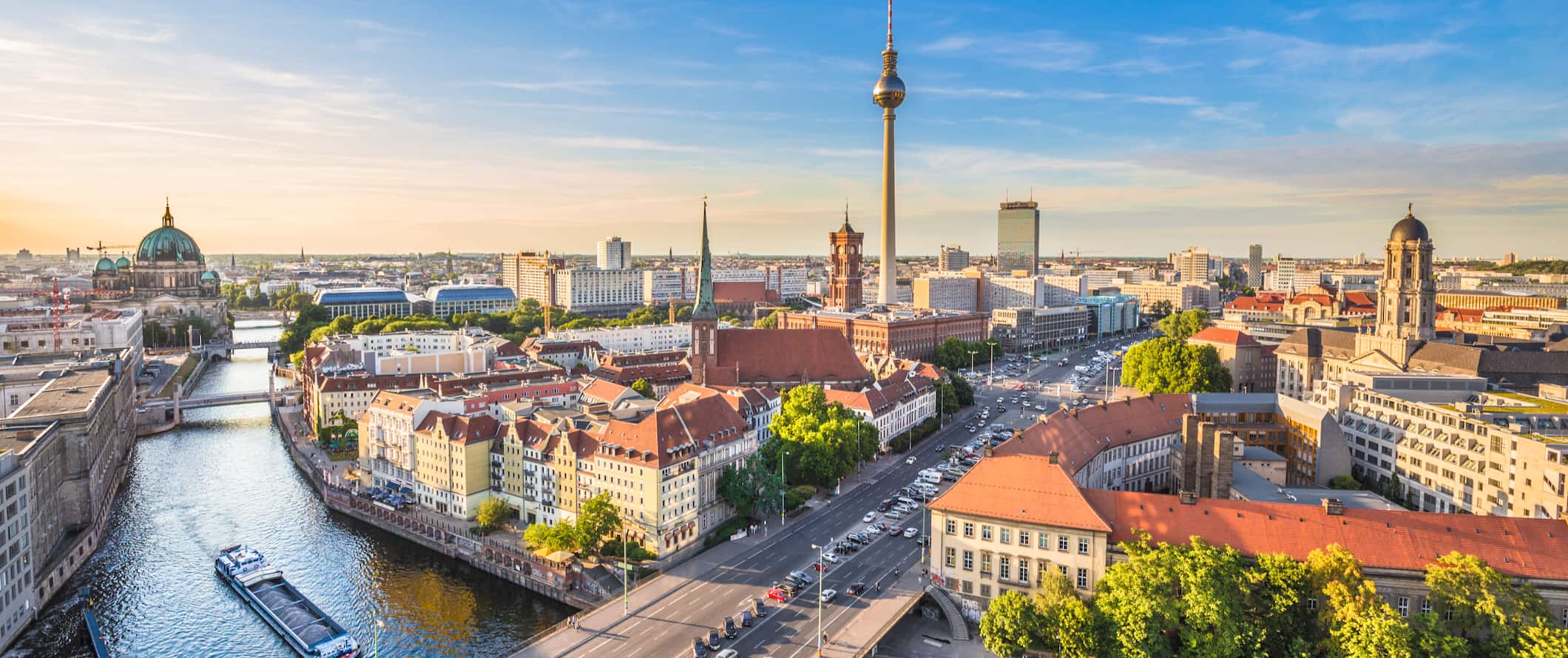
Over the past decade, Berlin has become incredibly popular with students, artists, writers, and creatives. They’ve been drawn to the city’s cheap rent and anything-goes spirit. There’s a constant sense of motion in Berlin.
This city is one of the most vibrant on the continent. It’s also huge, so don’t try to see it in just a couple of days. Extend your stay, take your time, rent a bike, and don’t rush. There’s a lot to see.
This travel guide to Berlin can help you plan your trip, save money, and ensure you have an amazing time in this lively metropolis.
Table of Contents
- Things to See and Do
- Typical Costs
- Suggested Budget
- Money-Saving Tips
- Where to Stay
- How to Get Around
- How to Stay Safe
- Best Places to Book Your Trip
- Related Blogs in Berlin
Top 5 Things to See and Do in Berlin
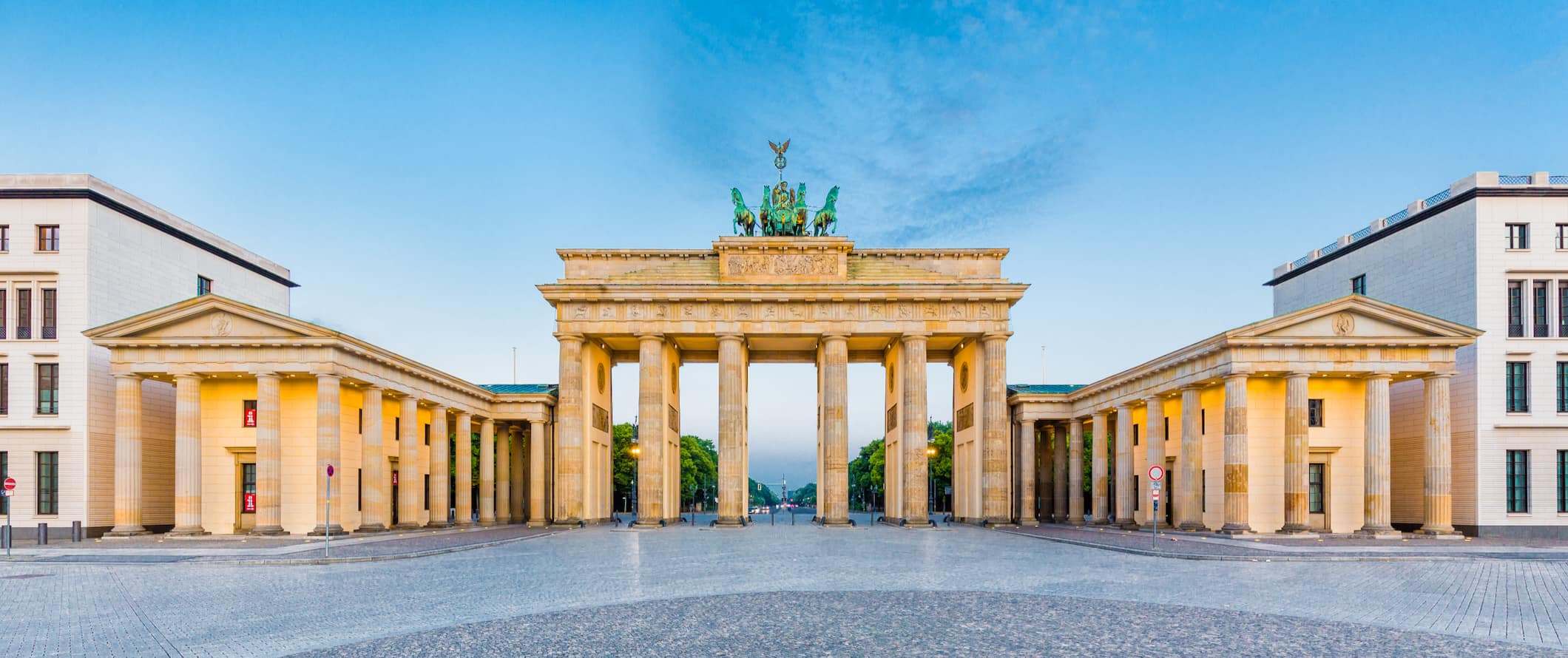
1. Visit the Memorial to the Murdered Jews of Europe
This outdoor memorial is a tribute to the millions of Jews that died during World War II. It’s made up of 2,711 large rectangular stones, which are all different sizes. You can walk between the stones and reflect on the Holocaust and the millions of lives that it claimed.
2. See the Brandenburg Gate
Built in 1791, Brandenburg Gate is the city’s best-known landmark. During the Cold War, the Brandenburg Gate was in no man’s land behind the Berlin Wall. When the Wall fell, everyone came to celebrate here and it has remained a symbol of a unified Germany ever since.
3. See the Berliner Dom
The Berlin Cathedral was originally built in 1905 as a royal court church, but now it’s also a museum and concert hall. While most visitors just stop by for photos, the ornate interior is decked in marble and onyx, with a 7,269-pipe organ and royal sarcophagi. Admission is 9 EUR.
4. Visit the East Side Gallery
This open-air art gallery features 105 paintings by artists from all over the world on a section of the Berlin Wall in Friedrichshain-Kreuzberg. Most of the paintings are political in nature. Signs fill in the history along the way so you can learn about the wall and art too.
5. Hang out in Treptower Park
This park is near an abandoned amusement park. Bike, relax in one of the beer gardens, or rent a boat and paddle down the Spree River. It’s my favorite park in the city. Visit the Inselgarten beer garden with its giant bar swings and random tango classes.
Other Things to See and Do in Berlin
1. hang out in potsdamer platz.
In the 1920s, Potsdamer Platz was the busiest square in Europe but it was destroyed during World War II and then divided by the Berlin Wall. After German reunification, it became the largest building site in Europe. It was transformed into a showpiece for the “new Berlin,” with modern architecture like skyrises, hotels, cinemas, shopping centers, and the massive central plaza.
2. See the famous Reichstag
The seat of the German Parliament is one of Berlin’s most historic landmarks. It has a clear dome (to promote “transparency” in the government) and draws some of the biggest crowds in Berlin. You can visit the dome (it’s free), but you have to make a reservation ahead of time. From the dome, you can enjoy panoramic views over the city and learn about the parliament’s history from the interior exhibitions. (Bring your passport as it’s required for entry!).
3. Enjoy the view from Fernsehturm TV Tower in Alexanderplatz
Germany’s main city square contains the iconic 368-meter-high Fernsehturm TV Tower. You can visit the tower’s observation deck for dazzling views of the city. Tickets start from 25.50 EUR. Otherwise, Alexanderplatz is an exciting hub of activity as people come to shop, eat, and hang out.
4. Tour the German Historical Museum
This museum covers everything from prehistory right up to the present day. There are numerous in-depth exhibits here, so schedule a few hours to see it all. It’s one of my favorite history museums in the world because it is very, very detailed. Highlights include a 3.5-meter-tall coat of arms column from 1486, Napoleon’s hat from the battle of Waterloo in 1815, and a personal computer from East Germany. Admission is 8 EUR. Note: the permanent exhibitions are closed for renovations until 2025. Temporary exhibitions are still accessible.
5. Head to Grunewald Forest
If you are looking to escape from the city, the grand expanse of Berlin’s largest forest is the perfect destination for hiking, picnicking, and biking. On hot summer days, head to Kuhhorn Badestrand, which has a cove and beach where Berliners come to swim and lounge. In the northernmost part of the forest, you’ll find Teufelsberg, a man-made hill standing 120 meters high. You can hike up here for views over the city as well as to see the abandoned tower that was used as a listening station by the US during the Cold War. Admission to Teufelsberg is 8 EUR. Guided tours in English are 15 EUR and take place on Sundays at 3pm.
6. Go to Zoologischer Garten and Aquarium
First opened in 1841, this is Germany’s oldest — and Europe’s most popular — zoo. There are giraffes, elephants, gorillas, and Germany’s only giant pandas, as well as nearly 1,300 other species. The aquarium is equally as impressive and is home to fish, coral, jellyfish, sharks, and more. A combination ticket for the zoo and aquarium is 23 EUR.
7. Visit the Deutsche Kinemathek
More commonly referred to as the Film Museum, this museum hosts festivals throughout the year. However, it’s also worth visiting for its fascinating interactive exhibits on German film. You can learn about German movie history, try out historical filmmaking instruments, explore the ins and outs of cinematic storytelling, watch Nazi propaganda films, and play your own role in front of a green screen in the museum’s studio. The museum theater also offers regular showings of foreign and historic films. Admission to the museum is 9 EUR with a free audio guide available and tickets to see a film are 8 EUR. Entrance is free on the first Sunday of the month.
8. Check out Mauerpark’s market
This enormous flea market is held every Sunday, with vendors selling all sorts of vintage furniture, antiques, artwork, books, and more. Local artists also set up shop to sell their paintings and handicrafts, and there’s no shortage of food and beer to go around. Don’t forget to join the karaoke session in the outdoor theater.
9. Relax in Tempelhof Field
Located in the southern part of the city, this park is actually the site of an old airport that was used during the Berlin Airlift (when the Soviets tried to blockade the city). While the airport closed in 2008 and was transformed into a park, there are still a lot of plaques where you can learn about the old airport. The 951-hectare park is a favorite with Berliners, with lots of people running, working out, and cycling here. In the summer, people take over the barbecue pits. The entrances are open from sunrise to sunset.
10. See the DDR Museum
This museum focuses on life in East Berlin during Communist rule. Exhibits are interactive and divided to cover the various aspects of daily life in East Berlin. There’s even a section dedicated to how the East Germans rebelled against Communist rule by flocking to nude beaches to be “free.” Tickets are 12.50 EUR.
11. Visit Checkpoint Charlie
Dividing Berlin’s most well-known post-war border crossing was Checkpoint Charlie. The original border post on Friedrichstraße between former East and West Berlin remains, complete with a soldier’s post and border crossing sign. The museum has exhibits on the history of the Berlin Wall along with displays about people who attempted to escape to the West. Admission is 14.50 EUR. Audio guides and photo permits are an extra 5 EUR.
12. Take a bike tour
Berlin is a great city to explore by bicycle. There are plenty of themed tours run by operators like Fat Tire Tours that showcase the city, highlighting its history, food, and culture. Prices vary depending on the tour but expect to pay 30-70 EUR per person.
13. Go underground with the Berliner Unterwelten-Museum
This is not a museum in the traditional sense (though there is an exhibition), but rather a guided tour into bunkers, air raid shelters, and tunnel systems beneath the city, in Gesundbrunnen U-Bahnhof. You’ll see East Germany escape tunnels, ammunition findings, and even archaeological treasures. You can also descend into the basement of the BerlinerKindl brewery and sample some of the beers after the tour. Tours cost 15 EUR.
14. Explore the Jewish History Museum
This museum traces the arrival of Jews in Germany, and their contributions throughout German history, hardships faced as a people, and Jewish culture in general. Like most museums in Germany, the museum is huge and requires a few hours to properly explore. It doesn’t go too much depth on the Holocaust, as there is a separate museum for that (The Topography of Terror). Admission is free, with temporary exhibition tickets costing 8 EUR. Due to COVID, they ask that you book a time slot in advance.
15. Visit the Topography of Terror
This museum is on the spot where the SS and the Reich Security Main Office were located during World War II. It documents the terror and horror of the Nazi regime with harrowing video interviews with survivors, historical documents, photographs, and more. It also consists of excavated prison cells that were located under a remaining stretch of the Berlin Wall. Admission is free.
16. Relax in Tiergarten
Berlin’s central park is one of the most beautiful city parks in all of Europe. Founded in 1527 as a private hunting ground for Germany’s ruling class, Tiergarten first opened to the public in 1740. Unfortunately, the park was significantly damaged during World War II; most monuments and bridges were destroyed, thousands of trees were cut down to use for firewood, and war debris piled up. Today, the park covers 520 acres and visitors can visit war monuments, grab a beer in the beer garden, and go out on the lakes in a pedal boat (or ice-skate in the winter).
17. Take a boat tour
The Spree River flows through Berlin, meaning there are lots of canals and waterways on which you can take a boat tour. It’s quite relaxing on a warm day and provides a new perspective of the city. Tours start at 19 EUR for a one-hour cruise.
18. Hang out in Friedrichshain’s Markthalle Neun
If you’ve had your fill of Berliner currywurst and döner kebap and you’re looking for more variety, this huge food hall is a cool place to hang out during the day as it carries fresh produce, deli items, and handmade bread, pasta, and more. There are also various international-themed eateries as well. The regular weekly market is open Tuesday to Sunday until 6pm. Thursdays they have special street food where you can get Tibetan momos, British pies, tacos, Kässpatzen (dumplings with cheese), and more. They even have a selection of craft beer, wines, coffee, and other items to drink.
19. Rent a DDR Trabant Car
At Trabiworld, you can rent one of the old DDR gear shift Trabant cars and take a spin around Berlin on a “Trabi Safari” (the cars were manufactured in East Germany). Cruise around on a planned route by the sites of the East Side Gallery part of the former Berlin Wall. Plus, you even get to keep your “Trabi license” as a souvenir at the end. Rides cost 59 EUR for and last 75 min.
For more information on other cities in Germany, check out these guides:
- Cologne Travel Guide
- Frankfurt Travel Guide
- Munich Travel Guide
Berlin Travel Costs
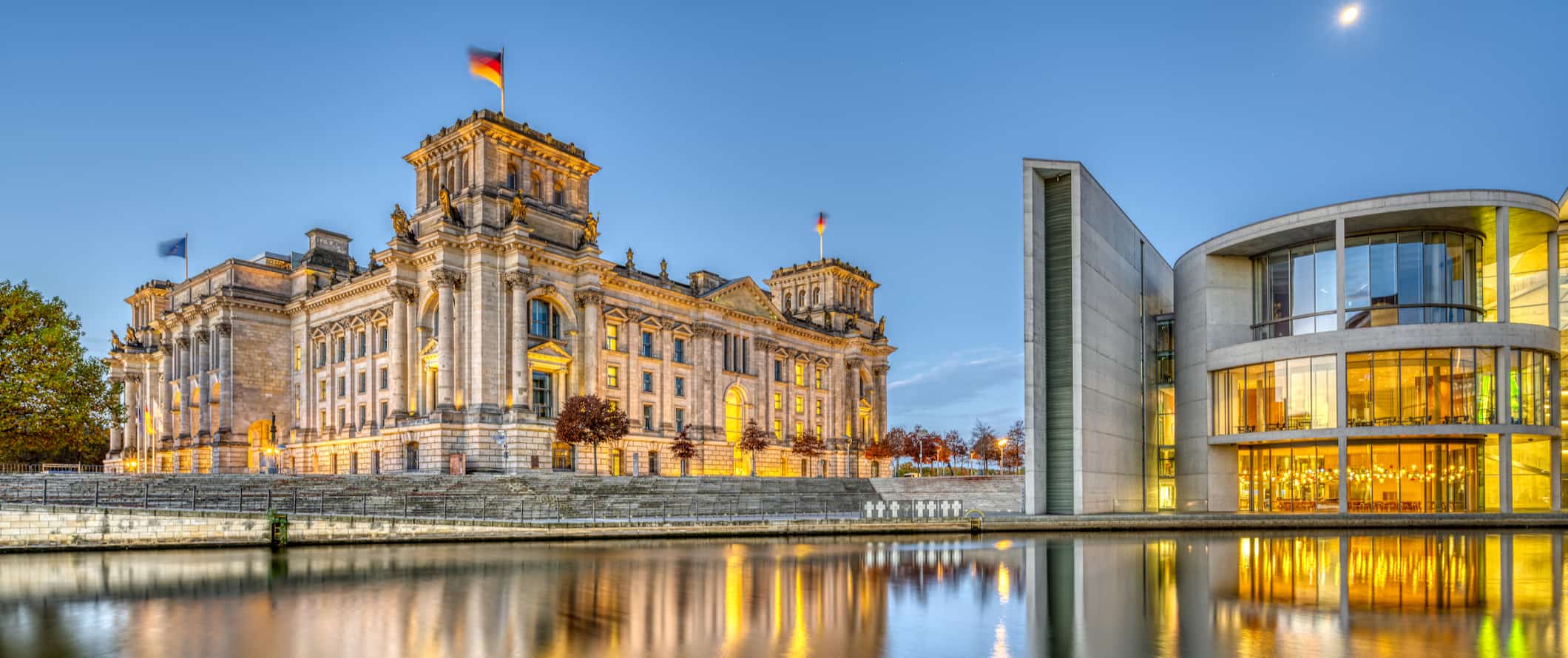
Hostel prices – Dorms cost 17-25 EUR per night while private rooms for two cost around 45-56 EUR per night. Free Wi-Fi and lockers are standard in all hostels in Berlin. Most hostels also offer free coffee/tea and have a kitchen and bar on site. Only a few hostels offer free breakfast, but many offer a breakfast buffet for an additional 5-8 EUR.
Many hostels also offer bike rentals for 10-15 EUR per day and some offer free walking tours. In a sign of the times, a few hostels even offer free COVID-19 testing.
Budget hotel prices – Budget hotels cost between 50-65 EUR per night. Free Wi-Fi, flat-screen TVs, and private bathrooms are standard, while free breakfast is not. Many hotels offer a breakfast buffet for 8-12 EUR.
Airbnb is available everywhere in Berlin, with private rooms costing about 30-45 EUR per night while full apartments start around 75-100 EUR per night in spring and 50-90 EUR in winter.
Food – Food in Germany is very cheap (and hearty). Meat is a staple of most meals, especially sausages; there are over 1,500 different kinds of sausages in Germany (sausages here are known as “wurst”). Stews are also a popular traditional choice, as are potato dumplings and sauerkraut. Breakfast is usually composed of bread, cold cuts, cheese, and boiled eggs.
Generally, eating out in Berlin is incredibly affordable. Currywurst, kebabs, and quick pizzas are all under 5.50 EUR. For the best kebabs, go to Mustafas. You’ll get a filling, delicious meal for around 5 EUR.
Eating out at one of the many Indian, Thai, or Turkish restaurants is the cheapest way to enjoy a sit-down meal in Berlin. A lunch meal at a Vietnamese restaurant is about 5.50 EUR while a main dish at an Indian restaurant is around 6.50-9 EUR.
For more cheap eats, check out Thai Park (Preußen Park). During the summer, Thai locals come to the park to cook up delicious and affordable Thai food. It started as just a small Thai community gathering but now it’s a huge food market with awesome eats for under 10 EUR.
At fast-casual eateries, a plate of schnitzel is around 6-8 EUR, pizza is 8-10 EUR, and a burger is 5-8 EUR. A combo meal at McDonald’s costs 9 EUR.
Expect to pay around 35 EUR for dinner for two. A meal at a higher-end restaurant costs about 15-17 EUR for a pasta entree, while a steak is around 23 EUR.
For drinks, a beer costs about 4 EUR at any bar or beer garden, a glass of wine is around 4.50 EUR, a cocktail is 7-10 EUR, and a cappuccino is 3.50 EUR.
Some of my favorite places to eat are Mustafa’s Gemuse Kebap, Konnopke’s Imbiss, Cocolo Ramen, Burgeramt, Markthalle Neun, MOM’S, and Nah am Wasser.
If you cook for yourself, you can spend as little as 45-50 EUR on groceries per week. This gets you basic staples like bread, eggs, rice or pasta, seasonal produce, and some meat. The cheapest places are Lidl, Penny, Netto, and Aldi.
Backpacking Berlin Suggested Budgets
If you’re backpacking Berlin, expect to spend about 55 EUR per day. This assumes you’re staying in a hostel, limiting your drinking, cooking all your meals, using public transportation to get around, and doing mostly free activities like walking tours and relaxing in the parks.
On a mid-range budget of 110 EUR per day, you can stay in a private Airbnb room, eat out for a few meals, rent a bike to get around or take the occasional taxi, enjoy a couple of drinks, and visit more attractions, such as the Berliner Dom or the Reichstag.
On a “luxury” budget of 200 EUR per day or more, you can stay in a budget hotel, eat out for all your meals, drink as much as you want, take taxis to get around, and do all the tours you want! This is just the ground floor for luxury though. The sky is the limit!
You can use the chart below to get some idea of how much you need to budget daily, depending on your travel style. Keep in mind these are daily averages — some days you’ll spend more, some days you’ll spend less (you might spend less every day). We just want to give you a general idea of how to make your budget. Prices are in EUR.
Berlin Travel Guide: Money-Saving Tips
Berlin is an incredibly affordable city, which is why so many people try to move here. You can easily visit the city on a budget without doing much work. Things just don’t cost a lot of money unless you try to splash out. If you want to save even more money, here’s how to cut costs in Berlin:
- Use your student card – Student ID cards can come in handy to purchase meals, drinks, accommodation, and visit museums at a discount. Always ask if there is a student discount.
- Eat the street food – Berlin’s street food scene is epic. There is a currywurst stand or fast-food stall on every corner, especially around markets and parks. You can get filling sausages and burgers for just a few euros, especially at busy places like Mauerpark, Markthalle Neun, and the Turkish Market.
- Eat Asian/Turkish food – You can get a kebab or falafel for as little as 3 EUR. On weekends, Thai Park (at Preußen Park) offers the best cheap Thai food outside of Thailand!
- Take a free walking tour – New Europe Tours run daily walking tours that cover the main highlights. They also run tours around various historic themes (communism, Nazism, Jewish history, etc.) for great low prices, if you have a more specific interest. You can also take the Alternative Berlin tour, which showcases the artsy side of Berlin.
- Get the lunch specials – There are lunchtime specials during the week in Oranienburgerstr. For example, you can get a starter and main course in very nice restaurants for around 6 EUR. It’s a great deal if you want to eat out.
- Stay at a hostel that includes breakfast – If you want to cut costs, stay at one of the city’s hostels that includes breakfast. You can expect different kinds of fresh bread, müesli, cheeses, cold cuts (like ham, turkey, and salami), maybe a boiled egg, and fresh fruit and coffee. It’s filling and will save you money.
- Get a transportation pass – A day ticket with unlimited travel in city center zones costs 8.80 EUR, and a week pass is 36 EUR — much cheaper than paying per ride. You can use your tickets across the train, tram, and bus network, saving you a fortune if you plan on seeing a lot of the city.
- Get the Berlin Welcome Card – The Berlin Welcome Card offers free public transportation, discounts on over 200 attractions, and free entry into many of the paid museums. It can be a good deal if you’re going to a lot of museums. A two-day card is 24 EUR, while a three-day card is 39 EUR. You can get a card for up to six days for 50 EUR.
- Grab a beer on the go – You can enjoy a beer just about anywhere in Berlin. Pick up a large beer from the supermarket or Späti (a corner store) for as little as 0.80 EUR and head to the park to lounge the day away.
- Stay with a local – If you want to cut down your travel costs while also getting some local insight into the city, use Couchsurfing. Not only will you save money but you’ll meet locals who can help get you off the beaten path. Since Berlin is a popular city, be sure to send your requests in advance (especially in the summer!).
- Bring a water bottle – The tap water here is safe to drink so bring a reusable water bottle to save money and reduce your plastic use. LifeStraw is my go-to brand as their bottles have built-in filters to ensure your water is always clean and safe.
Where to Stay in Berlin
Berlin has hostels all over the city, so it’s really a matter of finding a neighborhood that suits you best. These are my suggested and recommended places to stay in Berlin:
- Meininger Berlin Tiergarten
- Heart of Gold Hostel
- Circus Hostel
- EastSeven Berlin Hostel
- Pfefferbett Hostel
- Minimal Hostel Berlin
- St. Christopher’s
How to Get Around Berlin
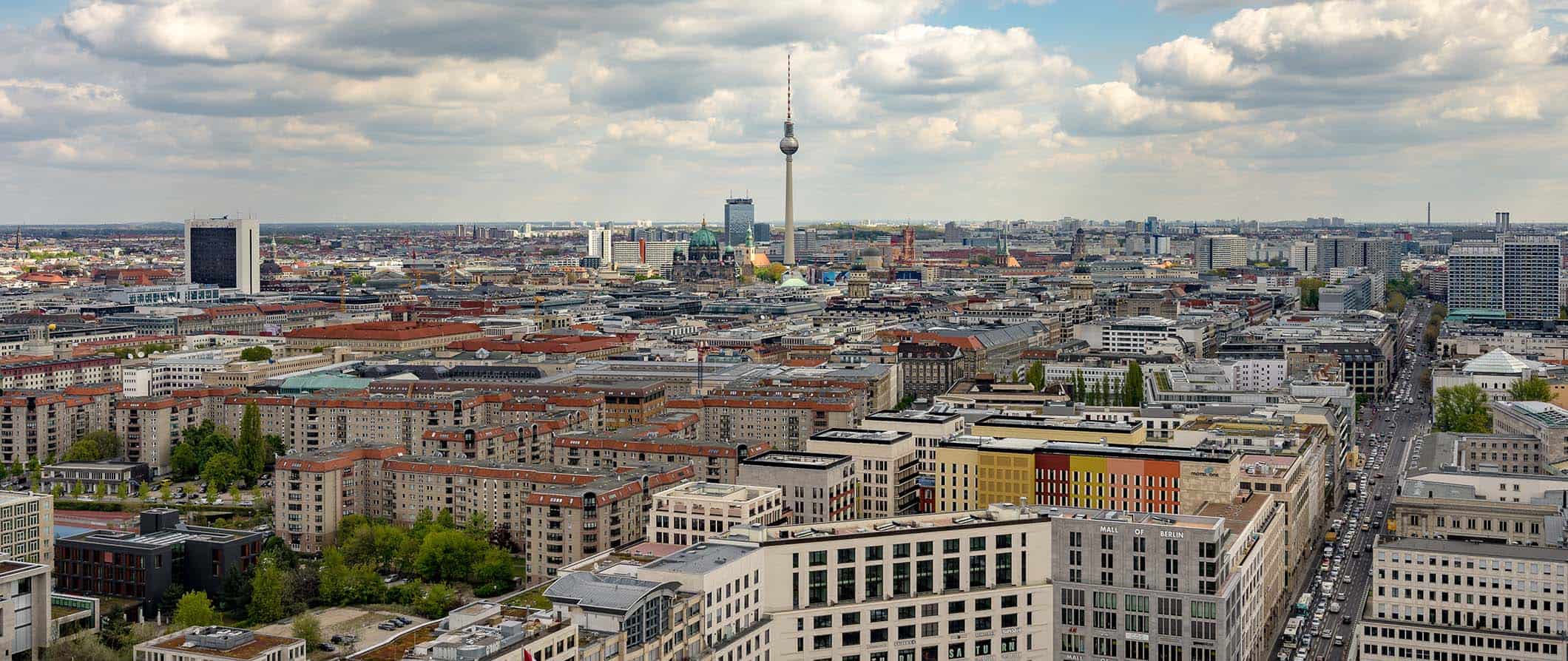
Public transportation – Berlin is a sprawling city, but it’s incredibly well connected by its subway (U-Bahn) and above-ground train system (S-Bahn). You can even get to the outlying neighborhoods quickly. A single ticket is 3 EUR and is good for up to 90 minutes. If you’re outside the AB zone, the ticket price increases. For example, a ticket to Brandenburg Airport is 3.80 EUR.
You can purchase tickets on the platform or via the BVG app. Always keep your ticket on you as random checks on the train are common.
A day ticket with unlimited travel in Zones AB (Berlin city proper) costs 8.80 EUR, and a week pass is 36 EUR. You can use your tickets across the train, tram, and bus network, but be sure to check your route ahead of time.
There are a handful of tram lines around Berlin’s central neighborhoods, but they’re not as fast or efficient as the trains. Ticket prices are the same as the train.
There are also over one hundred bus lines around Berlin that get you anywhere you need to go, especially on weeknights after the trains shut down. Ticket prices are the same as the trains and trams.
Bicycle – Berlin is incredibly easy to cycle around, with well-marked bicycle lanes. Most bicycle rentals start at 5 EUR per day. Bike-sharing programs like Donkey Republic, nextbike and Call a Bike offer rentals for 1 EUR per 30 minutes or 9 EUR for the day. Nextbike also offers day passes for 3 EUR with which you get the first 30 minutes of each rental free. A week pass offering the same is 15 EUR.
Taxi – Taxis are not cheap here, but you’ll rarely need to use one. The base rate is 4 EUR, and it’s an additional 2 EUR per kilometer afterward. Skip them if you can.
Ridesharing – Uber is available in Berlin, but you shouldn’t need to use it much, if at all, as the public transportation here is fast and reliable.
Car rental – Car rentals start at 30 EUR per day for a multi-day rental, however, you won’t need one unless you’re leaving the city. Even then, the bus and train system can likely get you where you need to go for cheaper. Renters need to be at least 21 years old.
When to Go to Berlin
Spring and summer are peak seasons in Berlin (especially May-September). The whole city comes alive as people get out to enjoy temperatures in the 30s°C (high 80s°F). This is really when Berlin’s parks and markets come alive so I’d try to visit during this time if you can. Just book your accommodation in advance.
While winters are dark and cold with temperatures dropping to 0°C (32°F), Berlin doesn’t get a lot of snowfall and the Christmas season is magical — mostly due to the city’s many Christmas markets. You avoid the tourist crowds during this time as well.
How to Stay Safe in Berlin
Berlin is pretty safe, but like all big cities, there is petty crime (such as pickpocketing). Be careful on busy public transit and around crowded tourist attractions, especially in Alexanderplatz. ATM scams are unfortunately also a problem here. Whenever possible, withdraw money from inside a bank where you know there are security cameras and/or guards.
Violent crime is rare but avoid certain areas of town like Kottbusser Tor, Görlitzer Park, Neukölln, and Volkspark Hasenheide after dark if you’re traveling alone. The area around Warschauer Straße station is a natural nightlife hub where ridiculously drunk people always end up. Be mindful of your whereabouts and your belongings, as this place is a hotspot for pickpocketing and sometimes even assault.
It’s no secret that drugs are big in Berlin. Much of the drug exchange happens at Kottbusser Tor – if you’re walking through here, do so with caution.
When out at the bar, always keep an eye on your drink and never leave it unattended. Additionally, never walk home alone if intoxicated, especially if leaving a club late at night.
If you’re worried about getting scammed you can read about common travel scams to avoid here.
If you experience an emergency, dial 112 for assistance.
The most important piece of advice I can offer is to purchase good travel insurance. Travel insurance will protect you against illness, injury, theft, and cancellations. It’s comprehensive protection in case anything goes wrong. I never go on a trip without it as I’ve had to use it many times in the past.
Berlin Travel Guide: The Best Booking Resources
These are my favorite companies to use when I travel. They consistently have the best deals, offer world-class customer service and great value, and overall, are better than their competitors. They are the companies I use the most and are always the starting point in my search for travel deals.
- Skyscanner – Skyscanner is my favorite flight search engine. They search small websites and budget airlines that larger search sites tend to miss. They are hands down the number one place to start.
- Hostelworld – This is the best hostel accommodation site out there with the largest inventory, best search interface, and widest availability.
- Booking.com – The best all around booking site that constantly provides the cheapest and lowest rates. They have the widest selection of budget accommodation. In all my tests, they’ve always had the cheapest rates out of all the booking websites.
- HostelPass – This new card gives you up to 20% off hostels throughout Europe. It’s a great way to save money. They’re constantly adding new hostels too. I’ve always wanted something like this and glad it finallt exists.
- Get Your Guide – Get Your Guide is a huge online marketplace for tours and excursions. They have tons of tour options available in cities all around the world, including everything from cooking classes, walking tours, street art lessons, and more!
- The Man in Seat 61 – This website is the ultimate guide to train travel anywhere in the world. They have the most comprehensive information on routes, times, prices, and train conditions. If you are planning a long train journey or some epic train trip, consult this site.
- Rome2Rio – This website allows you to see how to get from point A to point B the best and cheapest way possible. It will give you all the bus, train, plane, or boat routes that can get you there as well as how much they cost.
- FlixBus – Flixbus has routes between 20 European countries with prices starting as low 5 EUR! Their buses include WiFi, electrical outlets, a free checked bag.
- SafetyWing – Safety Wing offers convenient and affordable plans tailored to digital nomads and long-term travelers. They have cheap monthly plans, great customer service, and an easy-to-use claims process that makes it perfect for those on the road.
- LifeStraw – My go-to company for reusable water bottles with built-in filters so you can ensure your drinking water is always clean and safe.
- Unbound Merino – They make lightweight, durable, easy-to-clean travel clothing.
- Top Travel Credit Cards – Points are the best way to cut down travel expenses. Here’s my favorite point earning credit cards so you can get free travel!
- BlaBlaCar – BlaBlaCar is a ridesharing website that lets you share rides with vetted local drivers by pitching in for gas. You simply request a seat, they approve, and off you go! It’s a cheaper and more interesting way to travel than by bus or train!
Berlin Travel Guide: Related Articles
Want more info? Check out all the articles I’ve written on backpacking/traveling Germany and continue planning your trip:
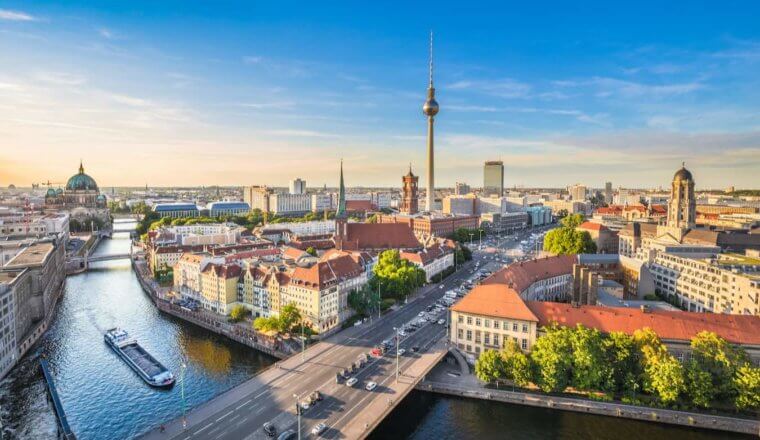
Where to Stay in Berlin: The Best Neighborhoods for Your Visit
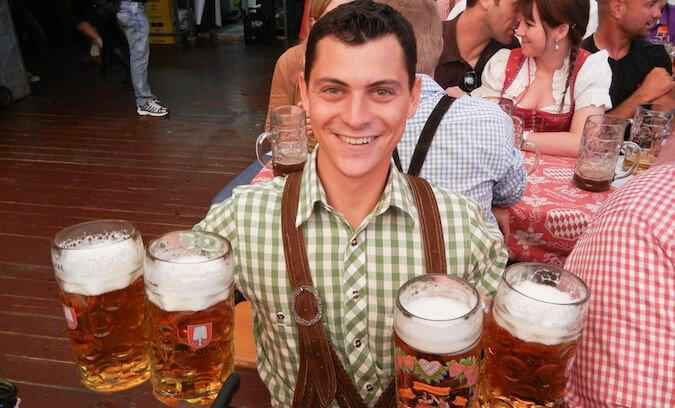
How to Survive Oktoberfest
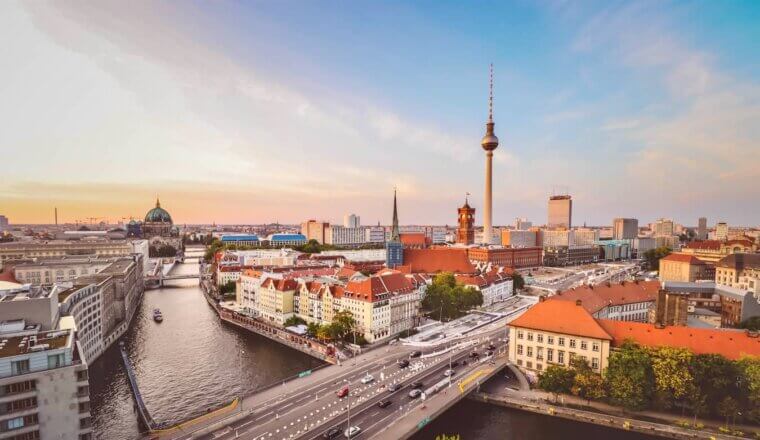
The 18 Best Things To Do in Berlin
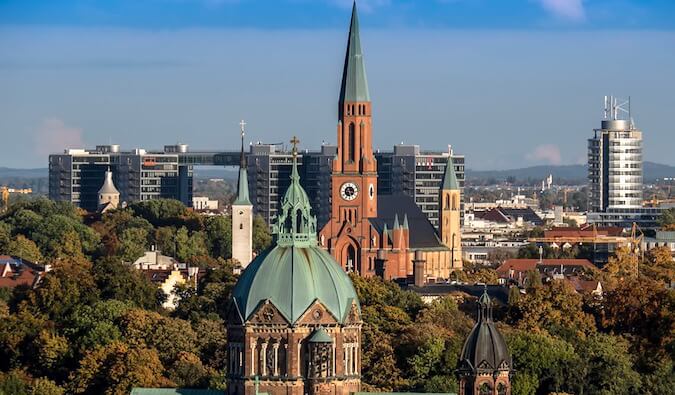
Munich is Better than Berlin
Get your free travel starter kit.
Enter your email and get planning cheatsheets including a step by step checklist, packing list, tips cheat sheet, and more so you can plan like a pro!

- Where To Stay
- Transportation
- Booking Resources
- Related Blogs
Germany Travel Blog
Home » Places » Europe Travel Blog » Germany Travel Blog
Germany holds a special place in my heart. It is my second home. After living here for 15 years of my life, and had so many of our life changes take place here, it will always be a huge part of my heart. Jim and I were married here; we had our two daughters here. It’s an integral part of us.
With all the beautiful towns, castles, fortresses, rivers, fun activities for all ages, and great food, you will love it, too. I really hope that if you are considering a trip to Europe you plan to see some of Germany. You won’t regret it.
Germany Travel Guide
From north to south, Germany if full of things to do and see. The country is clean, well-organized, has fantastic public transportation as well as well-maintained roads, and the history is amazing!
You can easily spend a few weeks traveling around this amazing country and still want to come back for more. Germany is more than its big cities, much more, but it’s a good place to start.
Location and Visa
Germany is very centrally located, and is bordered by Denmark, Poland, Czech Republic, Austria, Switzerland, France, Luxembourg, Belgium, and the Netherlands. All of these countries , like Germany, are part of the Schengen region , so it is super easy to rent a car or take a train and see multiple countries in one trip without adding an exorbitant amount of time.
Listen to our podcast about our Top 5 Cities to Visit in Germany
Pin Germany Travel Guide for later planning!
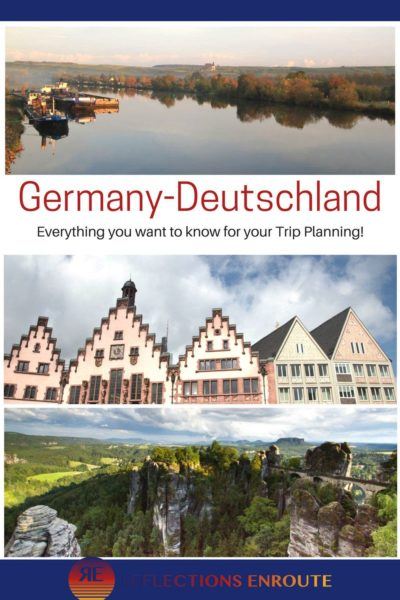
Transportation
Of course everyone has heard of the famous, no speed limit autobahns that traverse the entire country. I think driving in Germany should be on everyone’s bucket list, especially since there are no tolls.
Driving in Germany is pretty easy. People follow the rules, and everything is well-maintained and well-signed. I highly recommend renting a car and getting out to some of the beautiful towns. Overall, the Germans have transportation within the country down to an art form.
Germany has many international airports. The major airlines usually fly into Frankfurt, Munich, or Dusseldorf. However, if you are flying around Europe you will find many budget airlines flying to smaller airports all over the country.
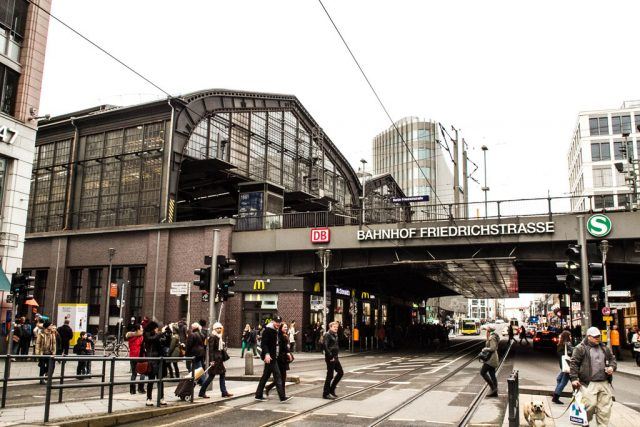
The Deutsche Bahn is also a very well-run organization, and German trains run notoriously on time. I have only been on one train that had a delay. It was a big deal. We were delayed three minutes in the middle of winter when we were going from Schweinfurt to Frankfurt. Three minutes. You can read much more about using the German train system, and make sure to go to the DB website to see if you can get any deals.
You can also use your Eurail pass anywhere in Germany. Check out our post of using ours to travel through Eastern Europe , starting right where we lived in Weiden, Germany.
There are also a number of bus companies running in Europe that will take you across borders, from city to city. It’s cheap, reliable, and relatively comfortable with bathrooms on board. We’ve seen Flixbus pretty much on every highway we’ve driven.
Getting Around Germany
Not only is it easy to get around the country using trains, cars, and buses. It is very simple using public transportation within cities. All larger cities have a U-Bahn or S-Bahn, but even if they don’t the bus system is amazing.
Power Tip : If you will be doing a lot of sightseeing, especially in some of the larger cities, make sure to check your options for day or multi-trip tickets. In Bavaria, you can travel between cities for a mere fraction of the cost by using the Bavaria ticket. Most train offices have at least one person who speaks English, so always ask.
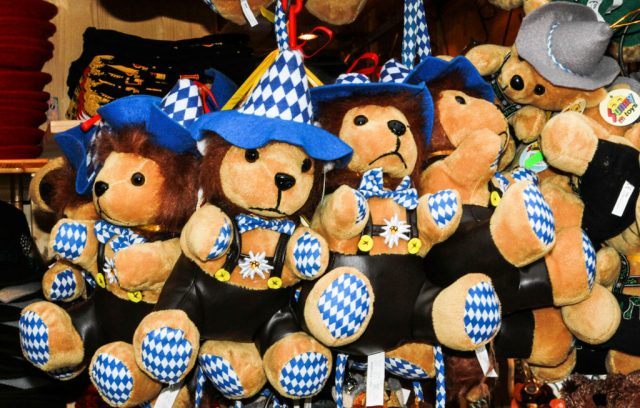
Germany uses the Euro. For a normal main course at any regular restaurant, you will pay anywhere from 12 – 22 Euros, which is approximately $14-26. I know that is a huge jump, but it all depends on the size of the city. Plan to pay the higher prices in Frankfurt, Munich, Berlin, or restaurants very near a major tourist sight.
ATMs and Banks
You can find ATMs everywhere.
Credit Cards vs. Cash
Germans still largely use cash, but in most restaurants and stores you can use a credit card just about everywhere. Of course, you will want to have cash when going to a local market.
Health and Safety Concerns
Vaccinations.
As usual, it is imperative that your normal vaccines are up to date. Many doctors will suggest you also take your Hepatitis A and B as well.
The water is safe, and you can drink or fill your water bottles from any tap. Decorative fountains often have signs that say the water is non-potable, so refrain from drinking that water from public fountains.
There are plenty of pharmacies all over Germany, and you should be able to find an open one any day of the week, even on Sundays. Just check with your hotel to ask where the closest one is.
If you are traveling with prescription drugs, keep your latest prescription handy as well as keep the medication in its original bottle. If you need a refill, you will have to show the doctor or pharmacist your current prescription.
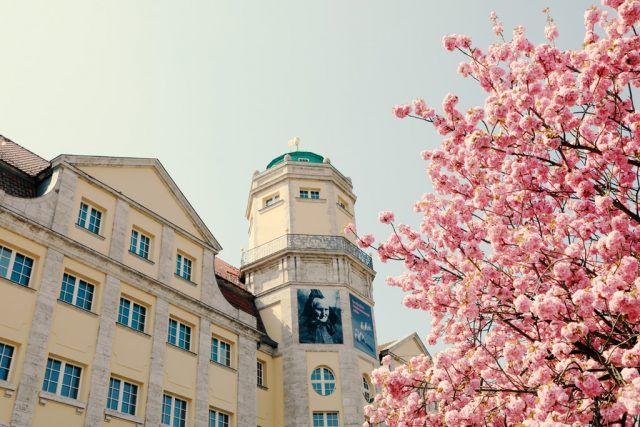
When is the Best Time to Go?
There is something to do and see in Germany all year long. Each season brings a new set of things to do, sports and activities, as well as festivals and foods. Spring can be a little rainy and still chilly, but once that lime green of new growth starts popping and the early spring trees like the cherry trees and magnolia start blooming, there is nothing like it.
Restaurants put a blanket on their outside tables, and everyone takes advantage of the sun when it’s shining. It can be one of the most beautiful parts of the year, and the temperatures keep you moving whether by walking or biking or even kayaking.

Summers are amazing. The temperature rarely gets much over 80 degrees Fahrenheit, and the days are long so you can go from early, early morning until after dinner with great light. Every window is adorned with brilliant red geraniums, the flower beds are manicured and stunning, and everyone is happy to be outdoors whether they are sporting or just having a cup of coffee. The Germans take their major vacation weeks in August, so before then it’s still not too over crowded.
Fall is my favorite season in Germany, not only because the air is crisp and clean, but also because it’s harvest season and there are so many festivals to go to and check out the local foods, beer, and wines!
Winters can be bleak and gray, with a lot of rain, but the mountains have snow to ski and sled, and the museums and castles are open all year long, so you can go inside. Of course, the month before Christmas are the famed Christkindlmarkts all over the country, and if you’ve never done one that is a great time to visit.
Travel Tips for Germany
Germany is chock a block full of things to do, outdoors and indoors, cultural and sporty. Check out all the cool things you can find to see and do:
Germany has an amazing array of food choices. It doesn’t shy away from very hearty, fried and fat-filled goodness to the healthy vegan, vegetarian options. There truly is something for everyone. Some iconic dishes that you will want to try are the endless variety of sausages, schnitzels, and breads. Ice cream in Germany is something special as well. Have you ever heard of spaghetti “eis” or ice cream? Well, take it from us, you will want to make sure to try it on your next stop!
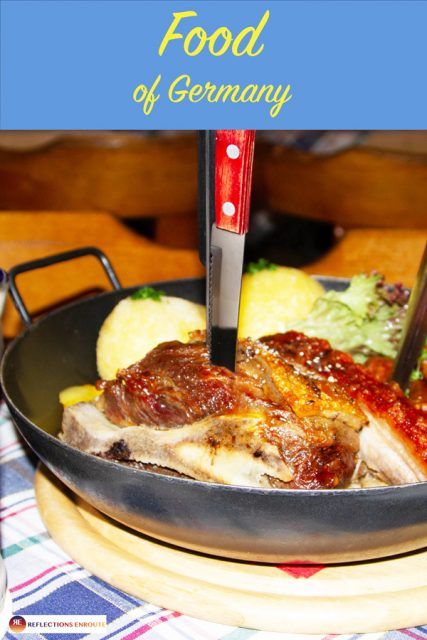
Top Germany Destinations You’re Sure To Love
Berlin Rothenburg ob der Tauber Nuremberg Trier Frankfurt Regensburg Berchtesgaden Quedlinburg Moedlareuth
You can’t go wrong planning a trip to Germany. It’s got castles, military history, world heritage sites, beer fests, wine fests, all kinds of fests, and the activities and things they have to do with children is fun and educational. Pin Germany Travel now!
Wednesday 23rd of November 2022
We are arriving in Munich and want to take the MVV Bus #65 from the airport to Freising and connect with a train to Passau. Where do we find the bus at the airport terminal? We will purchase a Bayern Ticket to do this.
Sunday 4th of December 2022
Hi Mary Beth, when you exit baggage claim/customs turn right and head out the door. The bus stop is outside that door. You're looking for MVV bus 635 to get to Freising. You should ask at the info desk after arriving just in case the bus stop has been moved for construction, etc. Have a great trip!
Corinne Vail
Monday 28th of November 2022
Mary Beth, Yes, taking the Bayern ticket will definitely save you some money! Have fun!
- BLOGGERS DATABASE
- SUBMIT YOUR BLOG
News Reader
Brand Monitoring
Blogger Outreach or Influencer Marketing
Combined Newsletters
Embeddable RSS Widgets
RSS Combiner beta
Select Page
- Get 250k Bloggers, Podcasters and Media outlets with email contacts. Export Full Database
- Request Bloggers Contacts
- Export Contact List
35 Best Germany Travel Blogs and Websites

- Cheryl Howard » Germany
- The Guardian » Germany
- Birchys Berlin Tours
- Thinking Nomads » Germany
- eTurbo News » Germany Travel
- Wyld Family Travel
- Immer auf Reisen - Deutschland und die Welt entdecken - Immer auf Reisen
- GREEN TRAVEL BLOG
- An Adventutous World » Germany
- My Germany Vacation Blog
- Germany is Wunderbar Blog
- Travel to Germany Blog
- Insider Tour Berlin Blog
- That Backpacker » Germany
- Berlin & Around
- Drifter Planet » Germany
- Nina Travels » Germany
- Paul Riedel
- Travels of Adam » Germany
- California Globetrotter
- Germany on the Brain
- Traveling German
- Megan & Aram » Germany
- TravelMag » Germany
- Tourist Is A Dirty Word Blog
- Germany Destination Blog
- Destination Germany
- Berlin Tales - Berlin Boundless: Maximize Your Travel Experience
- Outdoor Handbuch Blog
- Germany Travel Blog
- Tripovisor Travel Blogs
Germany Travel Bloggers
- Germany Travel Newsletter
Germany Travel Blogs
Here are 35 Best Germany Travel Blogs you should follow in 2024
1. Cheryl Howard » Germany

2. The Guardian » Germany

3. Birchys Berlin Tours

4. Thinking Nomads » Germany

5. eTurbo News » Germany Travel

6. Wyld Family Travel

7. Immer auf Reisen - Deutschland und die Welt entdecken - Immer auf Reisen

8. GREEN TRAVEL BLOG

9. An Adventutous World » Germany

10. My Germany Vacation Blog

11. Germany is Wunderbar Blog

12. Travel to Germany Blog

13. Insider Tour Berlin Blog

14. That Backpacker » Germany

15. Berlin & Around

16. Drifter Planet » Germany

17. Nina Travels » Germany

18. Paul Riedel

19. Travels of Adam » Germany

20. California Globetrotter

21. Germany on the Brain

22. Traveling German

23. Megan & Aram » Germany

24. TravelMag » Germany

25. Tourist Is A Dirty Word Blog

26. Germany Destination Blog

27. Destination Germany

28. Berlin Tales - Berlin Boundless: Maximize Your Travel Experience

29. Outdoor Handbuch Blog

30. Germany Travel Blog

31. Tripovisor Travel Blogs

- German Expat Blogs
Media Contact Database
Why list and promote your blog on feedspot.
Top 16 Travel Blogs for Germany
Germany is wunderbar, traveling german, my life in germany, the backpacker, travels of adam, destination germany, oh god, my wife is german, leipzig travel, germany travel, germany travel guide, keith & amanda, berlin on a budget, wanderlust chloe, drifter planet, adventure in you.
© VidaLingua
- South Africa
- Afghanistan
- North Korea
- Adventure + Outdoors
- Amusement Parks
- Backpacking Trips
- Boating + Cruises
- Budget Travel
- Bus + Train Travel
- Coasts + Islands
- Country Trips
- Fall Vacations
- Family Vacations
- Green Travel
- Heritage + History
- Honeymoons + Romance
- Inspiration + Guide
- Landmarks + Attractions
- LGBT Travel
- Markets + Bazaars
- National Parks + Reserves
- Nature + Wildlife
- Parks + Gardens
- Pets + Animals
- Photography
- Airlines + Airports
- Budgeting + Currency
- Business Travel
- Celebrity Travel
- Customs + Immigration
- Deals + Rewards
- Family Travel
- Hotels + Resorts
- Luggage + Packing Tips
- Offbeat News
- Photography Tips
- Responsible Travel
- Solo Travel
- Tech + Gear
- Travel Etiquette
- Travel Warnings
- Bars + Clubs
- Celebrity Chefs
- Restaurants + Cafés
- Wine + Vineyards
- Beach Hotels
- Boutique Hotels
- Hotel Openings
- Hotel Reviews
- Luxury Hotels
- Mountain + Ski Resorts
- Spa Resorts
- Vacation Rentals
- Asia Cruises
- European Cruises
- Festivals + Events
- Museums + Galleries
- Style + Design
- Travel’s Best
- Hotel with Agoda.com
- Hotel with Booking.com

Where to go in Bali? 19+ must-see & best places to…
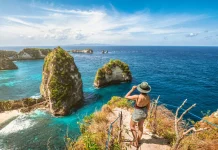
The Budget Detailed Bali itinerary 5 Days 4 Nights
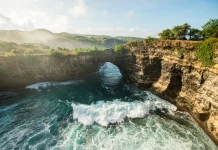
Bali itinerary 4 days. Suggested where to go & what to…

What, where to eat in Nha Trang? — 11+ best places…
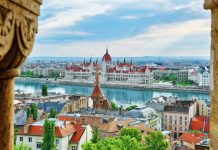
Where to travel in Hungary? 35+ best places to visit in…

The complete Seoul subway guide: How to use, lines, fares for…

How much does it cost to travel to Korea? Tips on…

The ultimate guide to NETS FlashPay Card: What is it, how…

How much will it cost to go to Singapore? Tips on…

Must eat in India — 12+ most popular, famous & best…

Langkawi food review — Yummy and cheap junk food at Langkawi…

What to eat in Laos? — 15+ famous, most popular &…

Mövenpick Resort Kuredhivaru Maldives reviews. The detailed review of my vacation…

Hyatt Regency Danang Resort and Spa reviews. The resort is highly…

+7 luxury resorts you must stay in Danang, Vietnam

Top hotels in Siem Reap — 8+ best places to stay…

10 must-know things for your best first time European river cruise

Top 3 best luxury cruises in Halong Bay, Vietnam

Cherry blossom festival Korea 2024 — Top 5 cherry blossom festivals…

Ghibli museum blog — The fullest Ghibli museum guide for first-timers

Kyoto festival — Top 10 best events & most famous festivals…

National Palace Museum Taipei blog — What to see in National…

Japanese waterfall — Top 10 most beautiful waterfalls in Japan in…

19+ most beautiful towns in Europe every tourist need to visit…

Georgia travel photos — 20+ captivating photos show Georgia is heaven…

Explore Damnoen Floating Market — The oldest floating market of Thailand

Visiting Fenghuang Ancient Town — One of the most charming ancient…

Mekong Delta travel blog — Beyond rivers of Southwestern Vietnam

14 reasons why you should travel when you are young

Shigaraki Tanuki – An animal symbol of good luck in Japan

Living in the charms of cave houses in Andalucia, Southern Spain

20+ jaw-dropping tiny homes around the world
Munich travel blog — the fullest munich travel guide for first-timers.
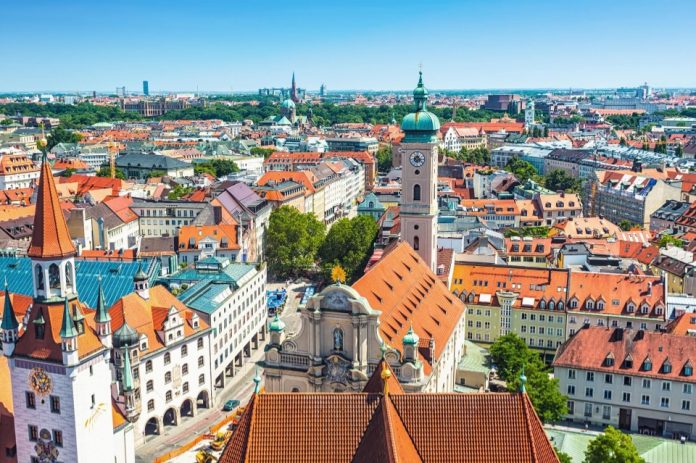
Famous for its dreamy, quaint beauty and first-class civilization, Munich is considered as ‘Germany’s most livable city’. And the information, as well as the full and detailed guide to Munich below, will surely help you have a convenient journey to discover Munich. So, is Munich worth visiting, what to do in Munich and how to plan a perfect budget trip to Munich, Germany for the first-time? Let’s check out our Munich travel blog (Munich blog) with the fullest Munich travel guide (Munich tourist guide, Munich city guide, Munich guide, Munich visitor guide) from how to get to Munich, best time to come, where to stay, best places to visit, what to eat and things to do in Munich to find out the answer!
- What to buy in Germany? — Top 19+ gifts, souvenirs & best things to buy in Germany
- Zugspitze blog — The fullest Zugspitze travel guide for a spectacular Zugspitze trekking trip
- Dresden travel blog — The fullest Dresden travel guide for first-timers
- Frankfurt travel blog — The fullest Frankfurt travel guide for first-timers
- Bonn travel blog — The fullest Bonn travel guide & what to do in Bonn Germany
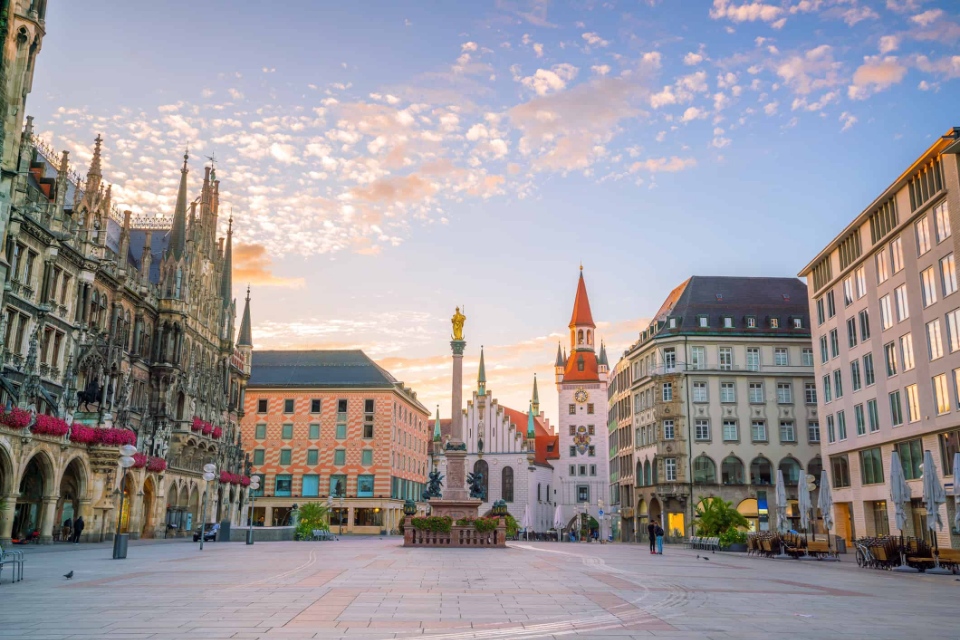
Munich – the capital of the regions of Bavaria, and the Germany’s third largest city, is located next to the gentle river Isar and the majestic Alps. That charming scenery combined with a long list of architectural works and historical treasures has turned Munich a great choice for those who love Germany in particular and Europe in general.
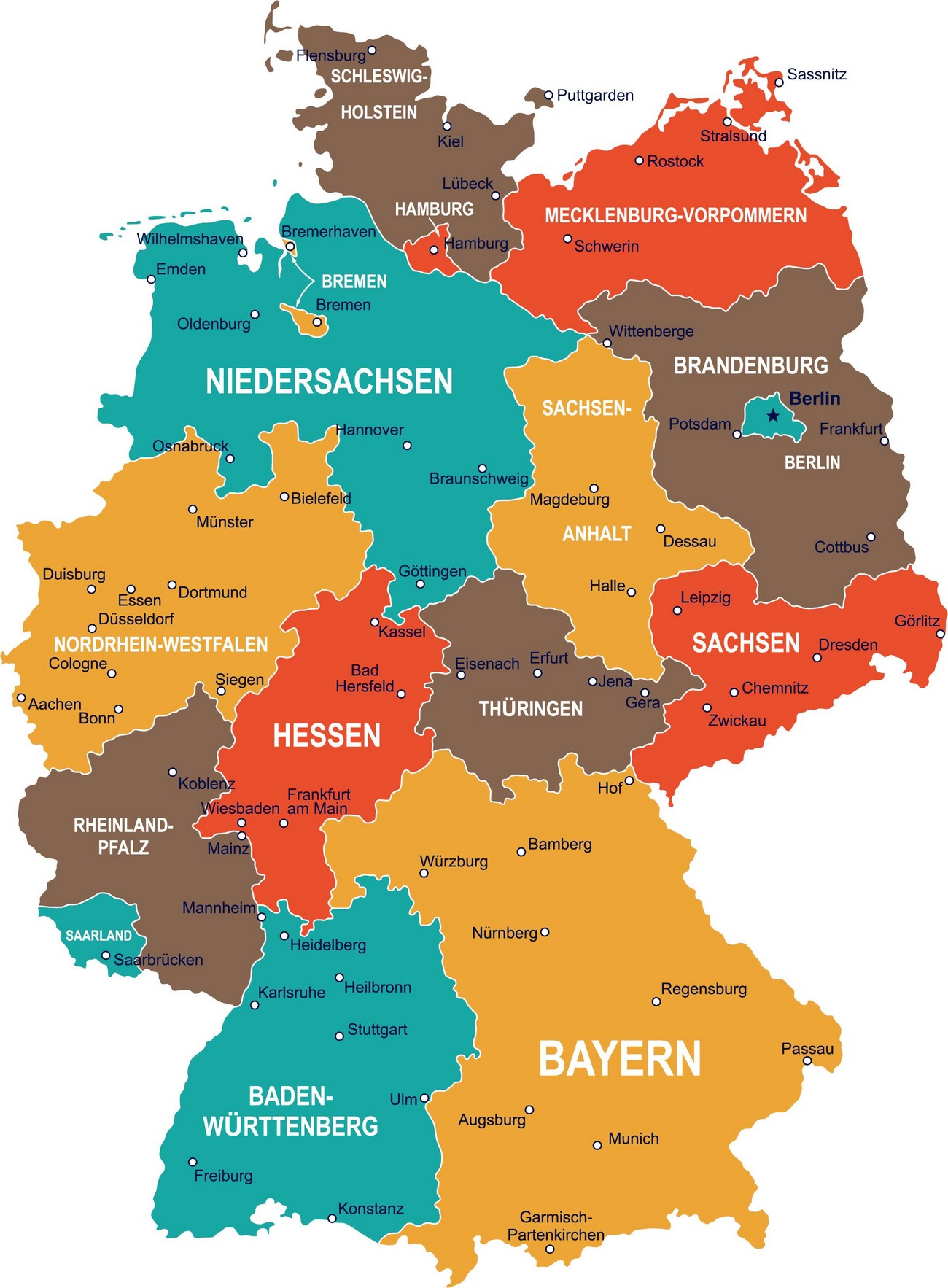
Munich travel blog: Overview of Munich
Munich or München is a city and also the capital of the state of Bavaria, Germany. Munich is the last major city in the southernmost part of Germany. Munich (Munich) is a city located in the south of Germany belongs to the Free State of Bavaria, about 600km from Berlin. Munich has a history of more than 800 years, has been the capital of the state of Bavaria since 1806 – the richest state in Germany. With a population of more than 1.5 million, Munich is the third largest and most prosperous city in the German Confederation after Berlin and Hamburg.
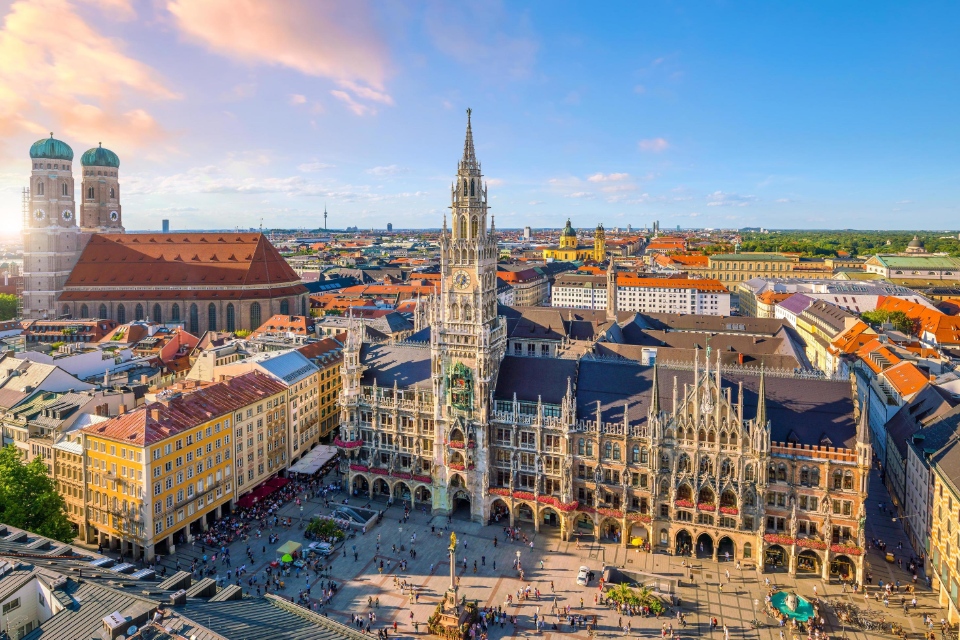
Set foot in this beautiful city, visitors will have the opportunity to explore many famous tourist attractions such as: Parks with rich ecosystems, museums where ancient collections are well preserved, magnificent, splendid palaces, ancient architectural works,… all bring the best experiences for tourists. In particular, the city of Munich is also home to the most famous Oktoberfest beer festival in Germany, and around the world.
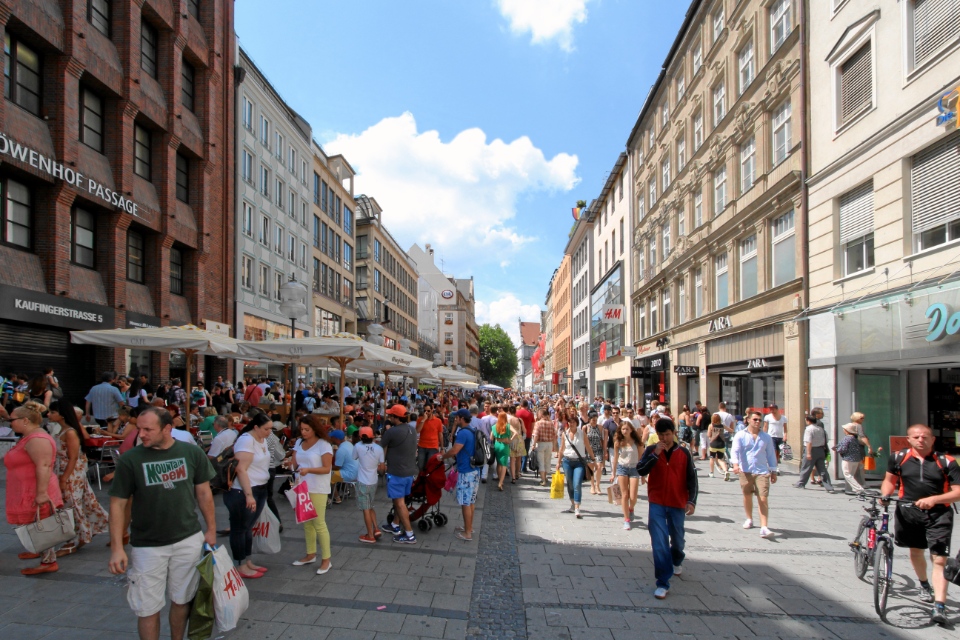
Coming to Munich, you will visit the old town with spectacular churches, quaint streets, as beautiful as any other European city. Munich also has the charming Schloss Nymphenburg palace. The English Garden is also a masterpiece of a place to hang out, especially in summer and autumn. When visiting the BMW factory and its museum, remember to stop by the beautiful Olympic Village and climb up the TV tower to enjoy the panoramic view of the city from above. Those who love football also can go to the famous Arena Allianz football field.
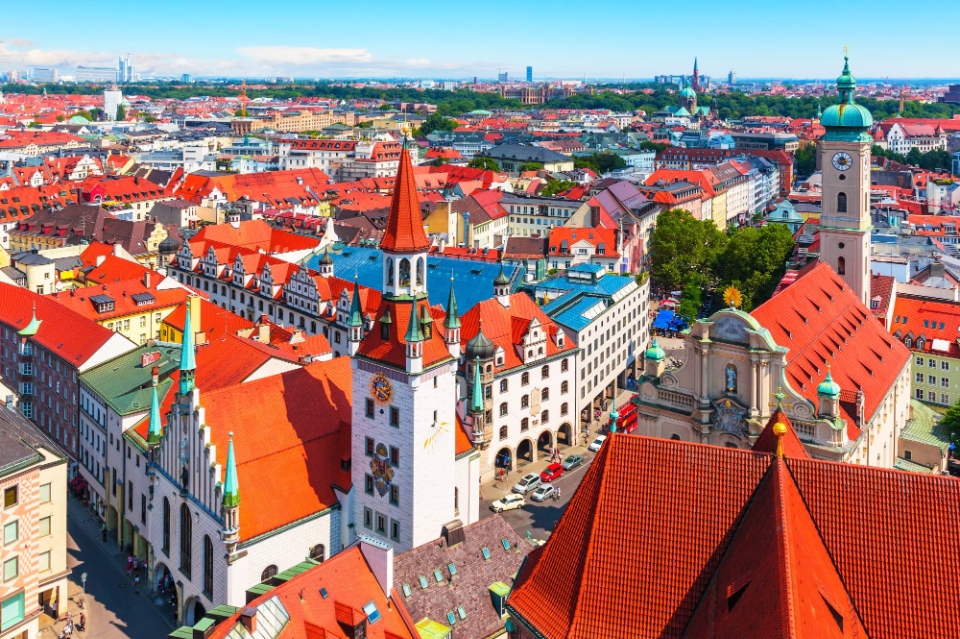
Not only a popular tourist destination, Munich is also an important transit point for you to travel from Germany to Austria (Salzburg) or to Switzerland (Zurich). Munich Station and Munich Bus Station are always bustling with trains and buses to surrounding cities. In the South German region, if you have a few days, you can visit cities around Munich that are very beautiful and attractive such as Fussen, Nürnberg (Nuremberg)…
Munich blog: When is the best time to visit Munich?
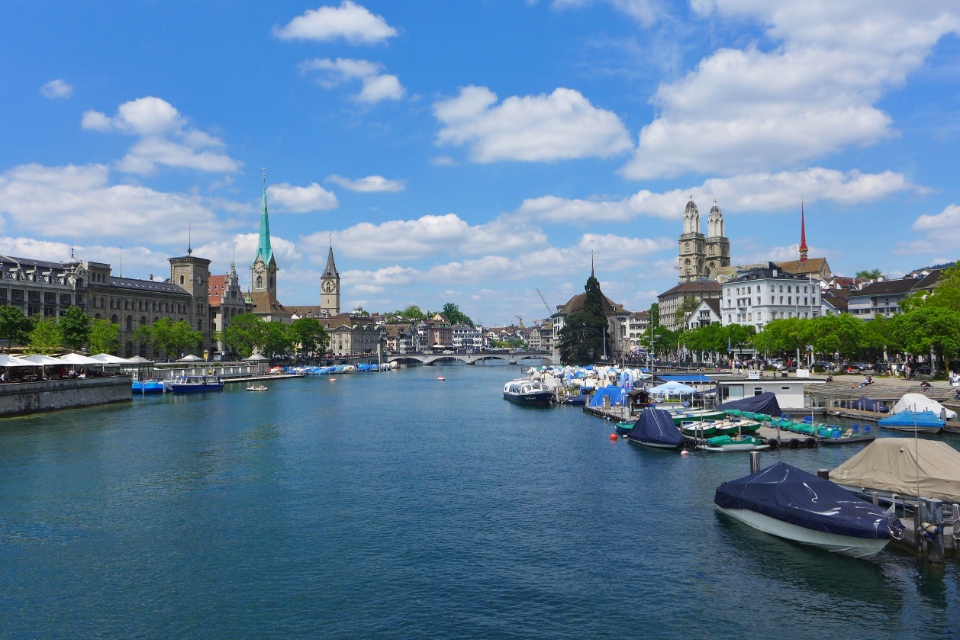
Munich has bold climate characteristics typical of Germany and is divided into 4 distinctive seasons of the year: Spring (March to May) – Summer (June to August) – Autumn (September to November) – Winter (From December to February next year). In particular, the winter temperatures are quite low, can drop to – 6 to 1.5 degrees Celsius. Therefore, this time there are less tourists, so if you want to save money, this is the good time to come Munich for a budget trip. In addition, if you travel to Munich in the winter, you also have the opportunity to participate in many great events and festivals here such as: Christmas, New Year, … also very interesting.
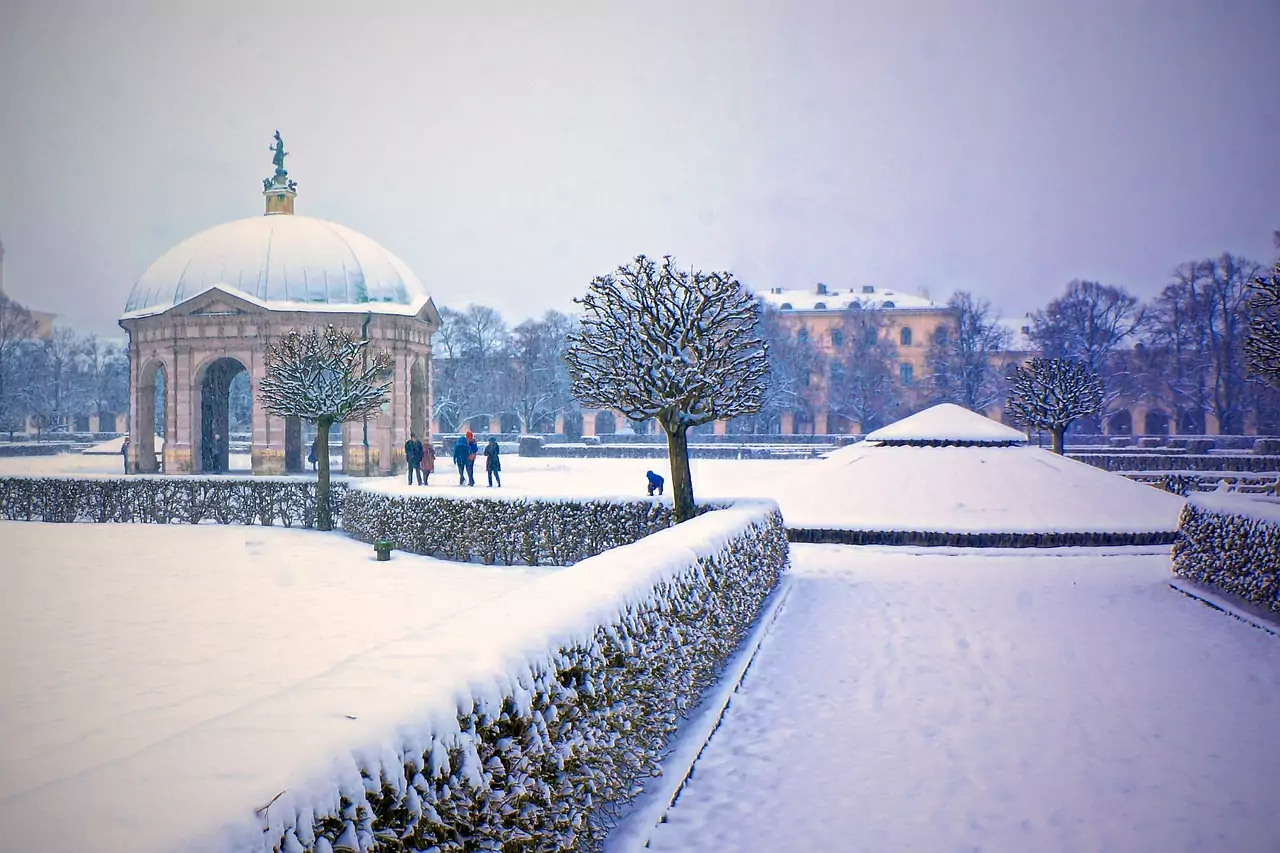
Summer is the most beautiful time to travel and at the same time this is also the peak tourist season in Munich. Because at this time, the weather is warm and airy, the – 27 degrees Celsius, very suitable for sightseeing, take part in outdoor activities as well as enjoy the spring scenery.

However, autumn in Munich is especially beautiful, poetic with the Isar river dyed with yellow leaves on its both banks, and the English Garden is like wearing a new yellow coat of mother nature. Usually, the period from October 20 to November 5 is the most beautiful time for yellow leaves. However, it depends on weather which may vary from year to year. Autumn is also the time for the world’s most famous Oktoberfest beer festival. So if you can, go to Munich in the fall is also a ideal time.
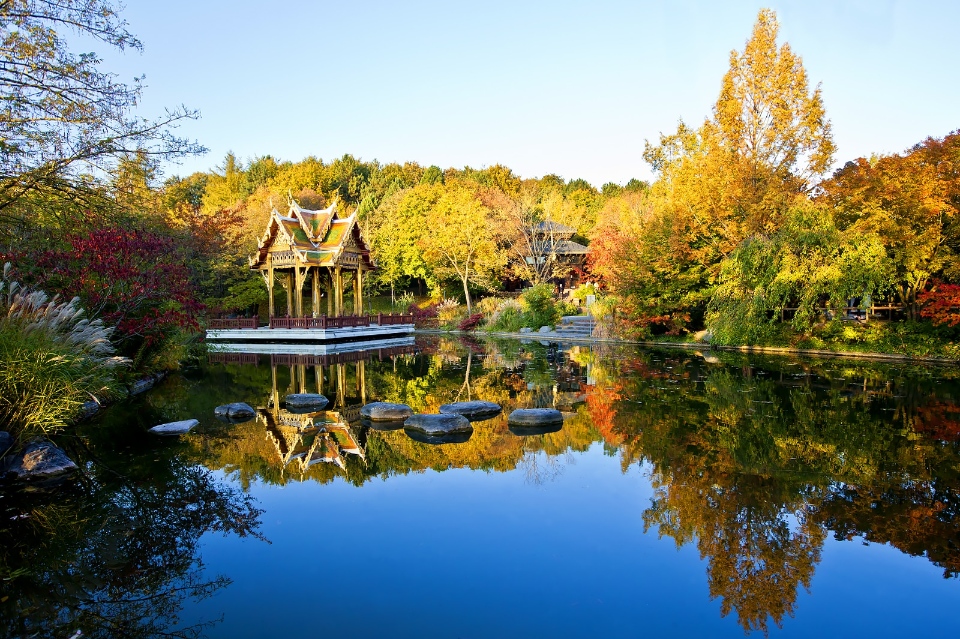
Munich travel guide: How to get to Munich?
Franz Josef Strauss (Munich International Airport) is the largest airport in the city of Munich. Every day, this airport receives more than 3,000 domestic flights and nearly 8,000 international flights. And from Vietnam, if you want to catch a flight Munich, you can choose to depart from Noi Bai International Airport (Hanoi) or Tan Son Nhat International Airport (HCMC). Some airlines tourists can consider such as: Vietnam Airlines, Qatar Airways, China Southern Airlines, Thai Airways, Etihad Airways, Aeroflot Russian, Air China, Turkish Airlines, Air Berlin… The price ranges from 370 – 800 USD/way.
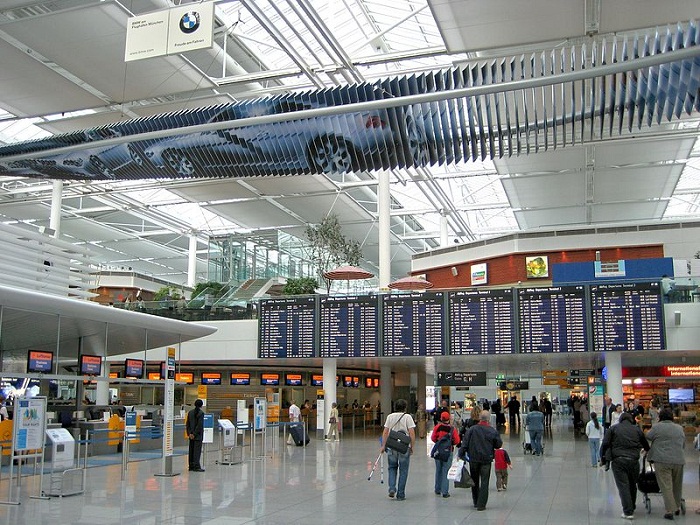
To choose a best route and cheap airfare based on your departure point you can access Google Flights , Skyscanner or Kayak to find.
To getting to Munich from other European cities by bus or train you can go to Omio to find the operators as well as suitable schedules.
Munich guide: How to getting around Munich?
Unlike many other German cities, Munich only serving tourists by bus services in many streets and bicycle rentals. Therefore, carefully review the place you need to go to, refer to the map to estimate the distance and choose the right vehicle. While buses are suitable for long trips and major routes, bicycles are often used to travel short distances, go for a walk or wander around alleys. The cost of both types of vehicles is quite cheap, but with bicycle rental, you need to ask the price in advance, the calculation method to estimate.
The public transport system in Munich is quite developed. When coming here, visitors can choose a bus for about 8-9 Euros/trip. Or rent a bicycle for 15 Euro/day to explore the city on your own.
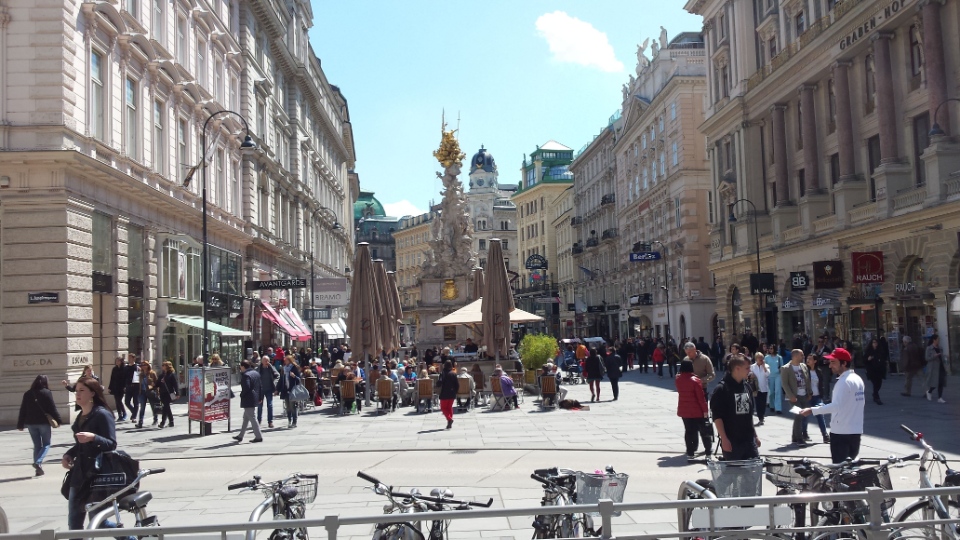
- Munich Grand Circle Hop-On Hop-Off City Tour
Bavaria Tickets
You should buy a regional day ticket for Bavaria. This is the most cost-effective way to getting around in Bavaria and the German city of Munich. Major cities such as Munich (München), Nuremberg (Nürnberg), Augsburg and Regensburg are all allowed to use this ticket for public transport such as trains, buses, trams…

With this ticket, you can also use it when traveling to (from) Munich Airport (MUC) and by train to (from) Memmingen / Munich THERWest Airport (FMM).
- Please note, this ticket cannot be applied for the Allgäu Express Bus.
- Bayern tickets are valid from 9am to 3am the next day.
- Another note is that you can only use this ticket when you traveling within the state of Bavaria. Local trains (Nahverkehr) that you see abbreviated symbols such as: IRE – RE – RB – S – UEC – D – TGV are free to travel.
- The Bavaria tickets, although issued by the largest national railway company of Germany (Deutsche Bahn), can also be used on most non-Deutsche Bahn trains operating in Bavaria.
- Alternatively, you can use your Bayern ticket on cross-border trains to Salzburg and Reute in Austria, but not on local buses or trains inside cities in Austria.
- In addition, if you want to traveling between cities, it only costs you about 22-24 EUR for a bus. Or 100 – 140 EUR if taking the train.
- Bicycle rental costs about 15 EUR per day.
- The cost for traveling from Berlin to Munich is around 24-34 EUR for a bus or 100-140 EUR for a train.
- From Munich to Cologne costs 30-50 EUR for a bus or 95-140 EUR for a train.

Munich travel blog: Where to go and what to do in Munich?
Marienplatz and neues rathaus (new town hall).
You shouldn’t miss Marienplatz before catching the last flight home. This is the most famous square in the city dating back to the 12th century, it was once the site of medieval markets, celebrations and tournaments. The first impression when coming here is to admire the Neues Rathaus town hall that stands out located in the middle of the square, with a facade of 300 feet long, ornate with hundreds of statues, turrets and glass arches surrounding the square. In addition, you also have the opportunity to enjoy Munich cuisine at many high-class restaurants here, visit a few luxurious cafes and see the city from above. If you step inside, you will feel the European breath clearly from the layout to the color scheme.
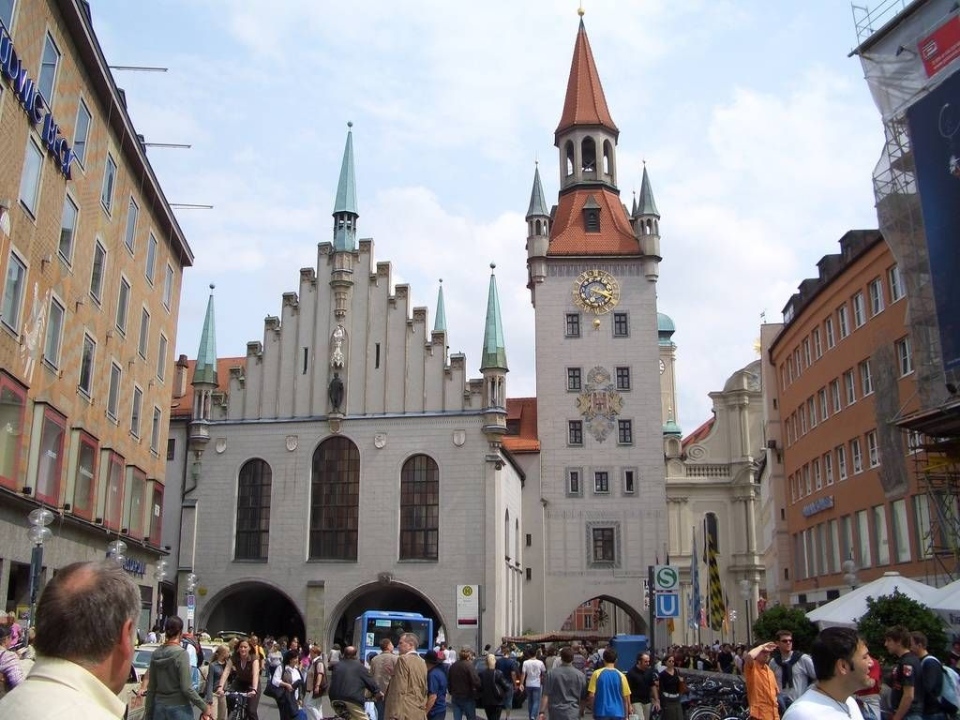
Located in the center of this historic Marienplatz square is the new City Hall – the most outstanding and monumental structure in the city, ordered to be built by King Ludwig I in 1867 and completed in 1909 in the Neo-Gothic style. Visit the town hall at 11 a.m. (November to February) and at 12 p.m. or 5 p.m. (May-October) to see the exquisite clock Glockenspiel and the show of the dolls on the balcony of the building.

Rathaus-Glockenspiel clock tower
The Rathaus-Glockenspiel tower was built in the early 20th century. The clock tower features 43 bells and 32 large statues, depicting the wedding of Duke Wilhelm V. The clock tower carries a historical period, once a culture of mighty Germany, this is a very popular tourist spot in Munich.
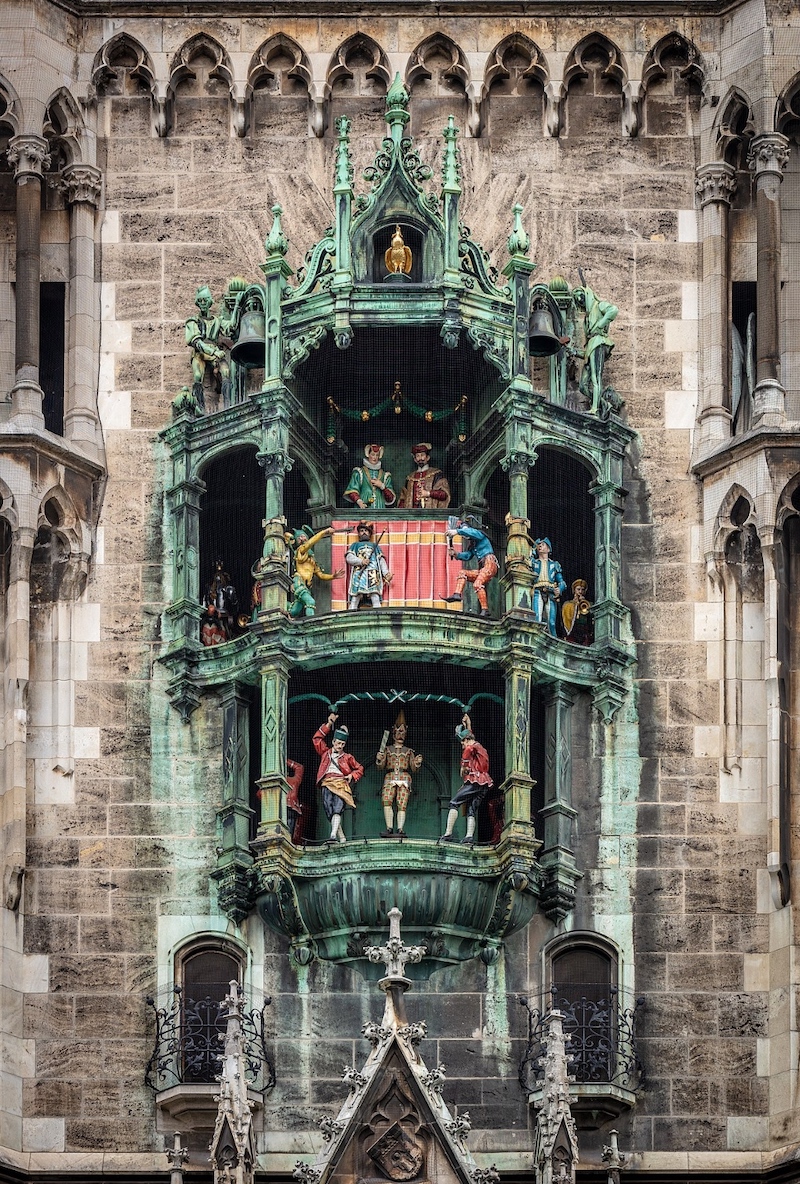
Do not hesitate to step inside because you will feel the European breath very clearly, from the layout to the color scheme. You should come here during the day to enjoy the bustling atmosphere as well as admire its magnificence.
Besides, you can also pay around 7 Euros to go to the top of the 85 meter high tower of the New Town Hall and enjoy the panoramic view of this beautiful city. For visitors, they will definitely spend time the most at Marienplatz. Because only a short distance from the new town hall is its “predecessor”, a somewhat smaller building but containing in it countless profound historical stories. Other sights in this old square are the Mariensäule (Mary’s Pillar) erected in 1638 and the Fischbrunnen fountain with its bronze decorations taken from the ruins of the old fountain from the 19th century.

Especially during the Christmas season, Marienplatz is the host of one of the most beautiful Christmas markets in Germany, on the occasion of Fasching, the square will also be packed with people watching dance performances Narren-Lindwurm.
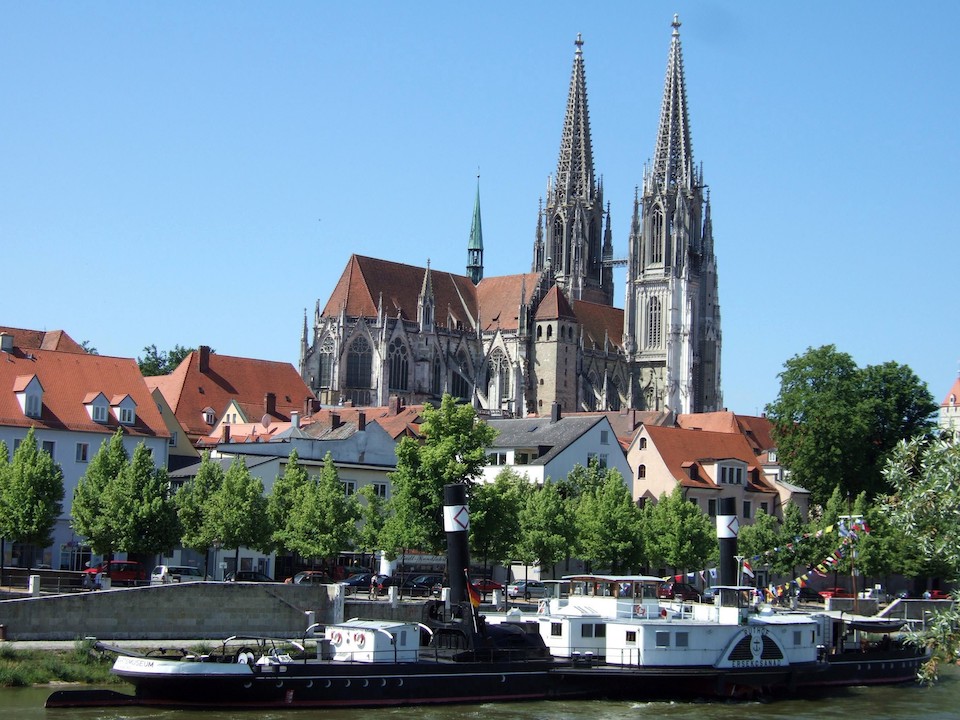
One of the tourist destinations that you should not miss when coming to Munich is Regensburg. This is a place of majestic and poetic beauty with a quiet Danube river on one side and ancient castles on the other. Coming here, visitors will have the opportunity to see a lot of ancient, palatial and magnificent architectural works with hundreds of years old age.
The place attracts a large number of tourists every year because it has two contrasting faces, one side is thousands of constructions and ancient buildings, and the other side is a vast and gentle river of the Danube bends around. The landscape here is likened to “the green silk scarf on the graceful shoulders of a European maiden”.
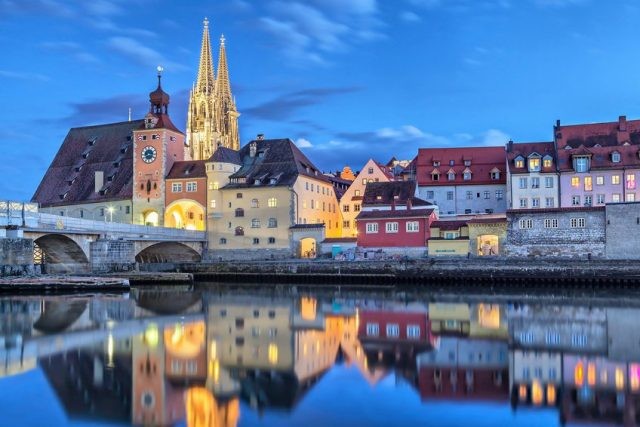
Victuals Market
Address: Viktualienmarkt 3, 80331 München, Germany
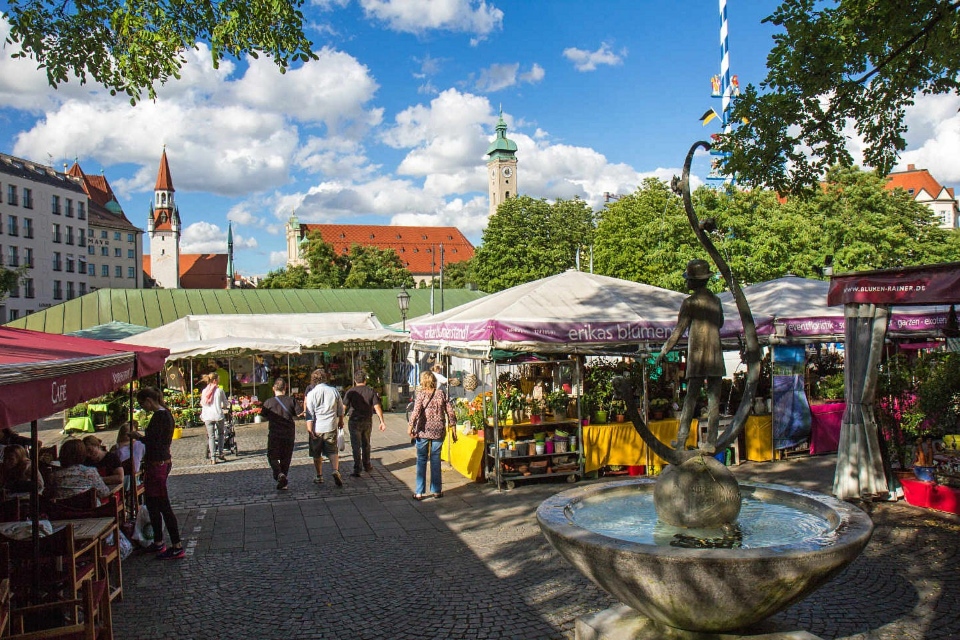
Vicuals is one of the largest open-air markets in Munich. The stalls here offer not only sell fresh vegetables and delicious fruit from the outskirts of the city, but also traditional Bavarian Schweinsax’n and Speck. A number of other goods and products are also on sale such as fresh seafood, nutritious cheeses from all over Europe and pure canned honey. However, Vicuals market is not only a farmers market, it also hosts a number of traditional and folklore events.

Frauenkirche (Church of Our Lady of Munich)
Address: Frauenplatz 12, 80331 München, Germany
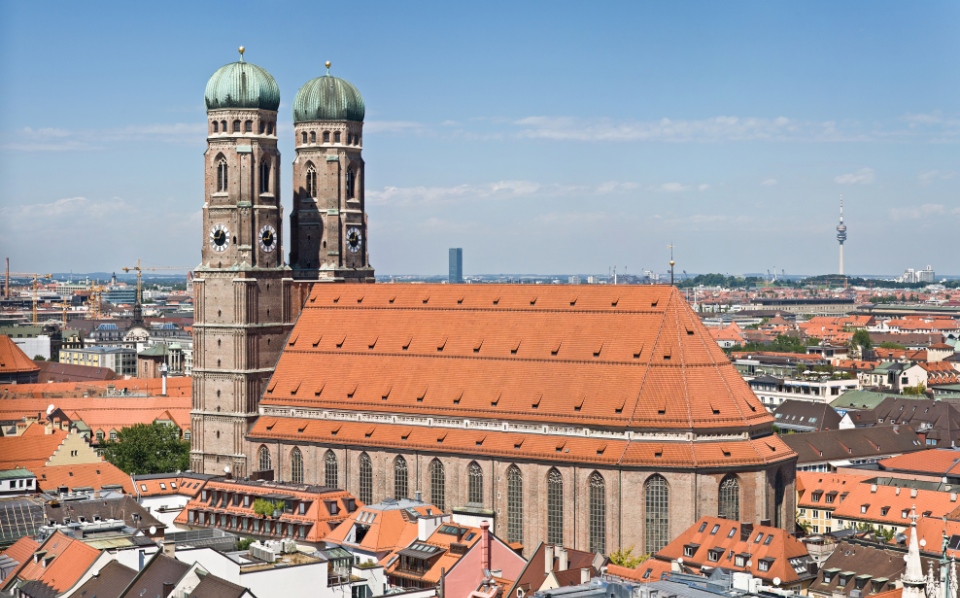
The Church of Our Lady of Munich is a place that has many impressions with religious tourists. However, you can come here to enjoy the great architectural masterpieces, see the intricate motifs on the domes and listen to the ringing bells. Frauenkirche is the main and most important church in the city, built in the 19th century in Gothic style. From a distance, this work can be recognized by two 100-meter-high towers with domes commonly found in Renaissance churches. On the steps at the entrance of the Frauenkirche was a very strange unidentified footprint. This is a prominent and most interesting highlight of the exterior of this church.
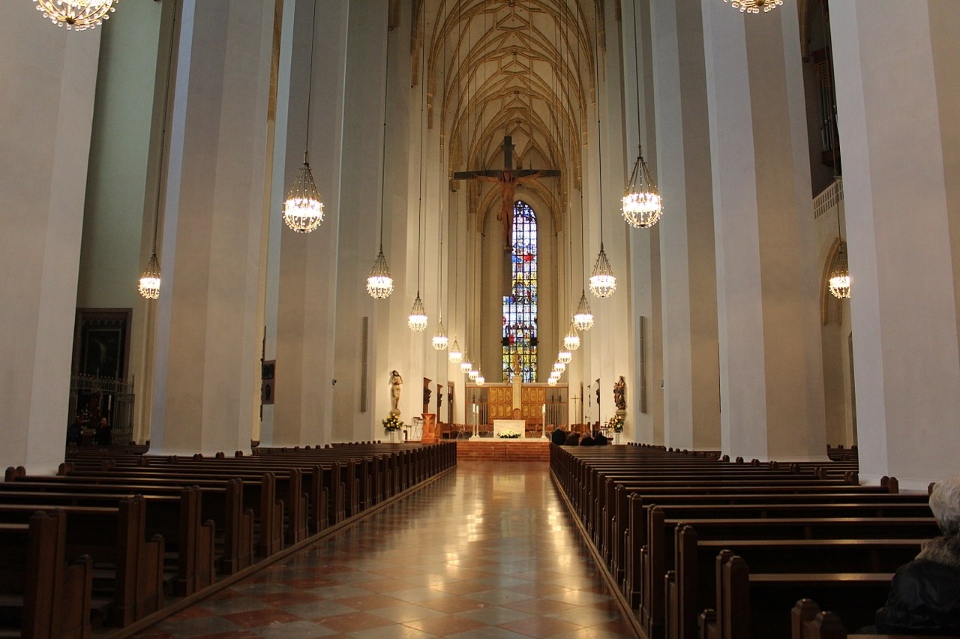
Deutsches Museum
Address: Museumsinsel 1, 80538 München, Germany Hours: 9AM–5PM/Friday: 12–8PM/Saturday: 10AM–8PM/Sunday: 10AM–5PM
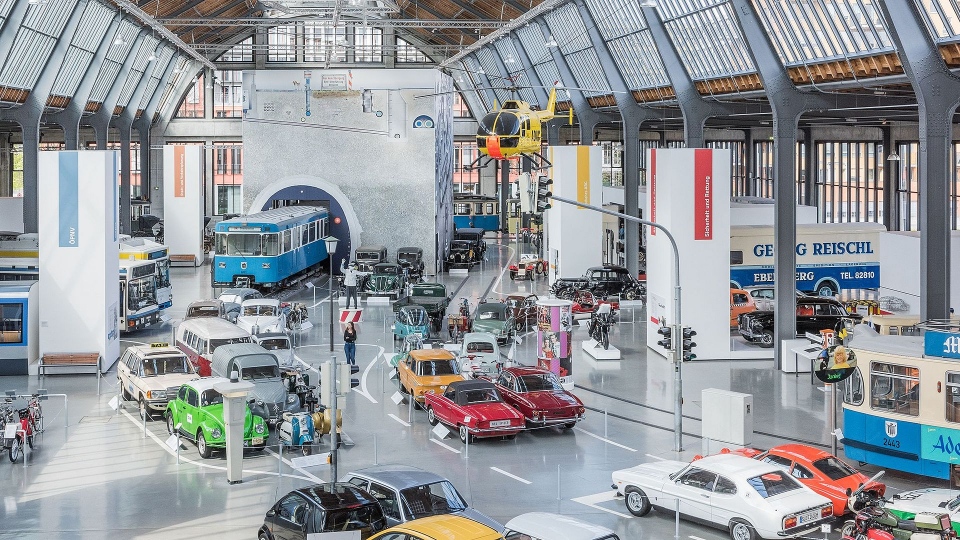
If you have a passion for science, issues related to construction, engineering,… then the Deutsches museum is a great stop. It is known that this is the largest engineering museum in the world, here visitors will admire the collection, equipment, machinery,… extremely unique and impressive. Admission to the Deutsches museum is about 4 Euros/student and 11 Euros for adults. This popular tourist attraction in Munich will not disappoint you.
English Garden (Englischer Garten)
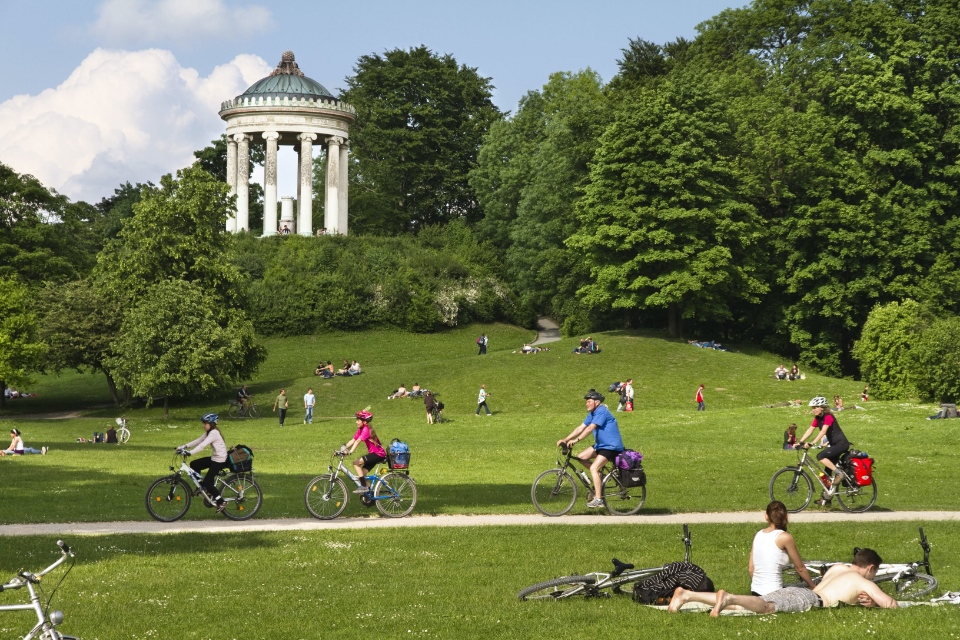
Englisher Garten is the largest botanical park in the city of Munich. The English garden owns a rich ecosystem, walking around the beautiful lakes, visitors will feel extremely relaxed and full of energy. The garden is a great place for picnics for those who love nature and escape the hustle and bustle of the city.
It also offers a wide range of recreational activities. You can come here to taste savory dishes at luxurious restaurants, visit a beer garden, sip a cup of Japanese tea or go for a bike ride. Because the air here is quite fresh, many tourists choose open lawns for camping, if you go with a group of friends, your family can also fully equip with convenient picnic equipment to have great experiences.
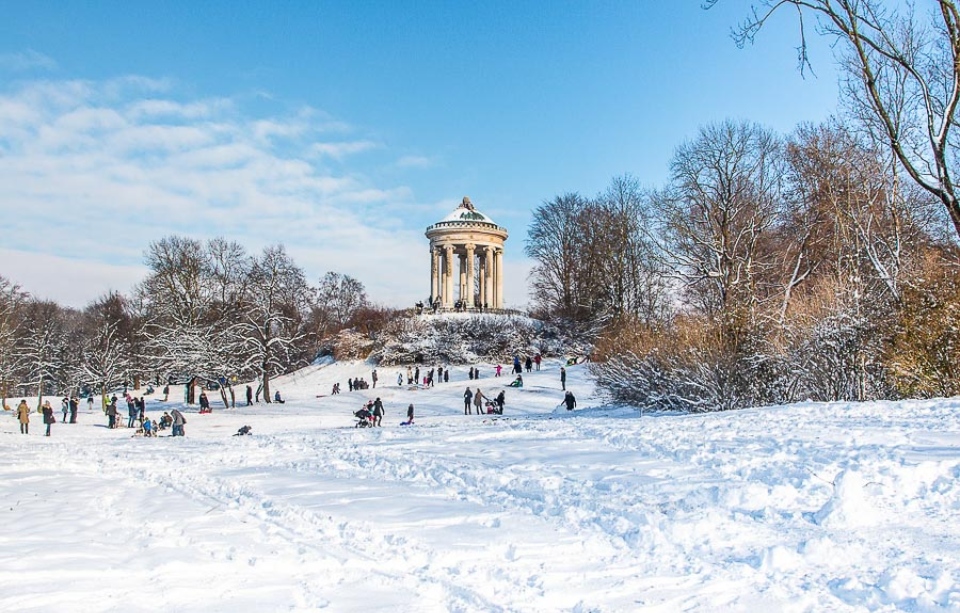
Nymphenburg Palace
Address: Schloß Nymphenburg 1, 80638 München, Germany
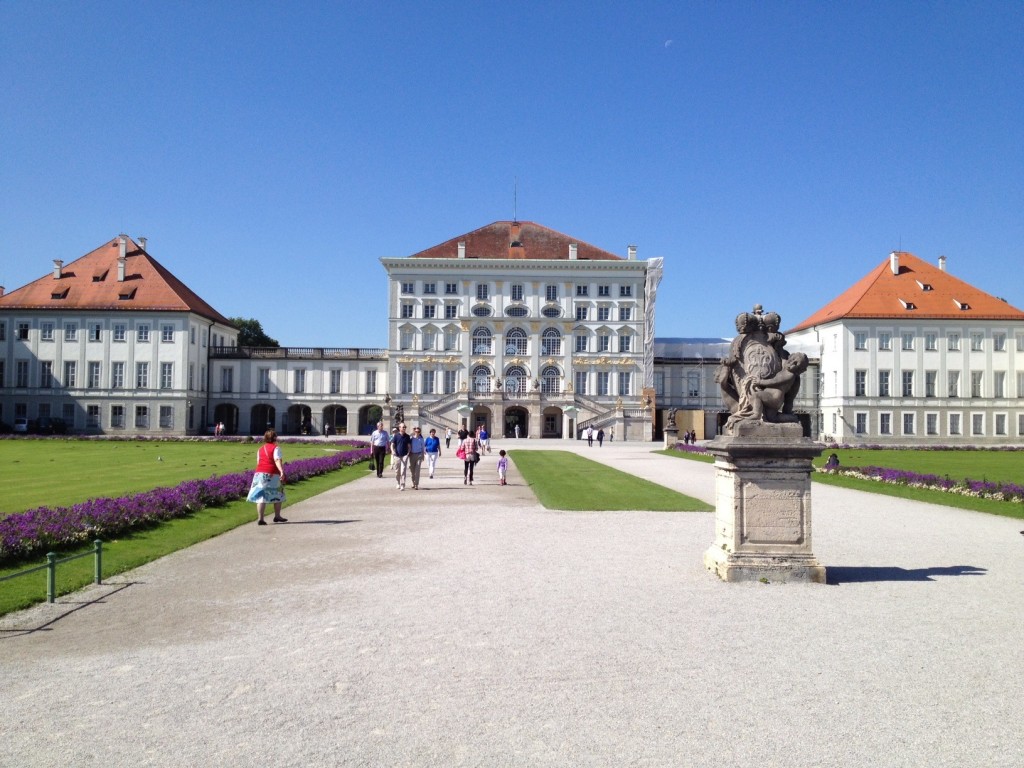
Nymphenburg Palace in Baroque, Baroque architecture, French Baroque architectural style is the summer residence of the German royal family. This place is known as the most beautiful palace in the world with its unique architecture and beautiful combination with the magnificent Baroque park. Explore the palace of more than 200 hectares, walk around you will admire the century-old sculptures or elaborately manicured trees. The interior is also extremely gorgeous, the large banquet hall is the highlight that looks extremely spectacular. In the peak season, the entrance fee is around 11.50 EUR, in the low season (from October to March), it only takes you 8.50 EUR to immerse yourself in the fresh air, enjoy fragrant flowers and take pretty pictures.

In addition, some visitors also spend many hours enjoying the fragrance at the flower garden on the premises, taking beautiful pictures and listening to the Kutang birds singing in the sky.
Eagle’s Nest
Address: Kehlsteinhaus, 83471 Berchtesgaden, Germany
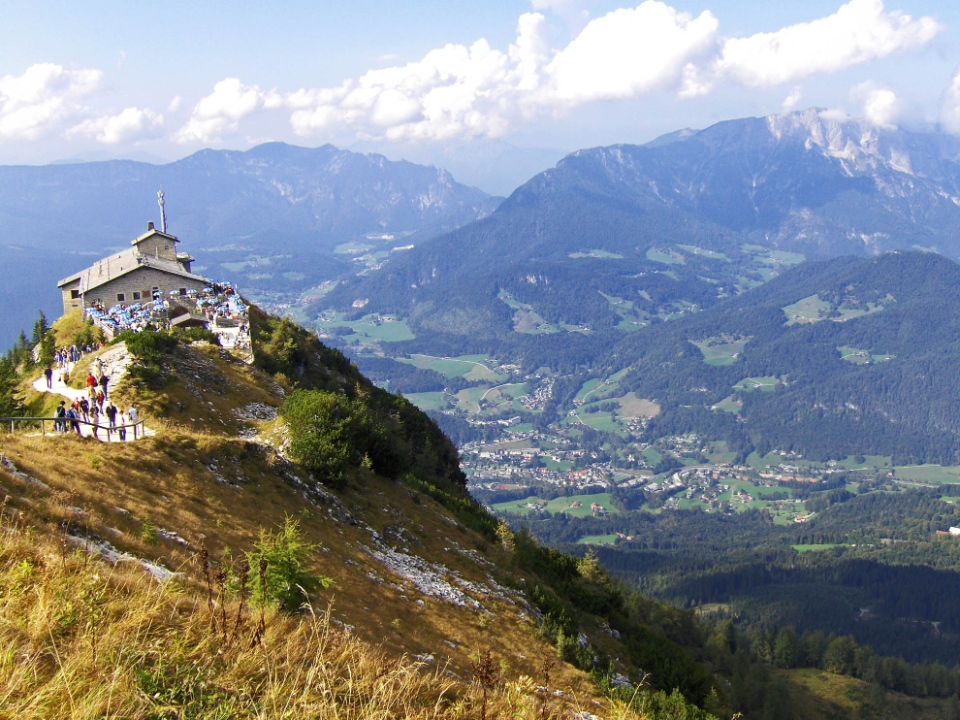
A very attractive place to visit in Munich that you should visit is the Eagle’s Nest. This was actually a place of withdrawal of Hitler’s army set up by Martin Bormann. During the war, thanks to this retreat location, Hitler escaped many times from allied bombing. Today, it has become a popular sightseeing spot in Munich, attracting a large number of visitors every day.
Herrenchiemsee Palace and Park
Address: 83209 Herrenchiemsee, Germany Hours: 9AM–6PM
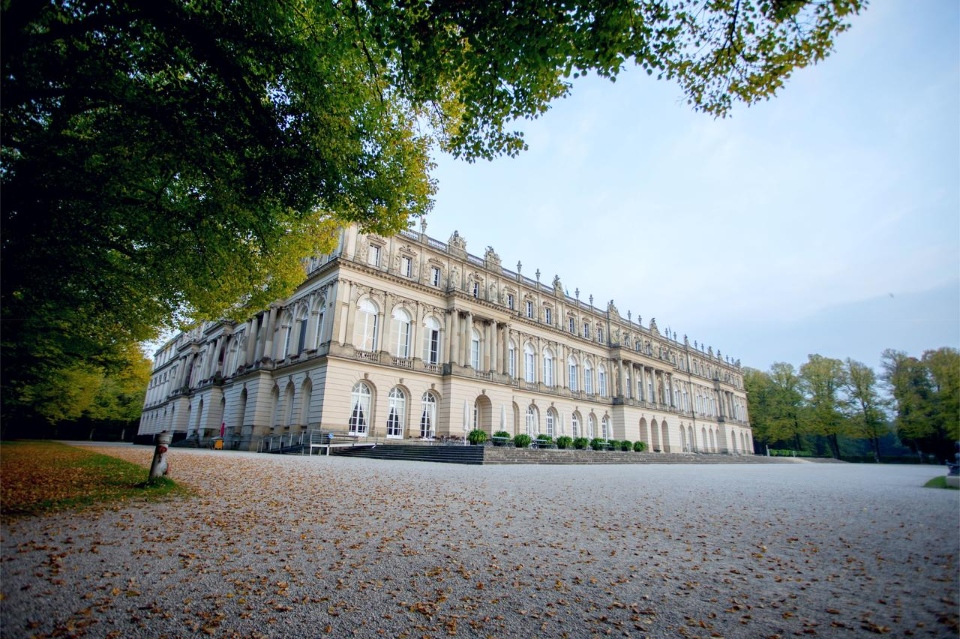
One of the most famous places in Munich is the Herrenchiemsee New Palace and Park. In the past, King Ludwig II used this palace as a residence for himself and the royal family. Coming here, visitors will be able to see firsthand a beautiful architectural work. The palace was built around the 14th century and for many years has always been in the top tourist attractions in Munich.
St. Peter’s Church
Address: Rindermarkt 1, 80331 München, Germany Hours: 7:30AM–7PM
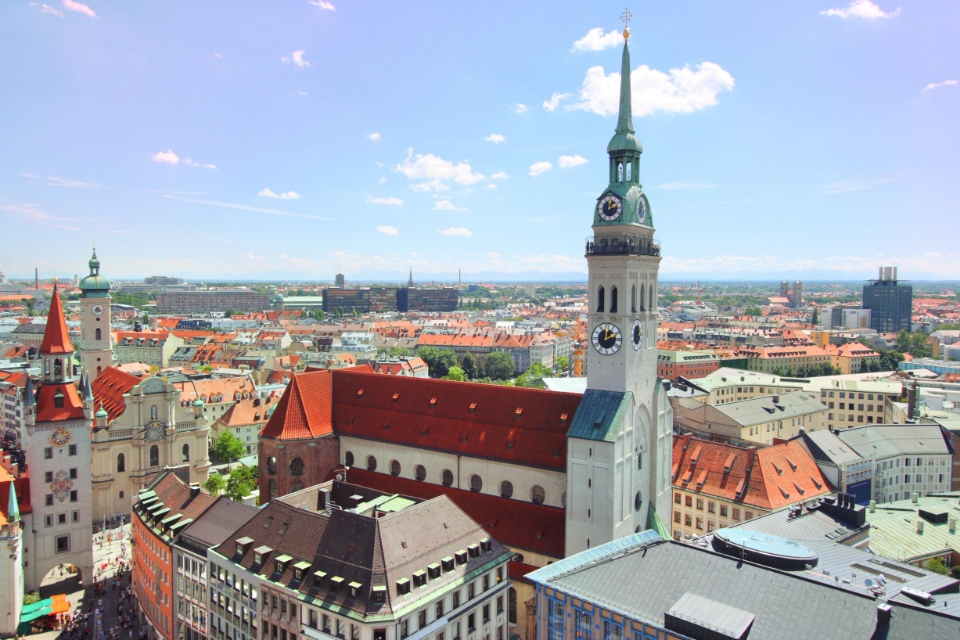
It is one of the city’s largest churches and also a famous tourist attraction in Munich. Coming here, visitors can not only discover the unique architectural design of the church, but also learn about the interesting religious culture here. In particular, when visiting St. Peter’s Church, do not forget to climb to the top of the church with 306 stairs, to see the whole city of Munich from above.
St. Peter’s Church is also the oldest parish church in Munich. Built in Gothic style, the church located on the Petersberg hill and famous for its 91-meter-high bell tower, allowing you to see the Alps perfectly. In addition, the church of St. Peter is also home to one of the world’s most interesting artifacts: the corpse of the Jeweled Skeleton of Saint Munditia.
Alte Pinakothek Museum
Address: Barer Str. 27, 80333 München, Germany Hours: 10AM–6PM/Tuesday, Wednesday: 10AM–8:30PM/Monday: Closed
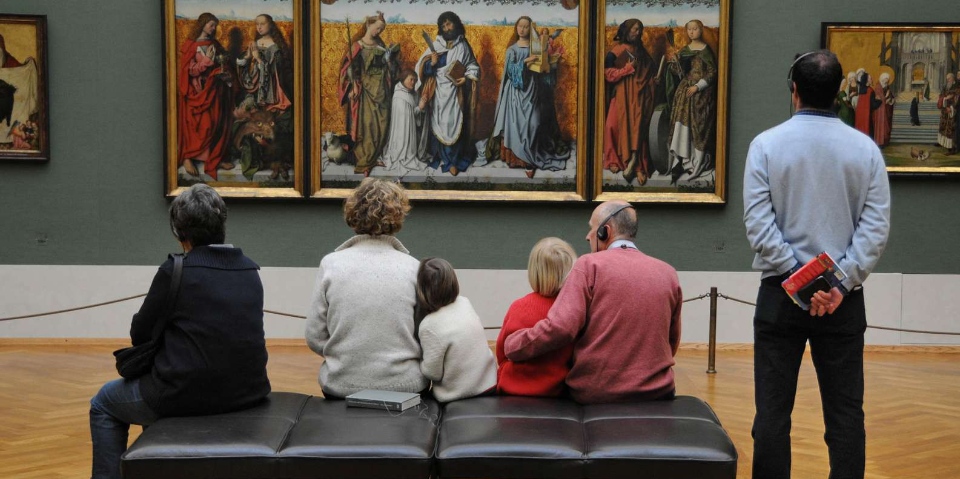
Art museum that stores more than 9,000 artworks, paintings from the Middle Ages, from famous artists and painters such as Titian, Frans Hals, Altdorfer and Albrecht Dürer… with admission of 4 EUR from Monday to Saturday, 1 EUR on Sunday.
Among the more than 100 museums and galleries that Munich tourists can choose to visit, the Alte Pinakothek Museum of Antique Painting is considered one of the most visited art archives. Housing in a building built in the Venetian Renaissance style with a collection of more than 9,000 paintings dating from the 14th to 18th centuries, painted by many of the world’s top artists such as Van Gogh, da Vinci or Rembrandt…
Address: Am Olympiapark 2, 80809 München, Germany Hours: 10AM–6PM/Monday: Closed
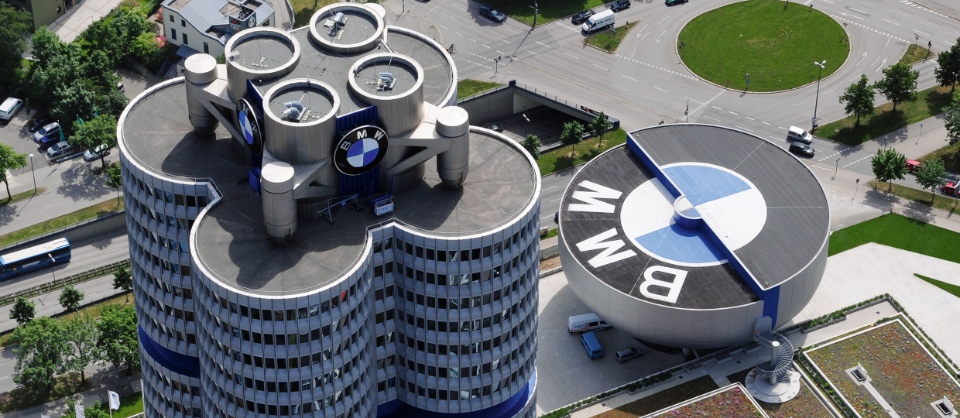
If you are a fan of BMW’s cars, the BMW museum should be at the top of your list of sights when traveling to Munich. Here, visitors can admire artifacts and stories about the development of cars and many other vehicles.
Bavarian National Museum
Address: Prinzregentenstraße 3, 80538 München, Germany Hours: 10AM–5PM/Monday: Closed
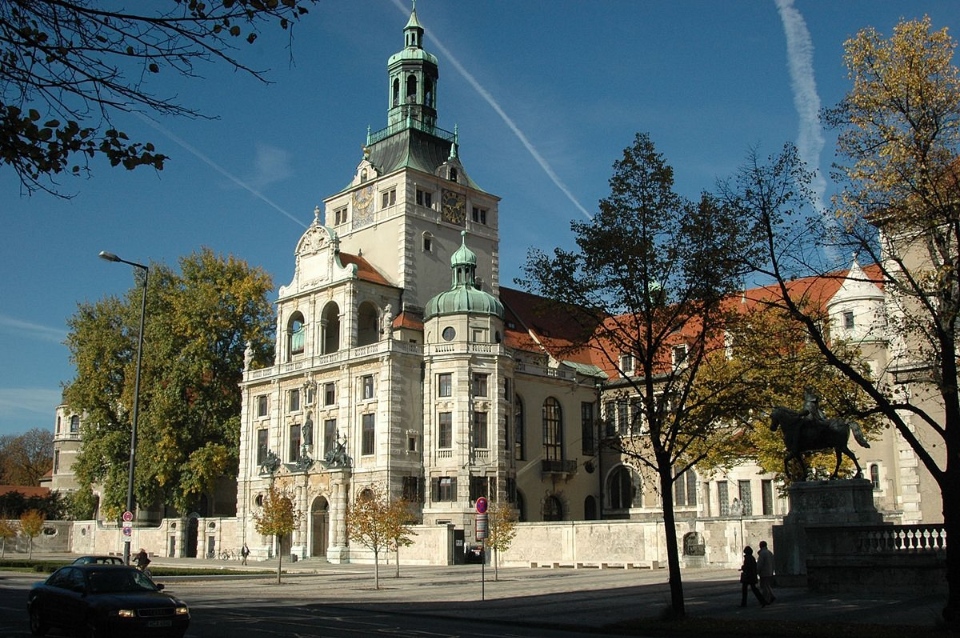
The museum is display a wide range of ancient relics and artifacts, the entrance fee is only 1 EUR. Here you will understand more about the history of the city of Munich through each period, through the antique collections displayed in the museum.
Stroll around Schwabing

Located in the northeast of Munich, Schwabing is a neighborhood filled with trendy, unique boutiques, shops, countless cafés and restaurants, attracting not only tourists looking for bustling, but also lots of people. Many Munich residents come here to soak up the vibrant nightlife, as the neighborhood entertains visitors with its plethora of trendy bars and nightclubs.
Once a gathering place for artists, musicians and art addicts of the city of Munich, Schwabing today still keep a lot of vibrant and artistic atmosphere. If Marienplatz is considered the heart of history in Munich, then Schwabing deserves to be considered the center of everyday life in this city.

Cuvillies Theater
Address: Residenzstraße 1, 80333 München, Germany
The Cuvillies Theater is a famous tourist attraction in Munich. This is one of the largest quaint theaters of the city, with luxurious beauty, ancient glass, eye-catching colors, really impress any visitor.
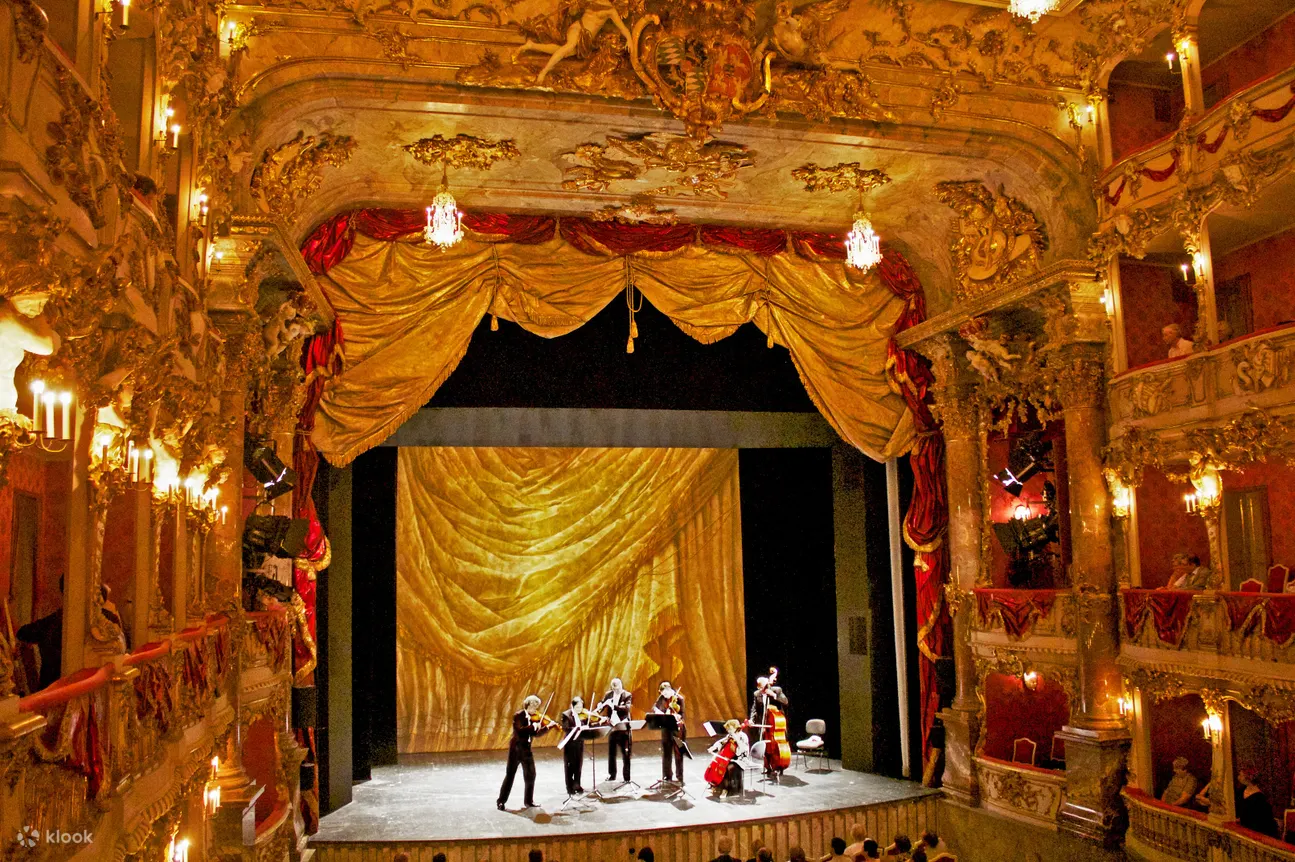
Hohenschwangau Castle
Address: Alpseestraße 30, 87645 Schwangau, Germany Hours: 9AM–4PM
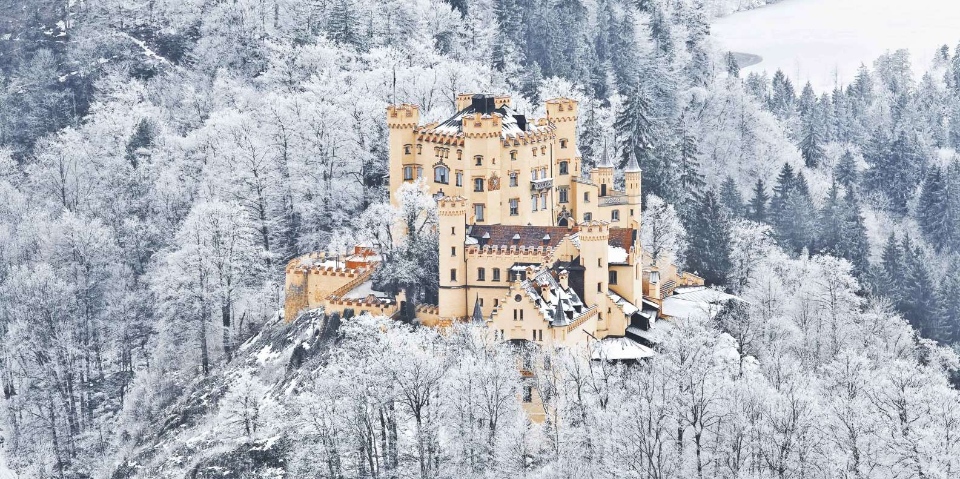
Located in the village of Hohenschwangau near the town of Fussen, a 2-hour drive from Munich, Hohenschwangau Castle will make you overwhelmed by its ancient and fanciful beauty like in fairy tales. Maximillian II discovered Hohenschwangau Castle and from a ruin restored it and used it as a hunting ground and summer rest.
Prater Island and Museum Island
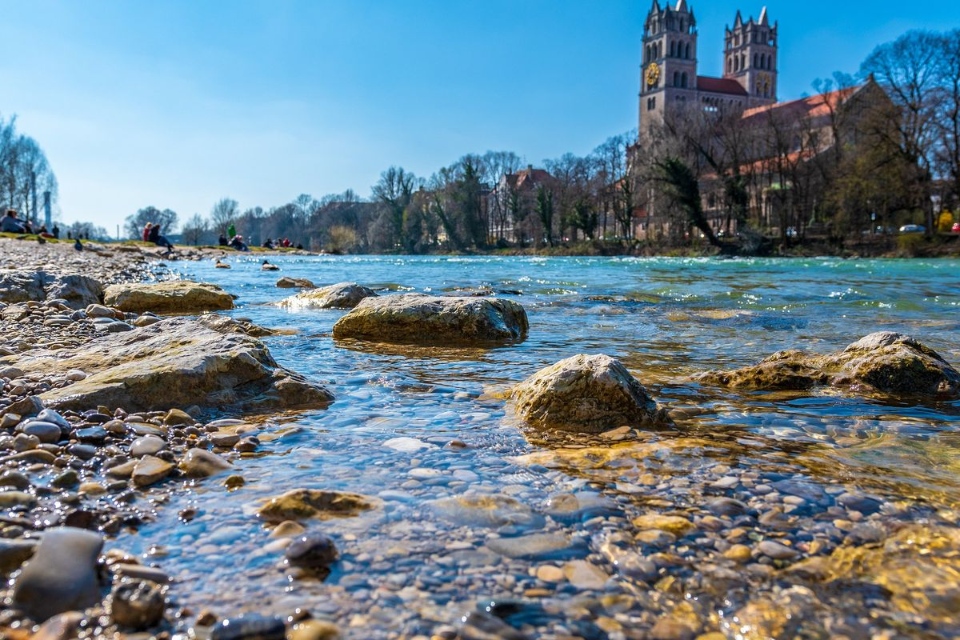
Prater Island is floated on the Isar River and offers tourists a completely different atmosphere from most other landmarks in the city: peace and quiet. On this island, in addition to the beauty of nature, you can also see many beautiful bridges or structures, blending with green trees and the calm Isar river. If you travel to Munich and Prater Island during the Christmas season, a Christmas market will also be set up on this island.
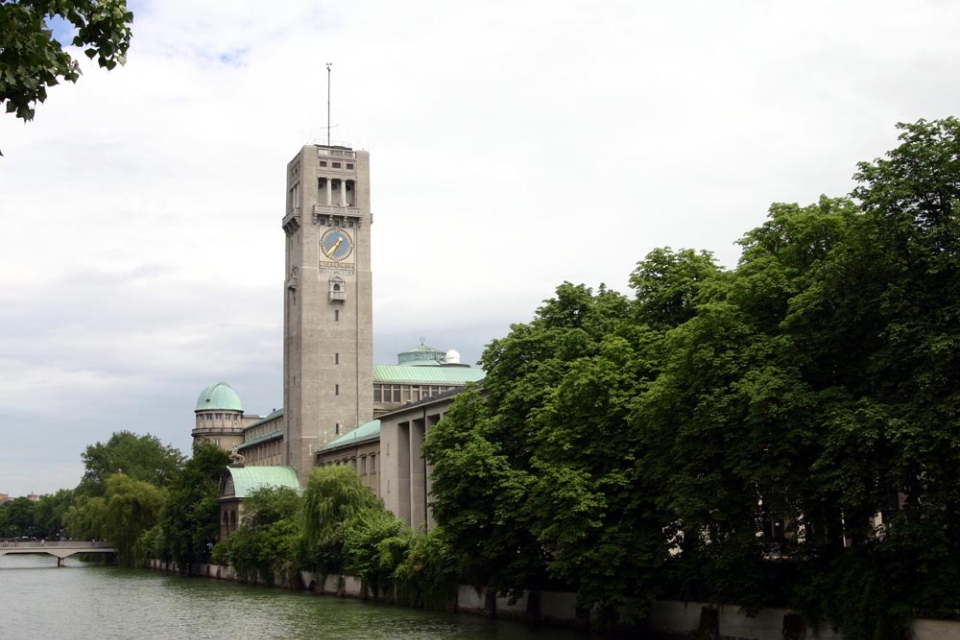
Another nearby island is Museum Island. Unlike Museum Island in Berlin, visitors to Museum Island in Munich will experience a highly interactive and experimental space, and the museums on the island encourage visitors to come and perform these experiments (by pressing the trigger at each display point).
Spend a relaxing afternoon at English Park and Olympic Park
English Park is considered the largest city park in the world as mentioned above, with not only well-maintained green spaces, but also a Japanese-style teahouse, lots of pavilions to sit and relax in, a garden beer and even a man-made waterfall. This is a sight that you definitely need to see with your own eyes during your trip to Munich. Bring some homemade food, drinks, and a favorite book and immerse yourself in nature at this giant park.
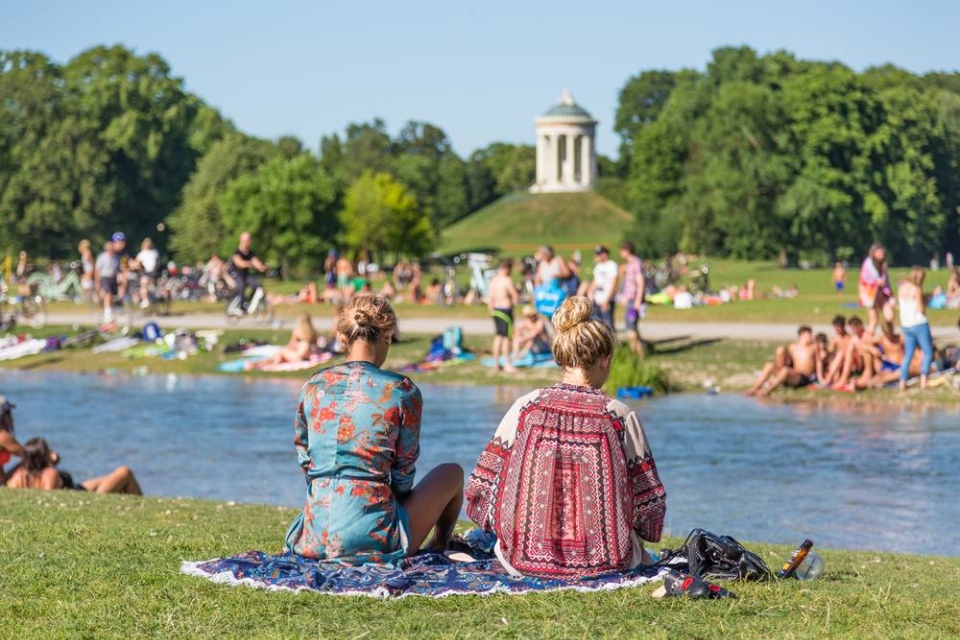
Another option for those who love green spaces in Munich is the Olympic park (Address: Spiridon-Louis-Ring 21, 80809 München, Germany). This 2.7-million-square-foot venue hosts many of the city’s exciting musical events, including the twice-yearly Tollwood festival in summer and winter.
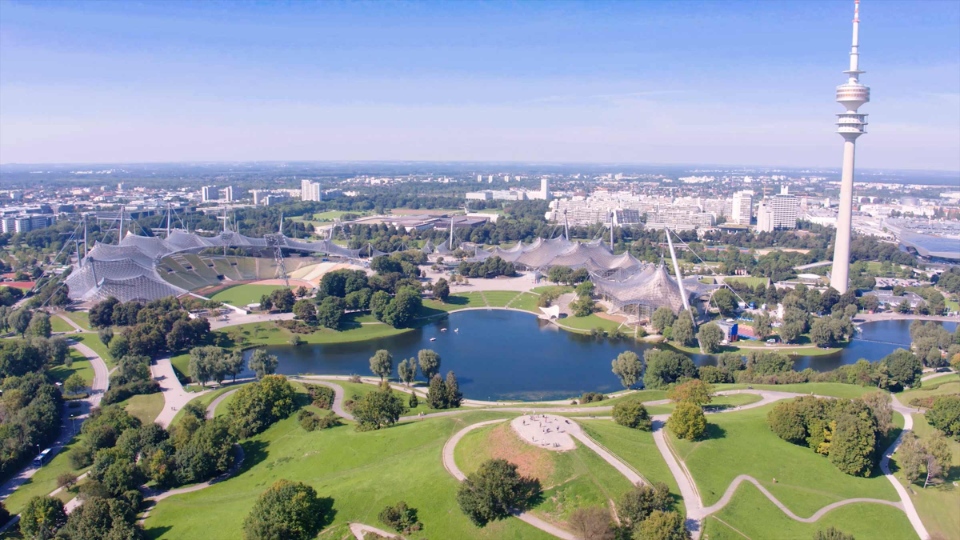
You should visit the Olympic tower in the evening to admire its shimmering beauty. Many tourists coming here have kept beautiful photos as an appreciation for the scenery here. If you have more time, stop by a few cafes nearby to enjoy the view and taste of the old Munich tradition.
Neuschwanstein Castle
Address: Neuschwansteinstraße 20, 87645 Schwangau, Germany Hours: 9AM–6PM
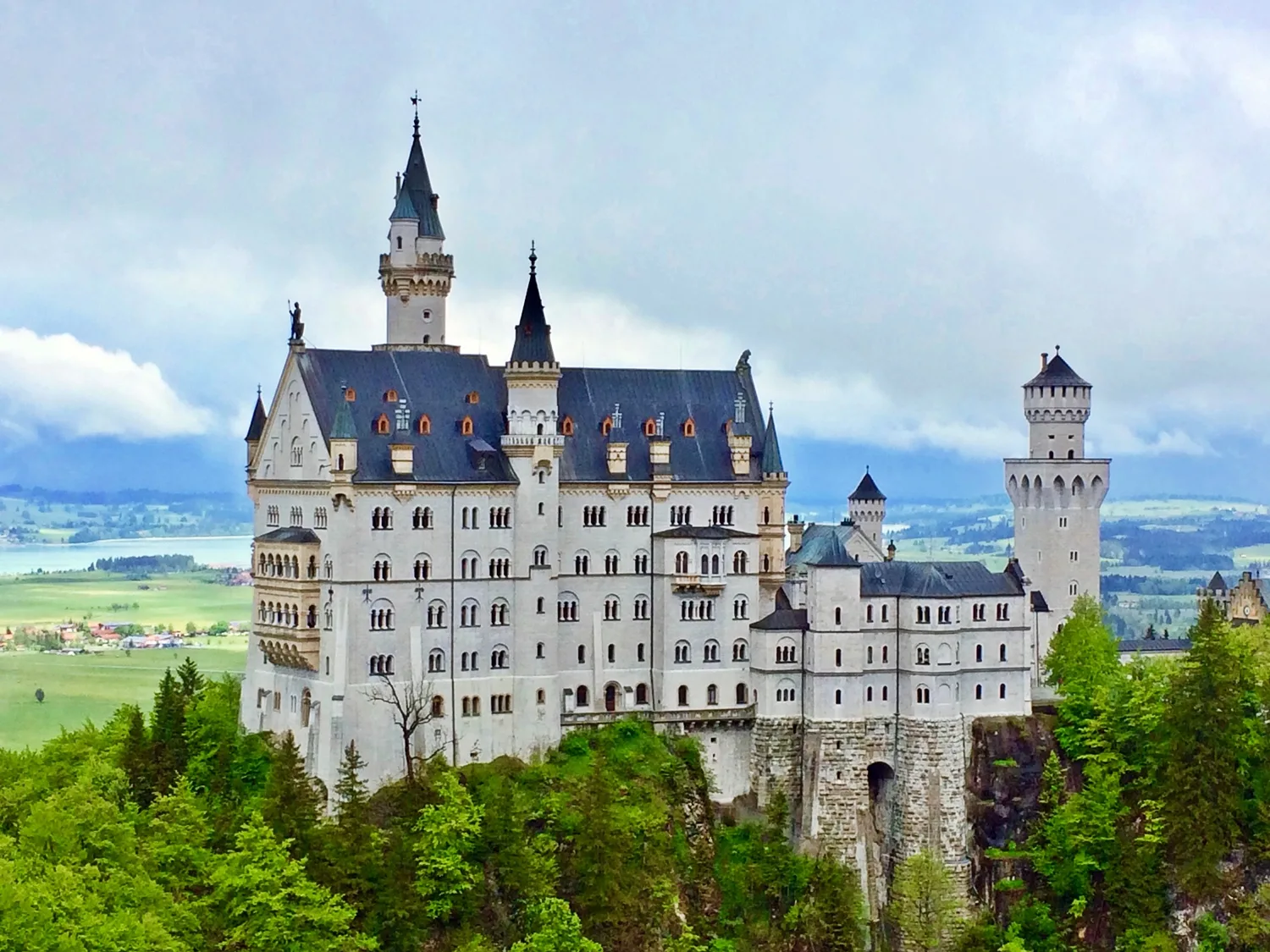
Besides the palaces and castles located in the city like Nymphenburg, Schleissheim or Alter Hof… spend at least half a day to visit Neuschwanstein castle. It will take you about 2 hours to reach this landmark from the city center of Munich, but believe me, every second and every minute you spend on the trip will be well worth it.
The beauty of Neuschwanstein Castle is no less than castles out of fairy tales on television, with white walls, towering spiers and a prime position on a cliff in the Alps amid immense green forests.
Rothenburg ob der Tauber
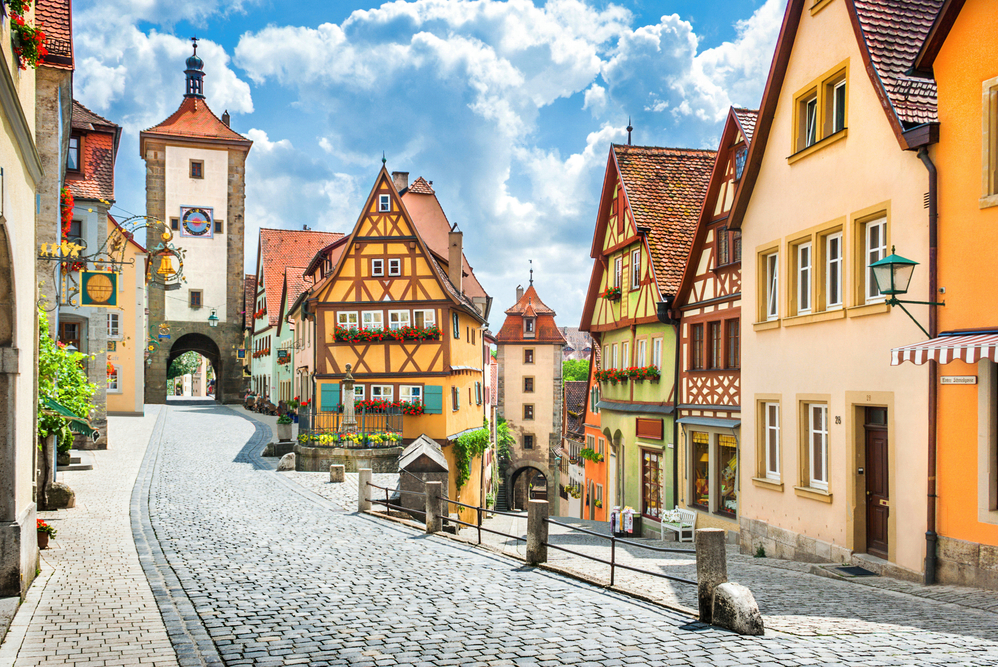
A romantic stop for visitors to Munich is the medieval town of Rothenburg ob der Tauber. This town is famous for its year-round Christmas shops and has an outstanding Christmas market every December.
Enjoy Bavarian beer
This is probably the most obvious suggestion that we can send to those who are intending to travel to Munich. The city is considered one of the beer connoisseurs’ havens, culminating in the Oktoberfest. Even so, even if you don’t visit Munich in the fall for this festival, all the beer gardens and restaurants here are ready to serve you a cool traditional Bavarian beer, served with German-style foods.
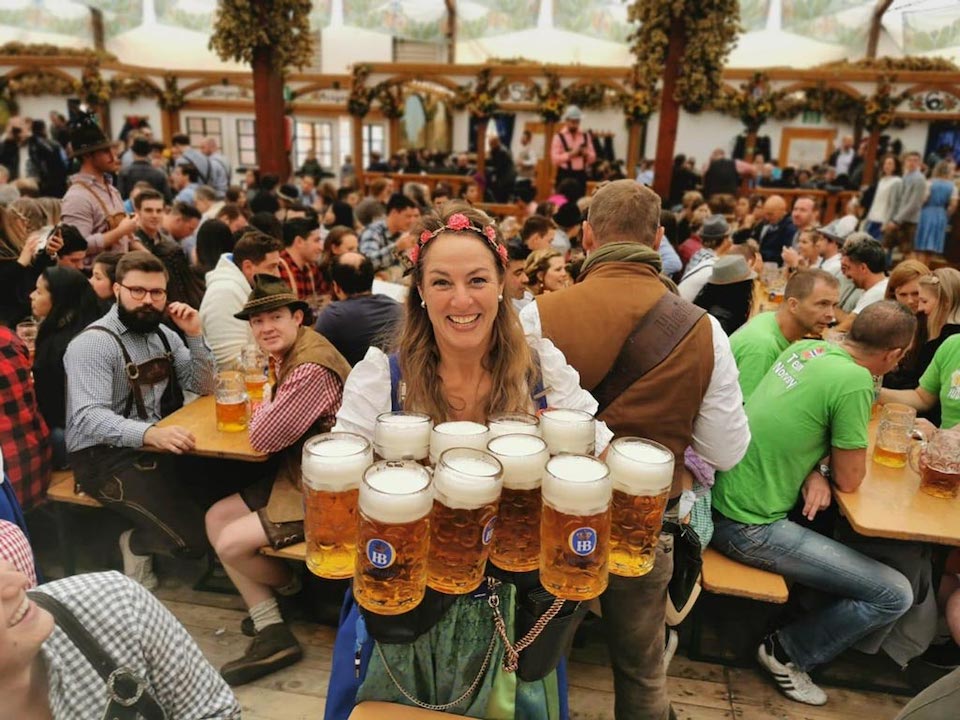
If you come to Munich in the fall, you should remember to attend the Oktoberfest festival held annually in late September and early October. Thanks to the famous Oktoberfest held every year here, the city of Munich has become one of Germany’s top beer cities. During this 16-18 day festival, visitors from all over the world are served over 7 million liters of locally brewed beer. But the appeal of the beer city of Munich lingers even after the festival is over. The city has many gardens and brasseries, including the famous Hofbräuhaus am Platzl and the Chinesische Turm in the Englischer Garten.
Munich blog: What to eat?
No matter which country you set foot in, you can’t miss the culinary discovery experience and Munich is no exception. Here, the dishes are mainly with typical German flavors, below we recommend signature dishes in Munich you should try such as:
Schweinshaxe (German Pork Knuckle) with pickled cabbage
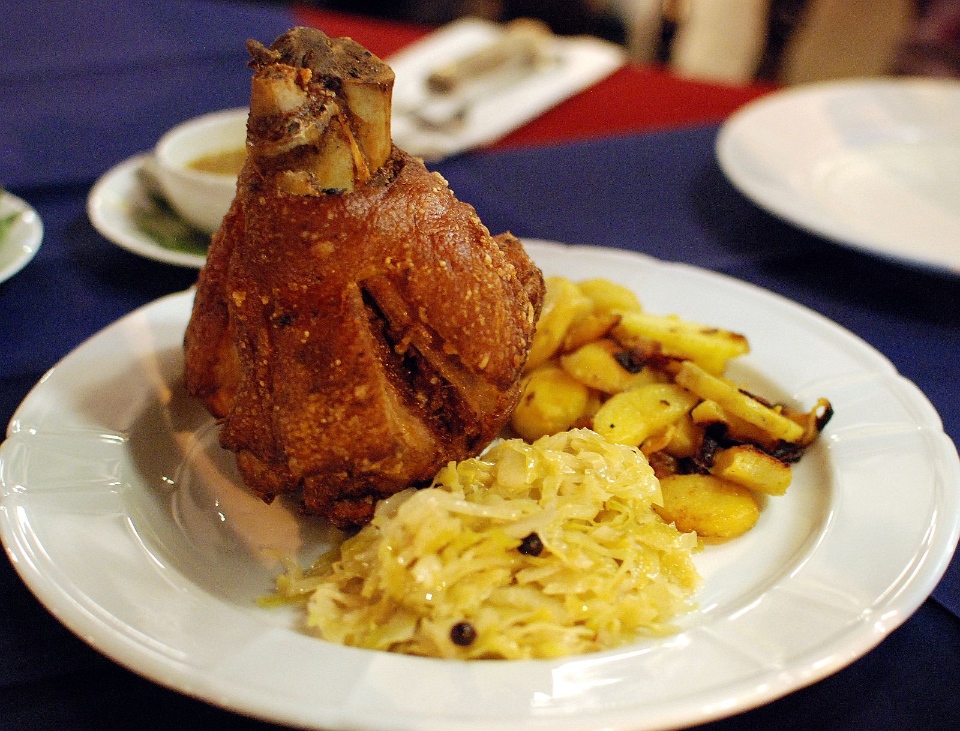
A traditional dish in Germany in general and Munich in particular with the ingredient of cabbage, after finely chopped, soaked in brine, incubated for 1 week until it turns yellow, slightly sour and soft. Germans often eat this dish with sausages, bacon, fried meat and especially deep-fried pork knuckles. The blend of flavors leaves diners with an unforgettable impression.
German Beer
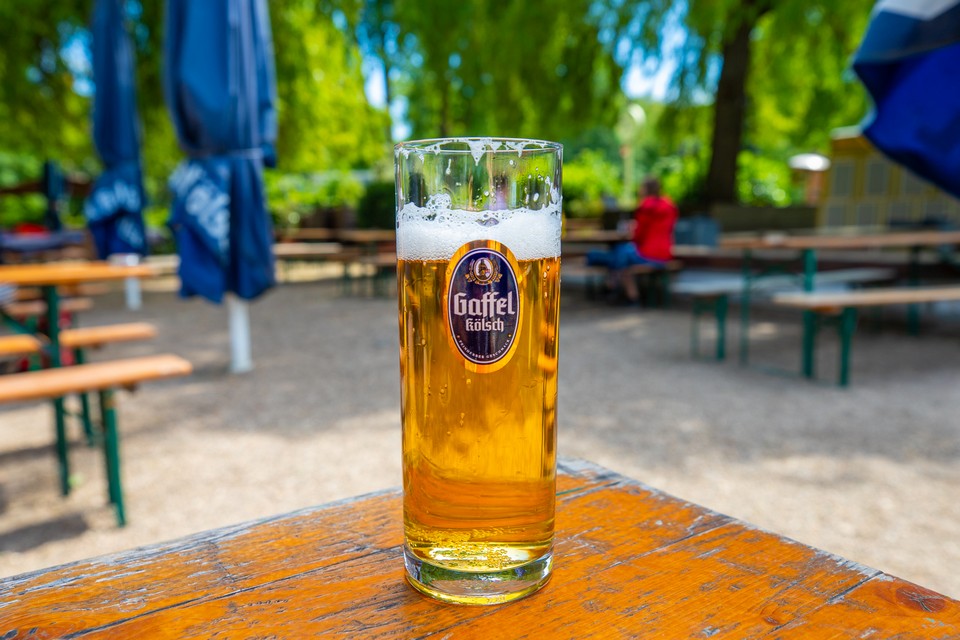
Going to Germany without enjoying the taste of German beer is considered an incomplete trip. German beer has long been a drink that attracts many tourists. Complying with strict standards and sophisticated processing, the quality of beer is excellent. Coming to Munich, please enjoy the following famous beer brands: Zwickelbier, Bitburger, Beck’s, Paulaner…
Frikadelle (German meatballs)
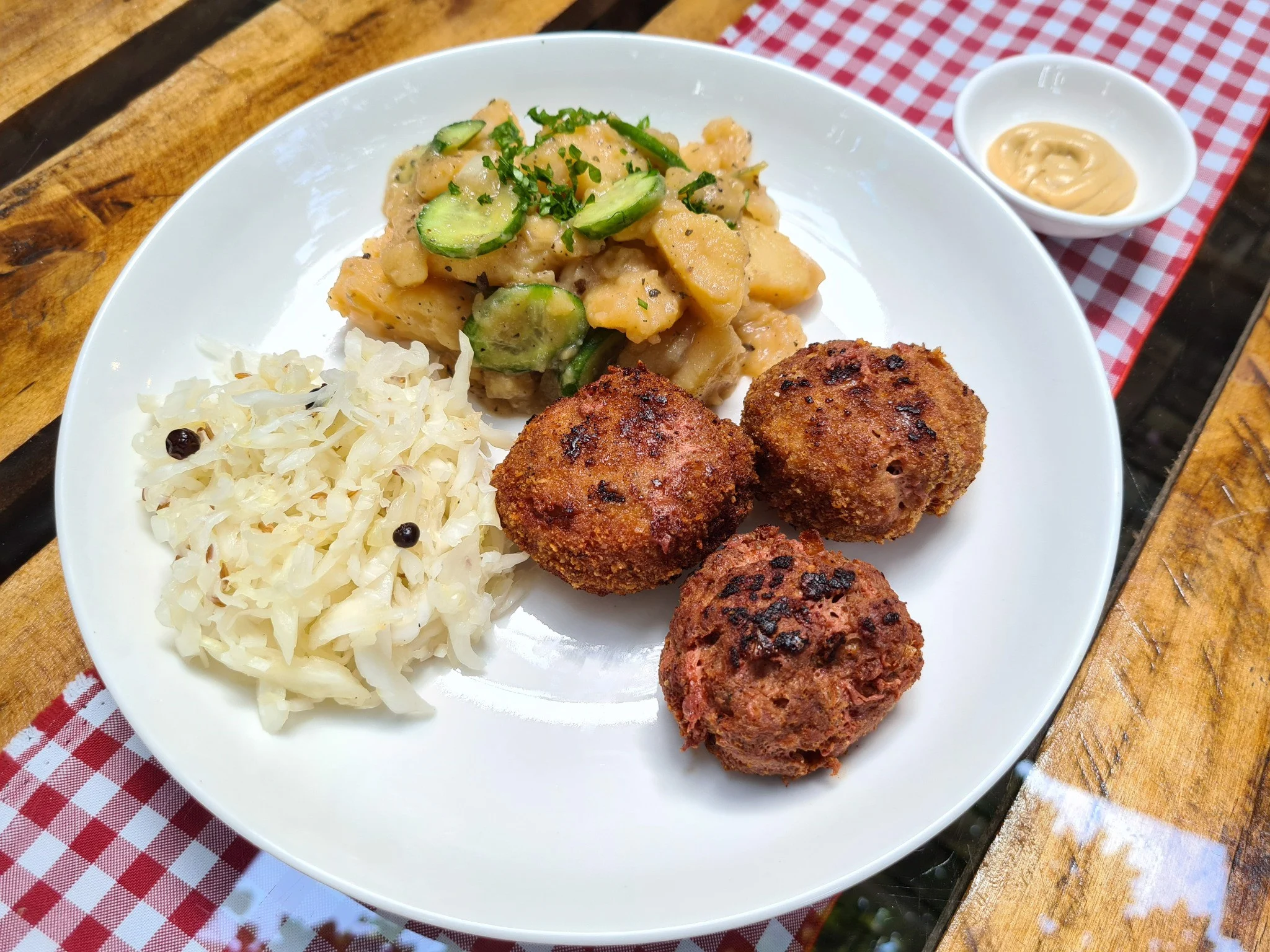
Continuing another delicious dish in Munich is Frikadelle meatballs. This dish is made from beef or pork, washed and pureed with onions, spices, … Then soaked in a layer of flour and deep fried in oil to create a crispy taste for a more attractive Frikadelle dish. You not to forget to eat with sauce, potato and vegetable salad with mustard.
Traditional Currywurst Sausage and Curry Ketchup
With countless delectable dishes, but visitors always put this curry sausage in their eating notebook. This dish uses German sausages that are chopped and cooked with curry sauce. When enjoying, often served with potatoes and beer to enhance the flavor.
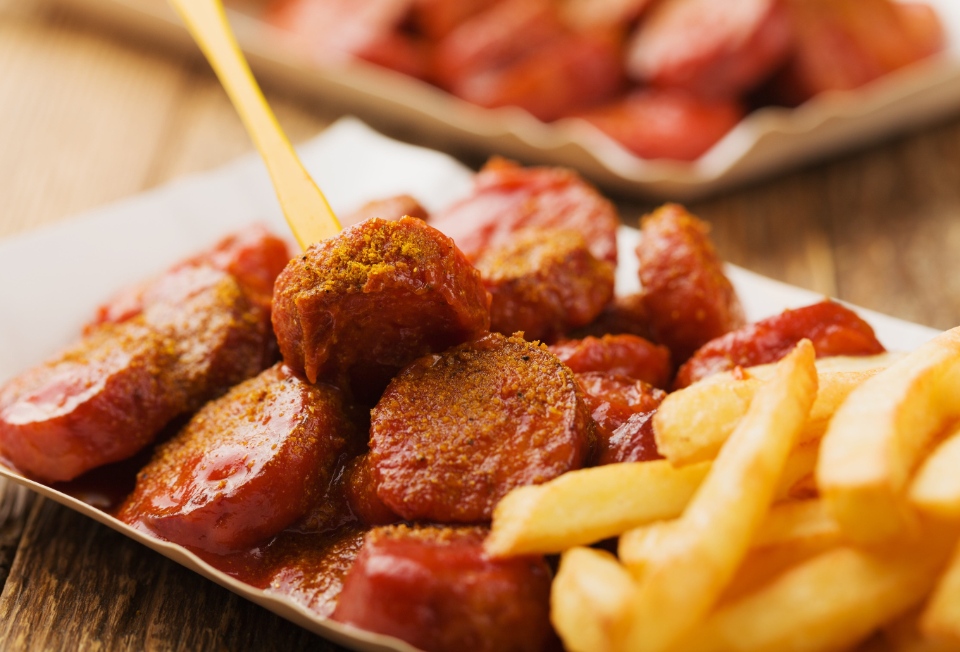
The combination of German sausage and the main spice is curry. Grilled sausage placed with french fries on a plate, under a delicious sauce on top. So you’ve had a good meal, sipping a little more beer is a good suggestion.
Weisswurst White Sausage
Also one of the most famous and delicious German sausages. To make this dish is quite sophisticated, people use young veal or pork marinated in spices, pureed and made into sausages. When used, the sausage will be heated with white wine or water until the sausage is cooked and golden, then peel off the outer shell. This dish is dipped with a special sauce in Munich to create an irresistible delicious taste.

Potato dishes
Munich potatoes are quality, big, are an indispensable daily food of the people of Munich. There are many attractive dishes from them such as: Potato salad, potato soup, sautéed potatoes,… Each dish has its own flavor, you must try these dishes!
Maultaschen pastry

Maultaschen is a delicious, famous dish in Munich. The pastry is processed quite sophisticatedly, the crust is made from flour, the filling is a mixture of minced meat, raw vegetables, and many typical spices. After that, the cake will be cooked and served with its broth.
In addition, Munich cuisine still has many other attractive dishes such as: Schweinebraten (German Roast Pork Shoulder), Semmelknödel (German Bread Dumplings)…

Hofbräuhaus am Platzl
Address: Platzl 9, 80331 München, Germany Hours: 11AM–12AM
Don’t end your journey without setting foot in the Hofbräuhaus am Platzl, a brasserie known for its distinctive concoctions. Drinks here are created by the people who have served for the royal family and provide more than 1000 seats for diners to enjoy. If you are a lover of novelty and want to immerse yourself in the vibrant atmosphere, this is the most suitable spot.
Munich travel blog: What to buy?
Buying gifts after returning is always a concern of tourists after a trip. In Munich you can easily buy cosmetics and perfumes. Munich Airport is a good shopping place, the price is not high and you do not need to bargain. If you buy outside, please note the opening hours of stores: Supermarkets, large stores are open from 9 am to 8 pm from Monday to Friday, Saturday only open from 9 am to 6 pm. For small shops, they only open from 9am to 6.30pm and on Saturdays close at 12pm.

Munich blog: Where to stay?
Below we recommend more best budget, mid-range and upscale hotels with good ratings and reviews you can refer to.
- Platzl Hotel ( Agoda , Booking )
- 25hours Hotel The Royal Bavarian ( Agoda , Booking )
- Hotel Muenchen Palacen ( Agoda , Booking )
- Hilton Munich Airport ( Agoda , Booking )
- Sofitel Munich Bayerpost ( Agoda , Booking )
- Hotel Torbraeu ( Agoda , Booking )
- Marc Munich ( Agoda , Booking )
- Hotel Laimer Hof ( Agoda , Booking )
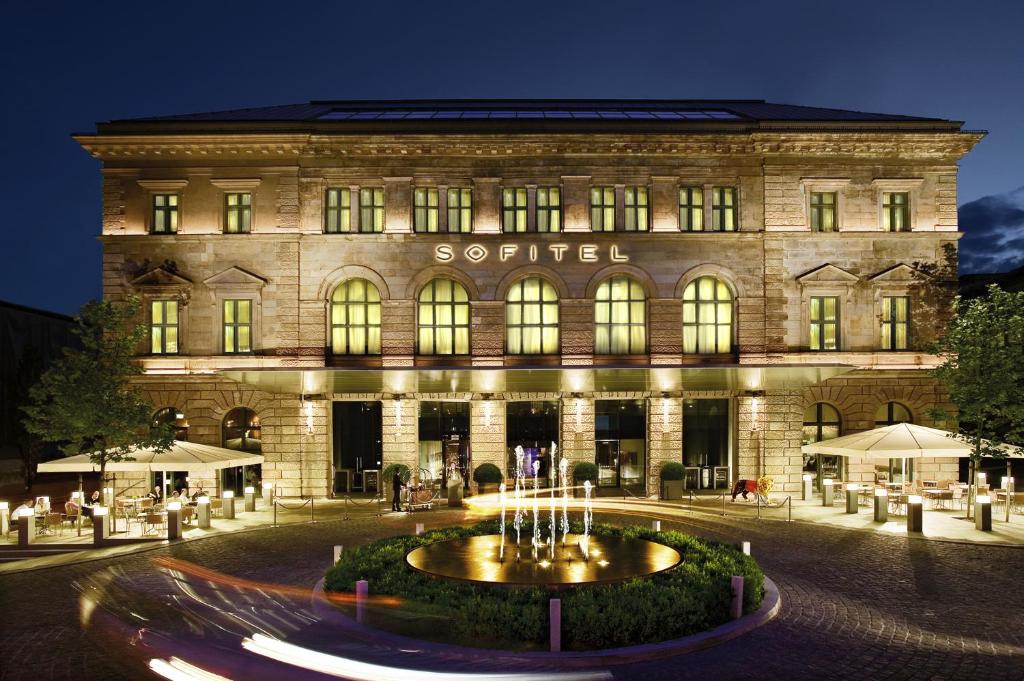
Check out more top and best hotels in Munich on Agoda.com or Booking.com
Some best day tours, trips, activities and transfer services, tickets in, from and to Munich you can refer to
- Munich Travel Card
- Munich City Pass
- City Tour Card Munich
- SEA LIFE Munich Admission Ticket
- Munich Classical Concert Ticket at Old Court Chapel with Optional Bavarian Dinner
- Neuschwanstein Castle Entry Ticket in Schwangau
- Bavarian Beer Experience in Munich
- Discover Munich Walking Tour
- From Munich: Neuschwanstein & Linderhof Castle Full-Day Trip
- Munich Hop-On Hop-Off Tour: 1-Day or 2-Day Ticket
- Munich: Third Reich & WWII Tour Walking Tour
- From Munich: Neuschwanstein Castle Full-Day Trip
- Munich: Old Town & Viktualienmarkt City Walk in German
- Munich 3-Hour Guided Bike Tour
- From Munich: Neuschwanstein Castle & Linderhof Premium Tour
- From Munich: Rothenburg and Nördlinger Ries Day Trip by Bus
- From Munich: Salzburg, St. Wolfgang, and the Salzkammergut
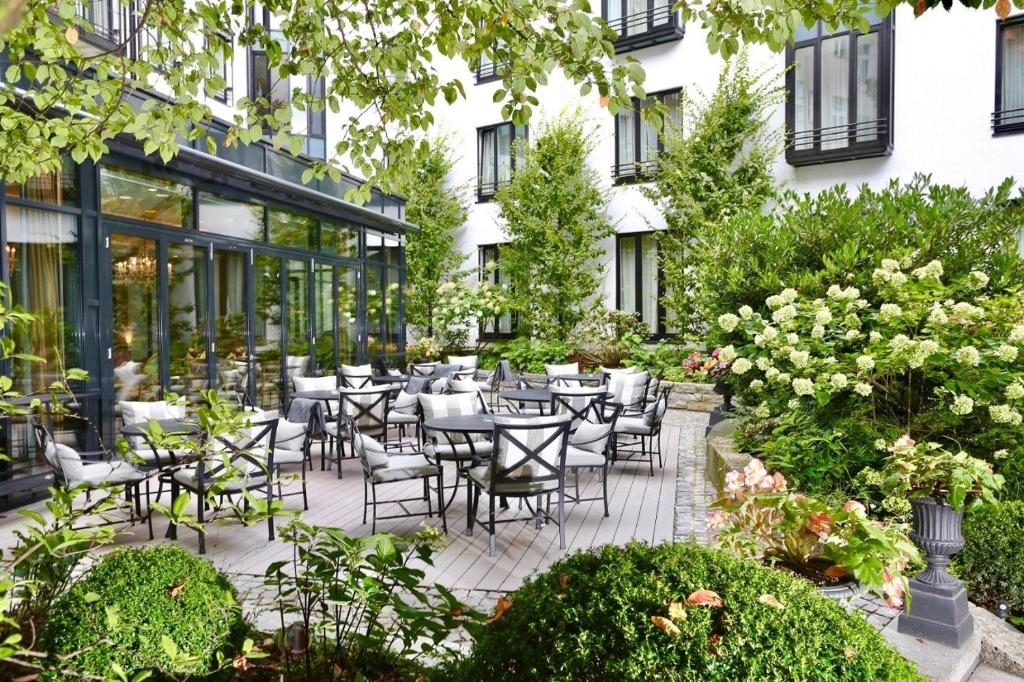
Munich is a very unique city where you can see the past and the future side by side on the same street. This city is also a place where man-made architecture and nature harmonize in an extremely sustainable way. Not only that, but Munich is also a vibrant city with countless cultural events taking place all year round, attracting countless visitors. With all these great things, what’s the reason you haven’t planned your trip to Munich yet? Read more Germany guide here .
Related articles

RELATED ARTICLES MORE FROM AUTHOR
Where to go in bali 19+ must-see & best places to visit in bali for all-kinds of travelers, bali itinerary 4 days. suggested where to go & what to do in bali for 4 days, where to travel in hungary 35+ best places to visit in hungary for all kinds of visitors.
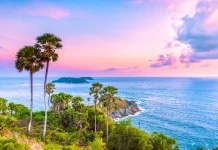
Phuket blog. The latest completed Phuket guide for all kinds of visitors
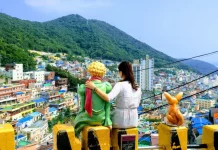
Where to travel in Busan? 30+ best places to visit & must-see places in Busan for all kinds of travelers
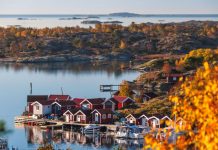
Where to travel in Sweden? 30+ must-go & best places to visit in Sweden
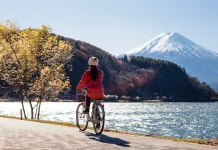
Tokyo itinerary 5 days. Where to go, what to do, how to spend 5 days in Tokyo for the first-timers?
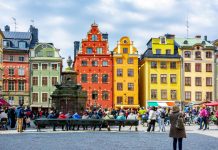
Stockholm travel blog — The Stockholm travel guide blog for first-timers
Editor picks.

Where to go in Bali? 19+ must-see & best places to...

Bali itinerary 4 days. Suggested where to go & what to...
Popular posts.

What to buy in USA? — 17+ must buy in USA...

What to buy in Korea? — Top +23 cheap, famous &...

Must buy souvenir in Taiwan — Top 17+ most famous, cheap...
Popular category.
- Inspiration + Guide 1484
- Trip Inspiration 468
- Food + Drink 217
- Thailand 211
- Coasts + Islands 195
- South Korea 173
- Vietnam 172
- Travel Photos 144
- Work for Us
- Terms & Conditions
- Privacy Policy

An official website of the United States government
Here’s how you know
Official websites use .gov A .gov website belongs to an official government organization in the United States.
Secure .gov websites use HTTPS A lock ( Lock Locked padlock icon ) or https:// means you’ve safely connected to the .gov website. Share sensitive information only on official, secure websites.

International travel documents for children
See what documents a child needs to travel to or from the U.S. alone or with a parent or relative.
Children traveling to the U.S.
All children, including infants, must have their own travel documents such as a passport or document from a Trusted Traveler Program to enter the U.S. If you travel or are going to travel with a child, consider taking the following documents:
- If the child is traveling with only one of their custodial parents, they must have a letter of consent, preferably in English and notarized, from the other parent or signed by both parents. The letter should say "I acknowledge that my son/daughter is traveling outside the country with [the name of the adult] with my permission."
- If one parent has sole custody of the child, a copy of the custody document can take the place of the other parent's letter.
- Parents who frequently cross the border by land with a minor must always carry a letter of permission from the other parent.
U.S. citizen children traveling abroad
Ports of entry in many countries have security measures to prevent international child abduction . If you are traveling alone with your child, you may be required to present documentation proving you are the parent or legal guardian. You may also need a letter of permission from the other parent for your child to travel.
If your child travels alone, depending on the country, they may be required to present a notarized letter from both parents or their legal guardian. If a minor is traveling abroad and is not accompanied by both parents or a legal guardian, contact the embassy or consulate of the country you will be visiting and ask about entry and exit requirements for that country.
LAST UPDATED: December 6, 2023
Have a question?
Ask a real person any government-related question for free. They will get you the answer or let you know where to find it.

England vs Iceland: What time is today’s final Euro 2024 warm-up match?
E ngland have one more warm-up friendly left on home soil, tonight against Iceland, before they travel to Germany for this summer’s Euro 2024 tournament.
Follow live coverage of England vs Iceland in our blog , with updates from Telegraph Sport reporters at Wembley.
On Monday night, they eventually found their goal-scoring form to beat Bosnia-Herzegovina 3-0 at St James’ Park, with goals coming from Cole Palmer, Trent Alexander-Arnold and Harry Kane.
On Thursday, Gareth Southgate announced his final 26-man squad for the Euros, cutting seven from his wider training squad. James Maddison, Curtis Jones, Jack Grealish, Harry Maguire, Jarrell Quansah, James Trafford and Jarrad Branthwaite all missed out.
When do England play Iceland and where?
England’s final Euro 2024 warm-up match will be against Iceland tonight at Wembley Stadium.
What time does England vs Iceland start?
The match with Iceland will start at 7.45pm.
Euro 2024 predictor
Pick your winner
What channel is the match on TV?
England’s Euro 2024 warm-up matches are being shown live on Channel 4. Alternatively, you can bookmark this page and return to follow Friday’s game via our live blog, which will include commentary and analysis from our team of reporters at the grounds.
When it comes to the actual Euros, England matches will be spread across BBC and ITV.
England vs Iceland head-to-head
The two teams have faced off five times before, with the last coming in Nov 2020 for a behind-closed-doors Nations League match at Wembley. England won 4-0 with Declan Rice and Phil Foden (2) scoring for their country for the first time. Mason Mount got the other goal. England also won their other Nations League match two months previous, thanks to Raheem Sterling’s penalty.
Before that came one of Iceland’s most memorable results to date, beating the Three Lions 2-1 to knock them out of Euro 2016, in what was Roy Hodgson’s last match as England manager.
It was Iceland’s first and only victory over England, after the Three Lions also won 6-1 in 2004 and drew 1-1 in a 1982 friendly.
Latest odds
- England to beat Iceland – 1/7
- Iceland win – 14/1
- Draw – 17/2
Odds correct as of June 7
Betting on Euro 2024? Take a look at these Euro 2024 free bets and betting offers
What is the latest England news?
Declan Rice believes England’s midfield has a bright future as Kobbie Mainoo and Adam Wharton joined him in the squad for Euro 2024.
At 25, Arsenal midfielder Rice is the oldest midfield option in Gareth Southgate’s ranks and will pick up his 51st cap in today’s final warm-up game against Iceland.
Mainoo, 19, impressed on his senior debut during the March international break having enjoyed a fine breakthrough season at Manchester United that culminated in a goal in the FA Cup final win over Manchester City.
Meanwhile, 20-year-old Wharton worked his way into Southgate’s squad having hit the ground running at Crystal Palace following a January move from Blackburn.
He came off the bench to make his debut for the Three Lions in Monday’s 3-0 friendly win over Bosnia and Herzegovina and made enough of an impression that he survived Thursday’s cull to make Southgate’s 26-man squad.
“I think we saw in the last camp against Belgium and Brazil what Kobbie could do,” said Rice.
“Obviously the last six months, all season really, what he’s done at Man United and he clearly deserves his place in the squad.
“Adam played his first half of the season in the Championship, came to Crystal Palace and has been outstanding.
“I think in training he’s impressed a lot of players - he is so composed and calm on the ball. He’s got a beautiful left foot, just a really down to earth boy, wants to learn.
“He still is obviously only 20 years old but to be on the plane to go to his first European Championships, what a moment for him and his family.”
When do the Euros start?
Euro 2024 starts on Friday, June 14, with hosts Germany playing Scotland. England play their first match two days later, on the Sunday, against Serbia. Euro 2024 fixtures take place from June 14-July 14.
Sign up to the Front Page newsletter for free: Your essential guide to the day's agenda from The Telegraph - direct to your inbox seven days a week.


IMAGES
VIDEO
COMMENTS
1 Thing to do Special moments on the road: 22 places Basic guides for every destination: 6 Grad Ost Stories from the road: A World Kaleidoscope Solo Female Travel Blogs, including trips to more exotic destinations like Iran: A Nomad Abroad: Before We Die Like myself, Katrin has a thing for warmer destinations <3: Bezirzt Storytelling travel blog by Julia: Bin mal kürz weg Outdoor and ...
Here are some German trip itinerary ideas…. Germany itinerary ideas for a taste of everything: Southern Germany Classic: Munich, the Allgäu (for Castles!), Garmisch Partenkirchen, Berchtesgaden National Park, Stuttgart & Area, Black Forest. Eastern Germany Classic: Berlin, Dresden, Saxon Switzerland.
Hallo und Wilkommen to Wander in Germany! This Germany travel blog was created so that you can plan your best trip to and within Germany. This particular page will help you quickly get started ...
This blog is meant to be a foreigner's guide to the best of Germany. Nice to Meet You! I'm Megan, the author behind this travel blog about Germany. I moved to Germany in August 2019 to pursue a masters degree in sustainable tourism management. I didn't know the language, I didn't know any people here, and I was (naively) ready for the ...
What To Expect. Language: The official language of Germany is German, though most Germans that work in tourism speak English as well. Currency: The official currency of Germany is the Euro (EUR), and the exchange rate is currently 1 USD to 0.88 EUR. Credit Cards & ATMs: Germany is a predominately a cash-focused society, you will have no problem using your credit card when in Germany.
Thirteen years, 100 countries, and one successful travel blog later, I'm still going. This website is the result of tens of thousands of hours of my own, personal on-the-ground research. I pay for all my travels myself, don't take sponsored trips, travel anonymously, and refuse to touch AI; all to ensure my recommendations are ones you can trust.
Andrew Eames is a travel writer and author with a particular penchant for things German. Over the years he has written about Germany for a range of UK newspapers, including the Times, the Telegraph, the Daily Express, the Evening Standard and the Independent. Barbara Geier. Barbara Geier is originally from Schifferstadt, near Speyer in the ...
Germany Travel Blogs These are all of my travel blogs about Germany. From exploring the Black Forest, to buzzy cities including Berlin and Stuttgart, and the natural beauty of Saxon Switzerland, find out the best places to travel to in my Germany travel blogs and travel guides. Happy exploring!
Find all of our Germany Travel Blog Posts Below. Germany. Best Places to Visit in Germany in Winter - Family-Friendly Activities. December 28, 2023 by Andrzej Ejmont. Germany is the greatest Christmas trip because of the markets, the handcrafted ornaments, and the overall mood, which are all amazing. And there is a significant probability ...
Germany Travel Blog. Germany is a beautiful country located in Central Europe. In fact, Germany is one of the most popular destinations in Europe. It has something for everyone - backpackers, couples, solo travelers, luxury travelers, digital nomads, etc. Germany offers several experiences - from medieval history to modern cities, from ...
Travelling in Germany. Audrey is a full time travel blogger so spends most of her time on the road. She has done extensive travel throughout Germany, including Berlin, Hamburg, Bebenhausen, Tuebingen, and more. Starting her blog in 2010, she never expected this ti turn into her full time job. But through sharing captivating photos and unique ...
Germany Travel Guide. Last Updated: April 29, 2024. Germany. The country is synonymous with beer, sausages, incredible hiking, majestic castles, serious people, and wild techno parties. It's huge, diverse, and utterly amazing. There's a vibrant art and music scene in Berlin, beautiful forests in the west, majestic cathedrals and castles ...
From the best trails to where you should stay, this is everything you need to know about the Bastei Bridge hike in Saxon Switzerland, Germany! Read more. If you're looking for some advice & information on Germany then make sure you check out all my Germany travel blogs here at An Adventurous World.
Germany Travel. At germanytravel.blog, we pride ourselves on being an authoritative and trustworthy source for all things related to traveling in Germany. Whether you're looking for the best places to eat, stay, or visit, we have you covered with detailed guides and reviews.
Germany Travel Itinerary 7 Days - West. For this itinerary, the total driving time would be around 14 - 15 hours and the distance would be slightly over 1100 km. For these calculations, we included the day trip to Monschau (and back to Cologne) as well as the day trip to Freiburg im Breisgau (and back to Stuttgart), which would be a longer ...
The potato pancakes are baked with grated potatoes, onions, flour, eggs, and various spices and served with apple sauce. Simply delicious! 2. Käsespätzle is a Swabian specialty, a ki. Experience the rich and flavorful world of traditional German food. From hearty sausages to savory schnitzel, discover the best dishes here.
Berlin Travel Costs. Hostel prices - Dorms cost 17-25 EUR per night while private rooms for two cost around 45-56 EUR per night. Free Wi-Fi and lockers are standard in all hostels in Berlin. Most hostels also offer free coffee/tea and have a kitchen and bar on site.
Location and Visa. Germany is very centrally located, and is bordered by Denmark, Poland, Czech Republic, Austria, Switzerland, France, Luxembourg, Belgium, and the Netherlands. All of these countries, like Germany, are part of the Schengen region, so it is super easy to rent a car or take a train and see multiple countries in one trip without ...
Here are 35 Best Germany Travel Blogs you should follow in 2024. 1. Cheryl Howard » Germany. An Inspirational Travel & Expat Living Blog by Cheryl Howard. My mission is to inspire you to travel more or even move abroad! cherylhoward.com.
Annette's 10 days in Germany. Day 1 - Munich / Berchtesgaden Arrive via plane in Munich Self-drive to Berchtesgaden (3hrs) Lunch at Bindalm in Berchtesgaden National Park (Take Park bus) Visit Berchtesgaden Salt Mines (1hr tour) Visit Grassl's Gentian Schnaps Distillery (Liquor Shop) Hotel: Kempinski Hotel Berchtesgaden. Day 2 - Berchtesgaden
Travels of Adam. Based in Berlin, Germany, though as a travel writer, Adam is regularly traveling. In addition to writing and managing his popular travel blog, travelsofadam.com, Adam also works with Eating Europe Tours on their online marketing. Travels of Adam started in 2009 in preparation for a gap year he was planning, and wanted to keep ...
Germany is one part traditional, and one part hip. It is old medieval villages versus modern architecture. It is punk with lederhosen. It is bratwurst and kebab. 'Ich bin ein Berliner' Kennedy famously said, and it seems he was prescient as everybody wants to be one at the moment. Berlin is the place to be for the young and happening.
Frankfurt travel blog: Overview of Frankfurt Germany cities map | frankfurt travel blog. Frankfurt (full name Frankfurt am Main) is a city in the state of Hessen, western Germany. Frankfurt stretches 30km along the romantic Main River. With this location, the city has transformed itself into one of Germany's busiest trading hubs.
Kols beer | munich travel blog. Going to Germany without enjoying the taste of German beer is considered an incomplete trip. German beer has long been a drink that attracts many tourists. Complying with strict standards and sophisticated processing, the quality of beer is excellent. Coming to Munich, please enjoy the following famous beer ...
Monday Night Travel. Join Rick and his team of travel-savvy teachers every Monday night on Zoom as we explore Europe (and beyond) together. Radio: Portugal. This week's show: Hear about the charms of Portugal's Algarve region, the worthwhile parts of Spain's touristy Costa del Sol, and an Asian photography project spanning five decades.
The latest travel news, deals, guides and tips from the travel experts at USA TODAY. All the travel insights you need to plan your dream vacation.
Children traveling to the U.S. All children, including infants, must have their own travel documents such as a passport or document from a Trusted Traveler Program to enter the U.S. If you travel or are going to travel with a child, consider taking the following documents: If the child is traveling with only one of their custodial parents, they ...
England have one more warm-up friendly left on home soil, tonight against Iceland, before they travel to Germany for this summer's Euro 2024 tournament. Follow live coverage of England vs ...